Marcello Mastroianni Exhibit at the Museo dell'Ara Pacis
Happy New(ish) Year!
I’ve read it’s okay to say this until the end of the month. I made it just under the wire. I cannot believe February 1st is next week.
I’ve been meaning to check out the new exhibit at the Ara Pacis since the day it opened. It closes February 17th. If you live in Rome or are planning to visit, I recommend seeing it.
I loved learning more about Mastroianni’s childhood and family. I knew he was a stage actor for years before becoming a film star but had not seen many photos from that era. I didn’t know producer Dino de Laurentiis (grandfather of Giada) wanted Paul Newman for the lead in “La Dolce Vita”. Fellini said no. I’m trying to picture how different the film would’ve been.
Mastroianni was very handsome and had charisma for days but didn’t want to be seen as the cliché “Latin Lover”. In many films he upended the stereotype, playing anti-heroes who didn’t know how to deal with shifting gender roles, political/economic instability, and changing social mores.
Along with set photographs, one sheets, and short clips from several films, there were also a few costumes from his movies, including an iconic dress worn by Sophia Loren.
The exhibit is well organized, translated (English), and curated. If you love movies, the arts, Italian history, it’s a must.
Photos:Museo dell'Ara Pacis
Museo dell'Ara Pacis
Lungotevere in Augusta - 00186 Roma
Opening hours
Open daily, from 9.30 to 19.30
Last admission 1 hour before closing time
Italian Chic - by Daria Reina and Andrea Ferolla
I have written about Franco - Italian Chez Dédé before. I heard about this incredibly talented and creative couple, Daria Reina and Andrea Ferolla, from the late great Wonderfool. My friend Courtney and I met the lovely Daria at the store/spa and wanted to buy all their bags.
Daria and Andrea are quite modest. I didn't learn until this year (!) that they are the ones responsible for the typography of Pasta Garofalo, one of my favorite pasta brands. Okay, now that I think about it, this isn't a topic that would come up in everyday conversation.
There was some skepticism when they first opened their store. Why Rome? Why not Florence or Milan? An atelier/boutique/gallery like Chez Dédé would make more sense in those cities. There has been a great deal of negative press (local and international) about the state of Rome these days. Yes, the situation could be better and it's important not to ignore what is happening but walking into their shop is a much needed reminder of the reasons why we fell in love this city and country in the first place.
Their book ITALIAN CHIC is a must for anyone who loves Italy, photography, illustrations, or/and travel. It's not a guide book per se but more of a coffee table book filled with beautiful imagery. It was just published by Assouline and is available at their shops or online. The Chez Dédé store has a few limited edition copies left with a special cover featuring my beloved Sicily.
Photographed by Daria and illustrated by Andrea, ITALIAN CHIC is an intimate peek at some of their favorite places in Italy, from top to bottom. It's a love letter of sorts to a country that has inspired them. As Daria and Andrea said to Architectural Digest, “If we were not in Italy, then Chez Dédé simply would not exist,” Reina says. “We are both in love with Italy and the Italian lifestyle is certainly an integral part of our entire creative process.” Ferolla adds, “Italy cultivates the excellence of the ‘well done’ and of the simple and sophisticated style. Daria and I are heirs of this culture that reflects in each and every expression of Chez Dédé’s creative thinking.”
Daria and Andrea will be in New York City the week of October 14th for book signings. There will be an installation of Andrea's illustrations in one of Bergdorf Goodman's famous windows. Check their Instagram feed for more information (and because it's fantastic).
Photos (except for the cover): Assouline
Palazzo Merulana, Rome
I noticed this large abandoned palazzo when I first moved to Rome. I wondered what the history of the building was and why it was falling apart.I found out that it was a city owned property built in 1929. It used to be the headquarters for the Health Administration. Once those offices moved, the building fell into disrepair with some sections abandoned for over sixty years.Palazzo Merulana reopened last month and it's a beauty. Stunning.The renovations took only three years and was a private-public partnership. The space now holds the important collection of Claudio and Elena Cerasi. The couple focused on works created in the early 20th century, with the majority between WW 1 and WW 2. The Cerasi family owns a prominent construction company that has worked on projects such as the MAXXI Museum and other public and private works.The Cerasi Foundation would like to see the Palazzo become an important space for visual art, cinema, music, and theatre. They're working closely with several local cultural orgnaizaions. This is quite a gift to the city.A ticket to see the exhibit is four euros. There's a small, charming cafe on the ground and outdoor seating on the patio. The terrace is schedule to open in mid-July and the top floor is reserved for cultural events. 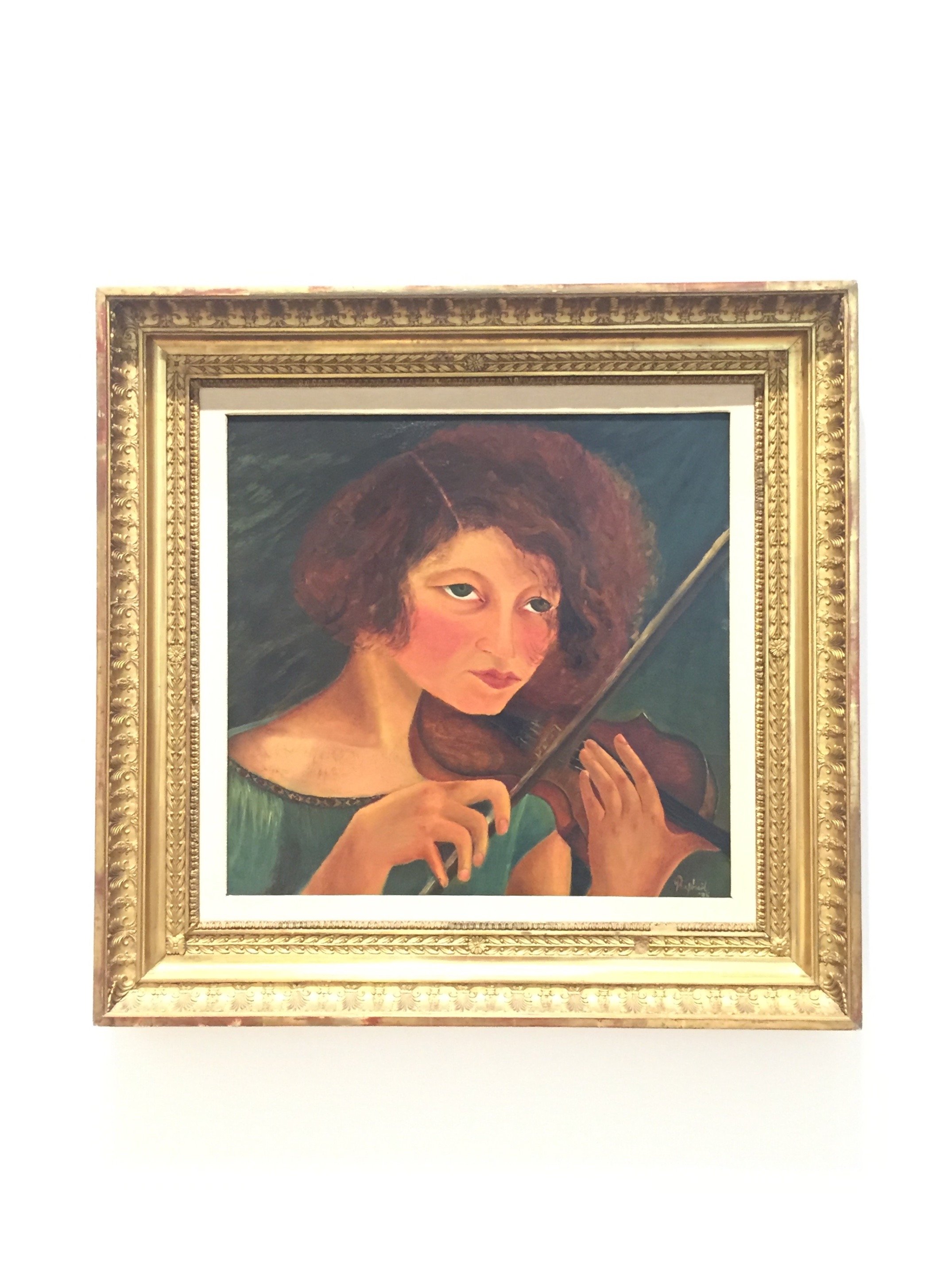
 Here is a short clip about the museum.https://youtu.be/SHw3vc-5fq0 The museum's in a very accessible location. It's about a ten minute walk from the Colosseum with easy access to the Metro and the Tram.121 Via Merulana, 00185, Rome
Here is a short clip about the museum.https://youtu.be/SHw3vc-5fq0 The museum's in a very accessible location. It's about a ten minute walk from the Colosseum with easy access to the Metro and the Tram.121 Via Merulana, 00185, Rome
La Biennale Venice - 2018
My friend Erica invited me to join her on a press trip for the preview of the 16th Architecture Biennale. I haven't been to any of the Biennale. I follow the art, cinema, and architecture ones on social media but it's not the same. My first (and last) trip to Venice was twelve years ago, late November. Even during off-season, the crowds in the Piazza San Marco area were quite large. The experience did not prepare for last week. More on that later.We were in Venice for only two days/one night. I would love to return to see the Pavilions I missed. Erica has a great write-up on her Instastories.Normally, we'd take a train from Rome but we had to get there in time for the press conference so we placed on a 7:00 am flight. A private boat picked us up. Not a bad way to enter the city. We had a few minutes before the press conference and met the other journalists/architects and their guests. It was a small group, only twelve of us, half were from Milan. Our hosts were wonderful and, my fellow Americans will feel me on this, I couldn't get over how organized everything was. One of the hosts flew from Milan to Rome to meet us on the flight to make sure things were on point.The theme this year is Freespace. The curators are architects Yvonne Farrel and Shelley McNamara of Grafton Architects.
My first (and last) trip to Venice was twelve years ago, late November. Even during off-season, the crowds in the Piazza San Marco area were quite large. The experience did not prepare for last week. More on that later.We were in Venice for only two days/one night. I would love to return to see the Pavilions I missed. Erica has a great write-up on her Instastories.Normally, we'd take a train from Rome but we had to get there in time for the press conference so we placed on a 7:00 am flight. A private boat picked us up. Not a bad way to enter the city. We had a few minutes before the press conference and met the other journalists/architects and their guests. It was a small group, only twelve of us, half were from Milan. Our hosts were wonderful and, my fellow Americans will feel me on this, I couldn't get over how organized everything was. One of the hosts flew from Milan to Rome to meet us on the flight to make sure things were on point.The theme this year is Freespace. The curators are architects Yvonne Farrel and Shelley McNamara of Grafton Architects.
After the press conference we walked over to Local, which was fantastic. It's owned by siblings Benedetta and Luca Fillun and used to be an electrical shop. I spoke more Italian in a day than I have in probably two months.We returned to the Arsenale for a guided tour of the Corderie. From there we were able to see a few pavilions before going to the hotel to check in. My favorite pavilions were the Kosovo, Canada, Italy, Bahrain, Italy, and Croatia Pavilions. I wish I had more time to spend in each one.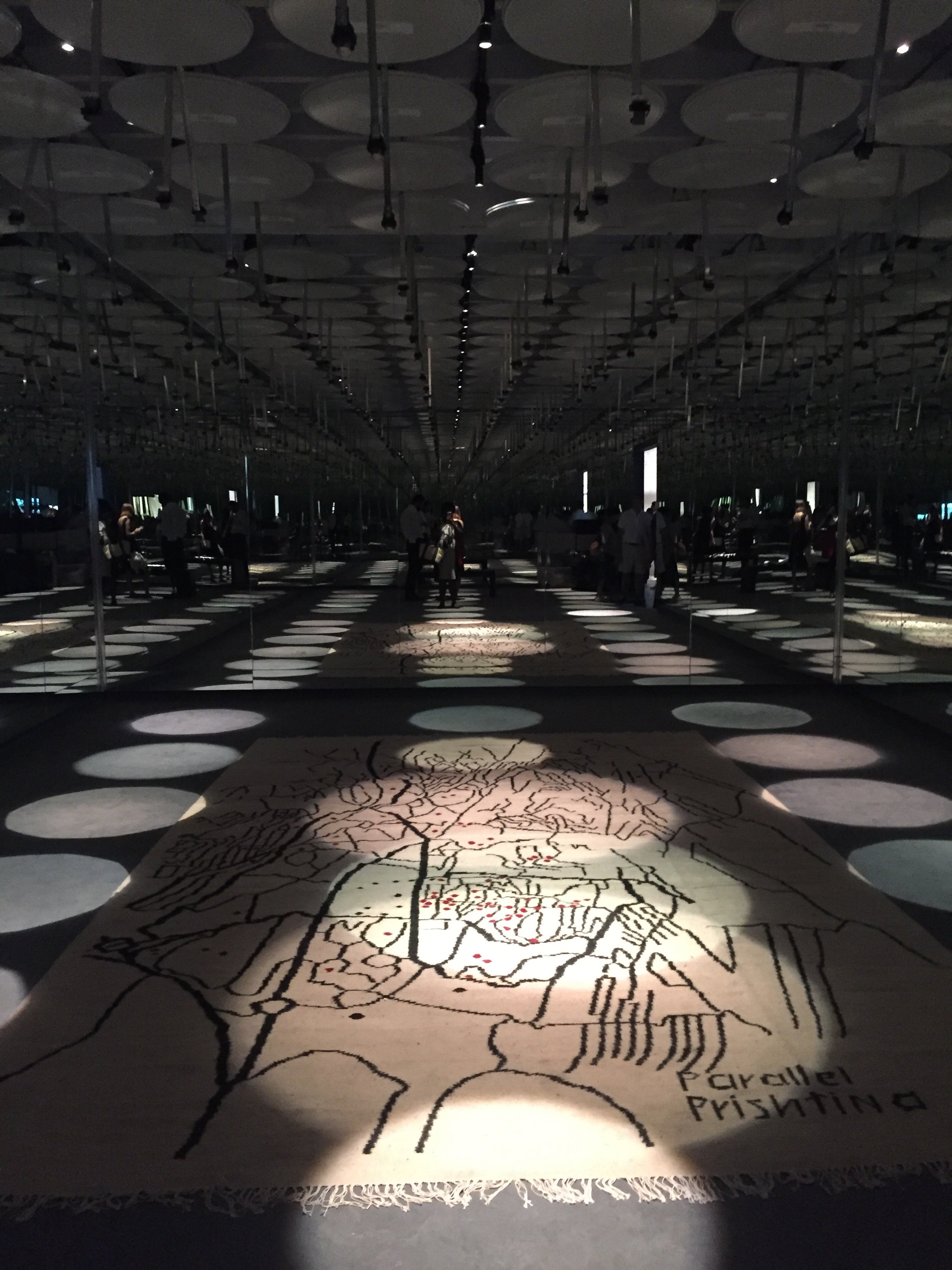 Erica and I decided to walk toward Piazza San Marco instead taking the boat. I was NOT READY. Remember, I've never been to Venice during high season. The crowds were on another level. I keep reading about the crowd situation but it's another thing to experience it. 28 million tourists visit Venice a year. Only 55,000 people live in Venice full-time, down from 175,000 post WWII, with around 2000 leaving every single year. AirBnB has pushed the rents sky high, and mass tourism from mega cruise ships turn streets into packed corridors during the day and desolate at night. I don't know what the answer is but this type of tourism is not sustainable.We stayed at the Bauer Palazzo and I was happily surprised to see that we had a terrace. The service was impeccable. It could be because we were with a group of journalists and architects.
Erica and I decided to walk toward Piazza San Marco instead taking the boat. I was NOT READY. Remember, I've never been to Venice during high season. The crowds were on another level. I keep reading about the crowd situation but it's another thing to experience it. 28 million tourists visit Venice a year. Only 55,000 people live in Venice full-time, down from 175,000 post WWII, with around 2000 leaving every single year. AirBnB has pushed the rents sky high, and mass tourism from mega cruise ships turn streets into packed corridors during the day and desolate at night. I don't know what the answer is but this type of tourism is not sustainable.We stayed at the Bauer Palazzo and I was happily surprised to see that we had a terrace. The service was impeccable. It could be because we were with a group of journalists and architects.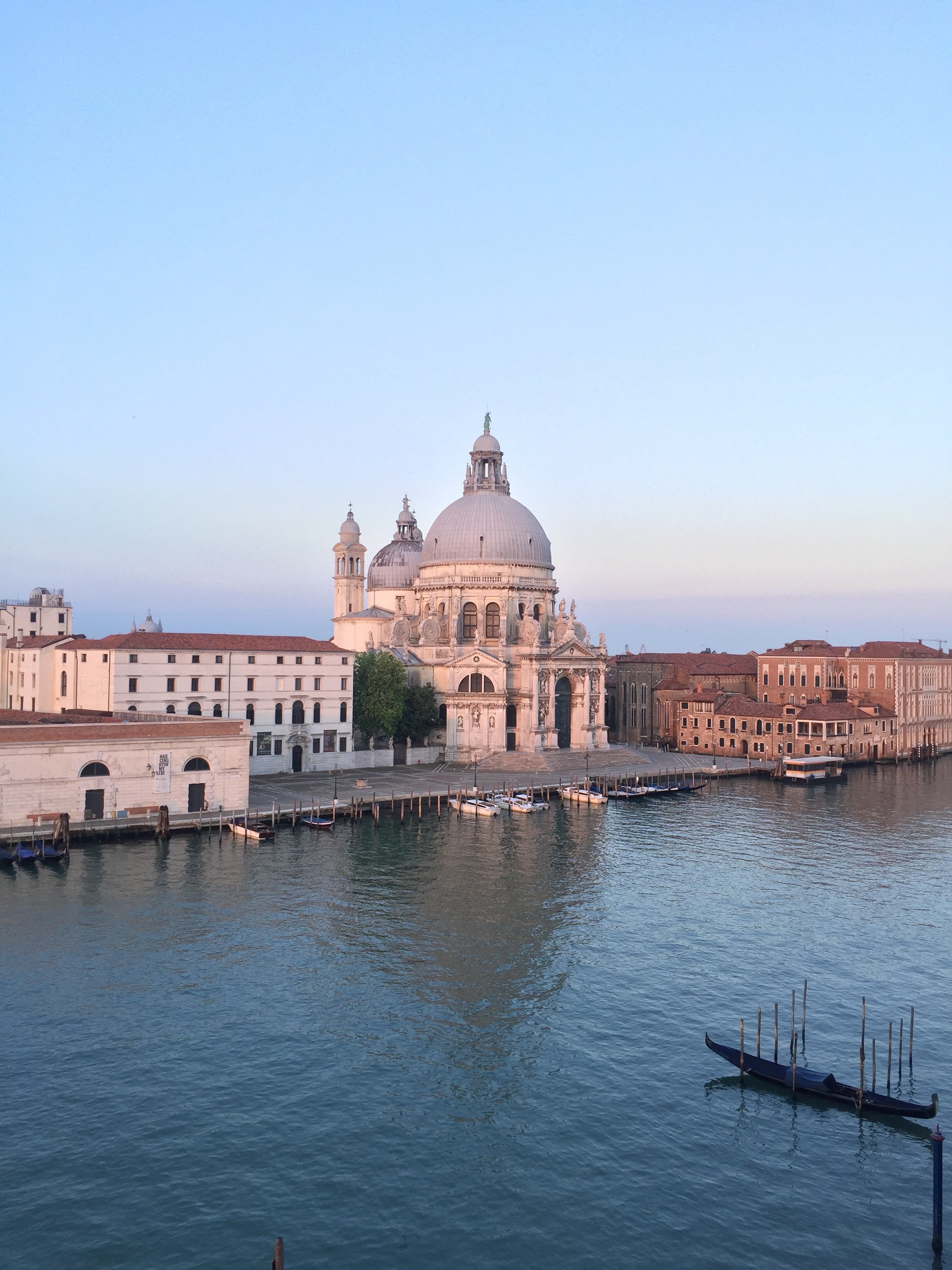 As we unpacked and got ready for aperitivi I noticed a chic terrace, a floor higher, on the building next door. I asked the bartender if it was a hotel bar. He said no they were preparing for a private party. I had no idea it was the party we were going to attended. It was a little overwhelming. There was were heavy hitters from the design/architect world and folks were not playing sartorially. The Hugos, and views, were divine.
As we unpacked and got ready for aperitivi I noticed a chic terrace, a floor higher, on the building next door. I asked the bartender if it was a hotel bar. He said no they were preparing for a private party. I had no idea it was the party we were going to attended. It was a little overwhelming. There was were heavy hitters from the design/architect world and folks were not playing sartorially. The Hugos, and views, were divine.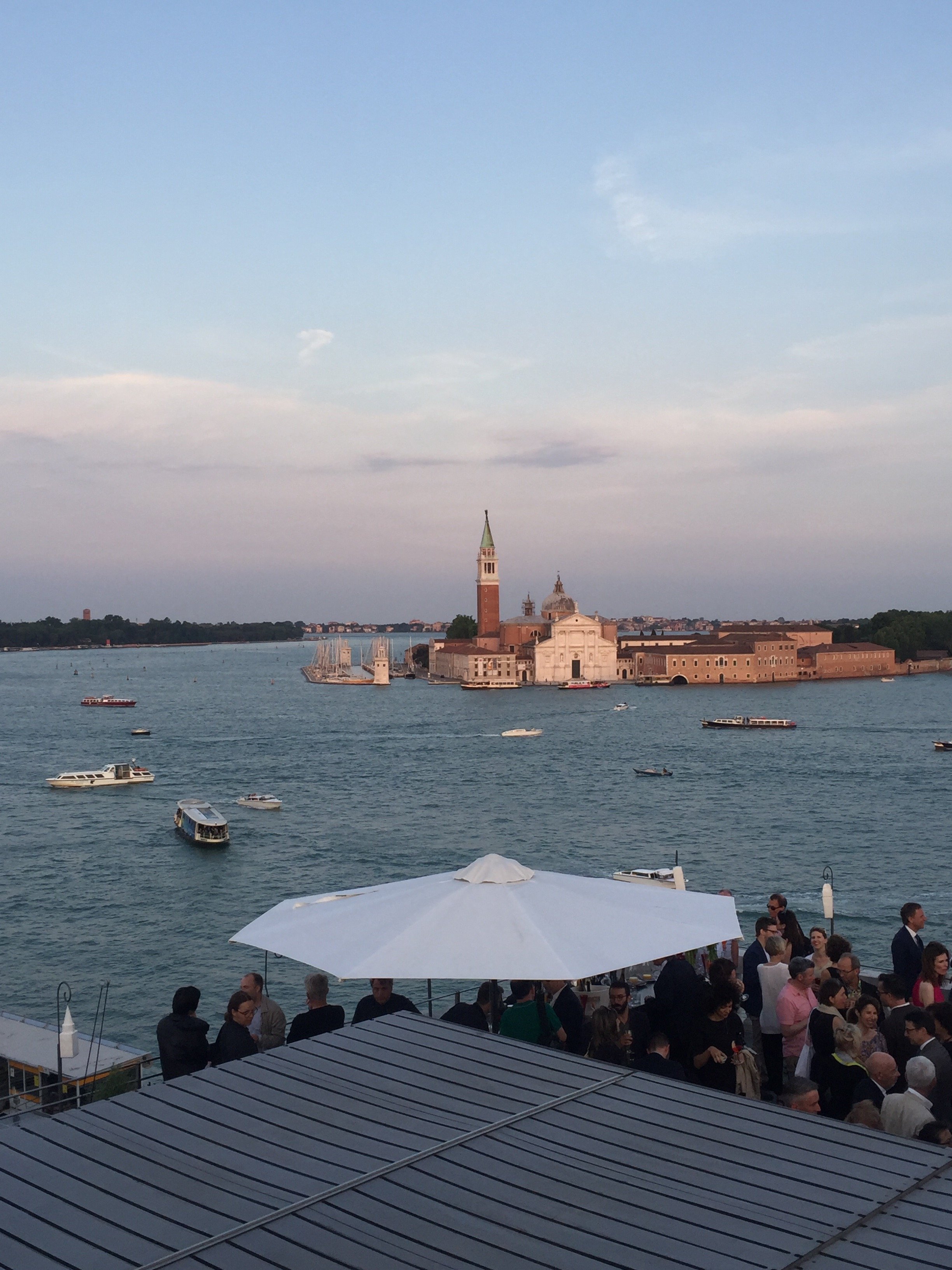 Post- reception, we had dinner on the patio of the hotel with canal view. During dinner I hear suddenly heard loud gasps. I looked to my left and saw a mega cruise ship rolling into the canal. It dwarfed the buildings. I have no words. Perhaps I'm hyper sensitive to these ships as I've seen what they've done to the quality of life for residents of the island of St. Martin/St. Maarten. I strongly believe the cons outweigh the pros.I woke up at the crack of dawn to jog and it was glorious. The city was quiet, with Venetians going to open their shops and getting ready for the new day. There were a few other tourists out jogging and some taking photos. I got lost in the side streets running toward the Rialto bridge. I didn't mind. It's surreal to be in a city where there are no cars, buses, etc. everything is brought in, and leaves, by boat. I understand why this special city has inspired writers, artists, and artisans for generations. It's a damn shame that it's being destroyed.
Post- reception, we had dinner on the patio of the hotel with canal view. During dinner I hear suddenly heard loud gasps. I looked to my left and saw a mega cruise ship rolling into the canal. It dwarfed the buildings. I have no words. Perhaps I'm hyper sensitive to these ships as I've seen what they've done to the quality of life for residents of the island of St. Martin/St. Maarten. I strongly believe the cons outweigh the pros.I woke up at the crack of dawn to jog and it was glorious. The city was quiet, with Venetians going to open their shops and getting ready for the new day. There were a few other tourists out jogging and some taking photos. I got lost in the side streets running toward the Rialto bridge. I didn't mind. It's surreal to be in a city where there are no cars, buses, etc. everything is brought in, and leaves, by boat. I understand why this special city has inspired writers, artists, and artisans for generations. It's a damn shame that it's being destroyed.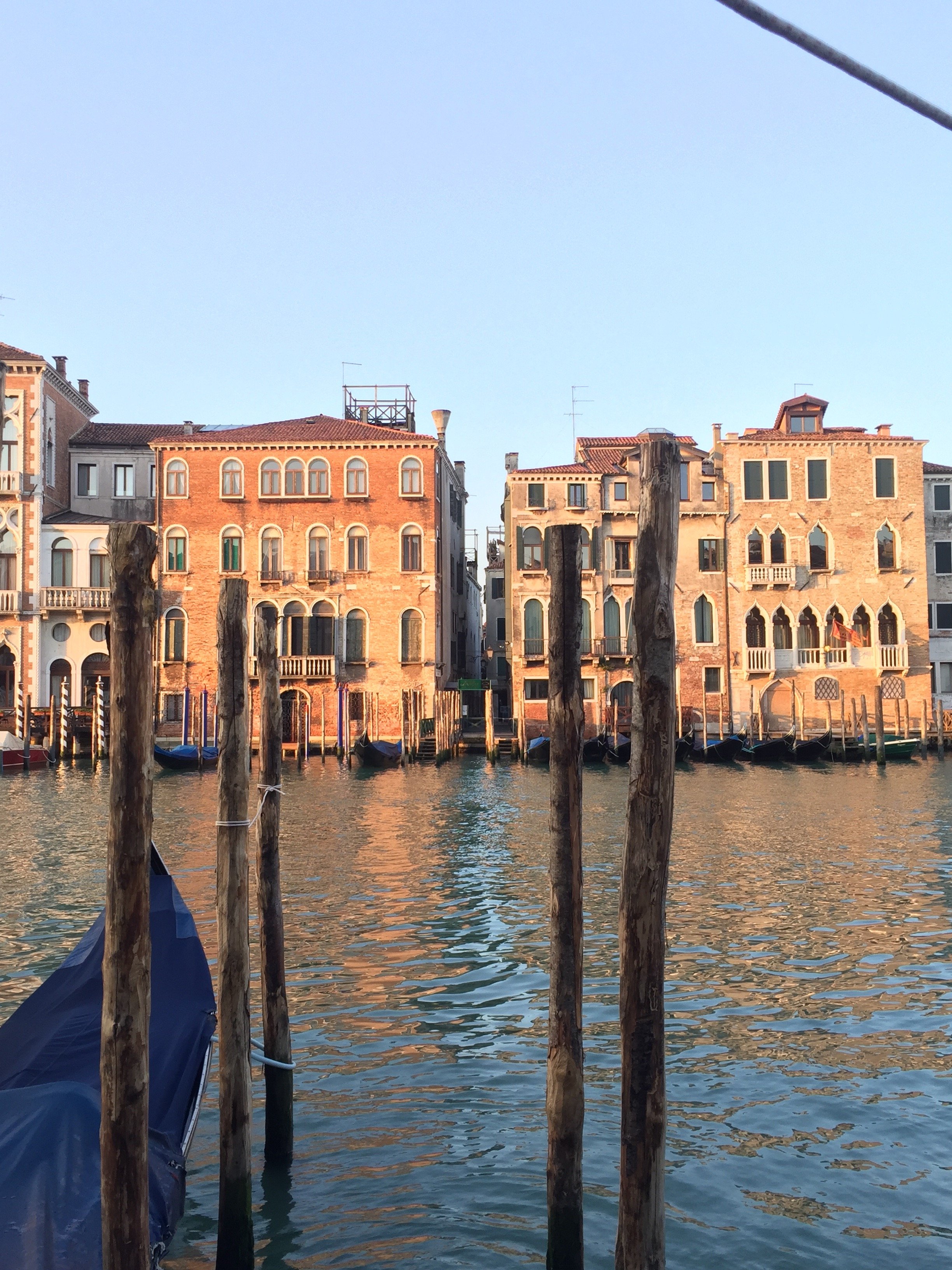
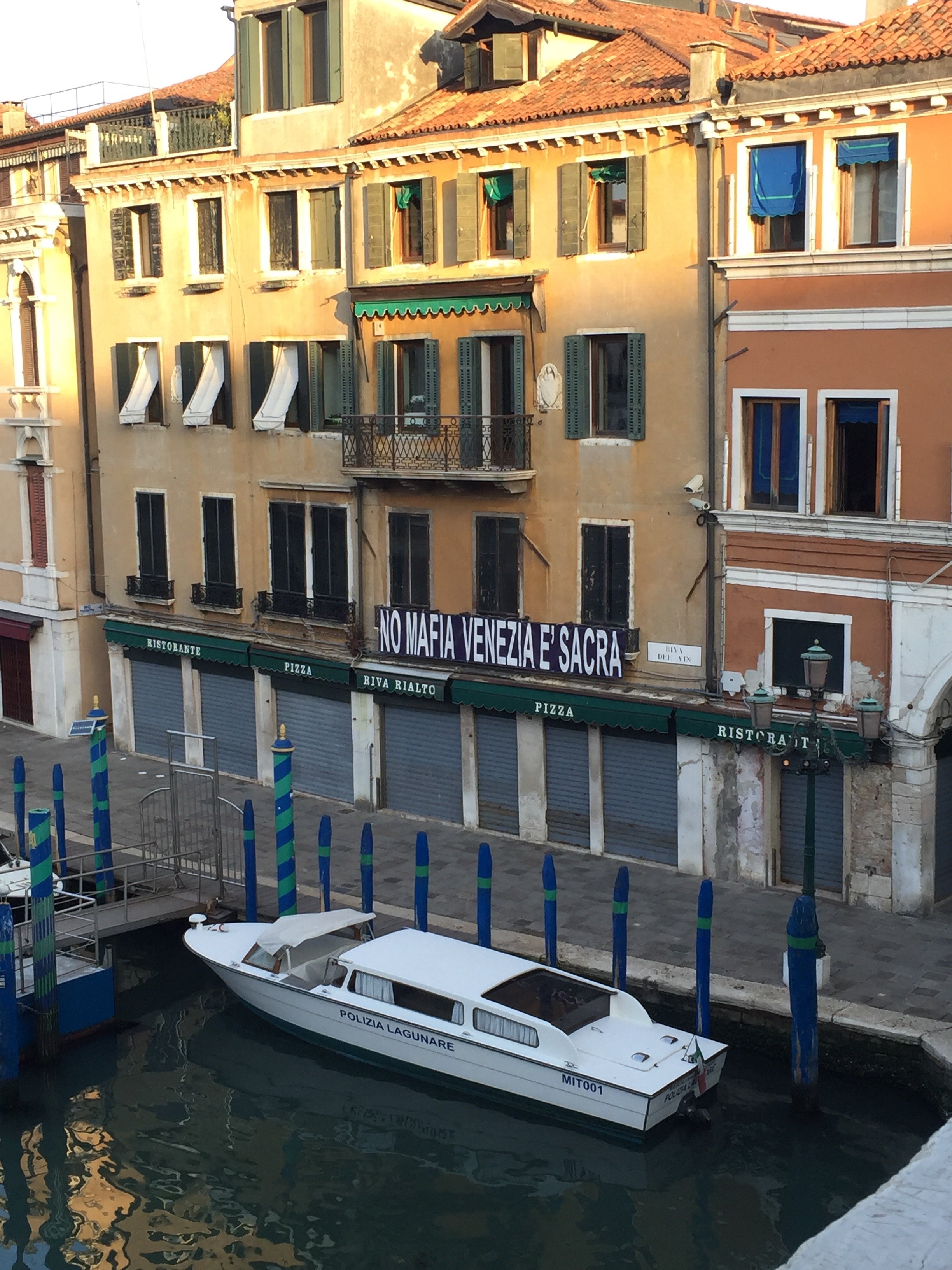
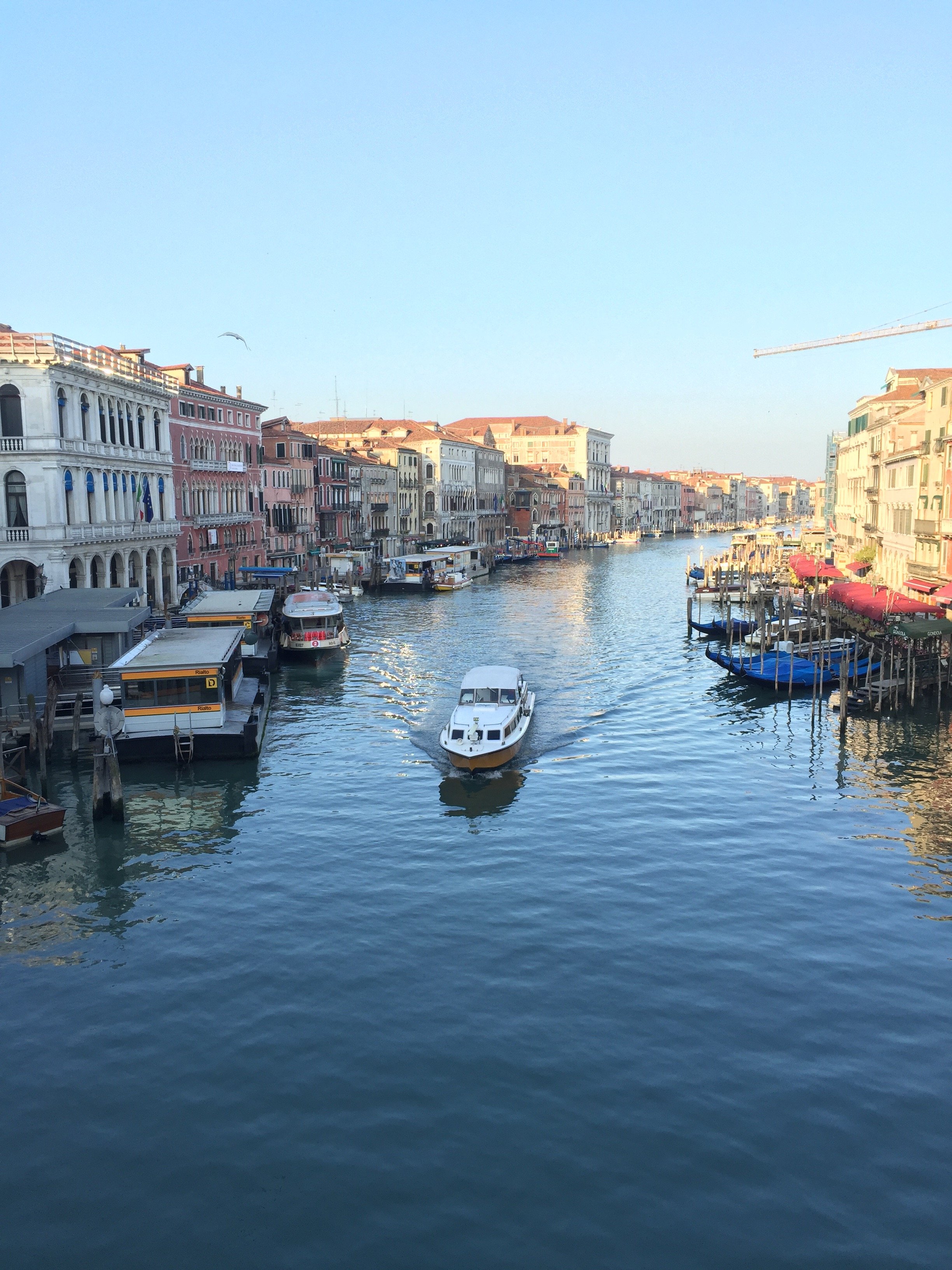 Erica and I had a delicious breakfast on the Bauer's rooftop terrace. We were picked up (on time!) and took a our boat to the Giardini (the gardens) to see more pavilions.
Erica and I had a delicious breakfast on the Bauer's rooftop terrace. We were picked up (on time!) and took a our boat to the Giardini (the gardens) to see more pavilions.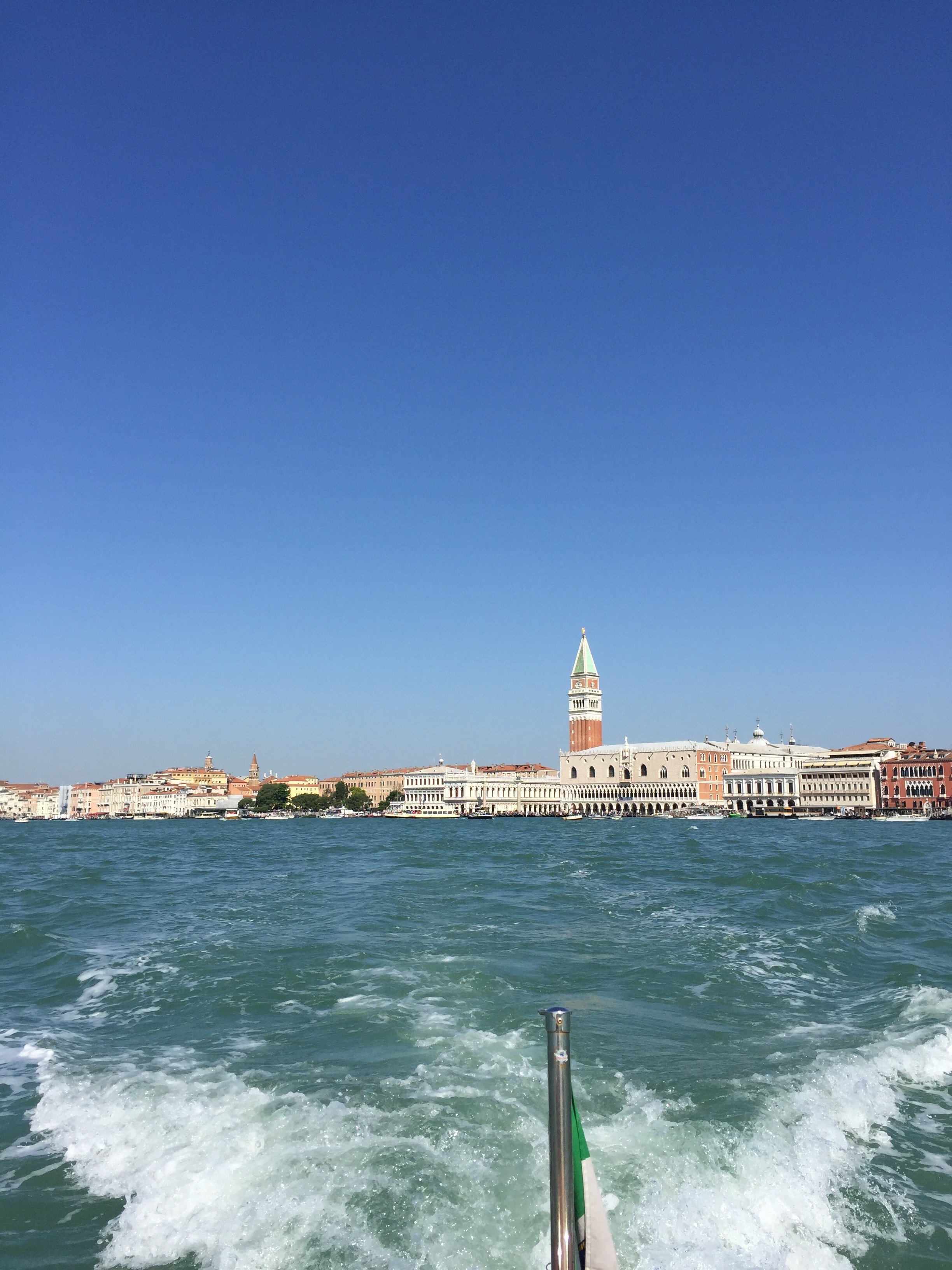
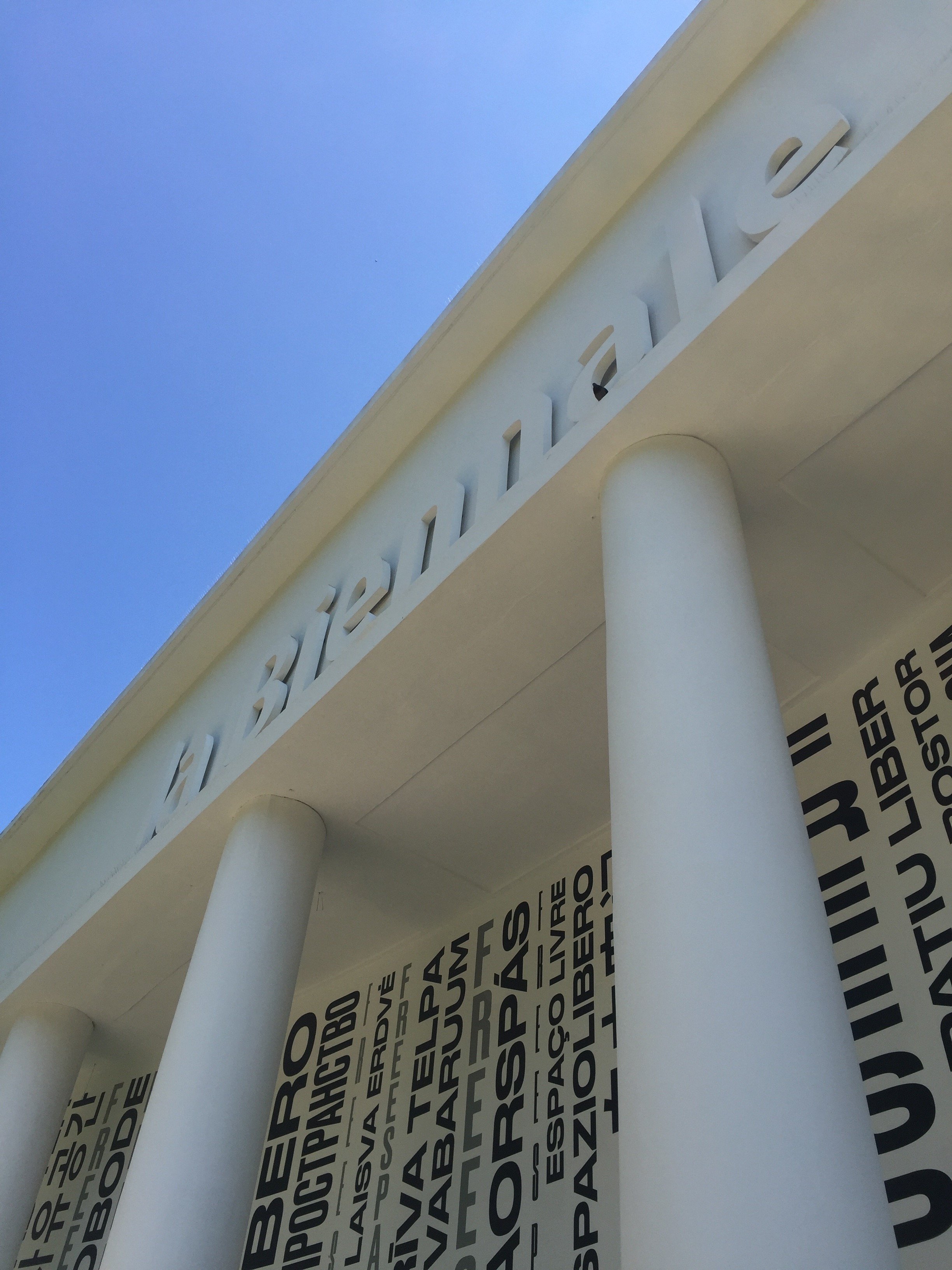
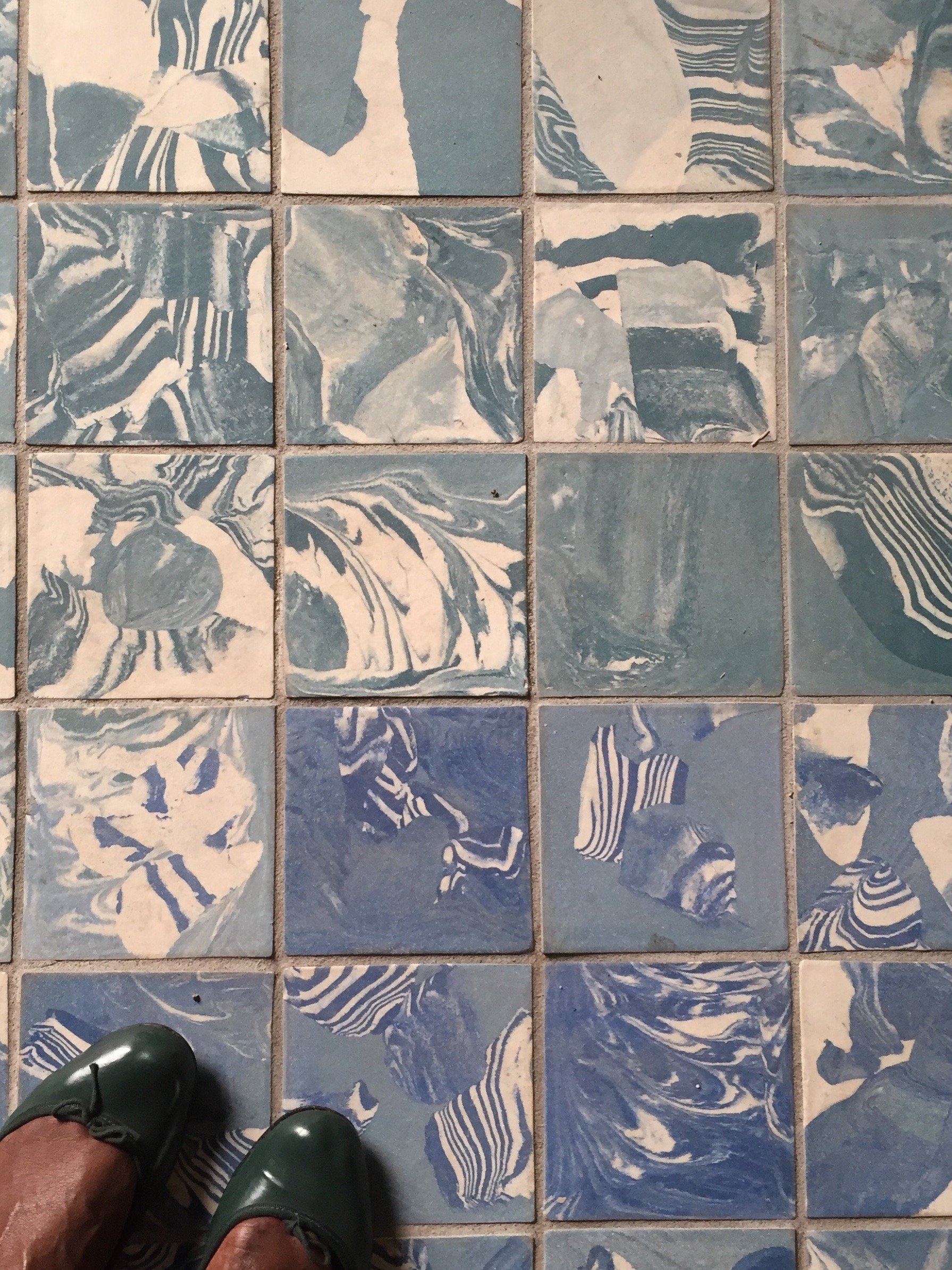 We had a guided tour of the Main Pavilion. I highly recommend checking it out. There was a very interesting scale of the NYC Project, one for a Los Angeles project, and several short films. Then we were on our own to see the rest. I have to say, I was fading fast. There was so much to take in. I missed many pavilions that I wanted to see, like Switzerland, and Antique & Barbuda. There wasn't enough time. Of the ones I made it to, America, Nordic (Finland, Norway, Sweden), Russia, France, were stand outs. I loved the roof top deck of Great Britain and France's wine set-up was very clever.
We had a guided tour of the Main Pavilion. I highly recommend checking it out. There was a very interesting scale of the NYC Project, one for a Los Angeles project, and several short films. Then we were on our own to see the rest. I have to say, I was fading fast. There was so much to take in. I missed many pavilions that I wanted to see, like Switzerland, and Antique & Barbuda. There wasn't enough time. Of the ones I made it to, America, Nordic (Finland, Norway, Sweden), Russia, France, were stand outs. I loved the roof top deck of Great Britain and France's wine set-up was very clever.
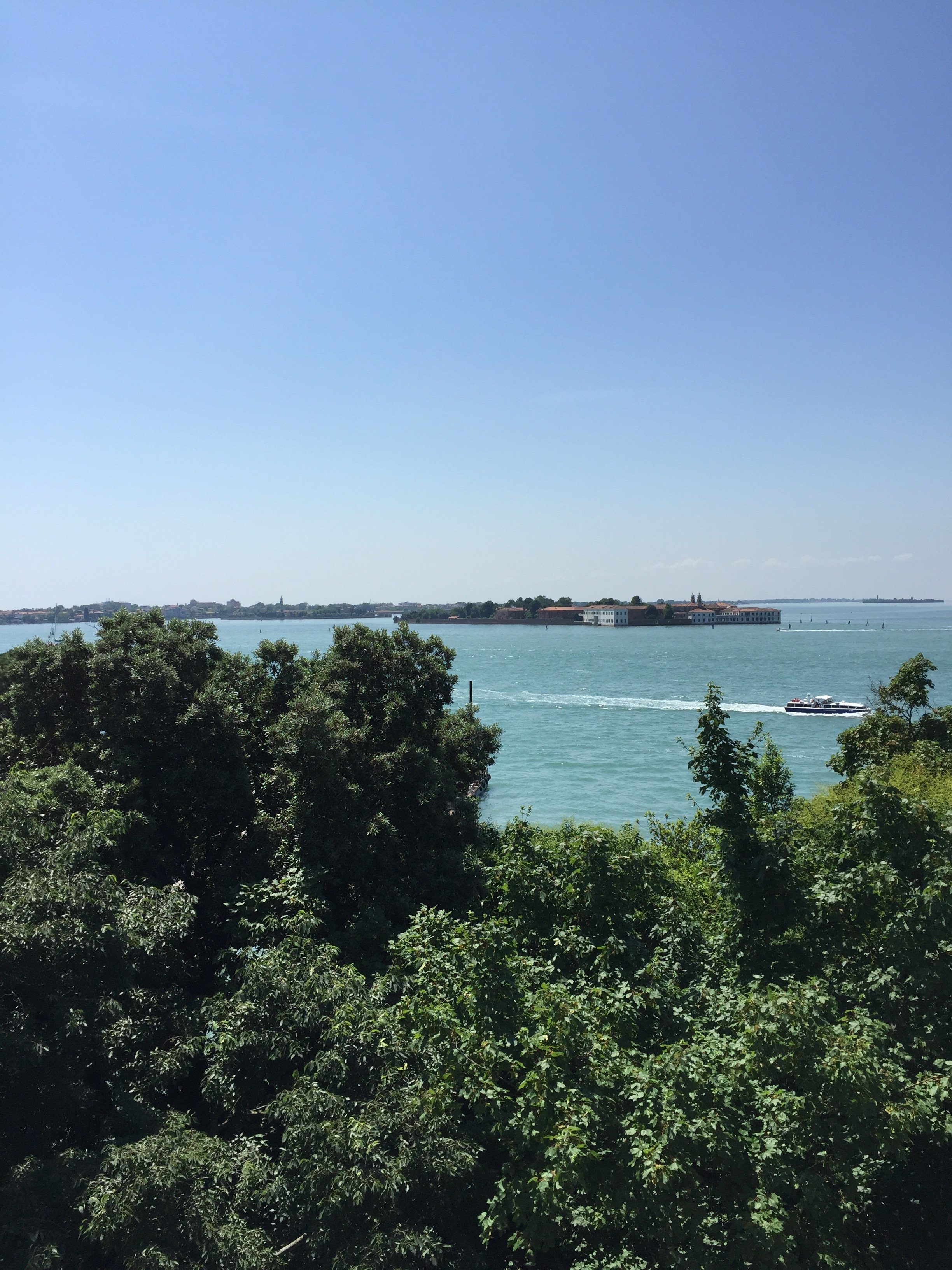
 The Russian theme was about train travel and how the largest country in the world is impacted by it. There are areas that are inaccessible by train and the country spans a few timezones, There was a short film, SEVEN DAYS IN SEVEN MINUTES, regarding a man's 9,300km/5780 miles train journey to Siberia. The Pavilion was transformed into a train station with several multimedia exhibits.The Nordic Pavilion dwelt with climate change. Visually this was one of the most interesting pavilions. The large balloons inflated and deflated depending on changing environmental conditions.The American theme was Dimensions of Citizenship, which really resonated with me. There was a fascinating short film, IN PLAIN SIGHT, that used data from global space sensors showing us how humans have organized our planet. It touched on last year's hurricane season and the difference between Houston's recovering and Puerto Rico's. I was blown away by the places that had large population but no lights, and other spots with a large electrical grid but it was used only for tourists or farming.We ended our trip with an delicious outdoor lunch at Corte Sconta. Corte Sconta means, "hidden courtyard". Our meals were included in the trip so I cannot tell you how the prices were. I get the sense that Corte Sconta was the pricier of the two but it wasn't stuffy.It was hot and walking over ten miles in one day got the best of me. By the time I had to meet our group, I was completely exhausted not really physically but it was information overload. It was a lot to process.It's an incredible experience and it was unique to have these conversations in a city like Venice. I was inspired by the architects and designers I met, the Pavilions, and of course the city itself. Grazie mille, Erica.To see more photos and videos from our short trip, I've saved them in my Instastories.The 16th International Architecture Exhibition runs until November 25th, 2018.
The Russian theme was about train travel and how the largest country in the world is impacted by it. There are areas that are inaccessible by train and the country spans a few timezones, There was a short film, SEVEN DAYS IN SEVEN MINUTES, regarding a man's 9,300km/5780 miles train journey to Siberia. The Pavilion was transformed into a train station with several multimedia exhibits.The Nordic Pavilion dwelt with climate change. Visually this was one of the most interesting pavilions. The large balloons inflated and deflated depending on changing environmental conditions.The American theme was Dimensions of Citizenship, which really resonated with me. There was a fascinating short film, IN PLAIN SIGHT, that used data from global space sensors showing us how humans have organized our planet. It touched on last year's hurricane season and the difference between Houston's recovering and Puerto Rico's. I was blown away by the places that had large population but no lights, and other spots with a large electrical grid but it was used only for tourists or farming.We ended our trip with an delicious outdoor lunch at Corte Sconta. Corte Sconta means, "hidden courtyard". Our meals were included in the trip so I cannot tell you how the prices were. I get the sense that Corte Sconta was the pricier of the two but it wasn't stuffy.It was hot and walking over ten miles in one day got the best of me. By the time I had to meet our group, I was completely exhausted not really physically but it was information overload. It was a lot to process.It's an incredible experience and it was unique to have these conversations in a city like Venice. I was inspired by the architects and designers I met, the Pavilions, and of course the city itself. Grazie mille, Erica.To see more photos and videos from our short trip, I've saved them in my Instastories.The 16th International Architecture Exhibition runs until November 25th, 2018.
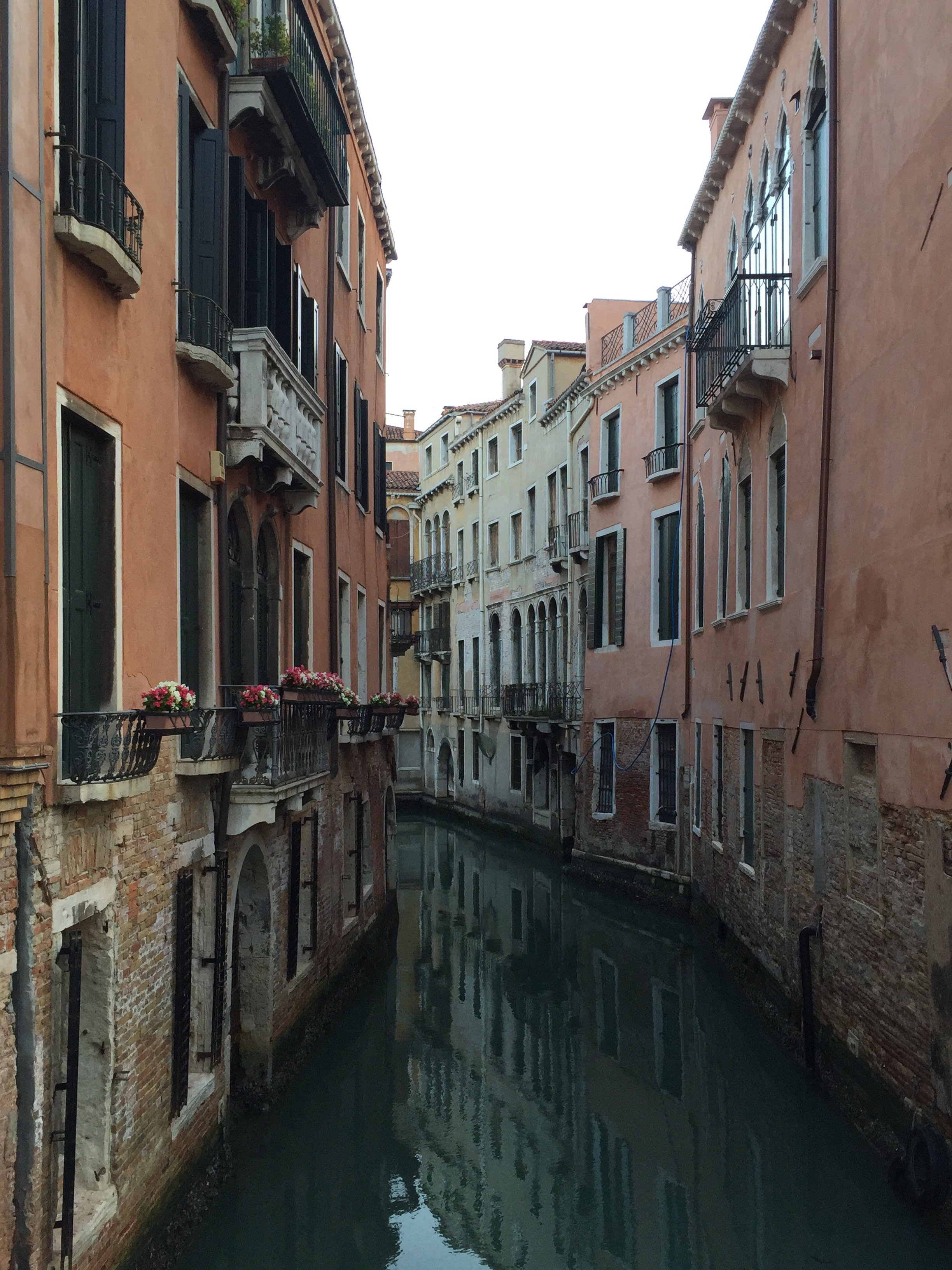
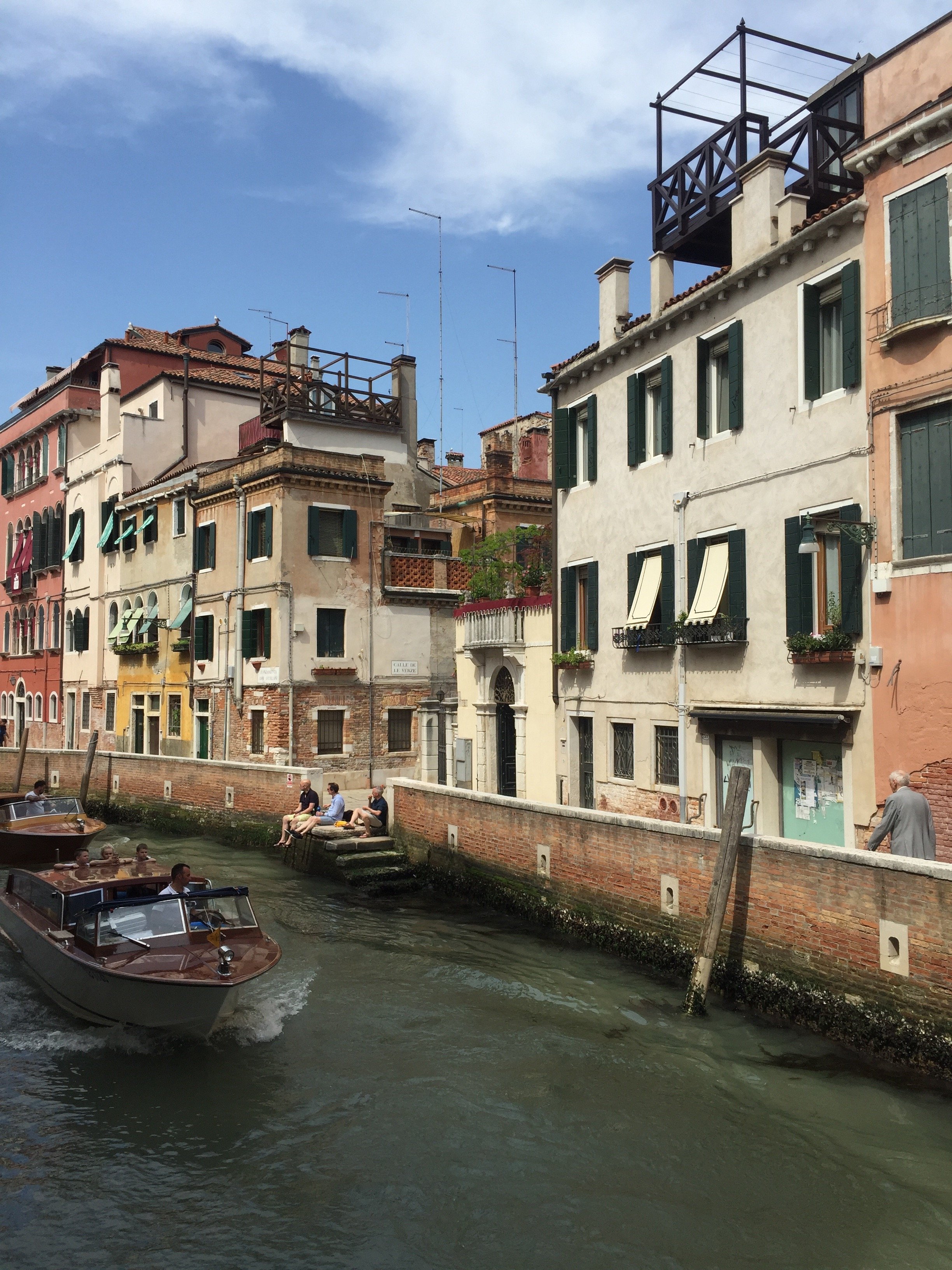

Montepulciano - Under A Tuscan Sun
The other week, my friend Michelle and I decided to meet in Chiusi for lunch and then take the train to Montepulciano, a hill town in southern Tuscany near Siena.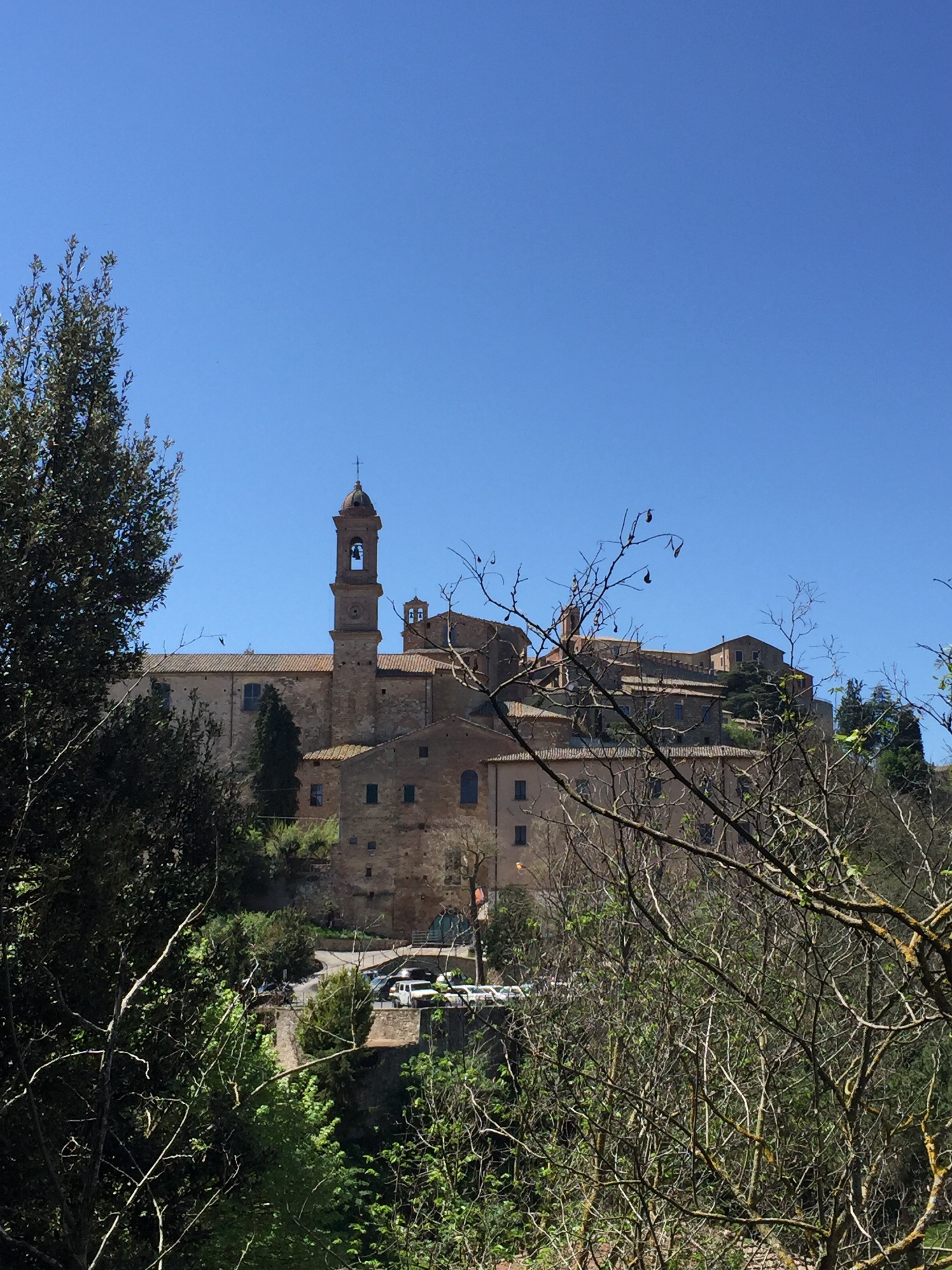 Michelle lives in Florence and Chiusi was the prefect half-way point. However, once we were in Chiusi we saw the sporadic train schedule and noticed that there was a bus leaving in thirty minutes. We took it.It was great move as we later found out that the train station is quite a distance from the hill town. The bus dropped us off right at the bottom of the hill.I've been to Montepulciano once before on a New Year's Day. It was freezing, packed with tourists, and quite a few places were closed for the holiday. Our day trip was the perfect time to go. It's wasn't too crowded and the weather was glorious.
Michelle lives in Florence and Chiusi was the prefect half-way point. However, once we were in Chiusi we saw the sporadic train schedule and noticed that there was a bus leaving in thirty minutes. We took it.It was great move as we later found out that the train station is quite a distance from the hill town. The bus dropped us off right at the bottom of the hill.I've been to Montepulciano once before on a New Year's Day. It was freezing, packed with tourists, and quite a few places were closed for the holiday. Our day trip was the perfect time to go. It's wasn't too crowded and the weather was glorious.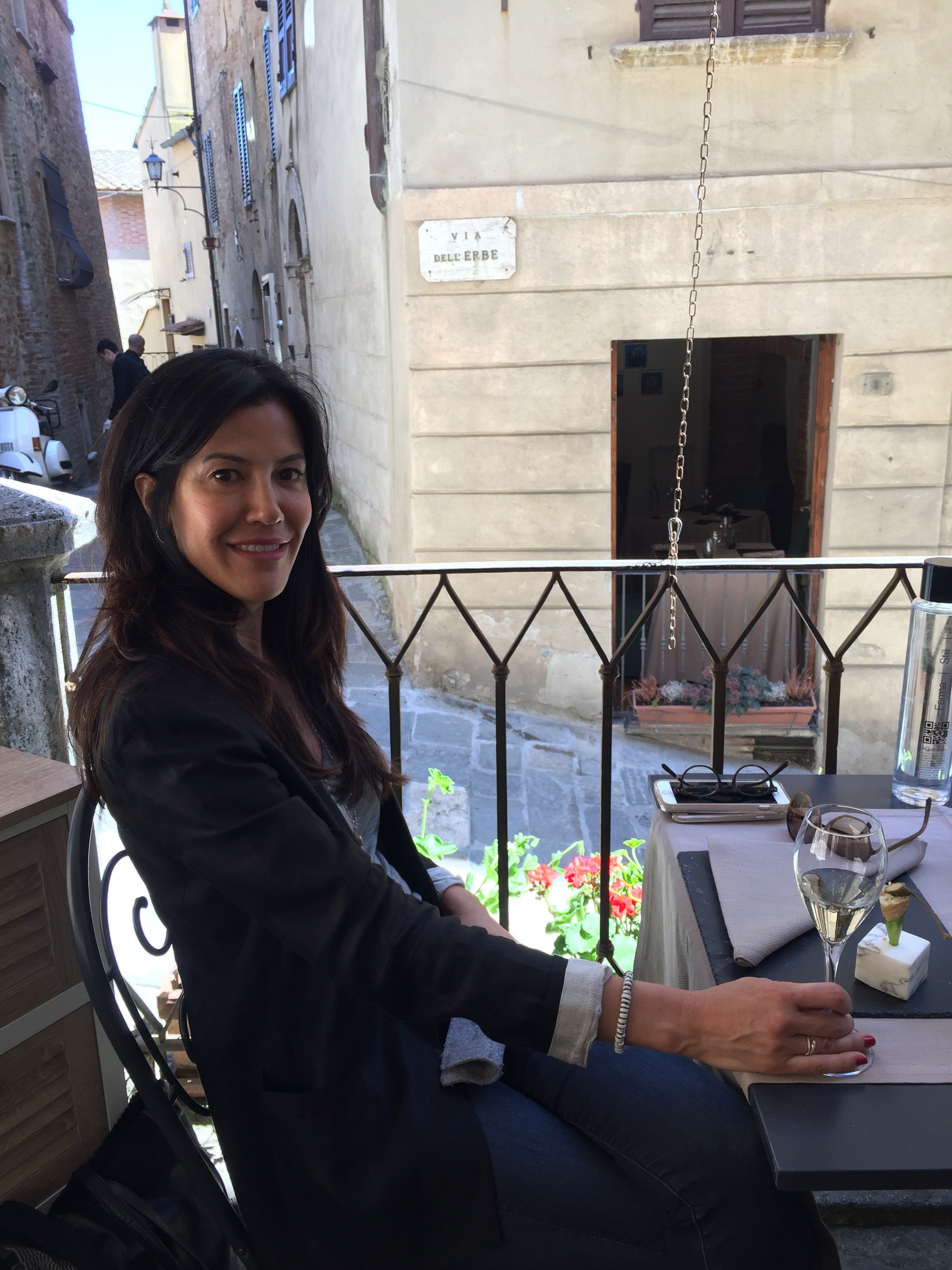
 Montepuclciano has a population of about 14,000. It's known for its Vino Nobile red wine (it's surrounded by vineyards), its architecture (no major new buildings since the 16th century) and the views.
Montepuclciano has a population of about 14,000. It's known for its Vino Nobile red wine (it's surrounded by vineyards), its architecture (no major new buildings since the 16th century) and the views. As you enter the main door/gate, you arrive at The Corso which is the commercial hub of the town. Take this winding street up, and up, until you reach Piazza Grande the beautiful main square. The unfinished brick facade of the Duomo is very striking.Montepulciano formed an alliance with Florence in 1511. The Medici's asked two of the most successful architects in Italy, Vignola and Antonio da Sangallo the Elder, to renovate many of the noble families's palazzi and to make the public spaces grander.
As you enter the main door/gate, you arrive at The Corso which is the commercial hub of the town. Take this winding street up, and up, until you reach Piazza Grande the beautiful main square. The unfinished brick facade of the Duomo is very striking.Montepulciano formed an alliance with Florence in 1511. The Medici's asked two of the most successful architects in Italy, Vignola and Antonio da Sangallo the Elder, to renovate many of the noble families's palazzi and to make the public spaces grander.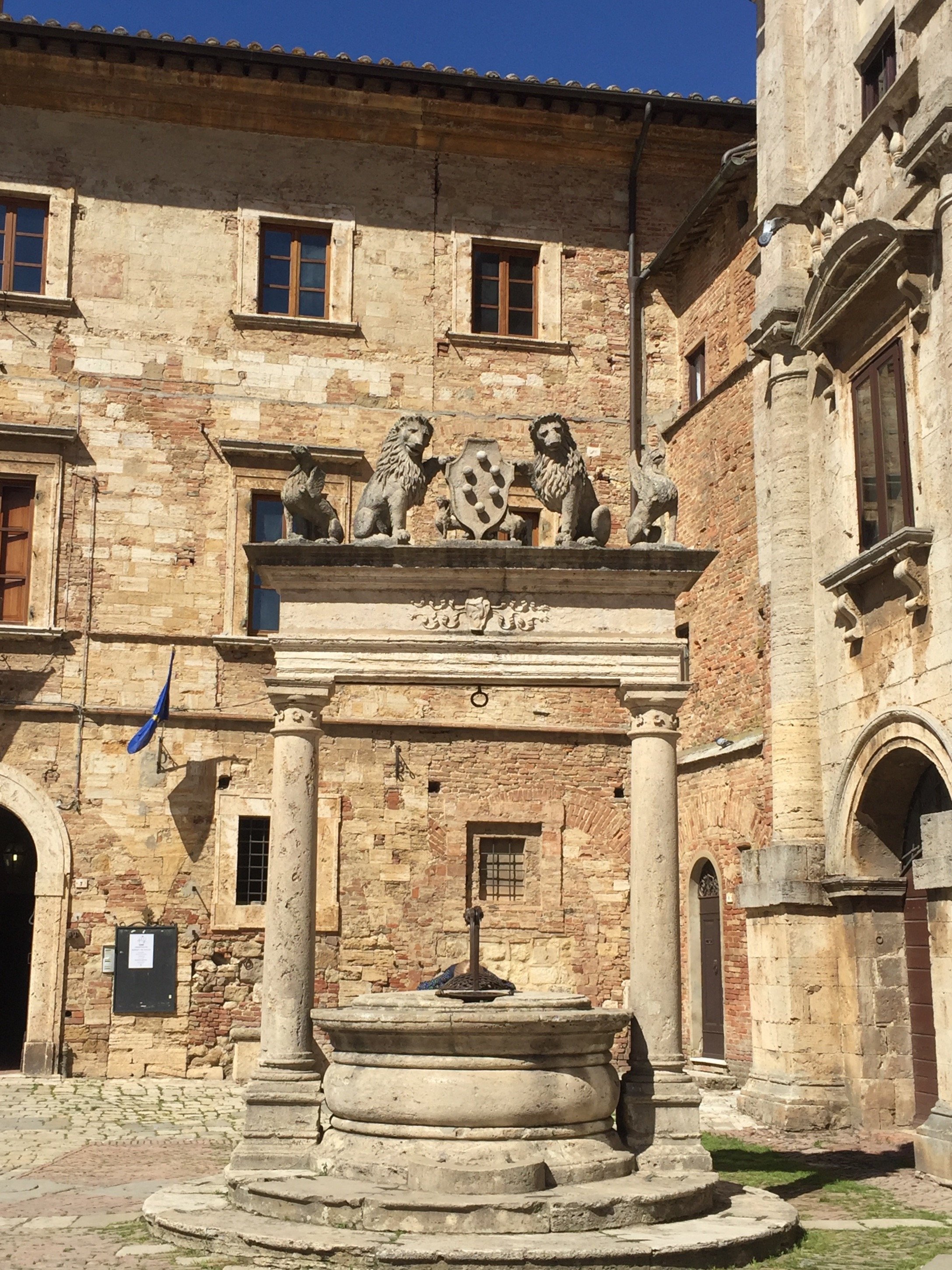
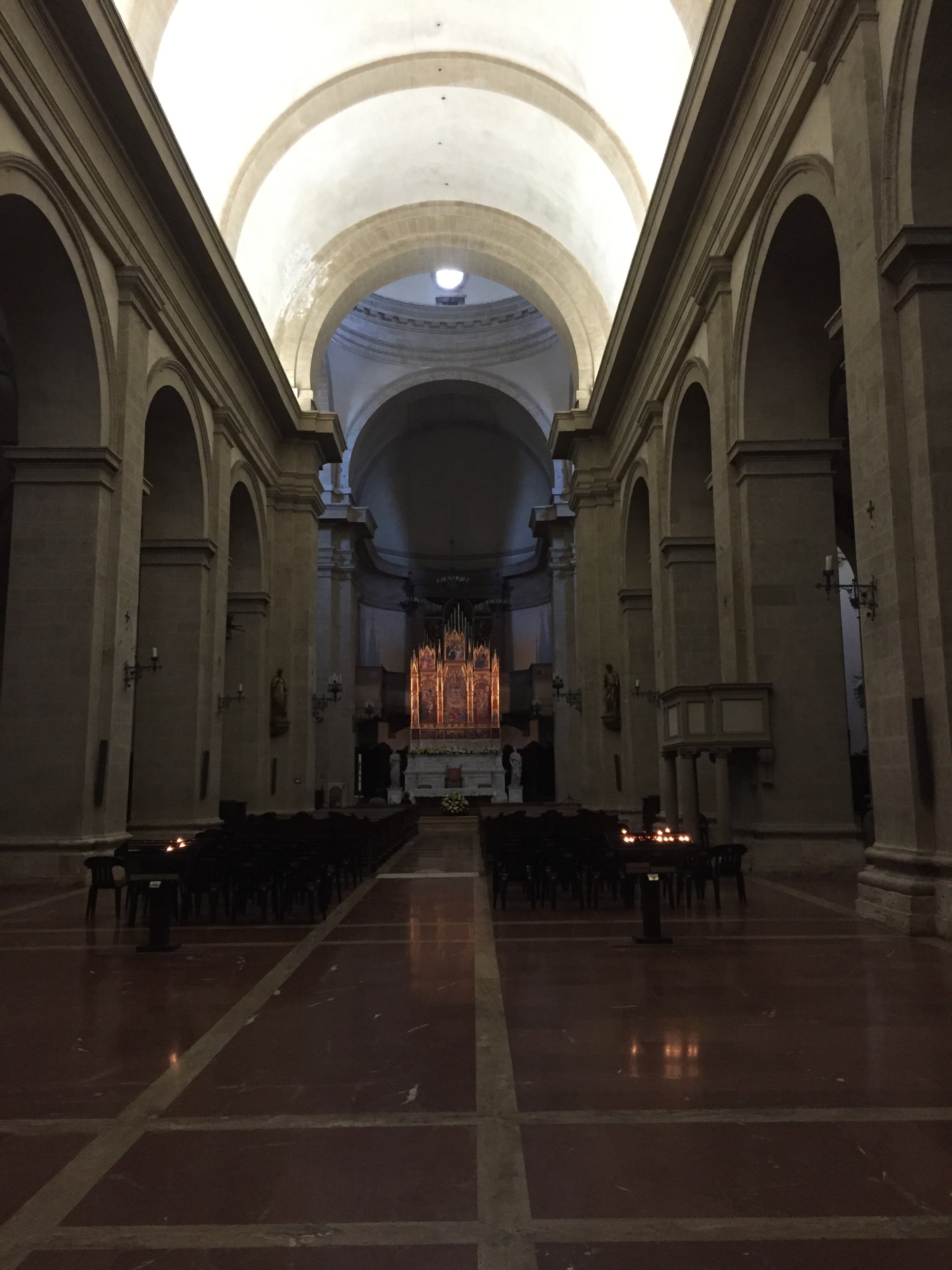 We ended our day in Montepulciano with aperitivi at the historic Caffè Poliziano. We met up with two of Michelle's friends who were on their way to Umbria. The Caffè was opened in 1886 and is a favorite with the locals for coffee. Of course prices are lower if you stand at the bar. If you can get one of the tiny tables on the small back terrace, do. These views are worth the price
We ended our day in Montepulciano with aperitivi at the historic Caffè Poliziano. We met up with two of Michelle's friends who were on their way to Umbria. The Caffè was opened in 1886 and is a favorite with the locals for coffee. Of course prices are lower if you stand at the bar. If you can get one of the tiny tables on the small back terrace, do. These views are worth the price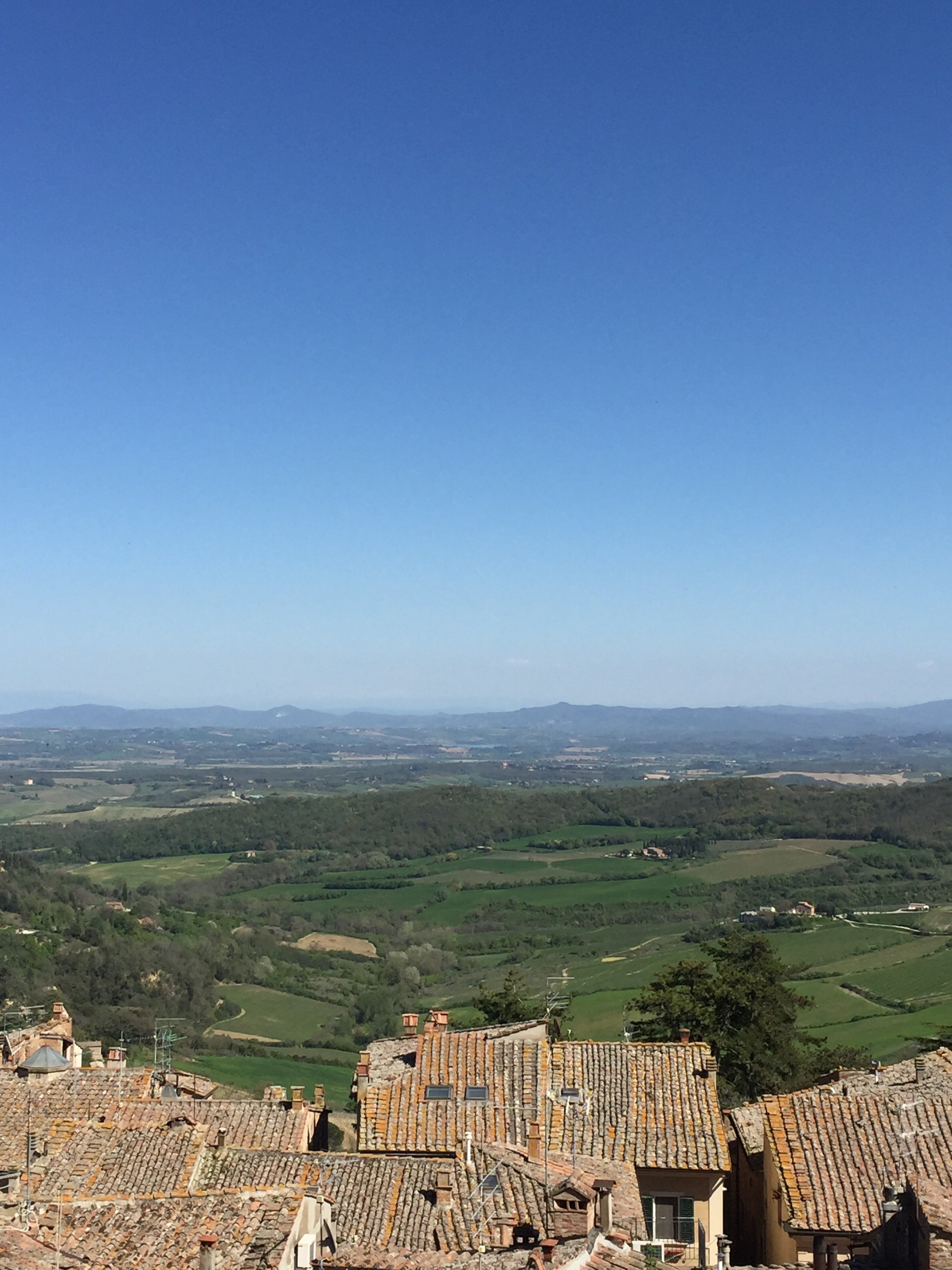

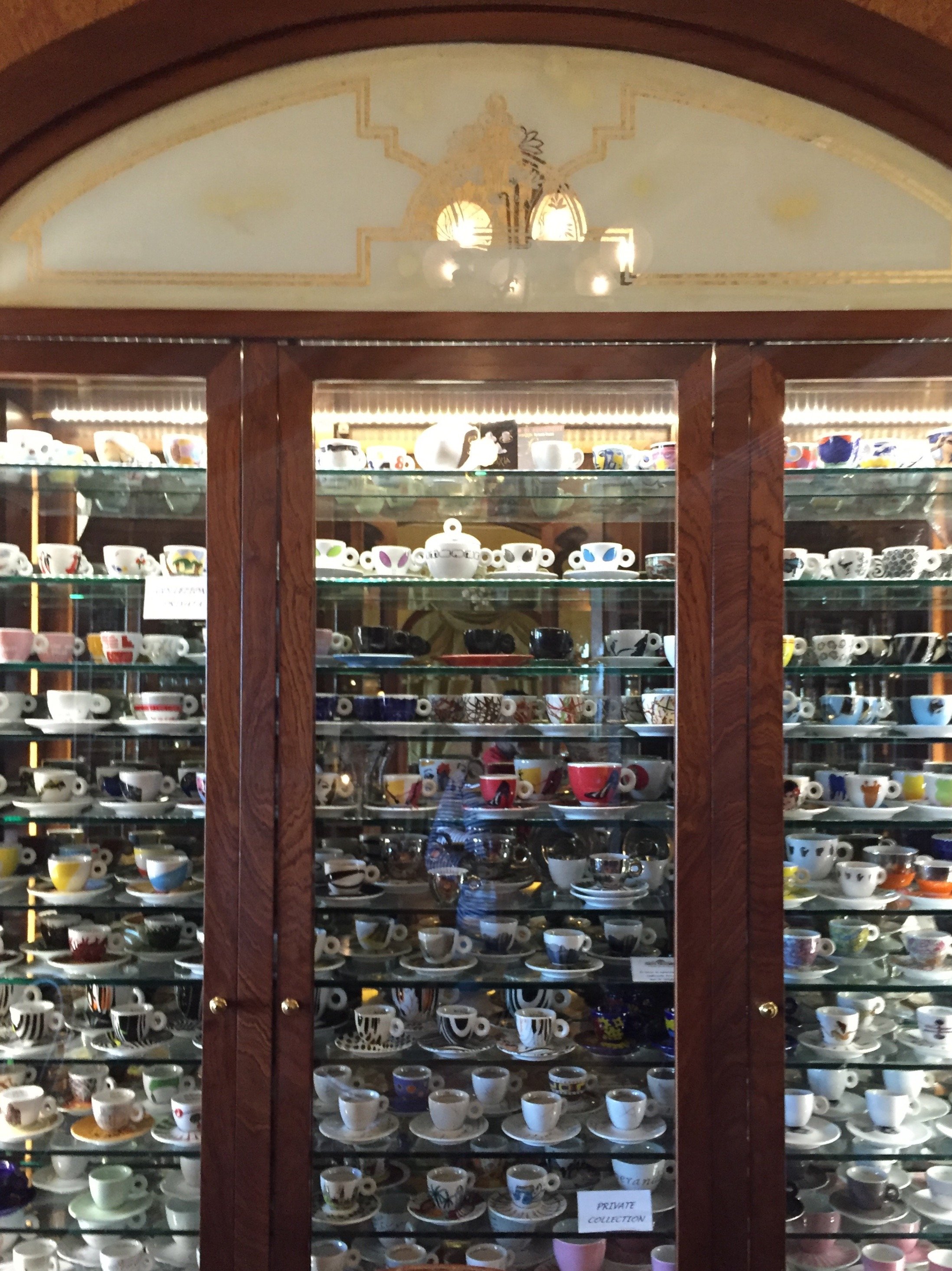
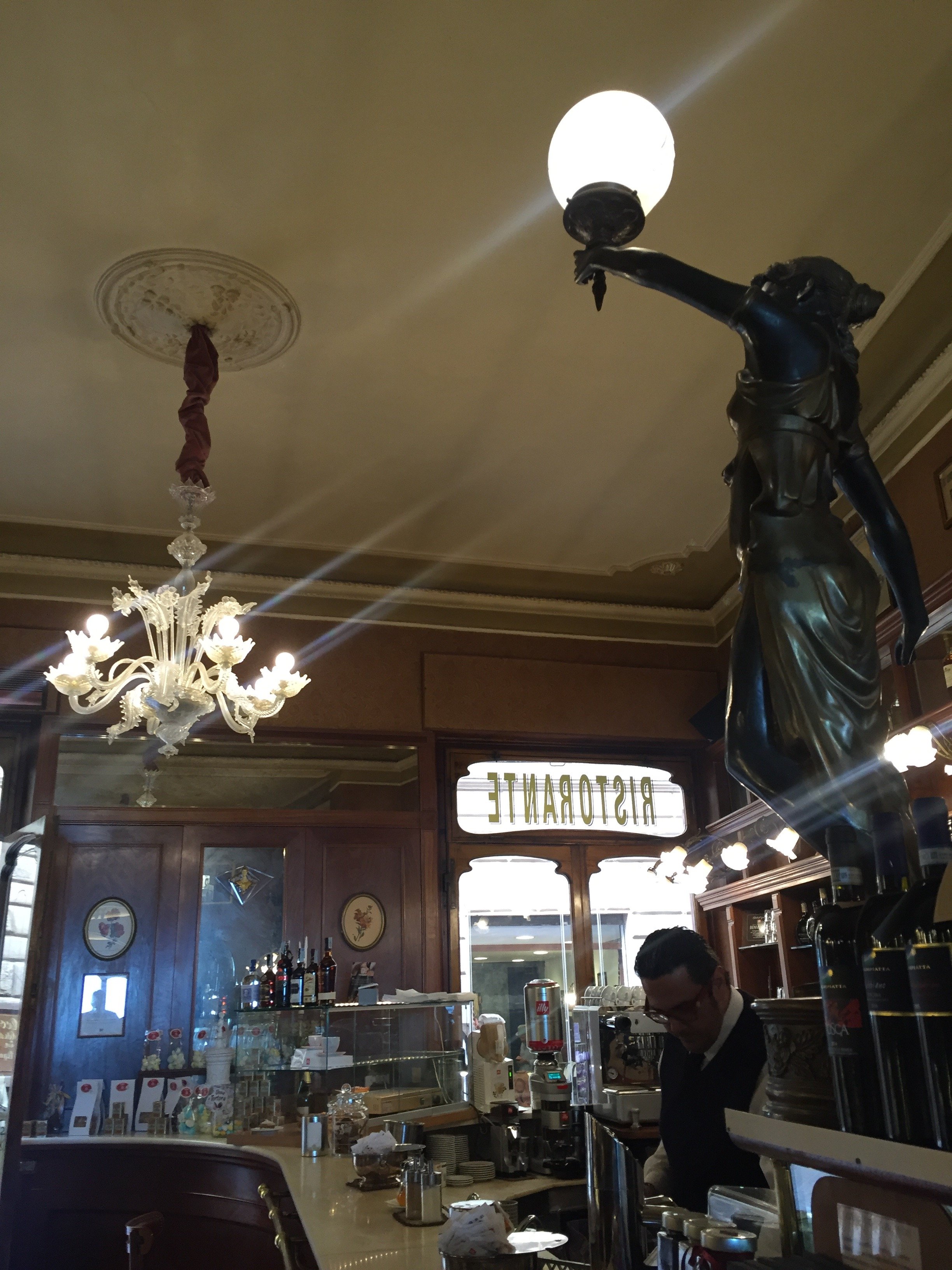
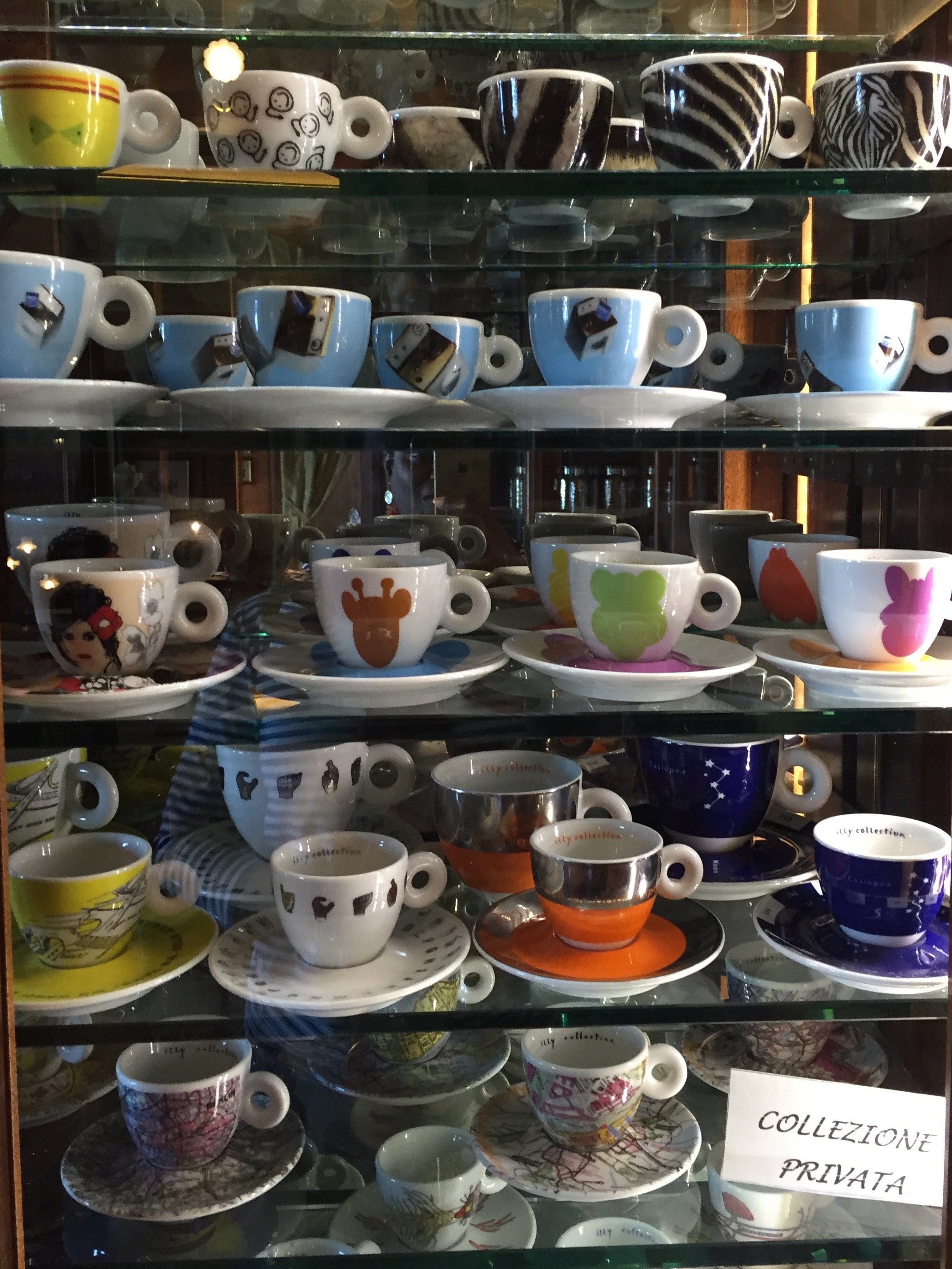
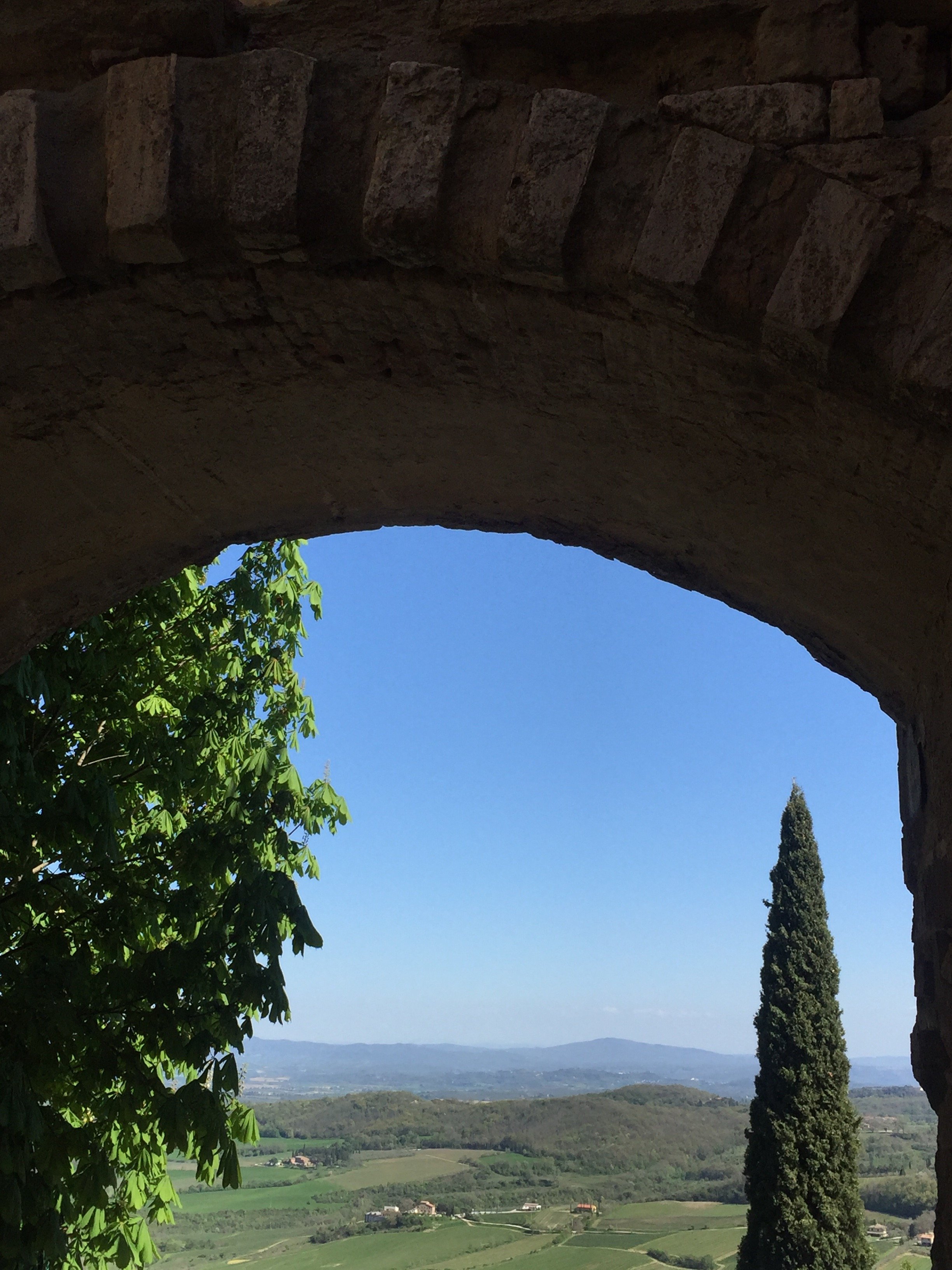 I must to return to Montepulciano and hope to visit Sangallo's masterpiece, San Biagio. The church is located a few meters from the hilltop's walls and inspired St. Peter's Basilica and other churches.
I must to return to Montepulciano and hope to visit Sangallo's masterpiece, San Biagio. The church is located a few meters from the hilltop's walls and inspired St. Peter's Basilica and other churches.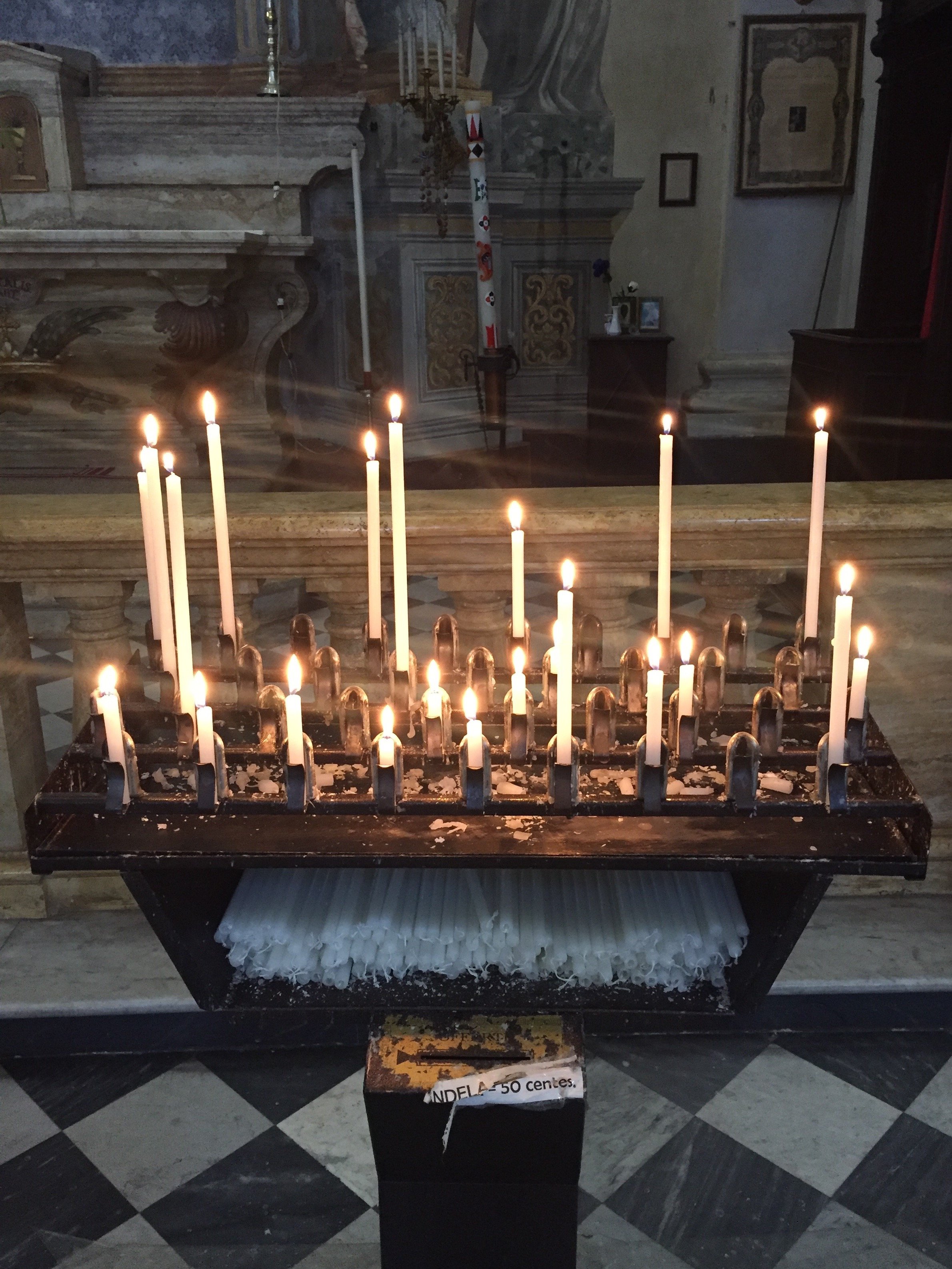
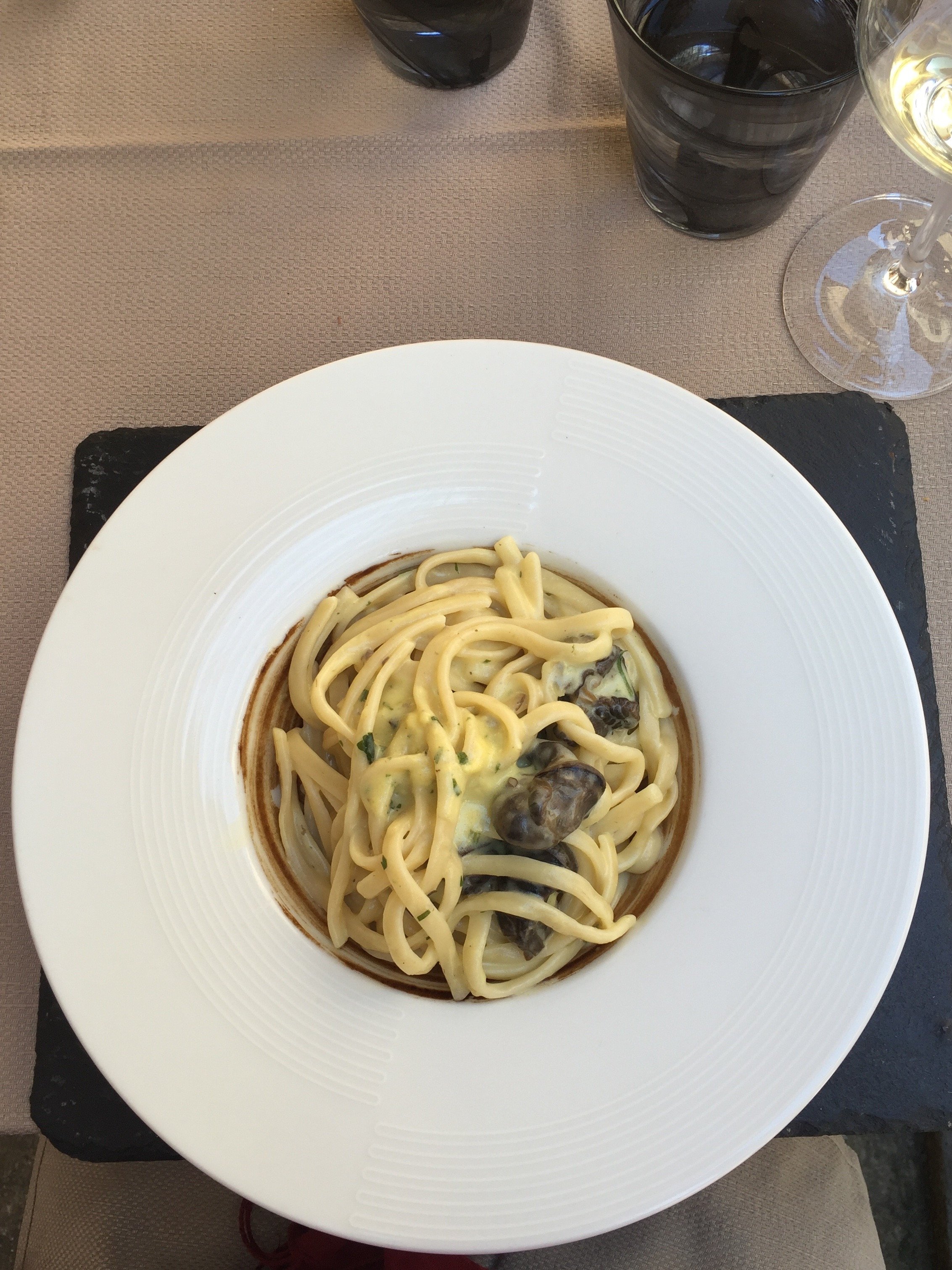
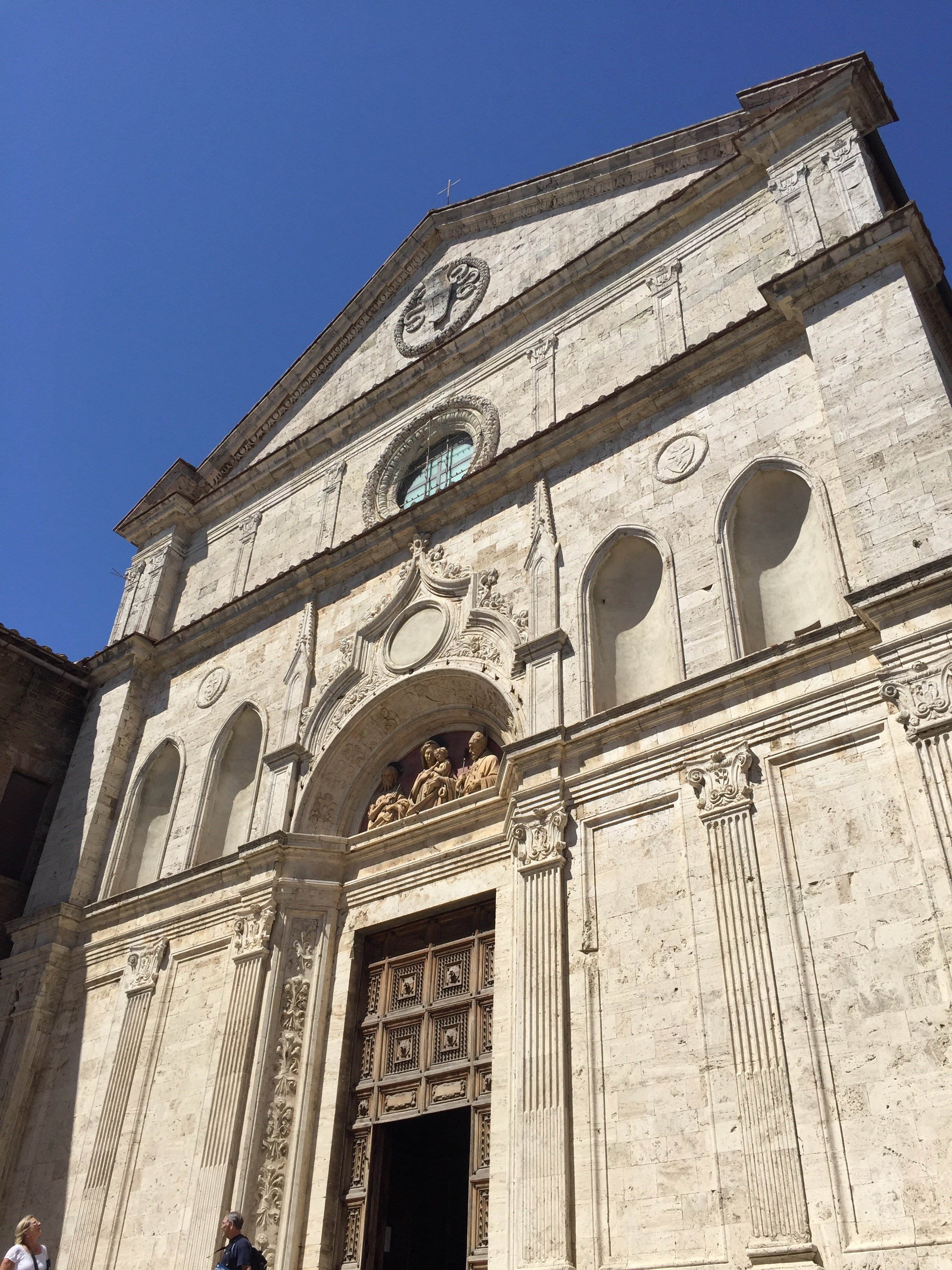
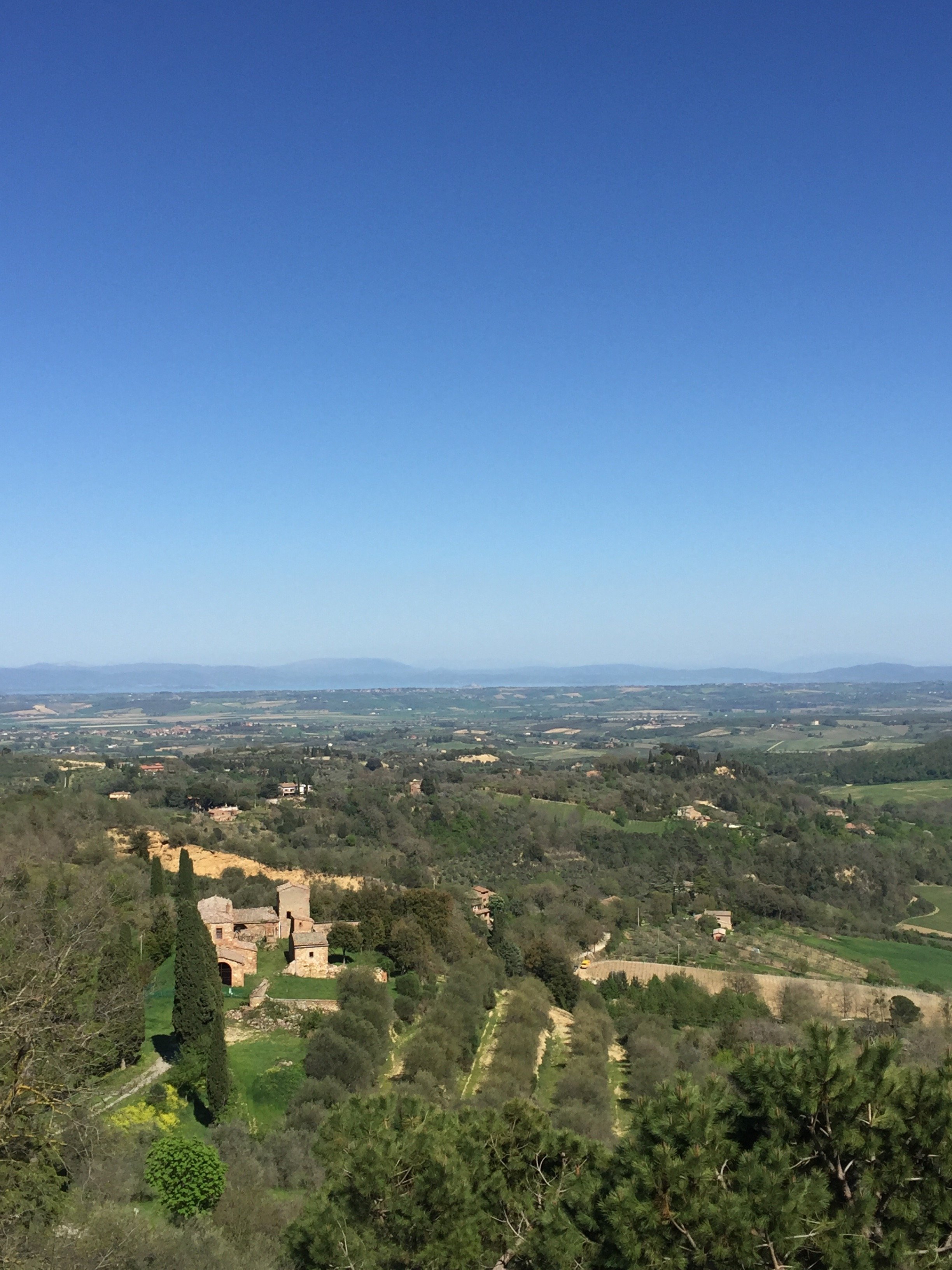 Photos: Me and my iPhone
Photos: Me and my iPhone
Design Inspiration - Palazzo Reale, Naples, Italy
The Royal Palace of Naples is a must on my list of things to do in Naples. I wasn't able to visit until my third trip and now I want to return just so I could spend more time there.The audio tour is interesting and informative. Palazzo Reale is one of four royal palaces in and near Naples. Construction, with prominent architect Domenico Fontana, started in the 17th century by the Spanish Viceroys initially as a home to host the visiting King of Spain. He never came (so rude!) and the palace eventually became the home of various rulers, including the Bourbons and the Savoys. The Kingdom of Naples was fought over by the French and Spain for centuries. At times the Kingdom included most of southern Italy, and Sicily.The Palace was expanded over the years. Napoleon's sister, Caroline, lived in the Palace with her husband Joachim Murat (aka the Dandy King) who was the King from 1808-1815.The building suffered extensive damage from bombing during WWII but was restored.Below is the main staircase. It was very cloudy and overcast when I arrived. I still gasped when I walked in and saw this space. Pictures do not do it justice.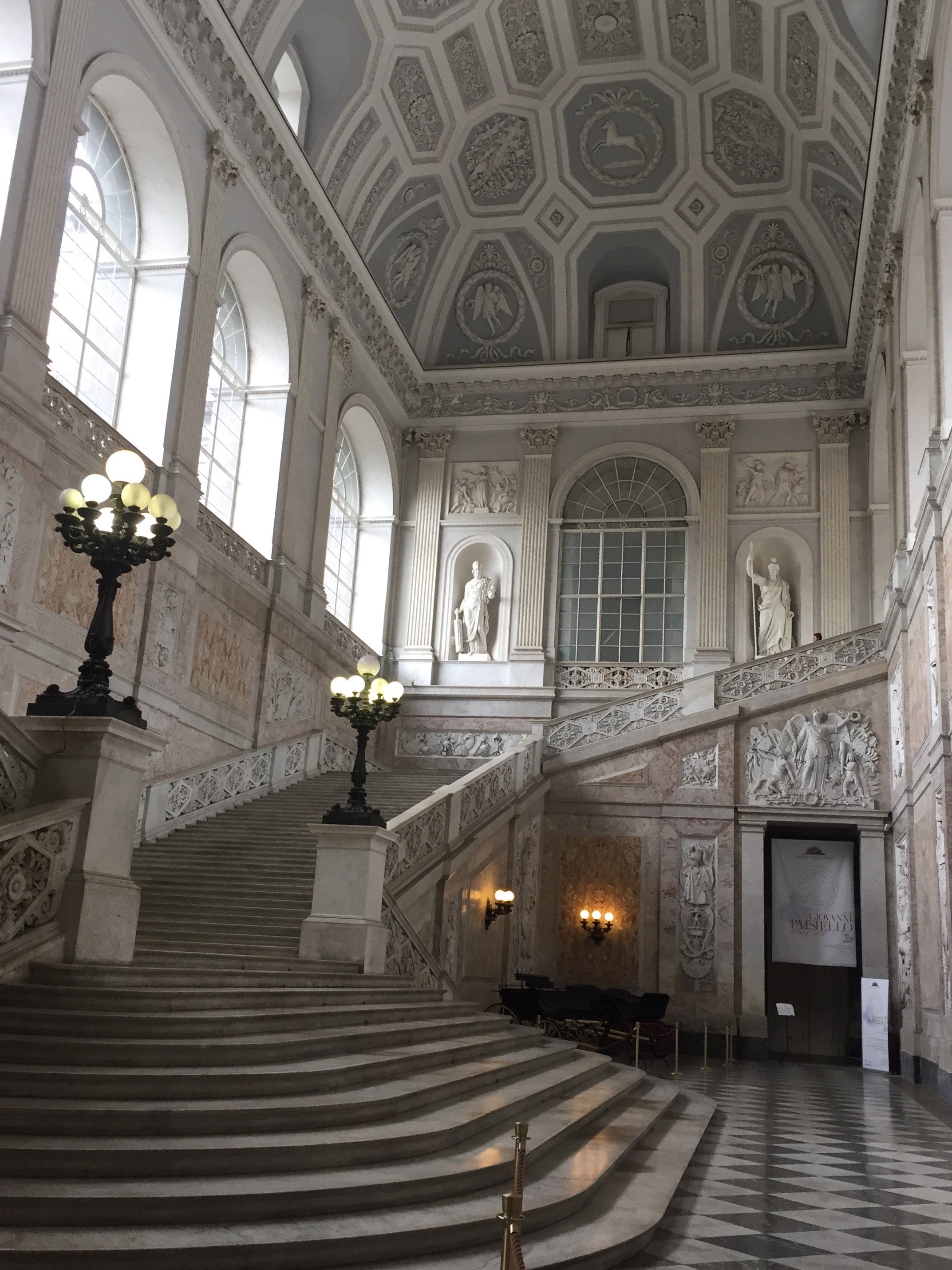 View from the top of the stairs.
View from the top of the stairs.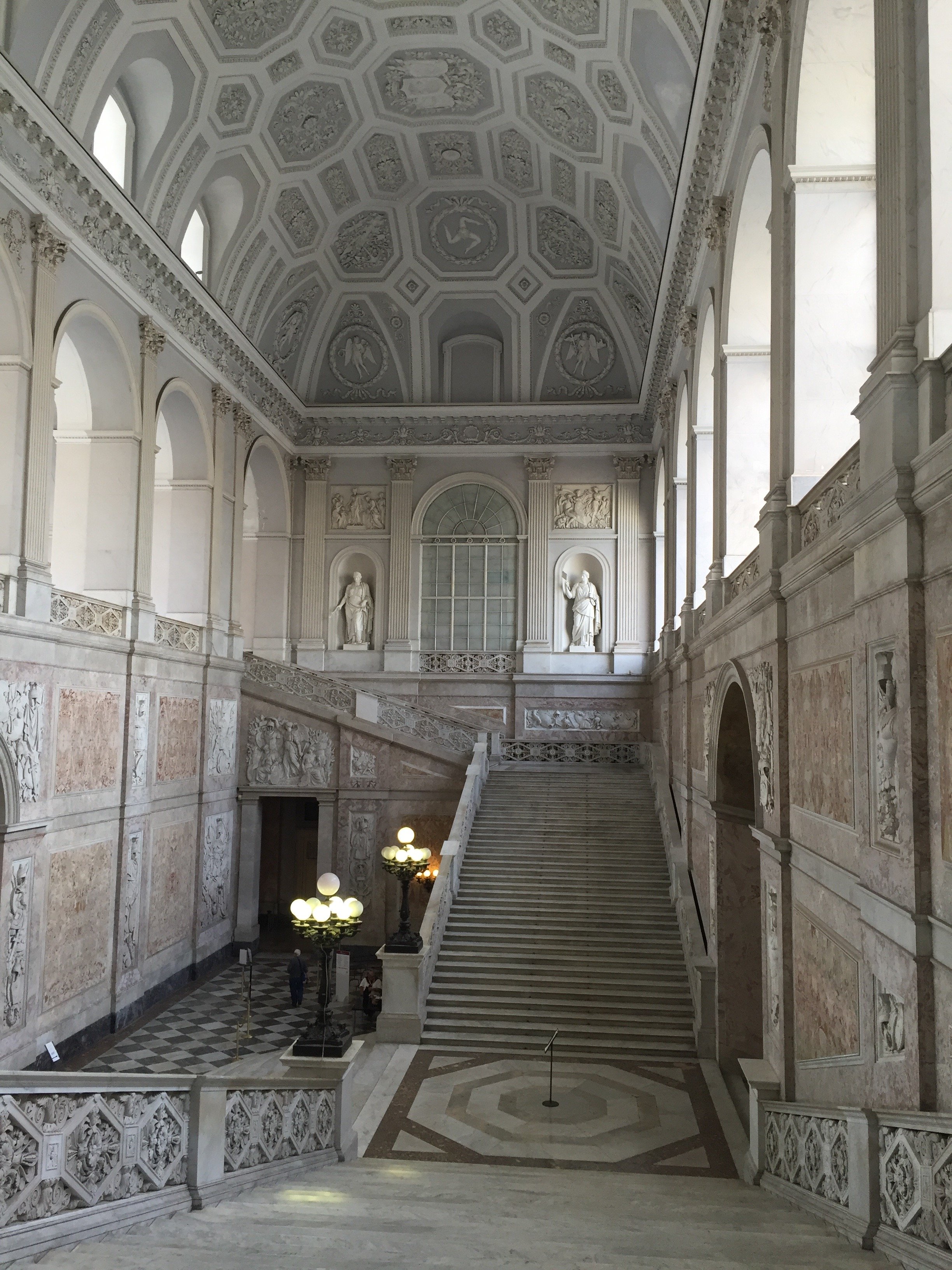 This ceiling is unreal.
This ceiling is unreal.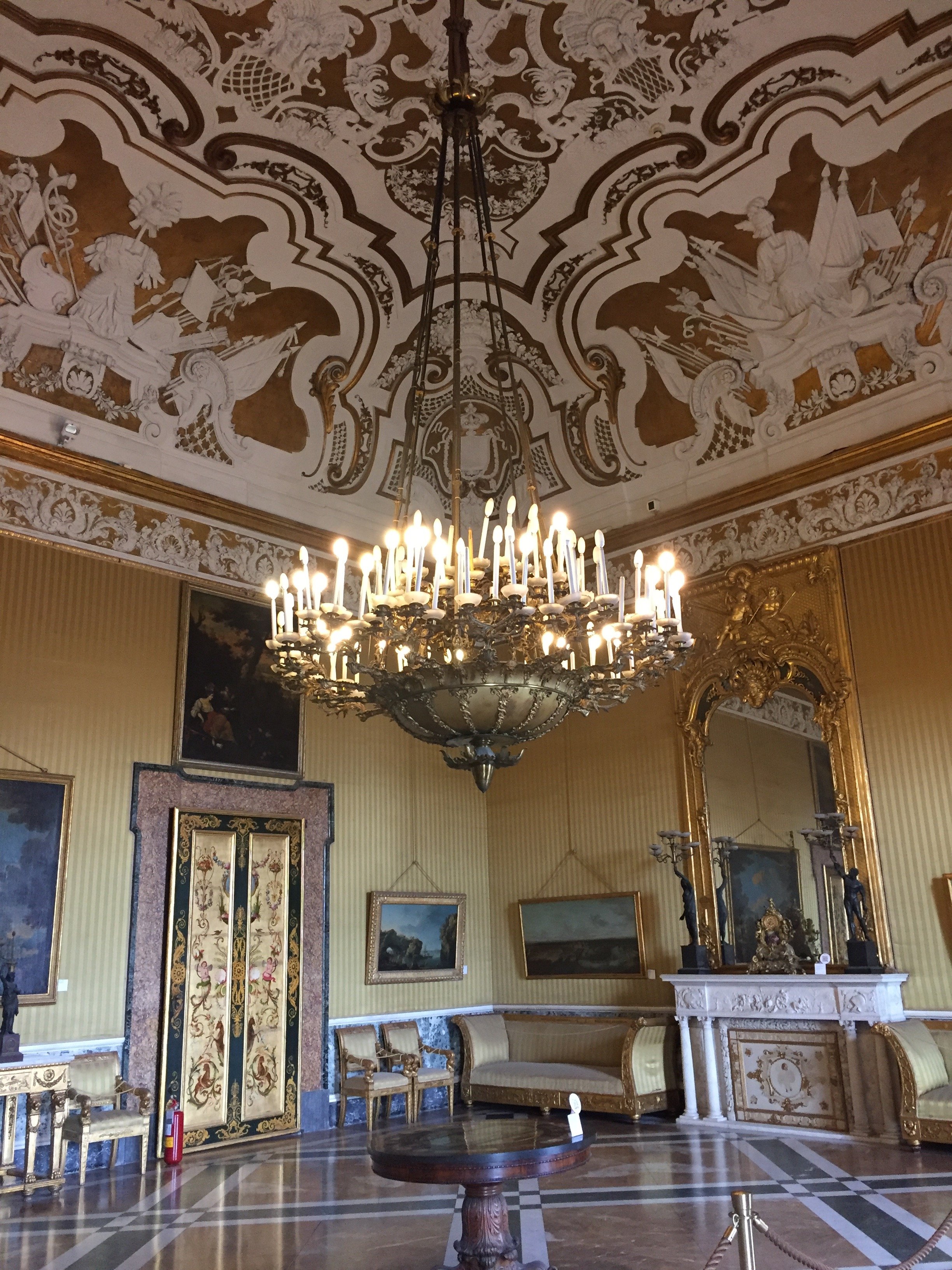 Close up of another ceiling. Gorgeous.
Close up of another ceiling. Gorgeous.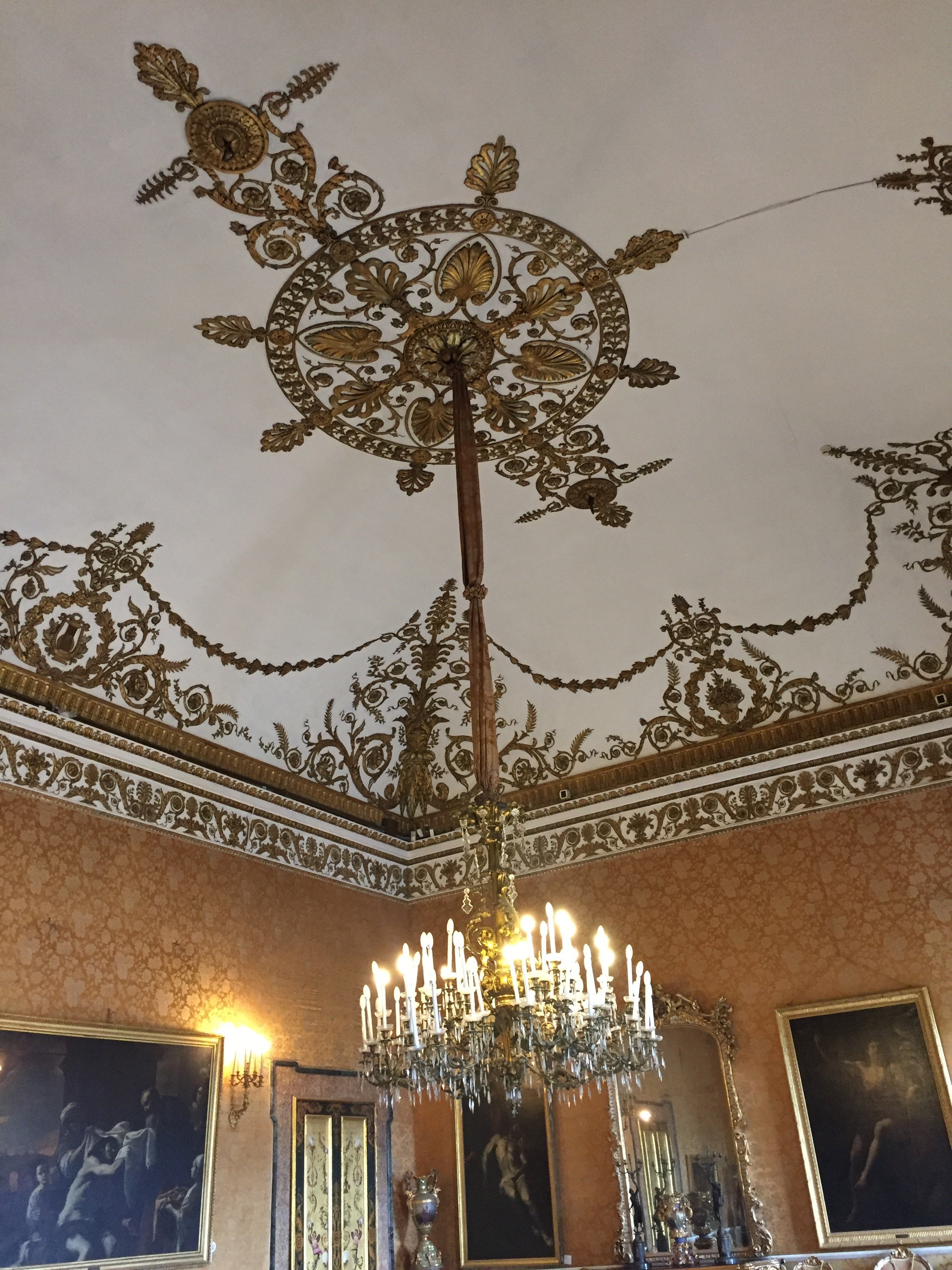 This floor tho.
This floor tho.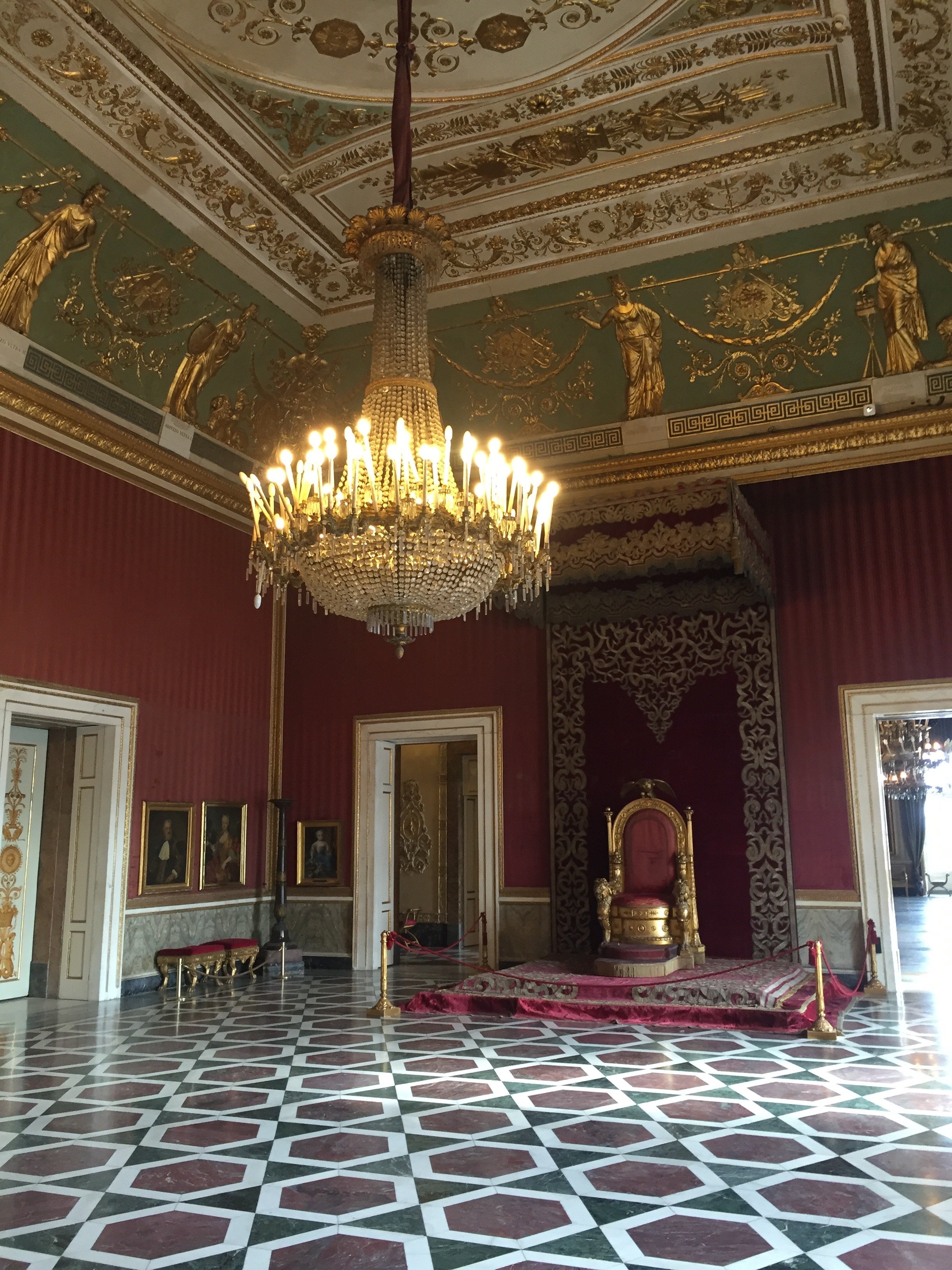
 How nice to have your own theatre.
How nice to have your own theatre.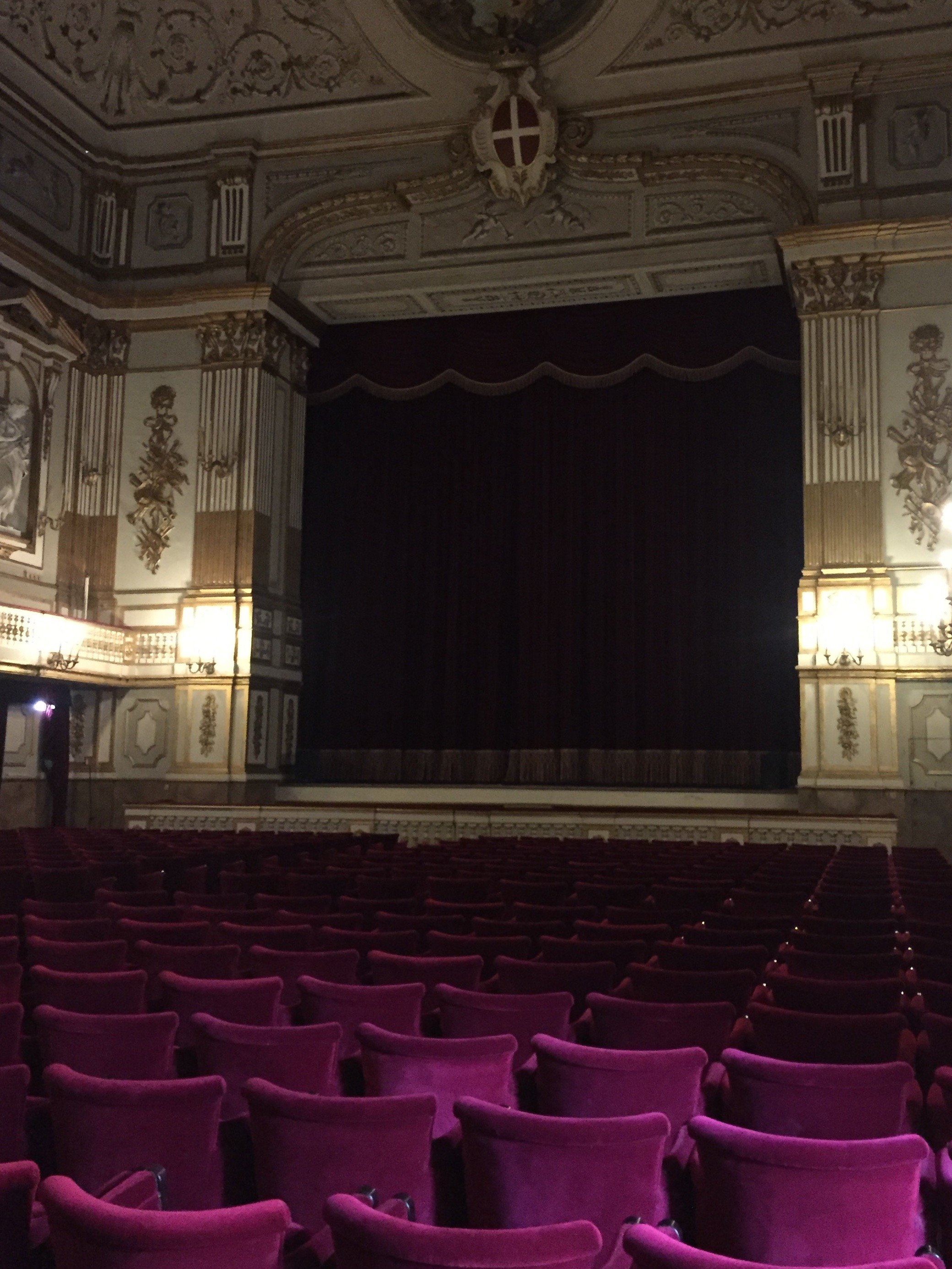 And your own chapel.
And your own chapel.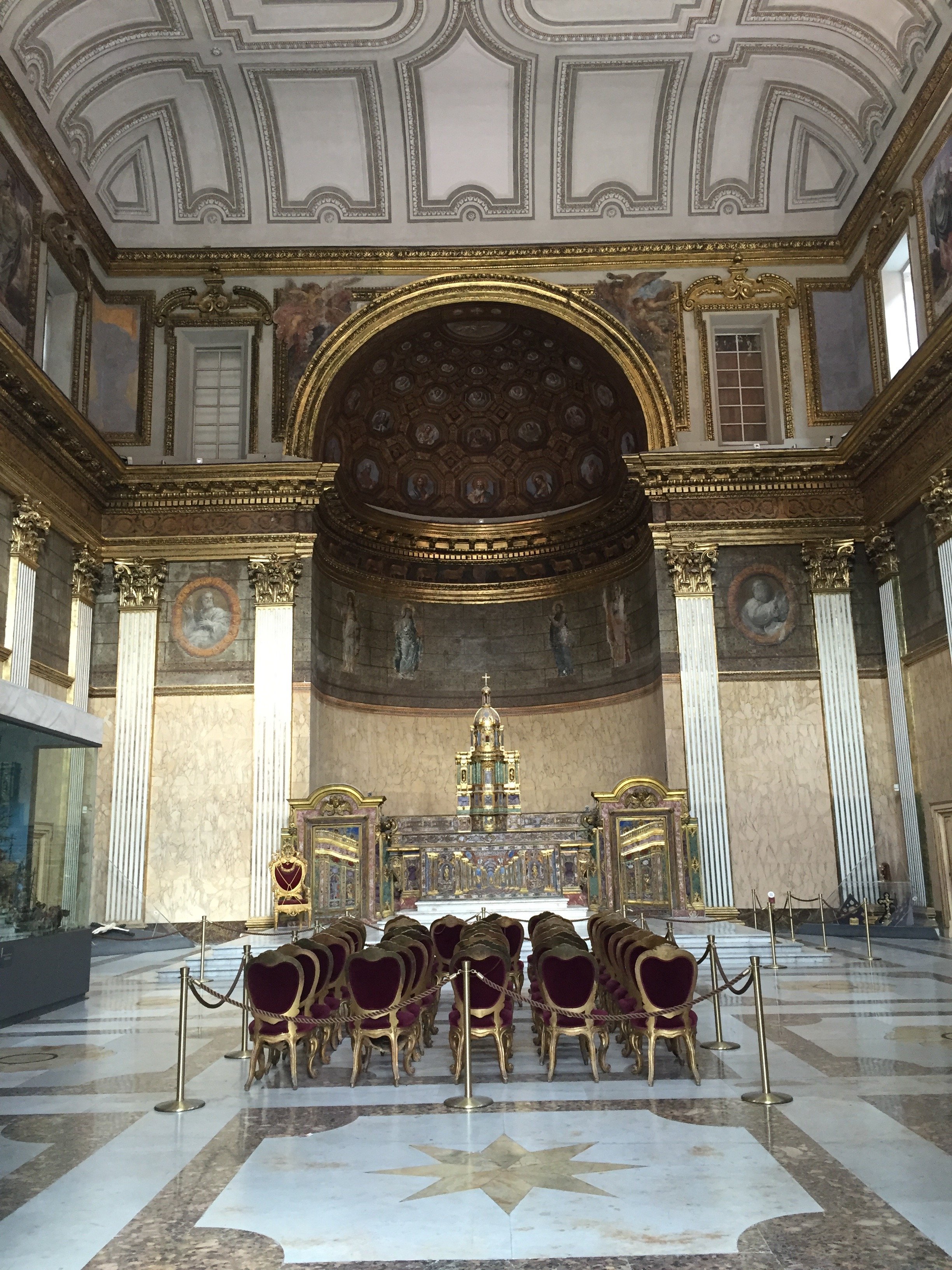 A less ornate space. Love the simplicity of this light fixture.
A less ornate space. Love the simplicity of this light fixture. Love this ceiling too. I chuckle when I hear the color grey is too trendy so now it needs to be over. I disagree. It's a classic.
Love this ceiling too. I chuckle when I hear the color grey is too trendy so now it needs to be over. I disagree. It's a classic. The ballroom.
The ballroom.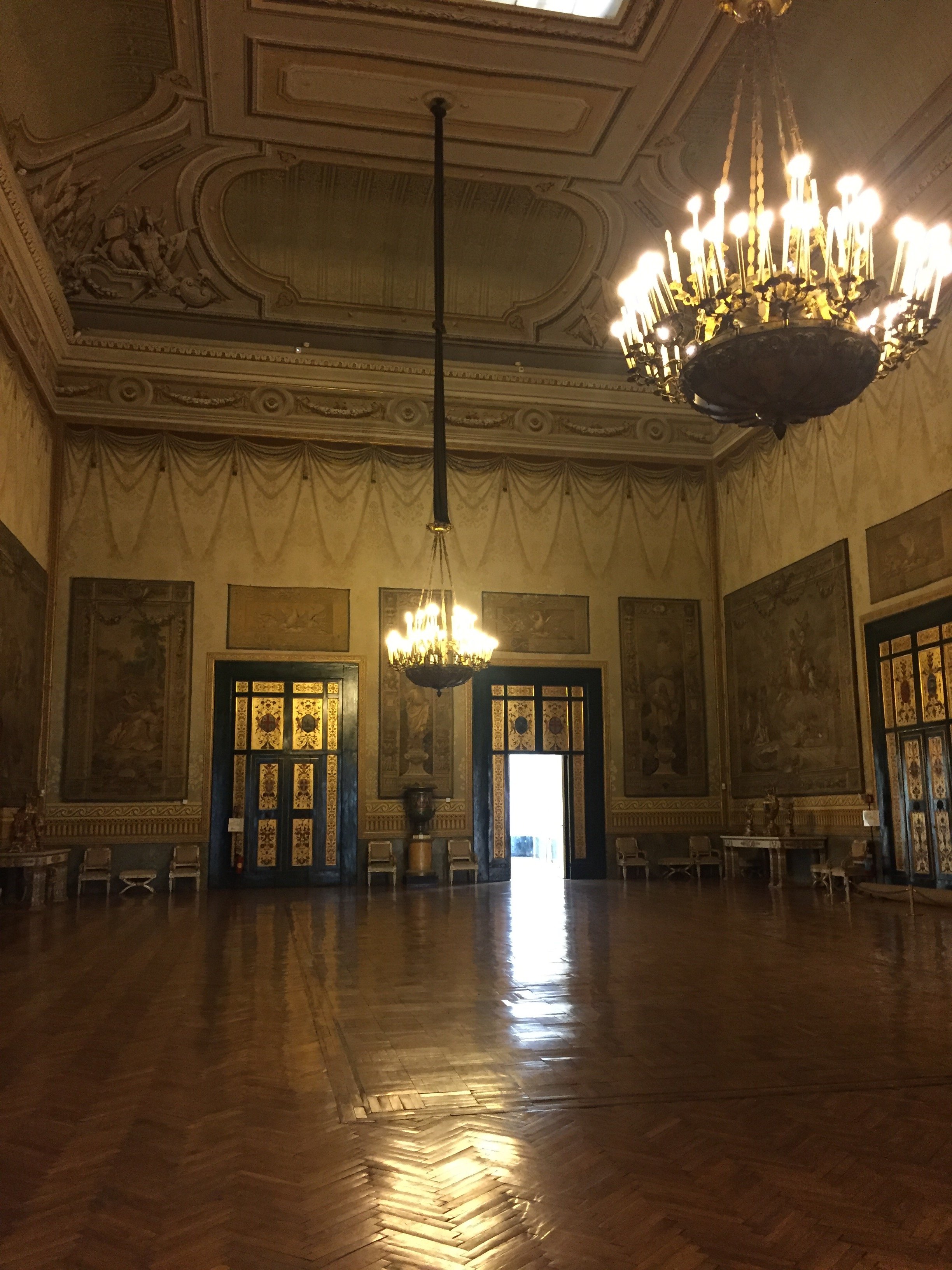 It was starting to clear up as I walked out. There's a view of the sea from several of the rooms but it was hard to get a photo without the scaffolding. The gardens are not public but there is an interior courtyard with a fountain.
It was starting to clear up as I walked out. There's a view of the sea from several of the rooms but it was hard to get a photo without the scaffolding. The gardens are not public but there is an interior courtyard with a fountain. Photos: me and my iPhone
Photos: me and my iPhone
"See Naples and Die."
This is a phrase coined in the mid-1800s during the reign of the Bourbons. At the time Naples was the third most populous city in Europe after London and Paris. It was also one of the wealthiest.I prefer to agree with the original meaning of the phrase and not the "if you go to Naples you will die because it's so dangerous" image the city had for years.I first went to Naples in 2007 on a day trip during my second trip to Italy. I met the lovely Tracie P, then know as Tracie B. I don't believe that was almost eleven years ago! My last trip to Naples was with Erica in 2009. I thought it was four years ago at most.I cannot tell you how many people back then worried for my safety when I told them I was going to Naples. One friend said he hated the place as he was mugged literally five minutes after he walked out of the main train station. Naples was mentioned in the international press mostly for its pizza, the mafia, and a major garbage problem. During both trips I could count the number of American tourists on one hand. One famous guidebook said if Rome was overwhelming, don't go further south. Naples is Rome squared.I loved the energy of Naples during those early trips, even with the garbage situation. There's no place like it. It reminded me a little of pre-Disneyfied New York City.Not sure what the heck took me so long to return but I was shocked at the change. The city is cleaner than Rome. There are more American tourists. Fuelled in part by the popoluarity of the Ferrante book series, the international press is writing about the great things happening in Naples. Naples is "in". Are there still problems, yes. I recommend using the same precautions you would in any major, densely populated city. Leave the fancy watches, rings, etc at home or in your hotel safe.I wasn't as overwhelmed during this trip. It could be because I live in a walking city again whereas during my the first trip i was coming from Los Angeles where your car is a cocoon. I'd visited the archeological museum and Castel Nuovo on those trips. I wanted to see a few places I missed.My first stop was the Museo Capella Sansevero. You buy your ticket (€7) at the small nearby center/office . There was a long line to enter but it moved quickly. You cannot take any photos inside. It's not the easiest to find. It's on a small side street but my Google maps was on point.This is a church I would return to again, maybe in the dead of winter/off season so I could have more time to take it all in. I now understand why the Veiled Christ by Giuseppe Sanmartino is considered one of the most incredible sculptures in the world.I know this is all marble yet I have a hard time believing it. Prince Raimondo di Sangro commissioned the young Sanmartino to create this work for his family's chapel. The Prince was a well-known alchemist and bold experimentalist. There are several other incredible works in the chapel inculding a poignant Pudicizia by Antonio Corradini, whose veiled female figure next to a cracked plaque, honors Raimondo's mother, Cecilia Gaetani d’Aquila d’Aragona. He was only 11 months old when she died.
Prince Raimondo di Sangro commissioned the young Sanmartino to create this work for his family's chapel. The Prince was a well-known alchemist and bold experimentalist. There are several other incredible works in the chapel inculding a poignant Pudicizia by Antonio Corradini, whose veiled female figure next to a cracked plaque, honors Raimondo's mother, Cecilia Gaetani d’Aquila d’Aragona. He was only 11 months old when she died.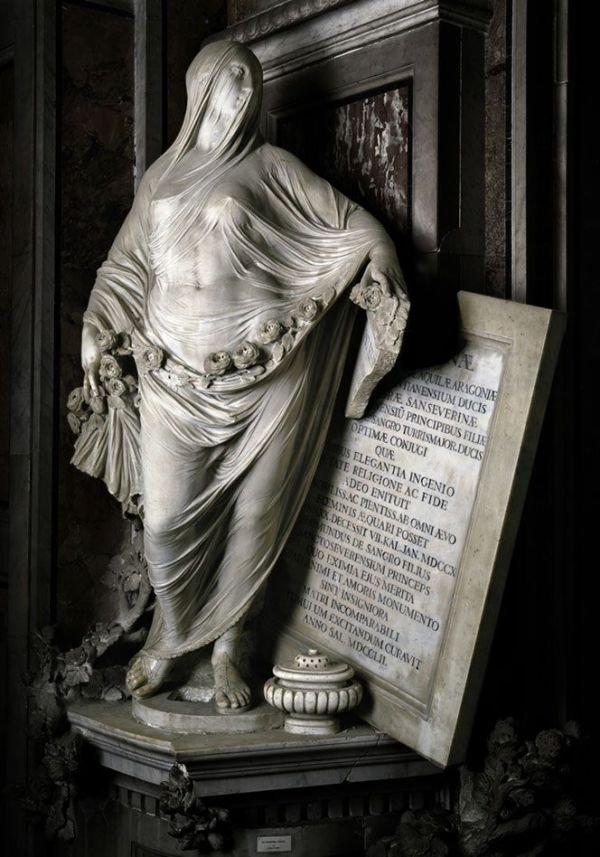 There's a little room downstairs. Folks, once I descended down the narrow iron staircase I was shook. There are two skeletins, a man and a woman. They are encased in what looks like perfectly preserved human arterial systems. Over two centuries ago, Dr. Giuseppe Salerno from Palermo, along with the Prince, created theses anatomical works. There were/are all kinds of rumors as to how these bodies came to be. Word was that the Prince killed members of his staff, injecting them with liquid while they were still alive. Others said the arterial systems are reproductions. They are fascinating and creepy. No Google search for photos. Nope. Cannot.
There's a little room downstairs. Folks, once I descended down the narrow iron staircase I was shook. There are two skeletins, a man and a woman. They are encased in what looks like perfectly preserved human arterial systems. Over two centuries ago, Dr. Giuseppe Salerno from Palermo, along with the Prince, created theses anatomical works. There were/are all kinds of rumors as to how these bodies came to be. Word was that the Prince killed members of his staff, injecting them with liquid while they were still alive. Others said the arterial systems are reproductions. They are fascinating and creepy. No Google search for photos. Nope. Cannot.  I got lost and went into many churches as I made my way to the restaurant Antica Osteria Pisano. Thanks for the suggestion, Gina. The restaurant is in the Historic Center on the cusp of the Forcella neightbhood. If you've watched the third season of GOMORRA you're familiar with this mural of San Gennaro, the patron saint of Naples.
I got lost and went into many churches as I made my way to the restaurant Antica Osteria Pisano. Thanks for the suggestion, Gina. The restaurant is in the Historic Center on the cusp of the Forcella neightbhood. If you've watched the third season of GOMORRA you're familiar with this mural of San Gennaro, the patron saint of Naples.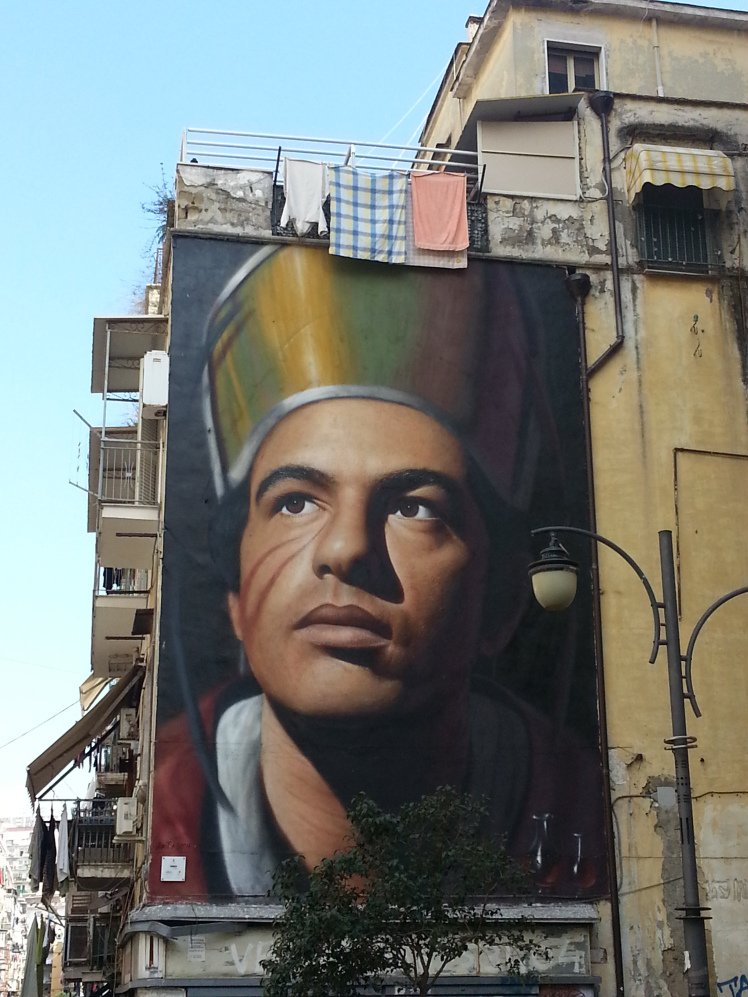 I asked about the pasta of the day. It was Rigatoni alla Bolognese. I was skeptical about ordering this dish outside of Bologna but Gennaro (one of the owners) told me it was delicious. He was correct.I walked off my pasta getting lost on the way to Palazzo Reale. I had the palace on my list but never made it during my last two trips.I listened to the audioguide. I highly recommend it as the history of this palace is fascinating. The palace suffered some major damage during WWII but you can still get a sense of the wealth and presitage of the era.Located in Piazza del Plebiscito, the outside is understated. I was not prepared for this.
I asked about the pasta of the day. It was Rigatoni alla Bolognese. I was skeptical about ordering this dish outside of Bologna but Gennaro (one of the owners) told me it was delicious. He was correct.I walked off my pasta getting lost on the way to Palazzo Reale. I had the palace on my list but never made it during my last two trips.I listened to the audioguide. I highly recommend it as the history of this palace is fascinating. The palace suffered some major damage during WWII but you can still get a sense of the wealth and presitage of the era.Located in Piazza del Plebiscito, the outside is understated. I was not prepared for this. Or this.
Or this. I was overwhelmed by the beauty and will have to write a seperate post about the interiors and history of this palace.The seafront is very close to this piazza, just down the hill. I decided to walk along the sea on my way to the Chiaia neighborhood. A large section of the Lungamare is a car-free zone. This was started in 2012 and what a great idea. People, mostly locals, were out and about enjoying the sunny weather. There are plenty of caffes and restaurants
I was overwhelmed by the beauty and will have to write a seperate post about the interiors and history of this palace.The seafront is very close to this piazza, just down the hill. I decided to walk along the sea on my way to the Chiaia neighborhood. A large section of the Lungamare is a car-free zone. This was started in 2012 and what a great idea. People, mostly locals, were out and about enjoying the sunny weather. There are plenty of caffes and restaurants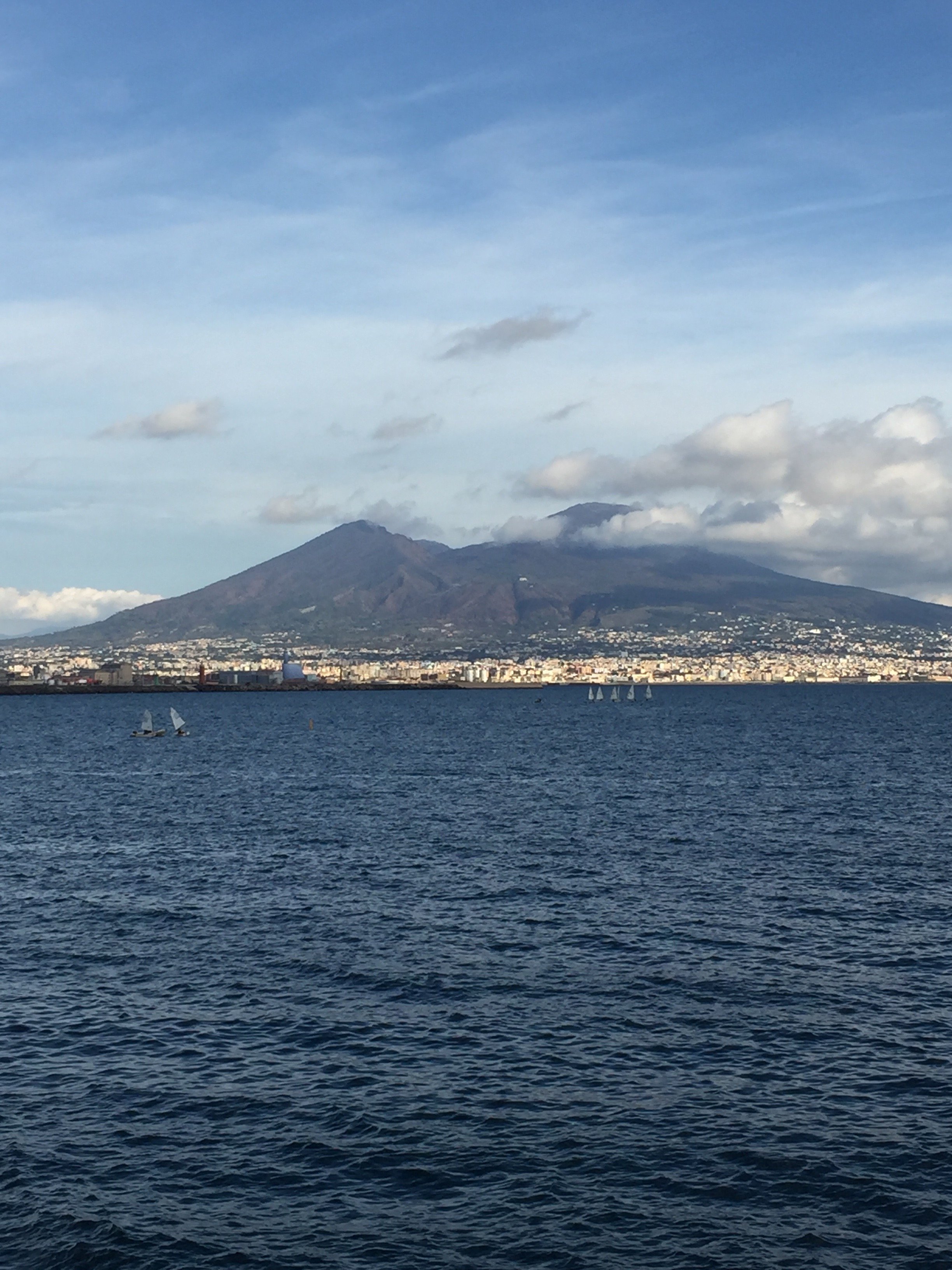 I didn't get to spend much time in the Chiaia area because I had to catch my return train. Chiaia is an upscale neighborhood where you find your luxury local shops and some of the international brands like Prada. I popped into a small enoteca, Belledonne, for a glass of wine. It was excellent and €6.I made my way to the closet Metro stop. I found the signage a little confusing but asked for directions.I took the fast Italo train. It's only an hour and usually there are great deals during the week for same day travel. I really need to spend more time in Naples.Photos: Me and my iPhone unless noted
I didn't get to spend much time in the Chiaia area because I had to catch my return train. Chiaia is an upscale neighborhood where you find your luxury local shops and some of the international brands like Prada. I popped into a small enoteca, Belledonne, for a glass of wine. It was excellent and €6.I made my way to the closet Metro stop. I found the signage a little confusing but asked for directions.I took the fast Italo train. It's only an hour and usually there are great deals during the week for same day travel. I really need to spend more time in Naples.Photos: Me and my iPhone unless noted
Eat, Pray, Move - Tuscany
I stopped practicing yoga over fifteen years ago after I seriously injured my right wrist. I was taking "Power Yoga" classes and I don't think I paid enough attention to what was going on with my body.I couldn't focus long enough in class. My mind was always racing, thinking about all the things I had to do or didn't do. The injury was a convenient excuse to say, "arriverderci" to yoga.I've known Erin for over eleven years. We met via our former blogs before meeting in person and we moved to Italy at the same time. Erin was on a sabbatical in Florence for a year or so and then moved back to the States. She returned frequently and we would always try to see each other. I remember when she started Eat, Pray, Move, Yoga seven years ago. She began with one retreat in Tuscany and over the years has added more locations. In 2014 she left her corporate job and now she holds on average sixteen retreats in nine countries, Italy (multiple locations) France, Spain, Croatia, Iceland, Morocco, Indonesia, India, and Japan. The latter she added this year.It's very inspiring to see how Erin has built this wonderful life and business from scratch. She has tapped into something very special.Last month I had the opportunity to see, in person, what Erin's accomplished. I was worried about the yoga. I had asked her in the past if it would bad form to go to a yoga retreat and pass on doing the yoga (ha). Erin assured me that all levels (including those with no experience) were welcome and that participation in all activities was optional.It was an incredible experience and I'm already planning my next retreat. This retreat was yoga and art. It was held at a country house right on the border of Tuscany and Umbria. I took the train into Chiusi, where I met the other participants. Julian and Erin picked us up.The house, Siliano Alto, is part of the “Le Coste” Estate (a 1500 acre protected nature and hunting reserve), and dates back to around 1760. Other sections were added in the 19th and 20th centuries. During the Second World War the house was used as a billet for German soldiers until it suffered a direct hit on the front side from an American bombing raid. After the War, the house was home to the farmers who worked on the estate. Five separate families lived upstairs and cows, horses and pigs were kept in the cantinas below. Julian and his family moved to the property in 2006 and began a two-year restoration project before opening up for art courses.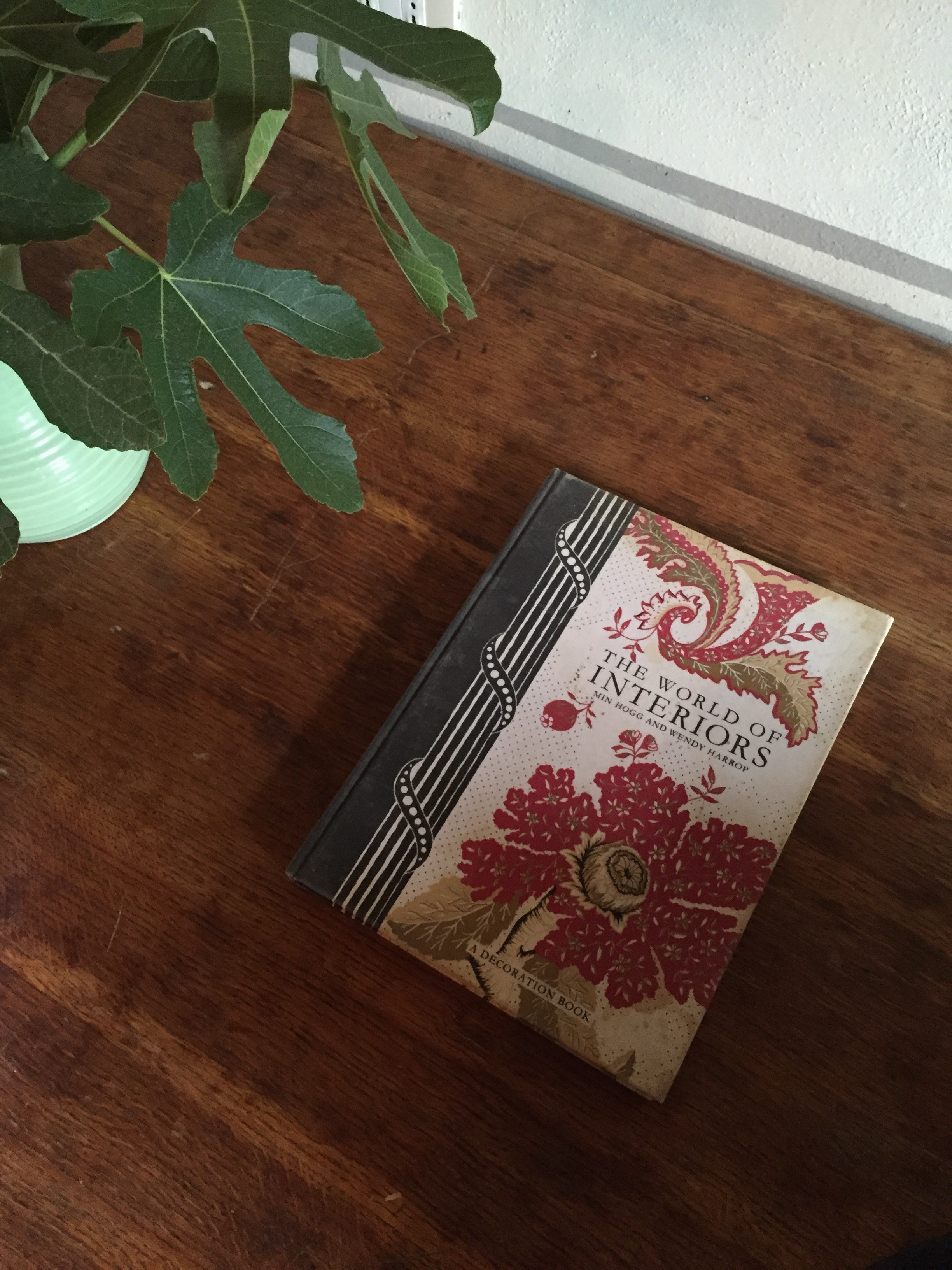
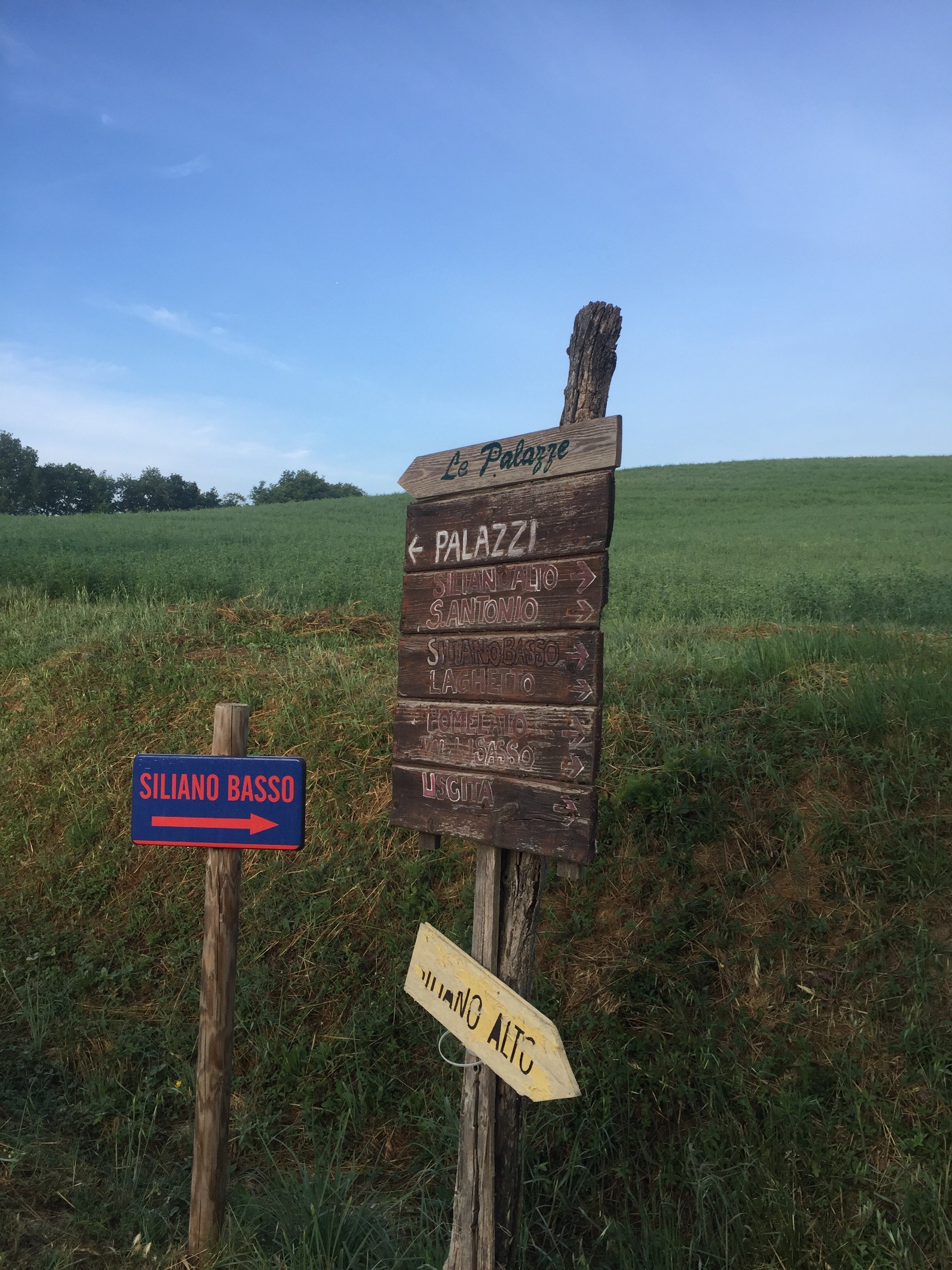
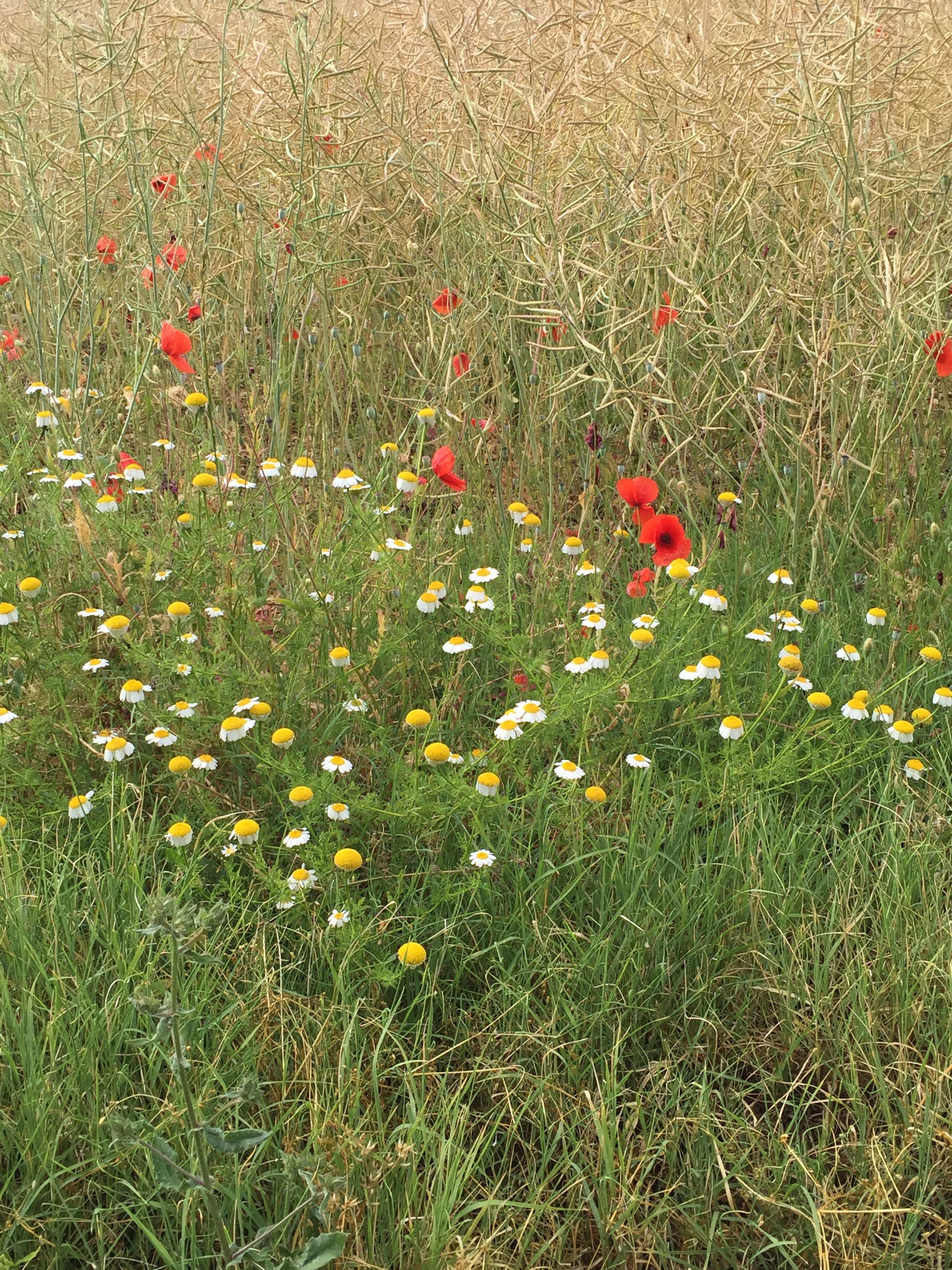
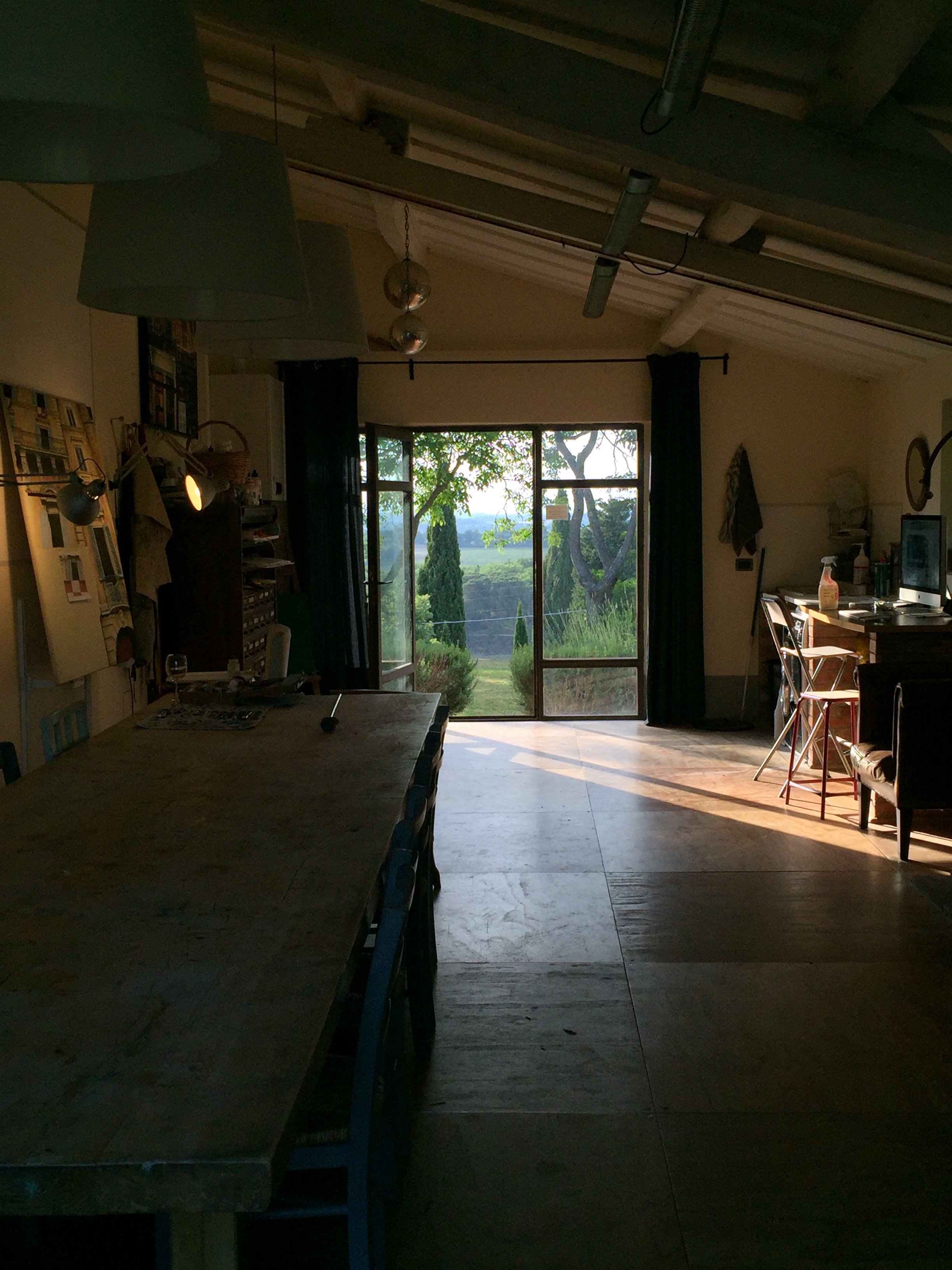 The location was wonderful with beautiful views and incredible sunsets. I was told that some wild boars were hanging out by our doors during the first night. I didn't hear them, which is a good thing.
The location was wonderful with beautiful views and incredible sunsets. I was told that some wild boars were hanging out by our doors during the first night. I didn't hear them, which is a good thing.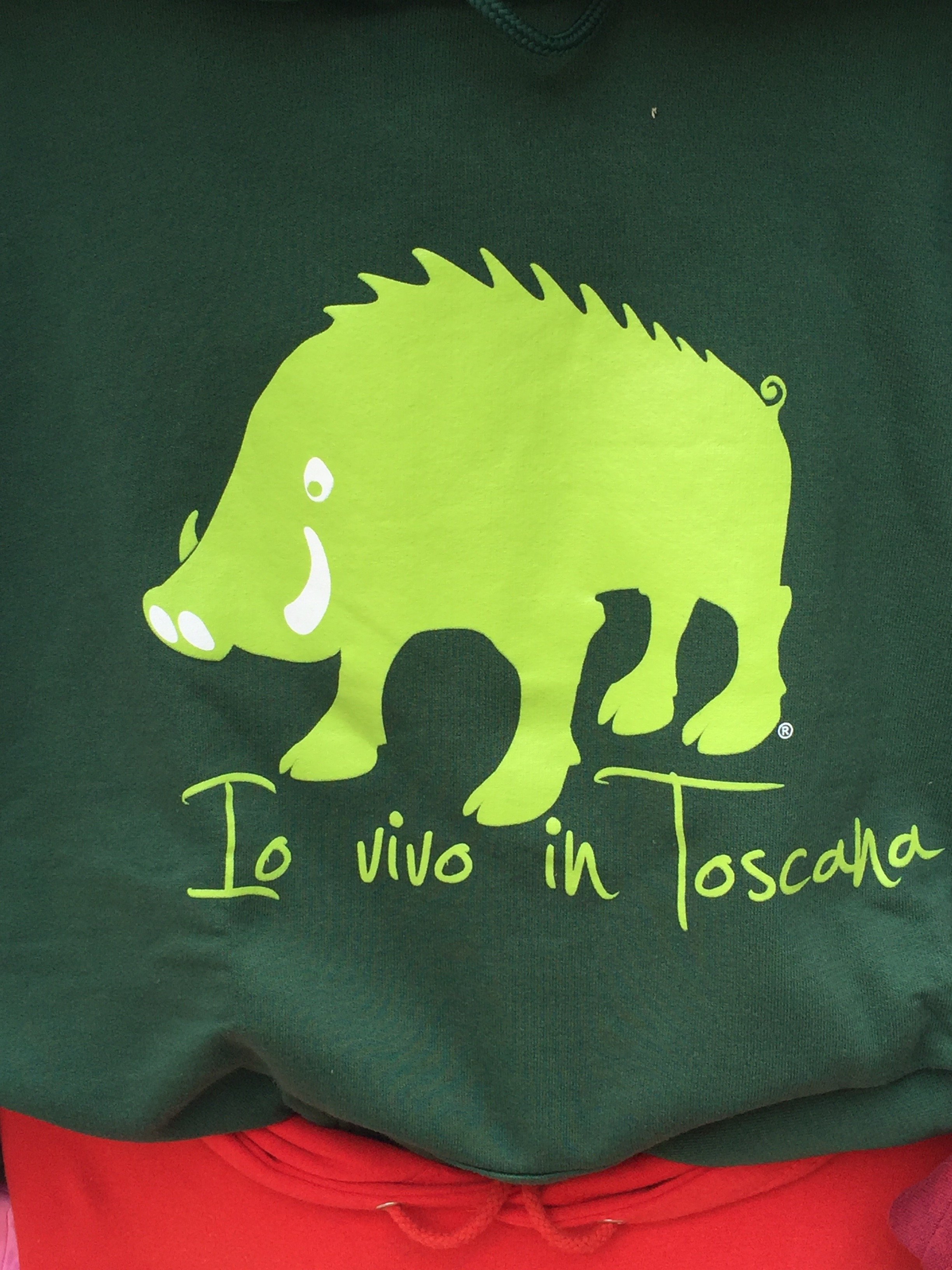
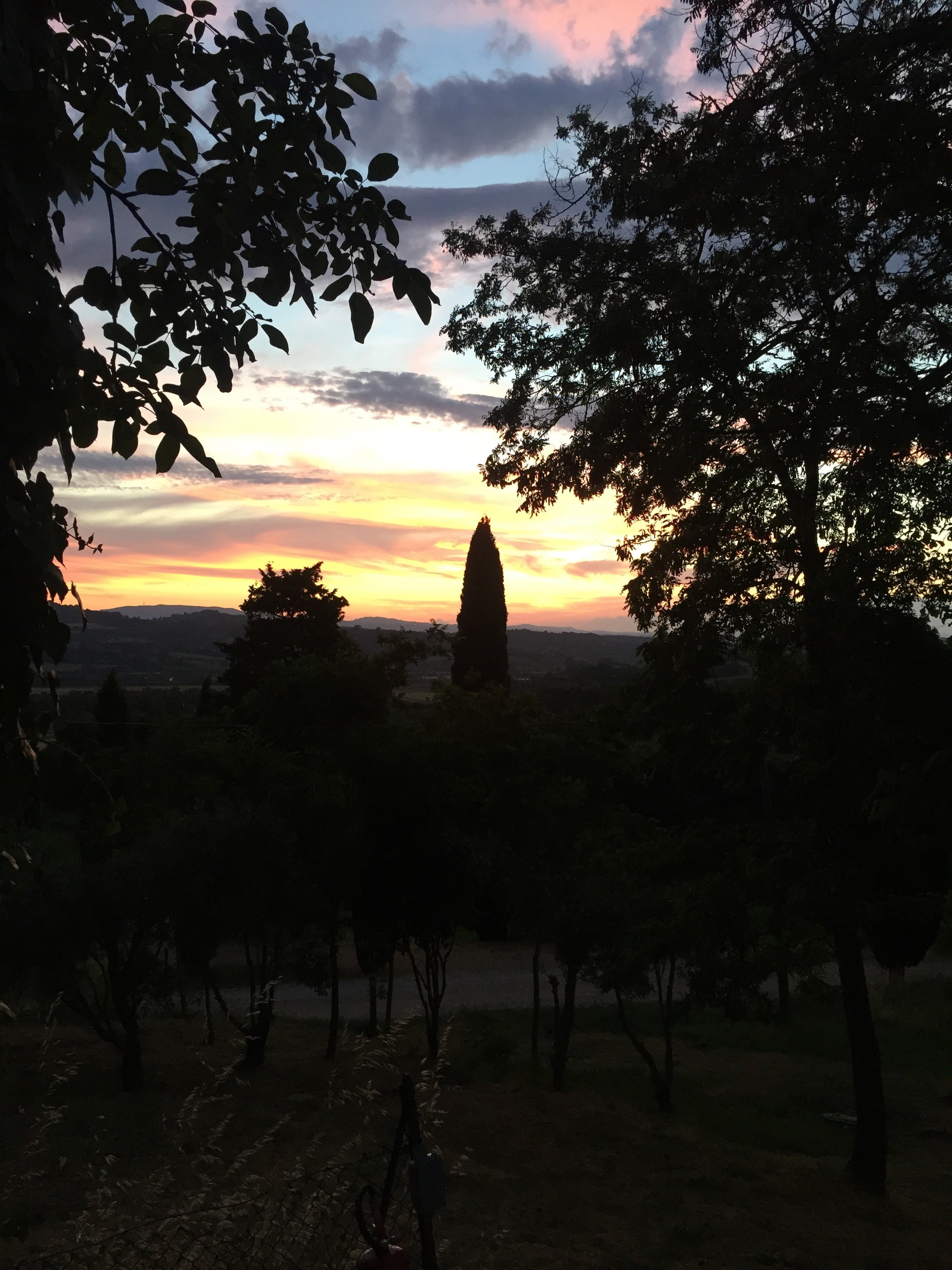 I appreciated this welcome aperitivi.
I appreciated this welcome aperitivi.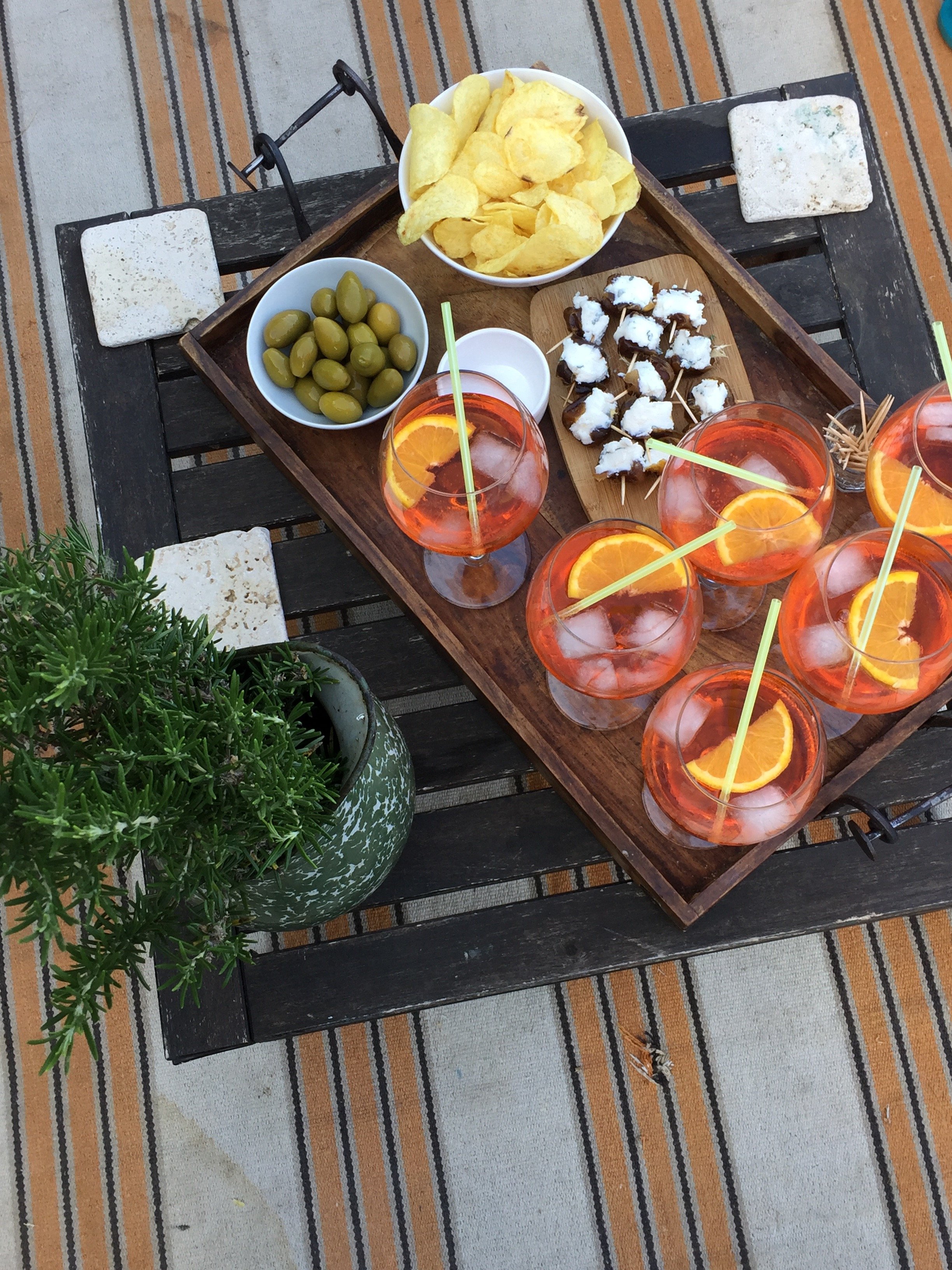 During the welcome Erin went over the week's schedule was (there was a print out as well). I couldn't stay the entire week because of a work commitment back in Rome. There's plenty of free time built into the schedule. Breakfast and dinners are included, along with some lunches.The food is vegetarian and delicious. I didn't miss eating meat or fish at all. If you must get your meat-eating on, it's possible to so during the lunches that are not provided.
During the welcome Erin went over the week's schedule was (there was a print out as well). I couldn't stay the entire week because of a work commitment back in Rome. There's plenty of free time built into the schedule. Breakfast and dinners are included, along with some lunches.The food is vegetarian and delicious. I didn't miss eating meat or fish at all. If you must get your meat-eating on, it's possible to so during the lunches that are not provided.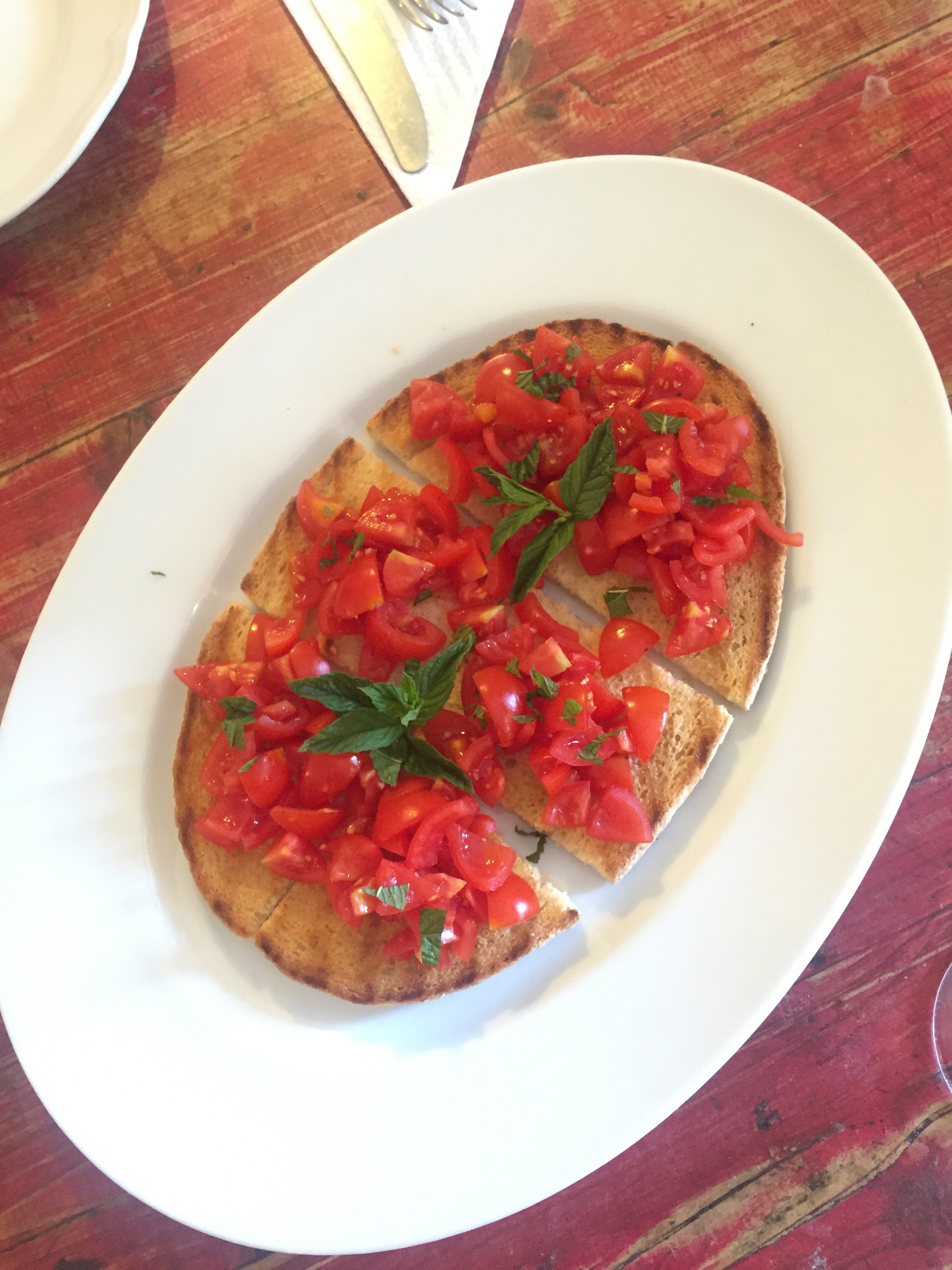
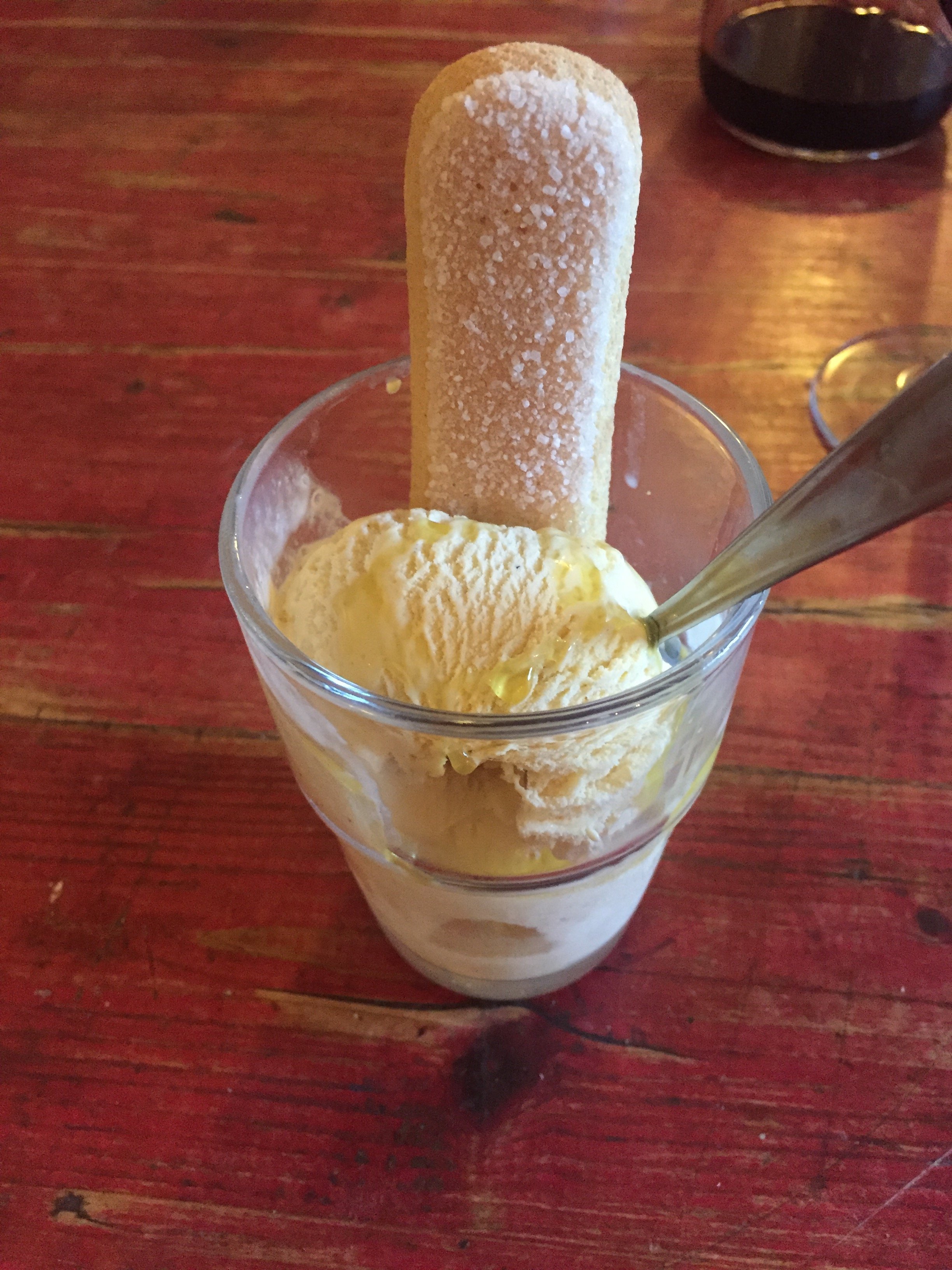 Erin is a certified yoga instructor and the morning classes usually start at 8:00 a.m. and last an hour and fifteen minutes. I'll be honest, I was struggling to get through our first class. I kept thinking about how hungry I was, Idris Elba, and work stuff. I couldn't get it together. Erin was great, checking our poses. If there was one movement that was too difficult for some of us in the class, she would suggest an easier one. The next day my abs were on fire.
Erin is a certified yoga instructor and the morning classes usually start at 8:00 a.m. and last an hour and fifteen minutes. I'll be honest, I was struggling to get through our first class. I kept thinking about how hungry I was, Idris Elba, and work stuff. I couldn't get it together. Erin was great, checking our poses. If there was one movement that was too difficult for some of us in the class, she would suggest an easier one. The next day my abs were on fire.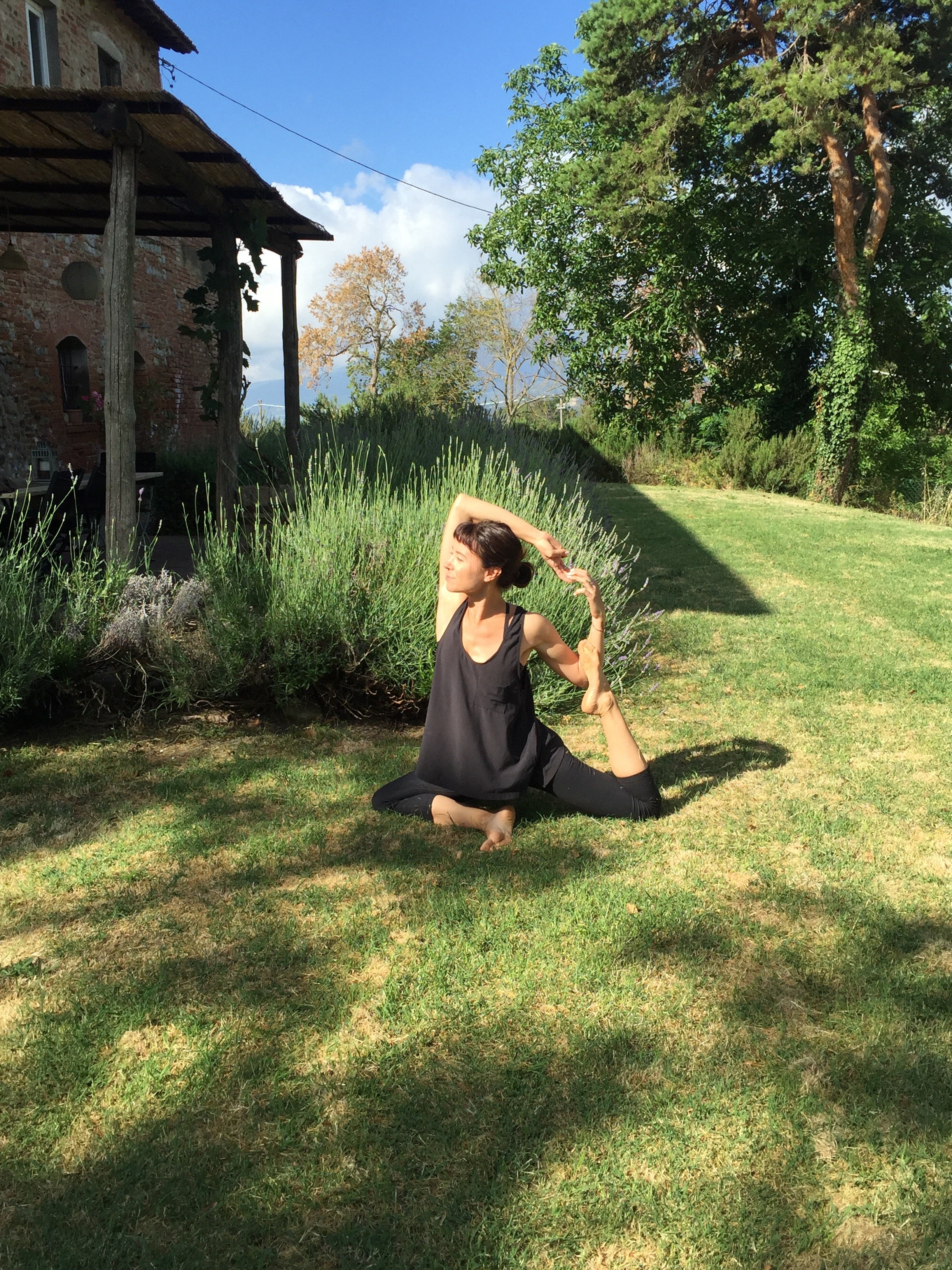 The second day I had some fruit before class and made more of an effort to focus. Anytime I felt my mind starting to race again, I pumped the brakes. By the time I left the retreat, I was able to make through an entire class without any distractions.The non-yoga part of the retreat was fantastic as well. We visited the town of Chiusi where Julian, who is an artist and art teacher, gave us an excellent tour. We had pizza in town with the perfect crust. We also drove to the small borgo of Panicale and had a fun wine and olive oil tasting.
The second day I had some fruit before class and made more of an effort to focus. Anytime I felt my mind starting to race again, I pumped the brakes. By the time I left the retreat, I was able to make through an entire class without any distractions.The non-yoga part of the retreat was fantastic as well. We visited the town of Chiusi where Julian, who is an artist and art teacher, gave us an excellent tour. We had pizza in town with the perfect crust. We also drove to the small borgo of Panicale and had a fun wine and olive oil tasting.
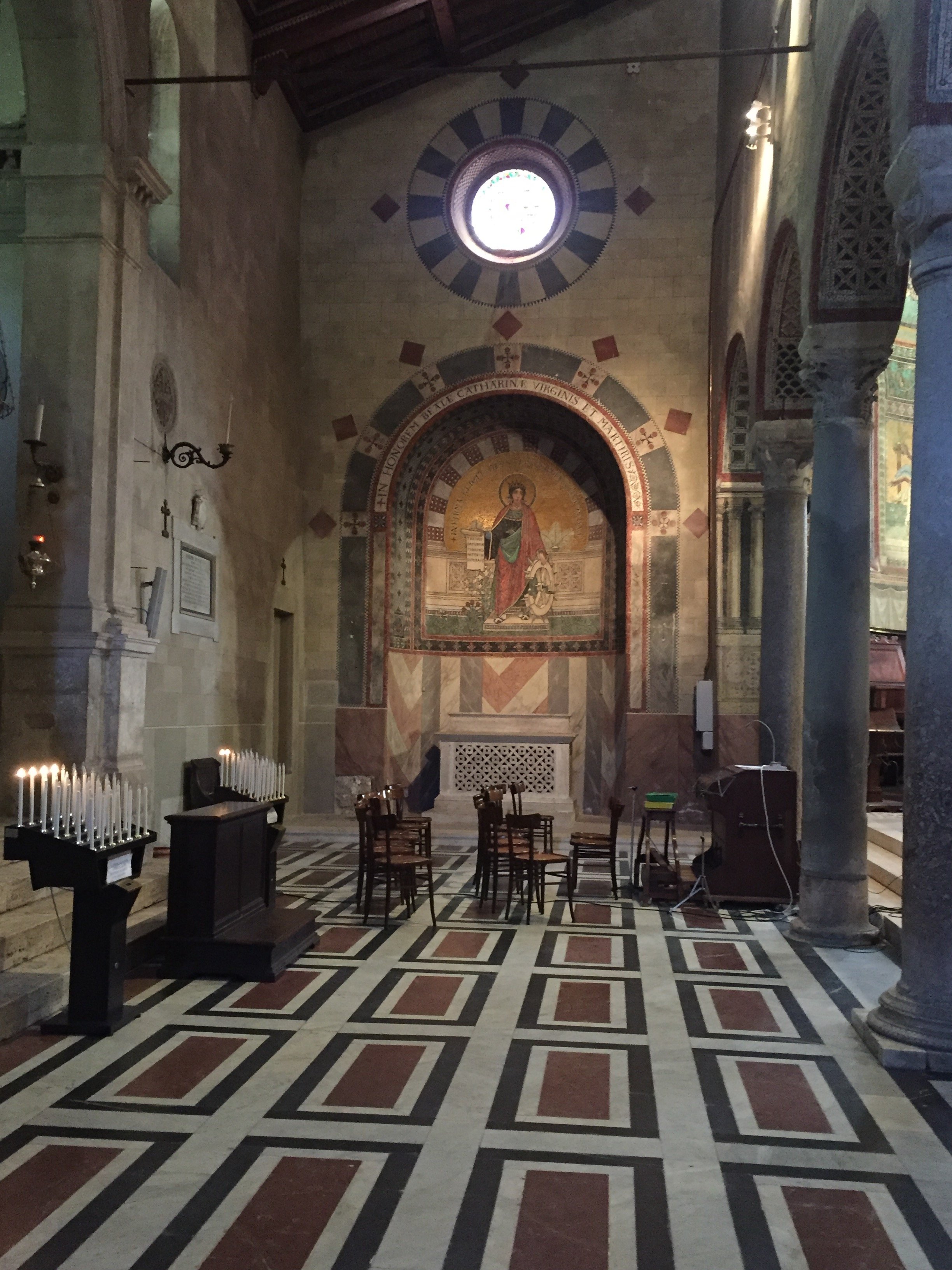
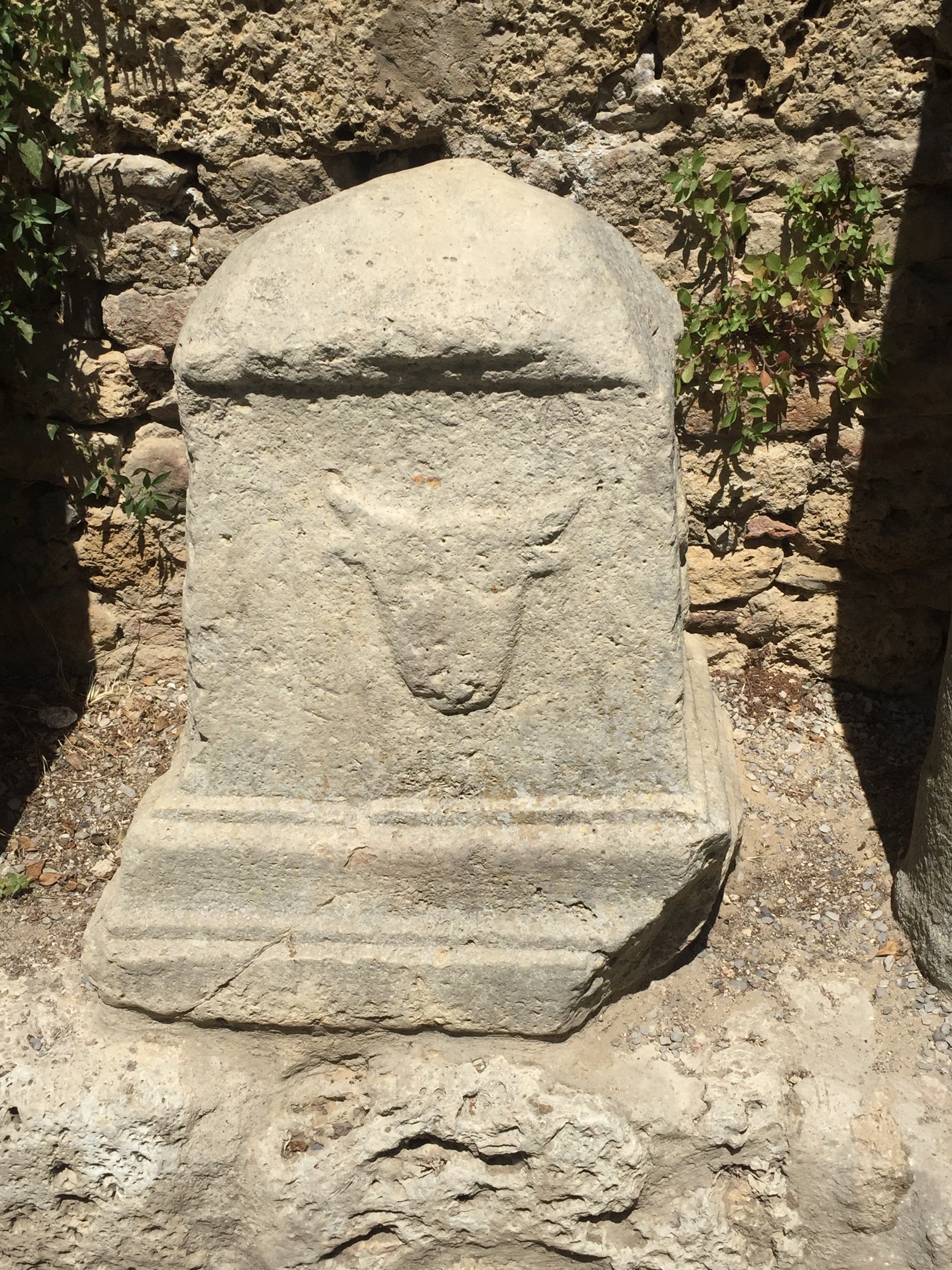
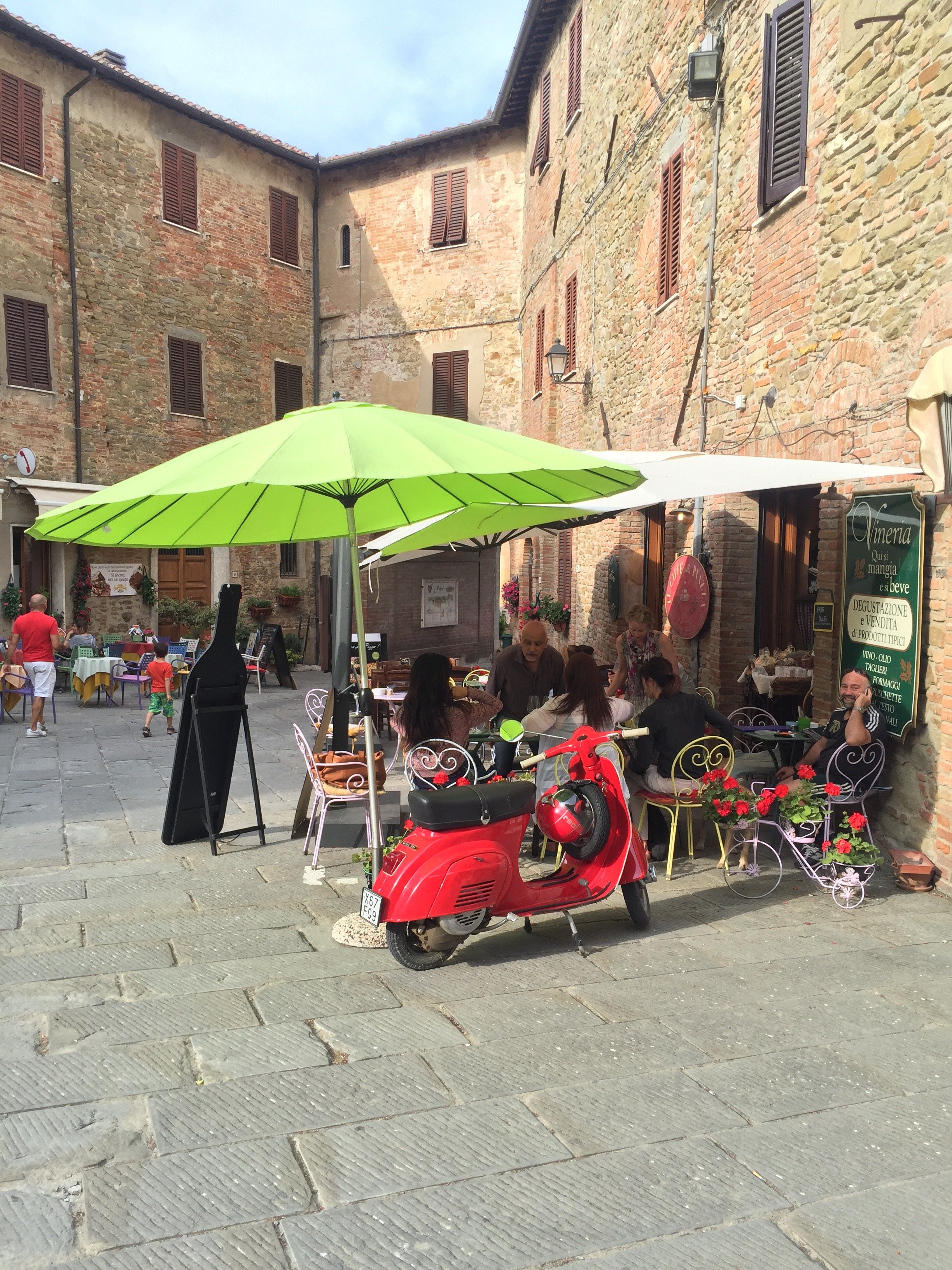 The next day was our day trip to Siena. I visited Siena during my second vacation to Italy. I had my guide-book and everything but I learned a lot more about the Duomo and the town with Julian. He went into detail regarding how the Plague impacted the city. Seven out of ten Sienese died.The Duomo is breathtaking. What Julian said about the cathedral architects of that era was profound. The architects were designing buildings that would be finished long after they died. They knew they would never see them completed. Very different from these McMansiony times.
The next day was our day trip to Siena. I visited Siena during my second vacation to Italy. I had my guide-book and everything but I learned a lot more about the Duomo and the town with Julian. He went into detail regarding how the Plague impacted the city. Seven out of ten Sienese died.The Duomo is breathtaking. What Julian said about the cathedral architects of that era was profound. The architects were designing buildings that would be finished long after they died. They knew they would never see them completed. Very different from these McMansiony times.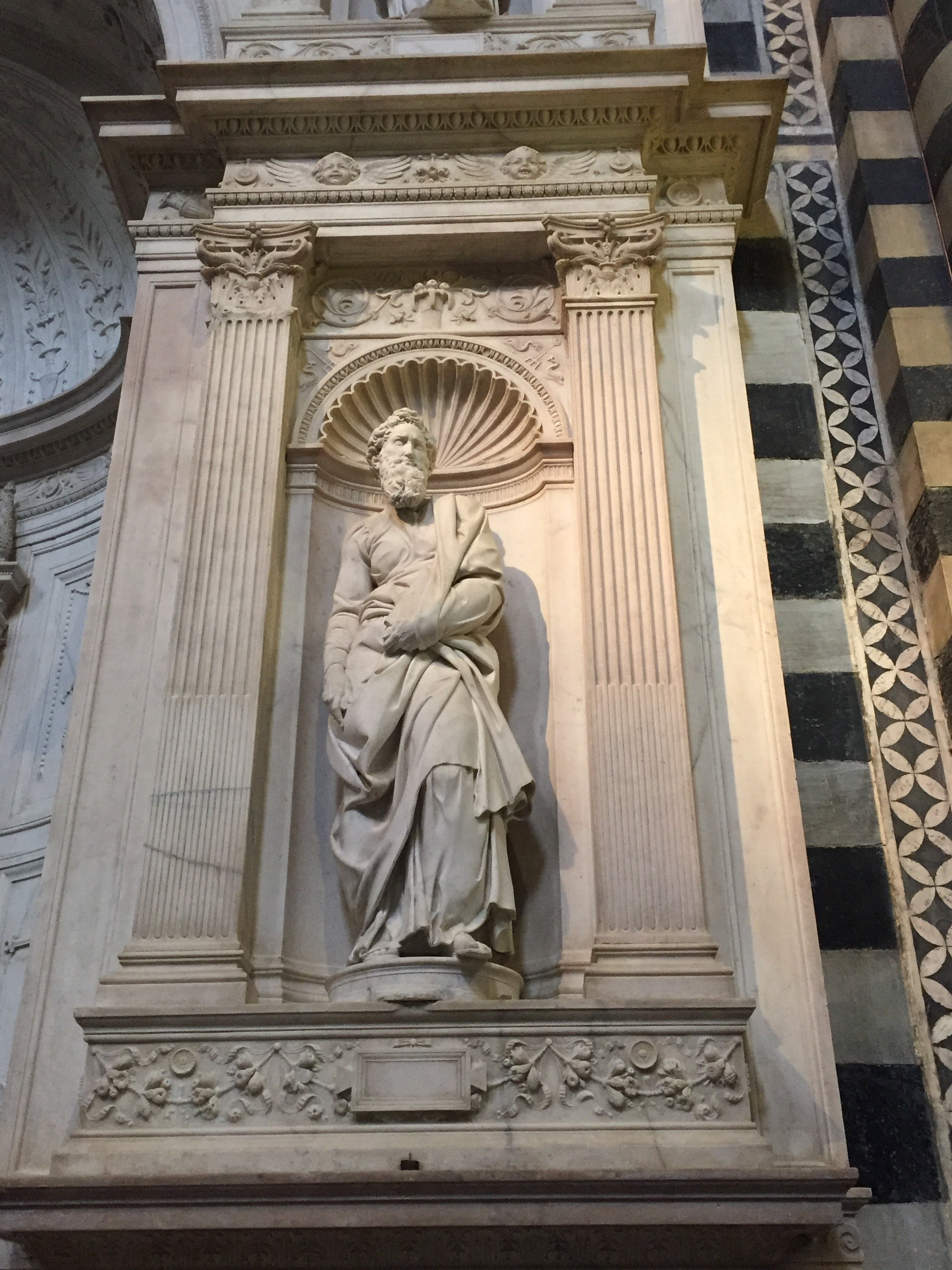
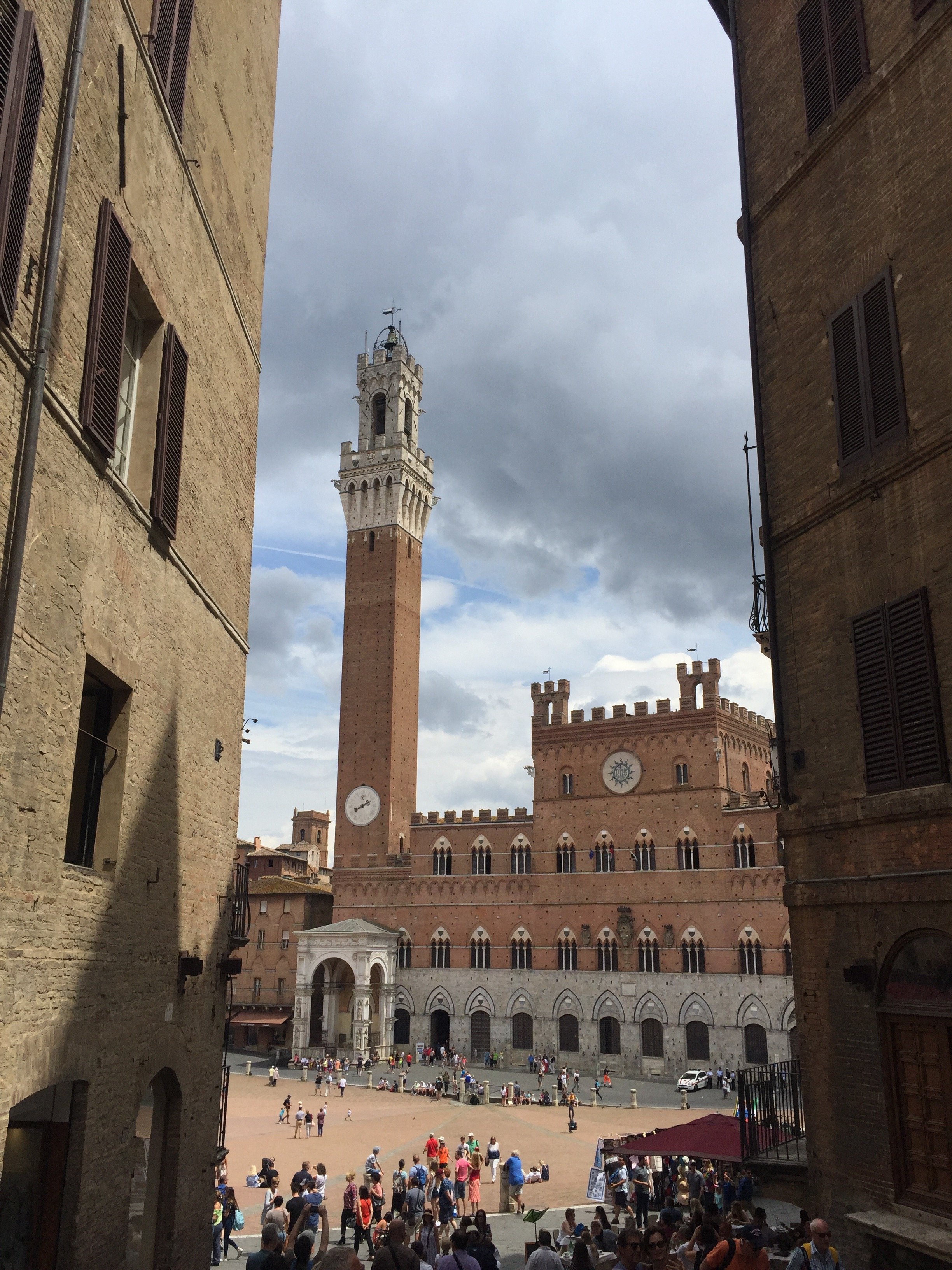 On my last day we had an art class. We did several drawing exercises. Later, during our free time, several of us took advantage of the watercolor paints in the studio.
On my last day we had an art class. We did several drawing exercises. Later, during our free time, several of us took advantage of the watercolor paints in the studio.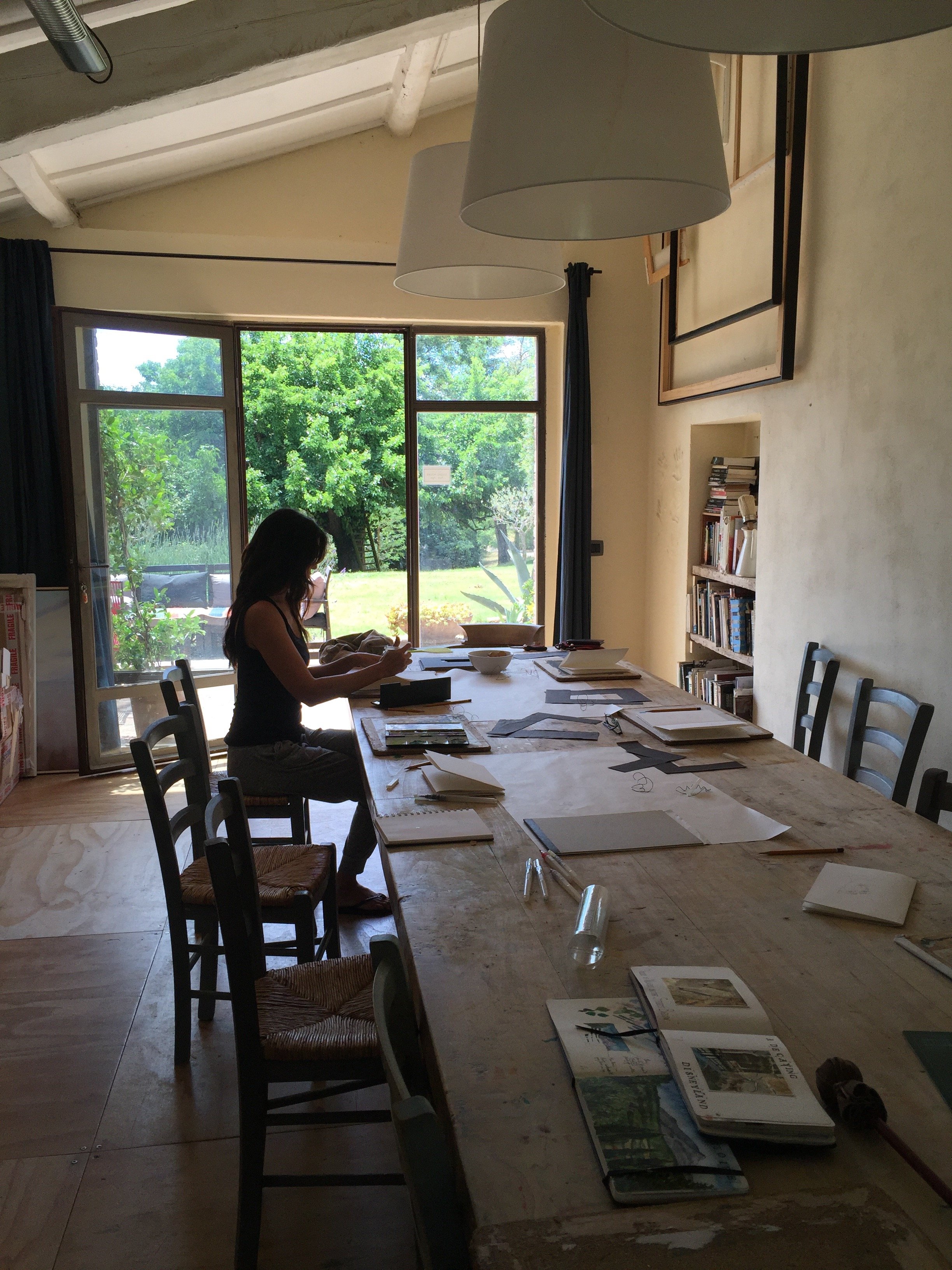 That day we also had a pasta making class. I haven't made pasta from scratch in years. I need to do it more often. The pasta was ridiculously good. All of us had seconds.
That day we also had a pasta making class. I haven't made pasta from scratch in years. I need to do it more often. The pasta was ridiculously good. All of us had seconds.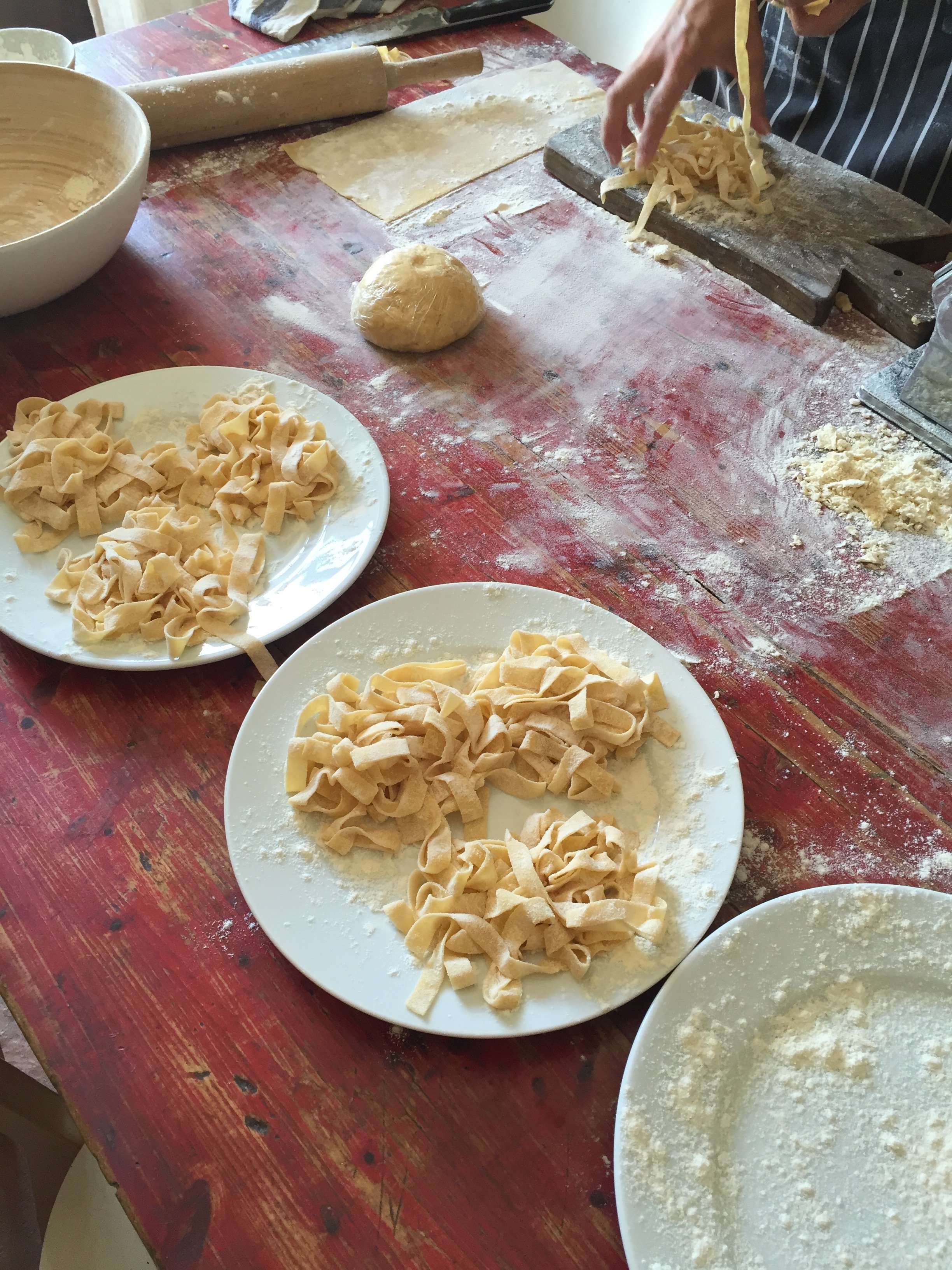
 In the afternoon we went to Cortona. Of course we had to stop by Bramasole.
In the afternoon we went to Cortona. Of course we had to stop by Bramasole.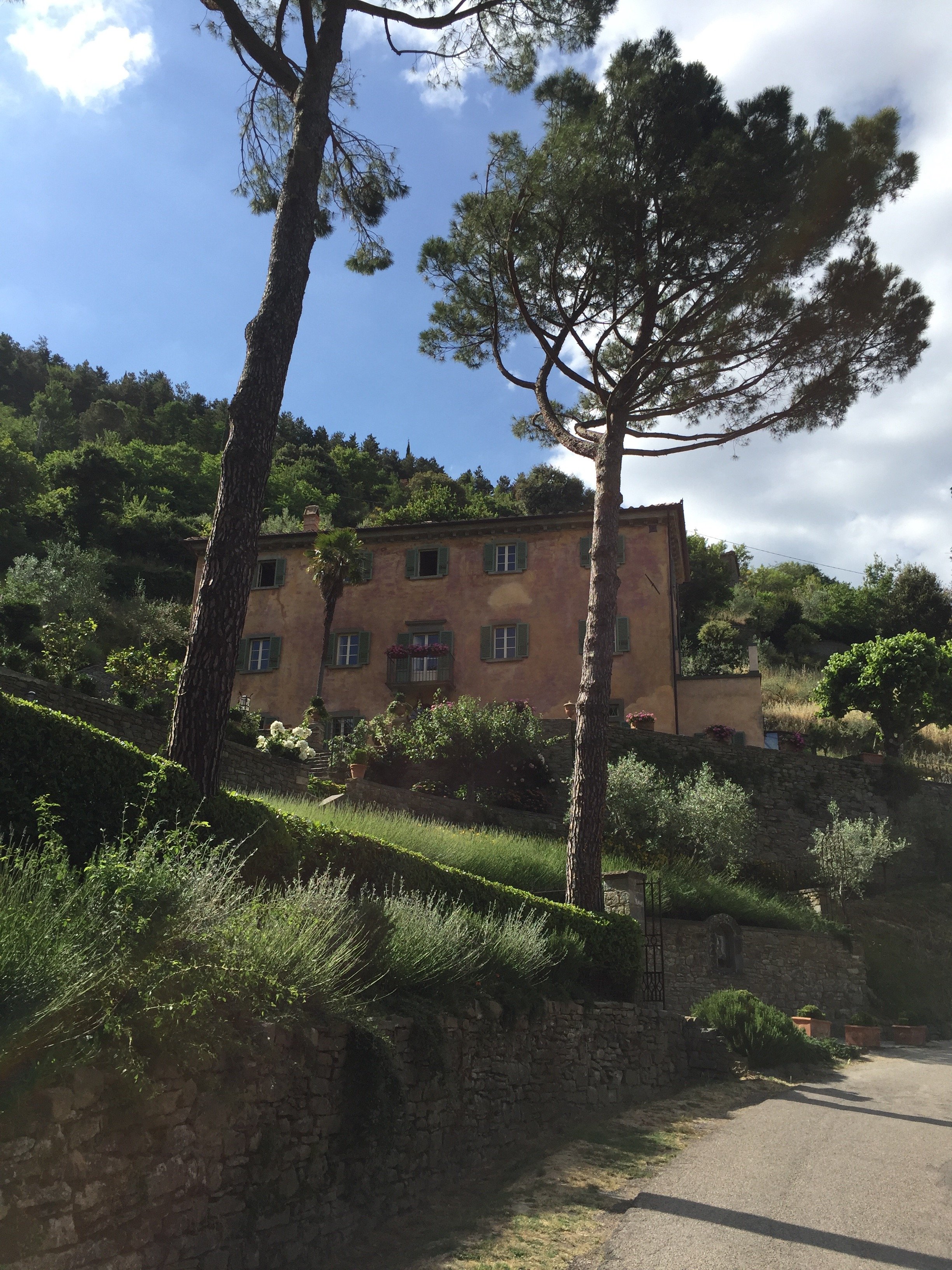
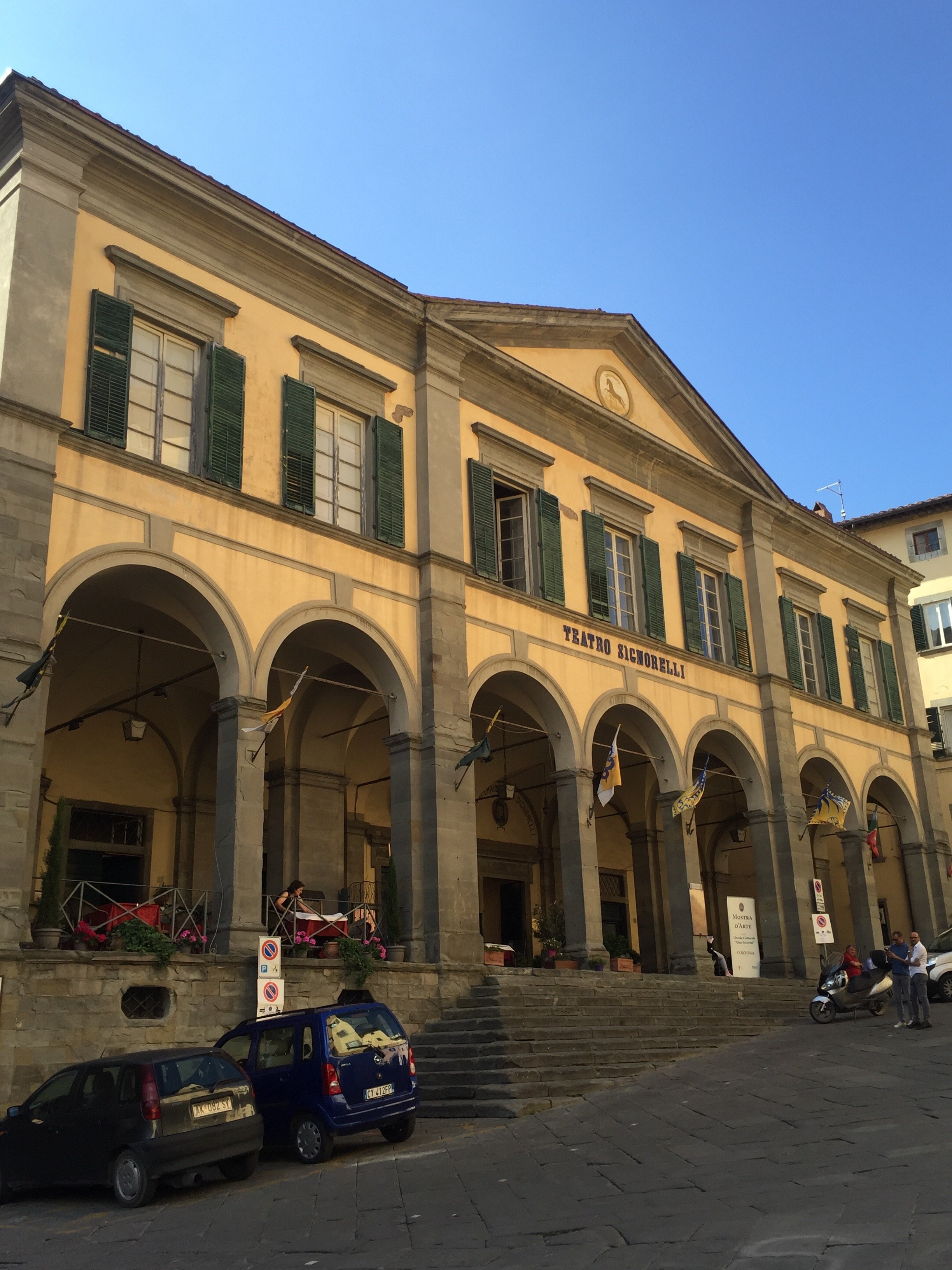 I can see why so many of the participants are repeaters. It's a genius way to travel, especially if you're a solo traveler. The retreats are small and personal. Yet, there's plenty of alone time if you need it.Since the retreat I've been trying to practice yoga at least three times a week. My friends, who are very serious about it, recommended a few beginner videos to me. It's a great way to start my day (good thing I saw 45's unhinged press conference this morning after yoga). I say this as someone who is not crunchy. I still don't understand what the heck is going on with this bulletproof Matcha tea craze.One of Erin's goals when she started Eat, Pray, Yoga, was to find a way to include charitable work. You can read more about the organizations they collaborate with here.
I can see why so many of the participants are repeaters. It's a genius way to travel, especially if you're a solo traveler. The retreats are small and personal. Yet, there's plenty of alone time if you need it.Since the retreat I've been trying to practice yoga at least three times a week. My friends, who are very serious about it, recommended a few beginner videos to me. It's a great way to start my day (good thing I saw 45's unhinged press conference this morning after yoga). I say this as someone who is not crunchy. I still don't understand what the heck is going on with this bulletproof Matcha tea craze.One of Erin's goals when she started Eat, Pray, Yoga, was to find a way to include charitable work. You can read more about the organizations they collaborate with here.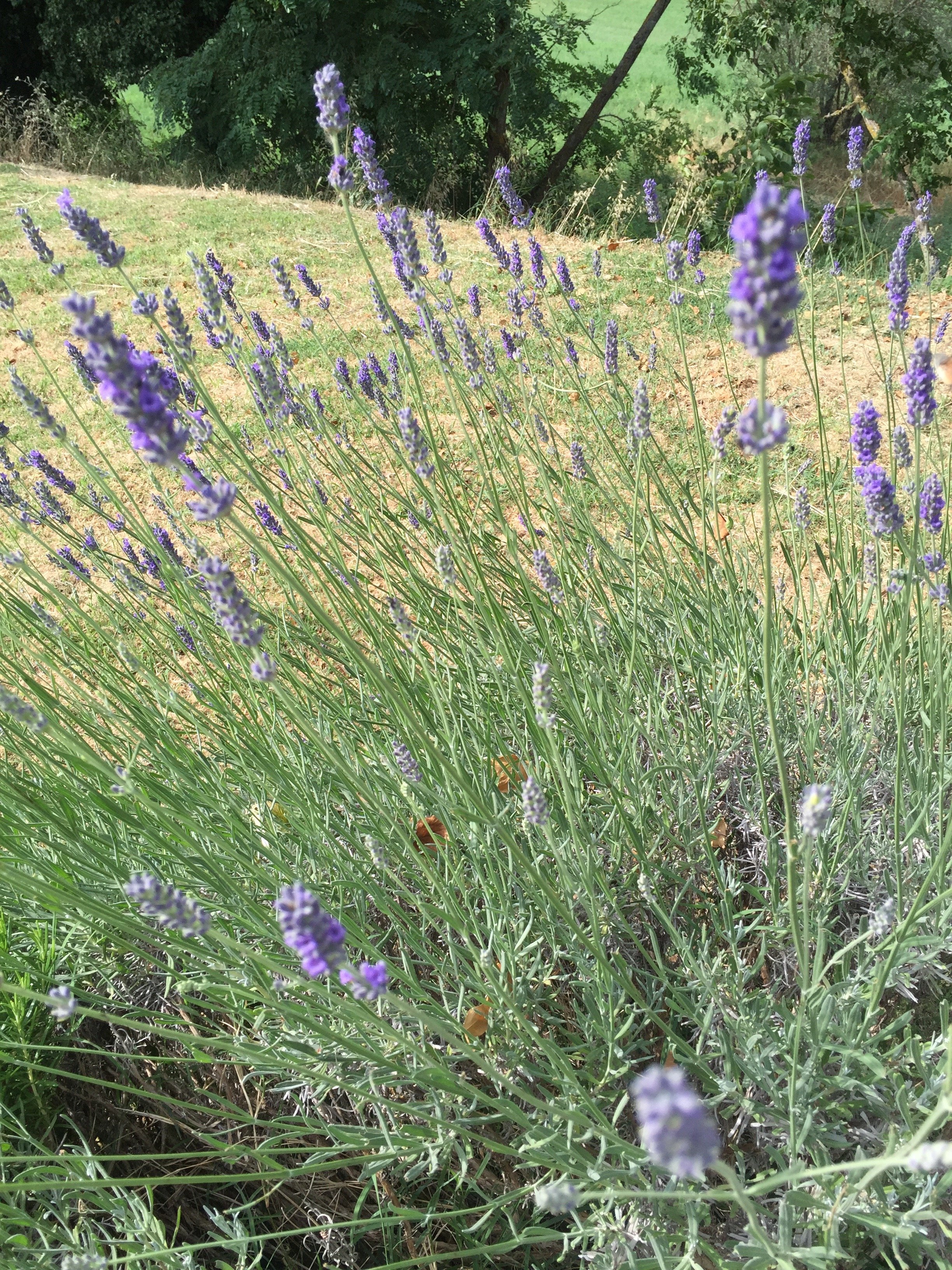
Life in Rome - Centrale Montemartini Museum, an Ancient and Modern Mix
This museum is not in the Historic Center but located in the dynamic and funky Ostiense neighborhood. It has been on my list for years and I finally visited it recently with my friend, Marta. We loved it.I saw a spread in American Vogue that had used the museum as a backdrop, so I thought I had an idea of what to expect.I was wrong. The museum is located inside a former power plant that was built in 1912. The plant closed during the early '60s. In 1997 the city used the abandoned space to temporarily house works from the Capitoline Museums, which were under renovation. Thankfully, the Cultural Minister had the idea to permanently convert the structure into a museum. Many of the pieces in the museum were excavated during the late 1900's and the 1930's.I found out after we left that I have personal connected to the museum. The Vignacce Marsyas piece was excavated during a 2009 dig in Villa delle Vignacce directed by my friend, Dr. Darius Arya. It's believed to have been the work of artisans from the early 2nd century. Thanks for the scoop, Erica!The space alone is worth a trip and the artwork inside is very interesting as well. I think this museum would appeal to young children too, especially if they’re into big machines.The museum was practically empty the afternoon we were there. We saw two artists sketching the mosaic floors and there was a small film crew setting up a shoot as we left. That’s it. Rome residents get a discounted ticket, so bring your I.D.It’s close to the one of the best pasty shops in Rome, Andreotti, and not far from a large EATALY. There’s excellent street art in the area. If you’re looking for something off the beaten path, this is museum is perfect. I've read some reviews from tourists who say the area is "sketchy." Perhaps this is the reason the museum is underrated? It's a shame as I think it's a good idea to get away from the crowds sometimes.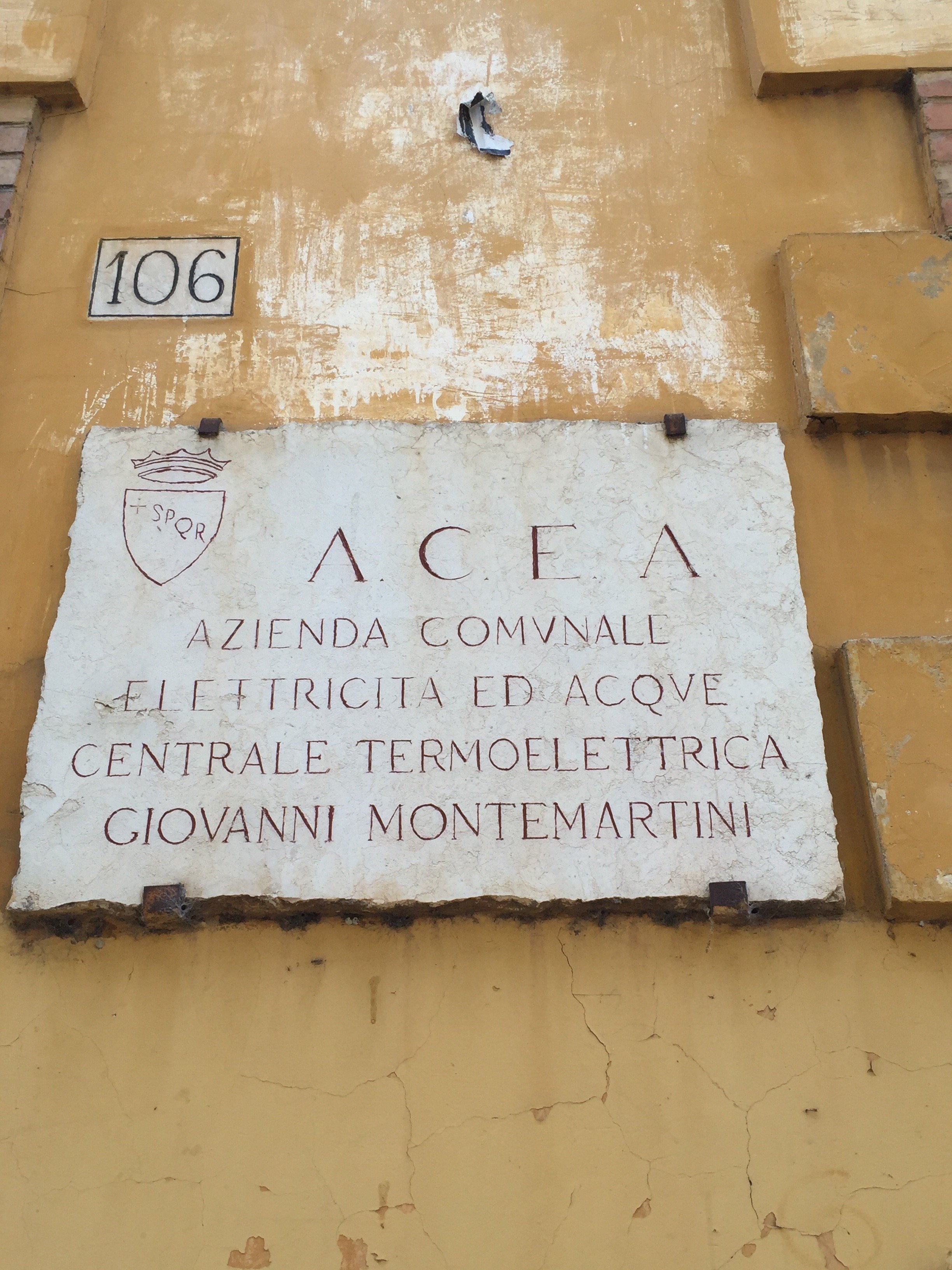
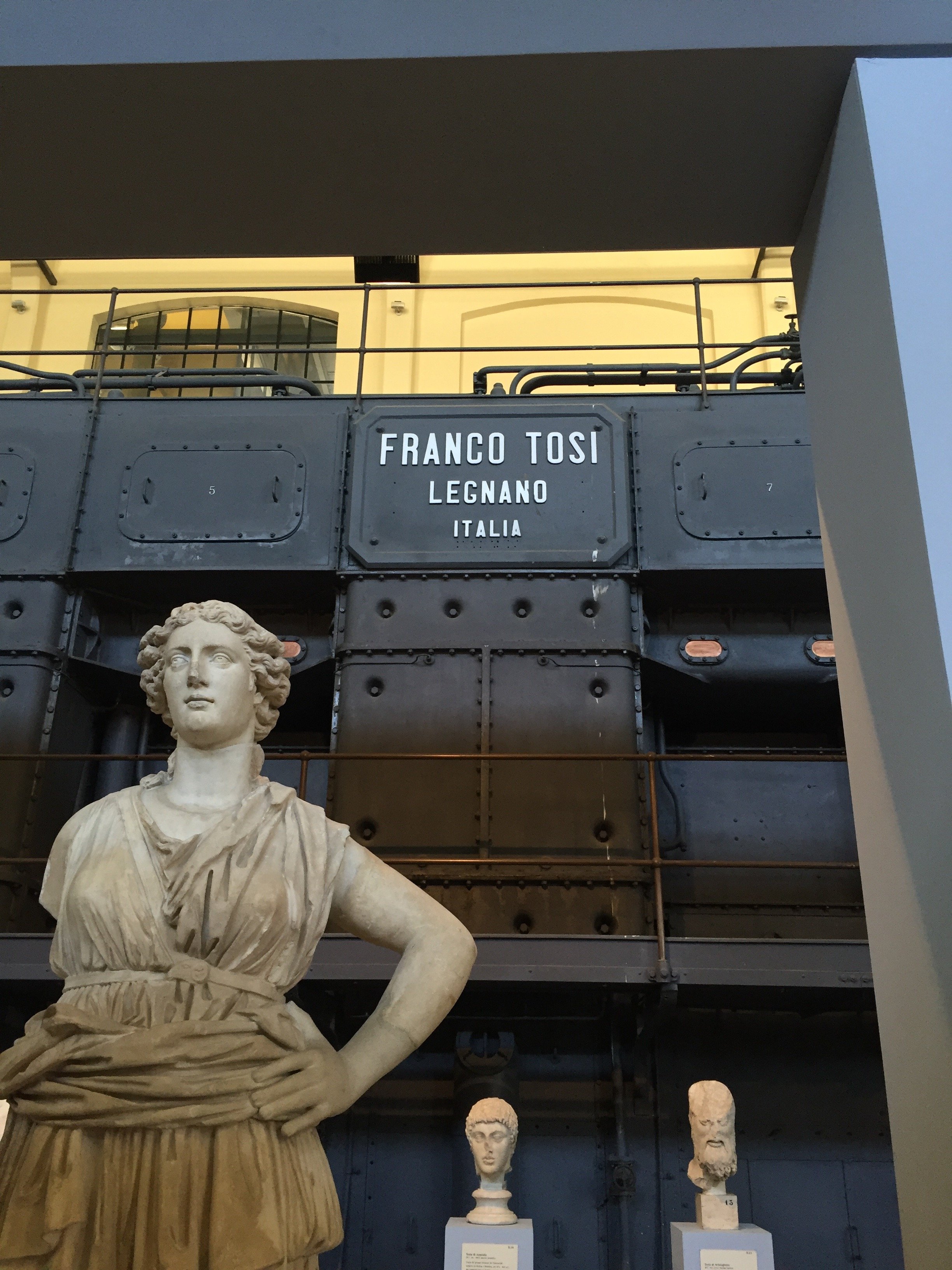
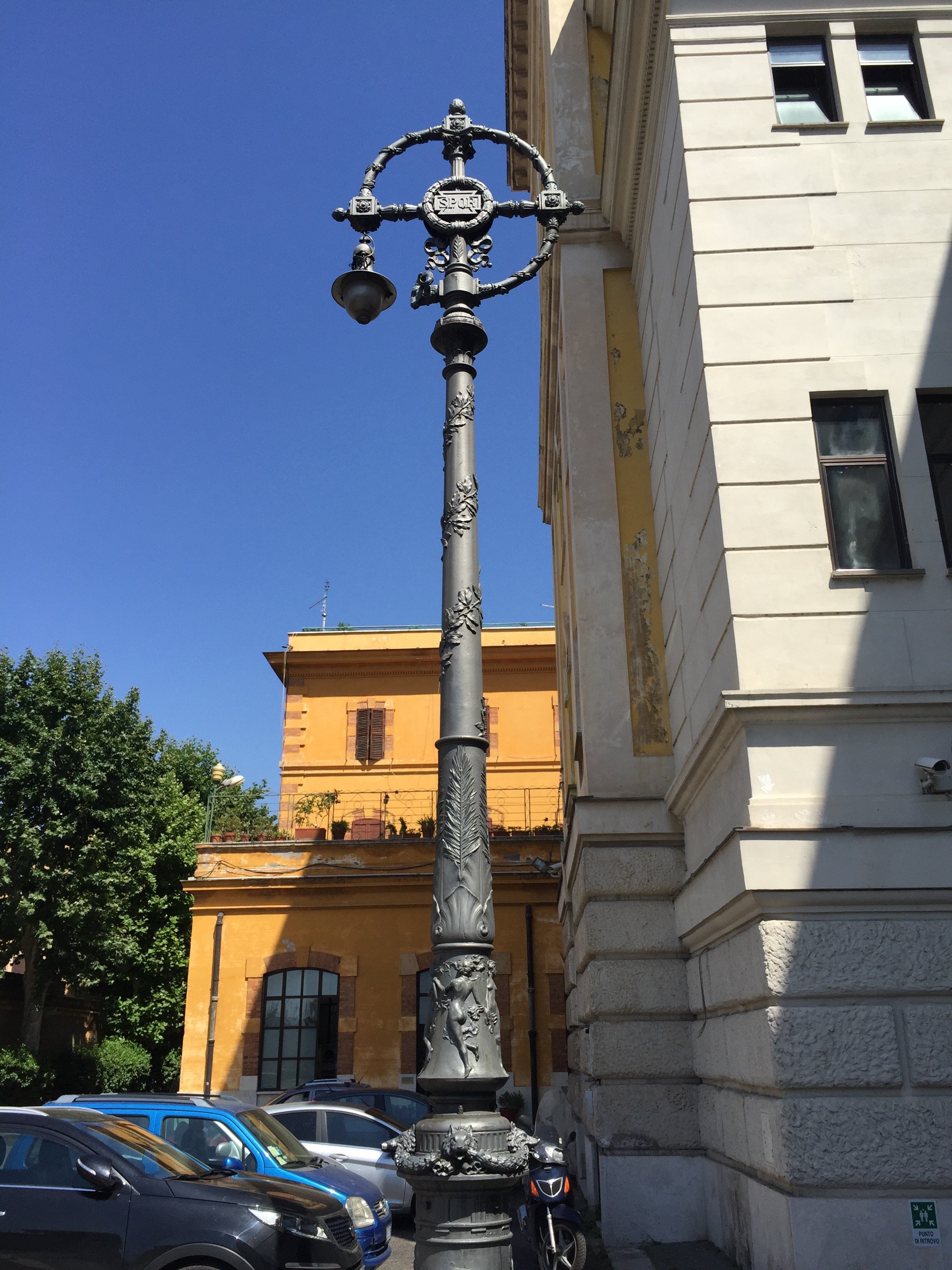
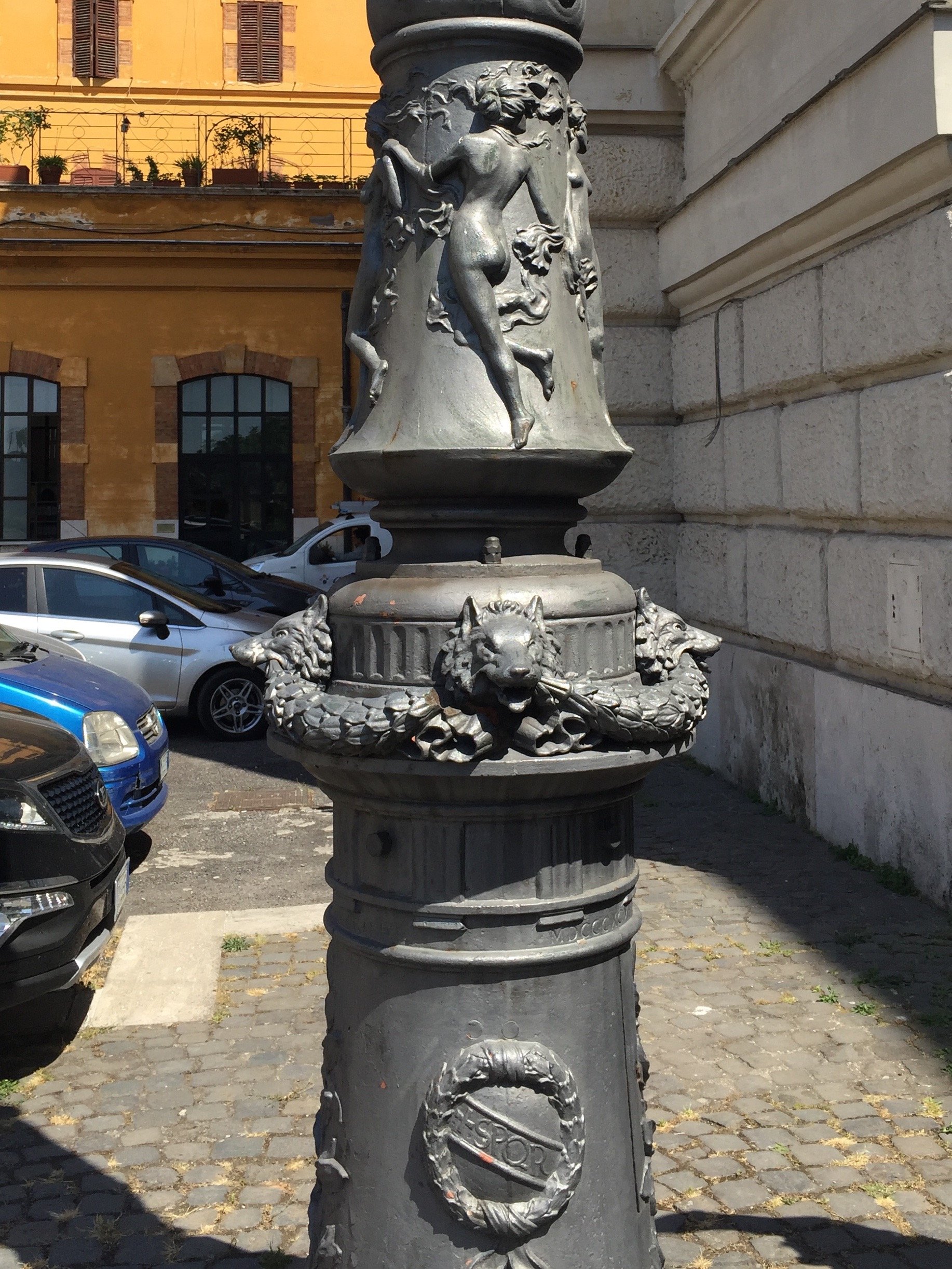
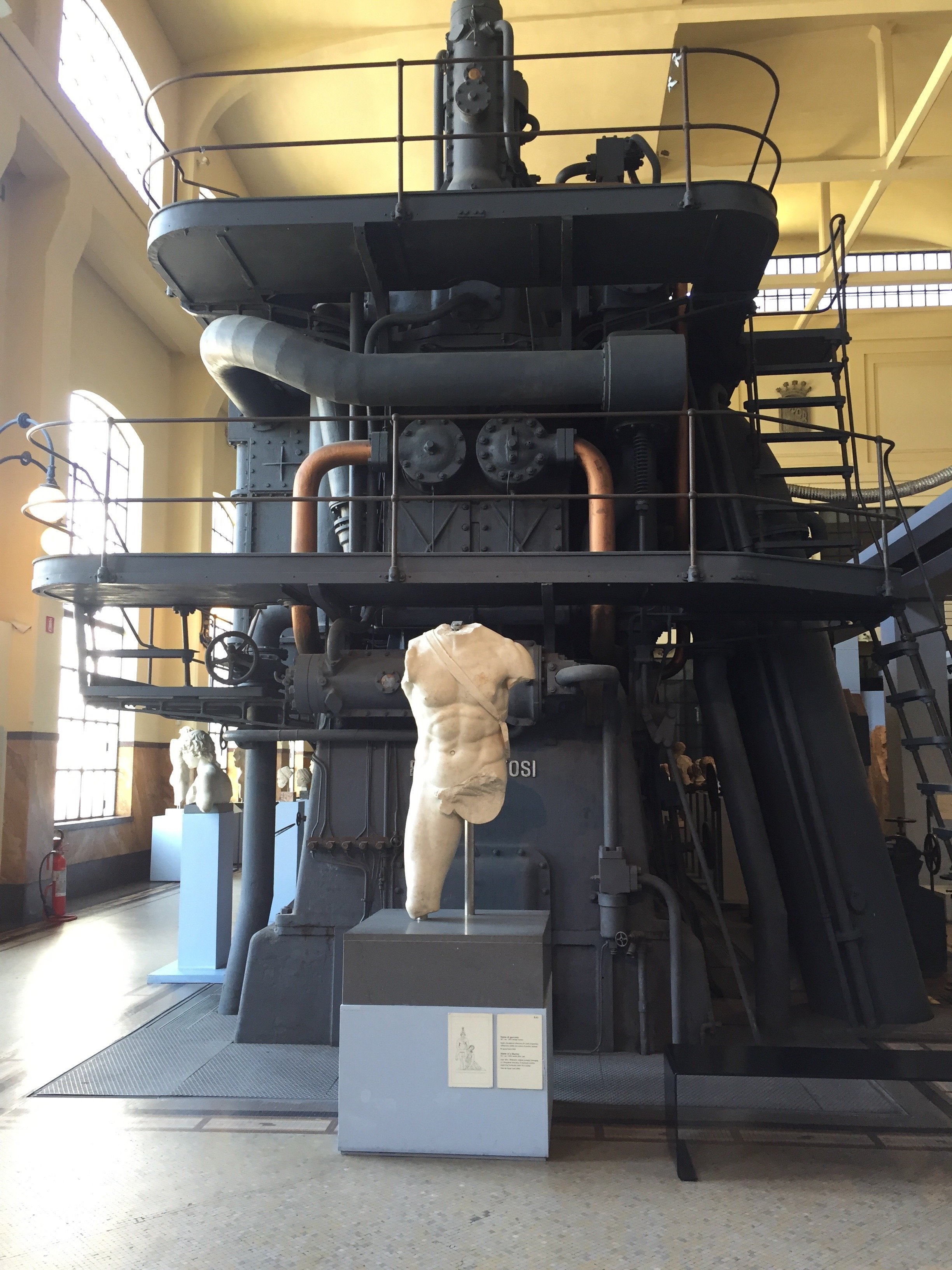
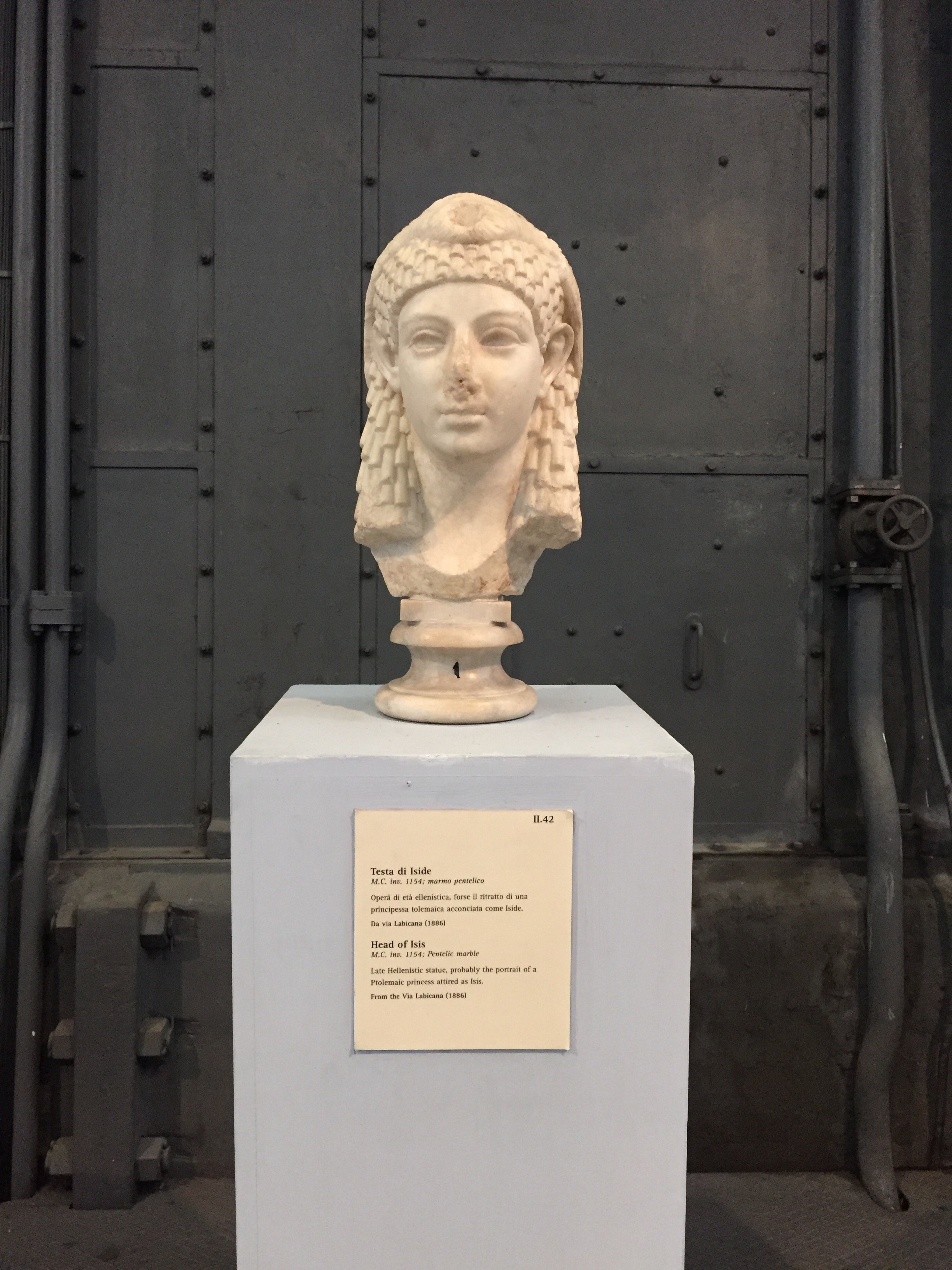
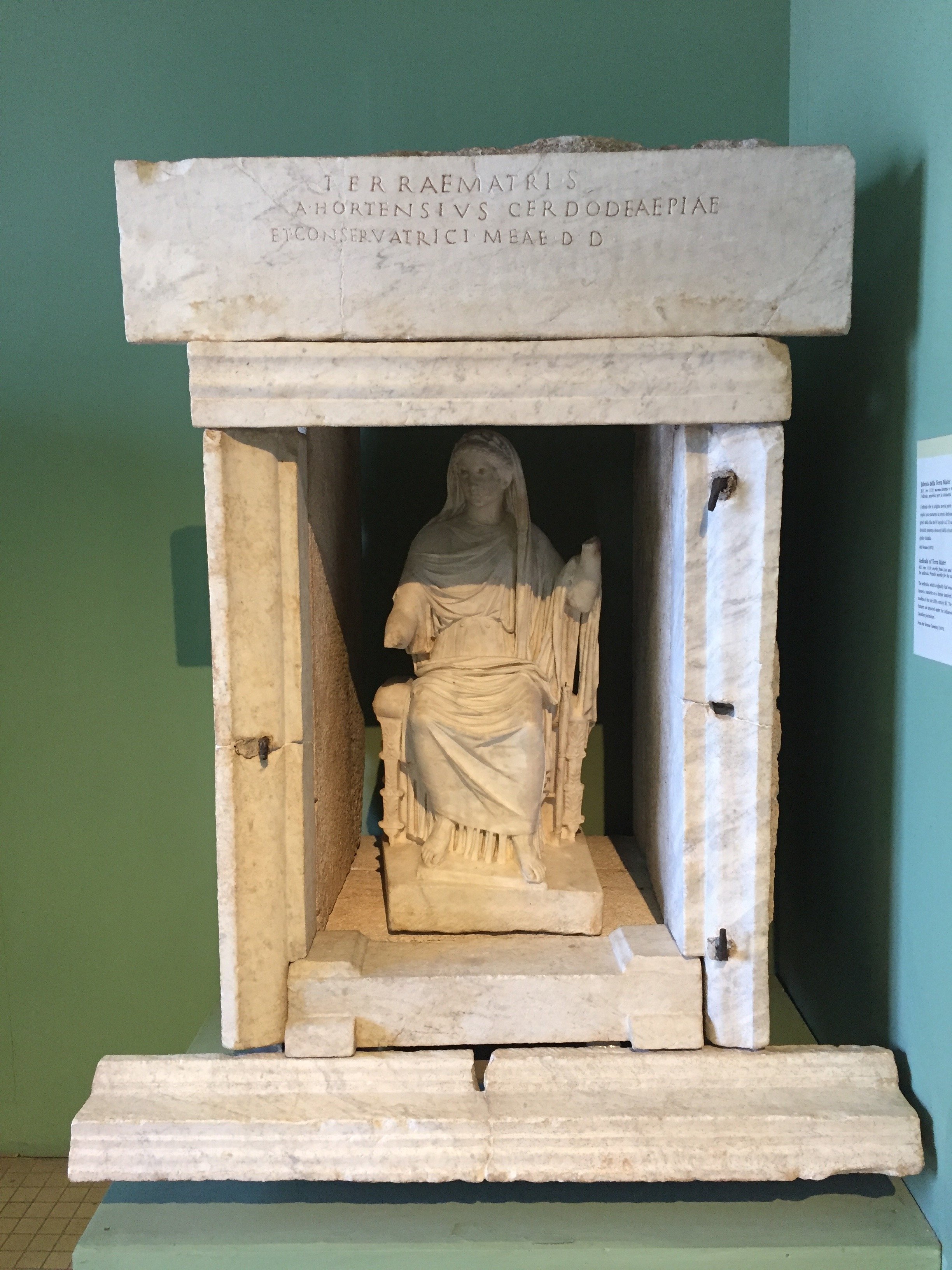
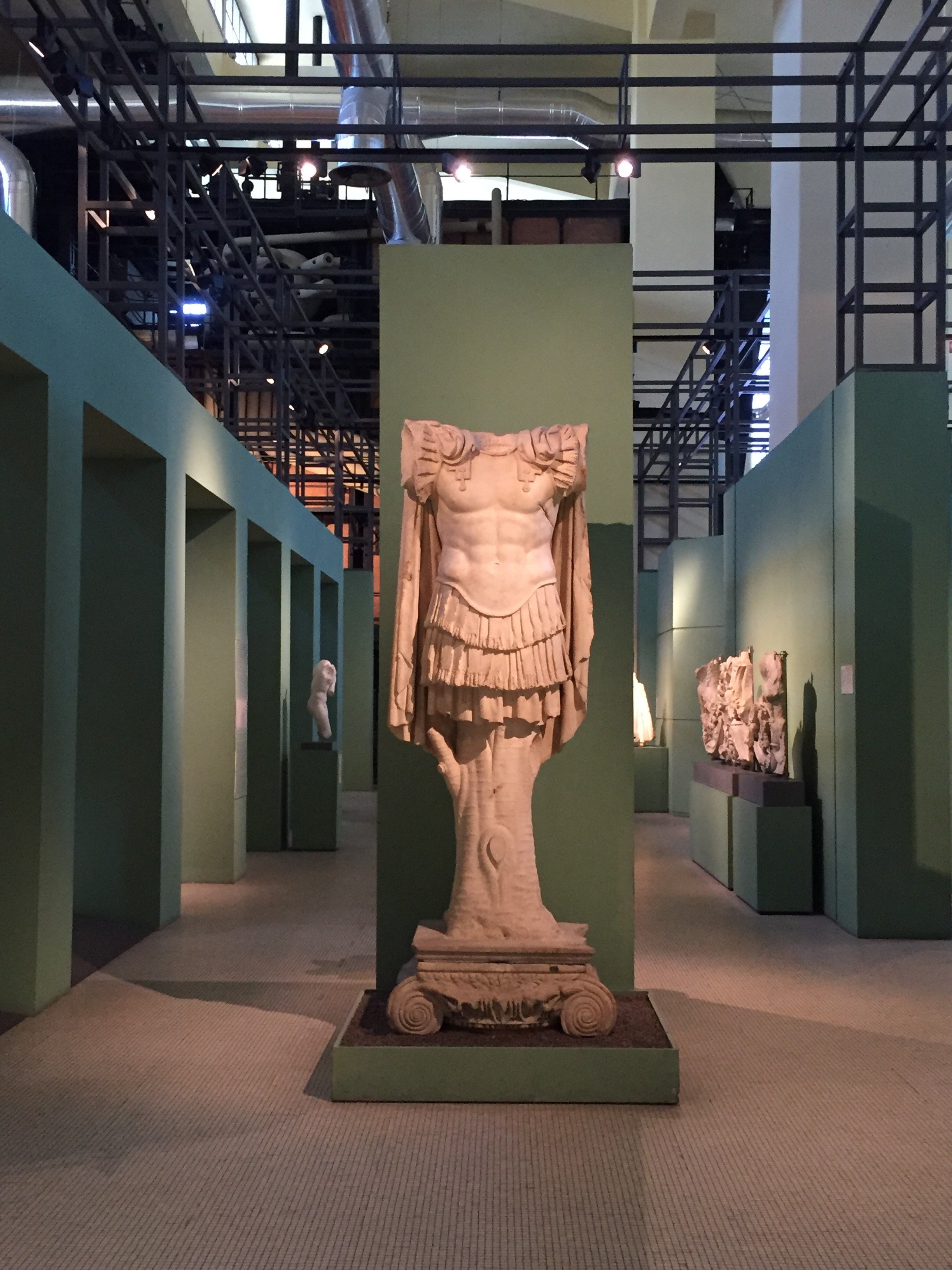
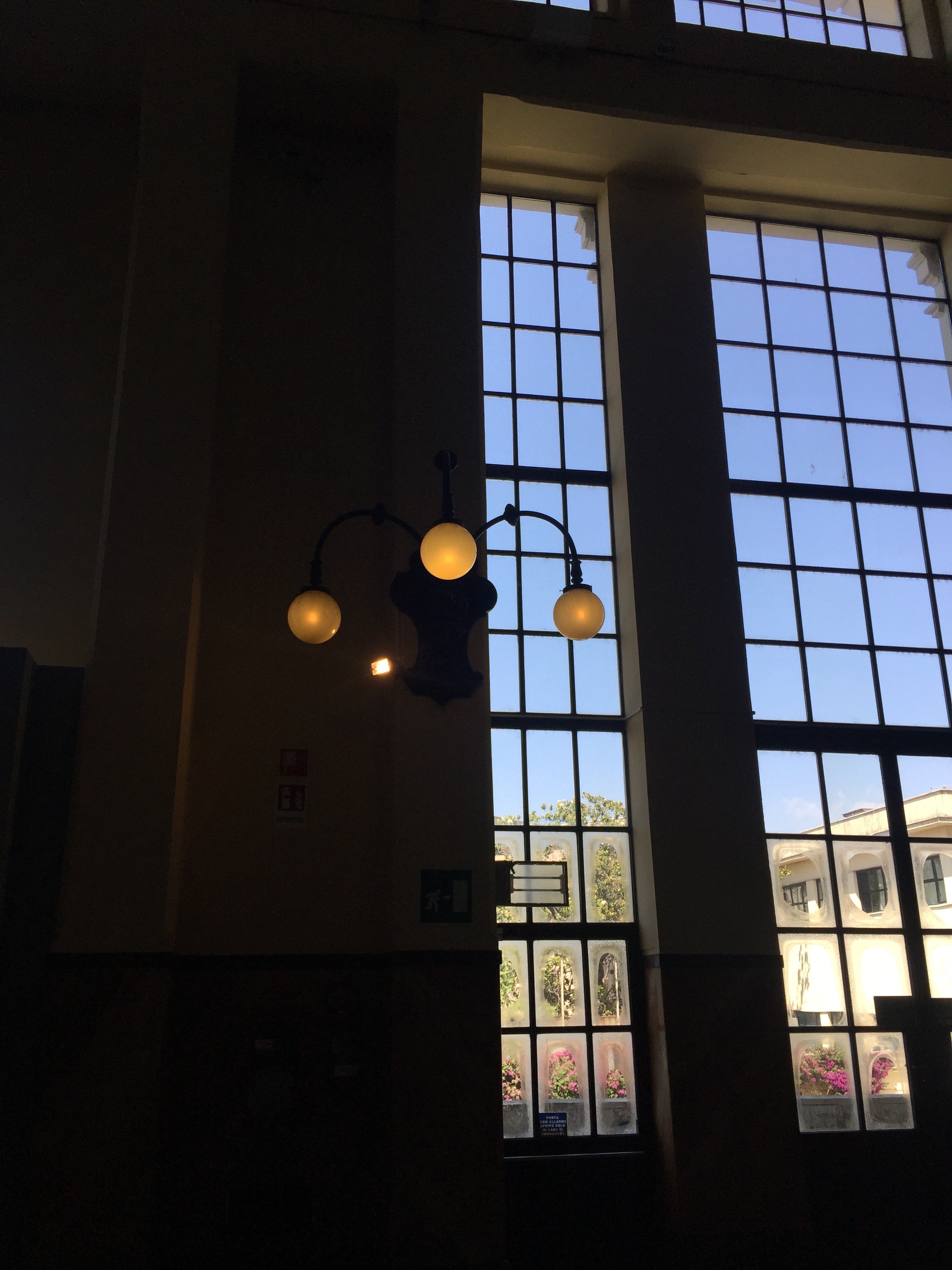
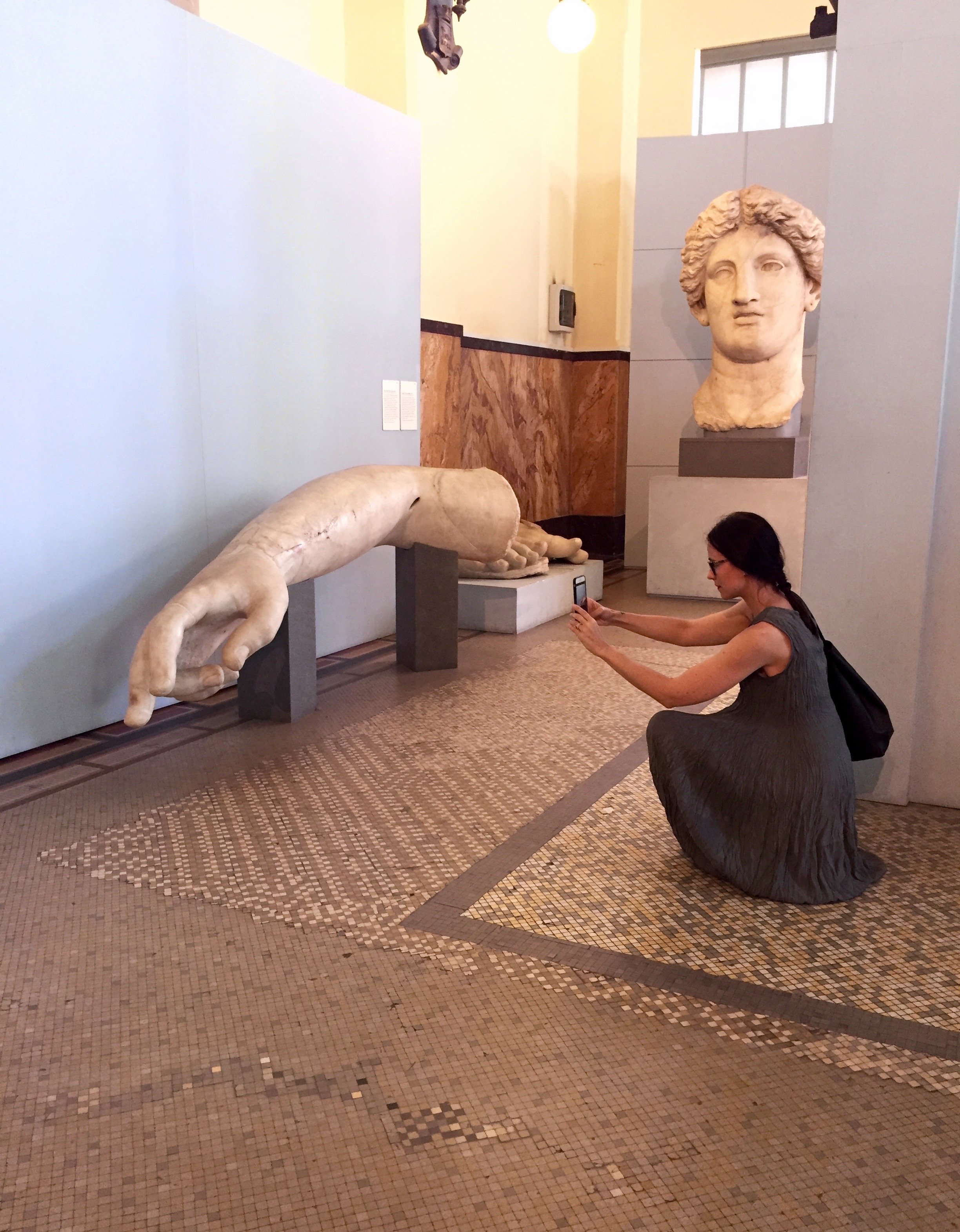
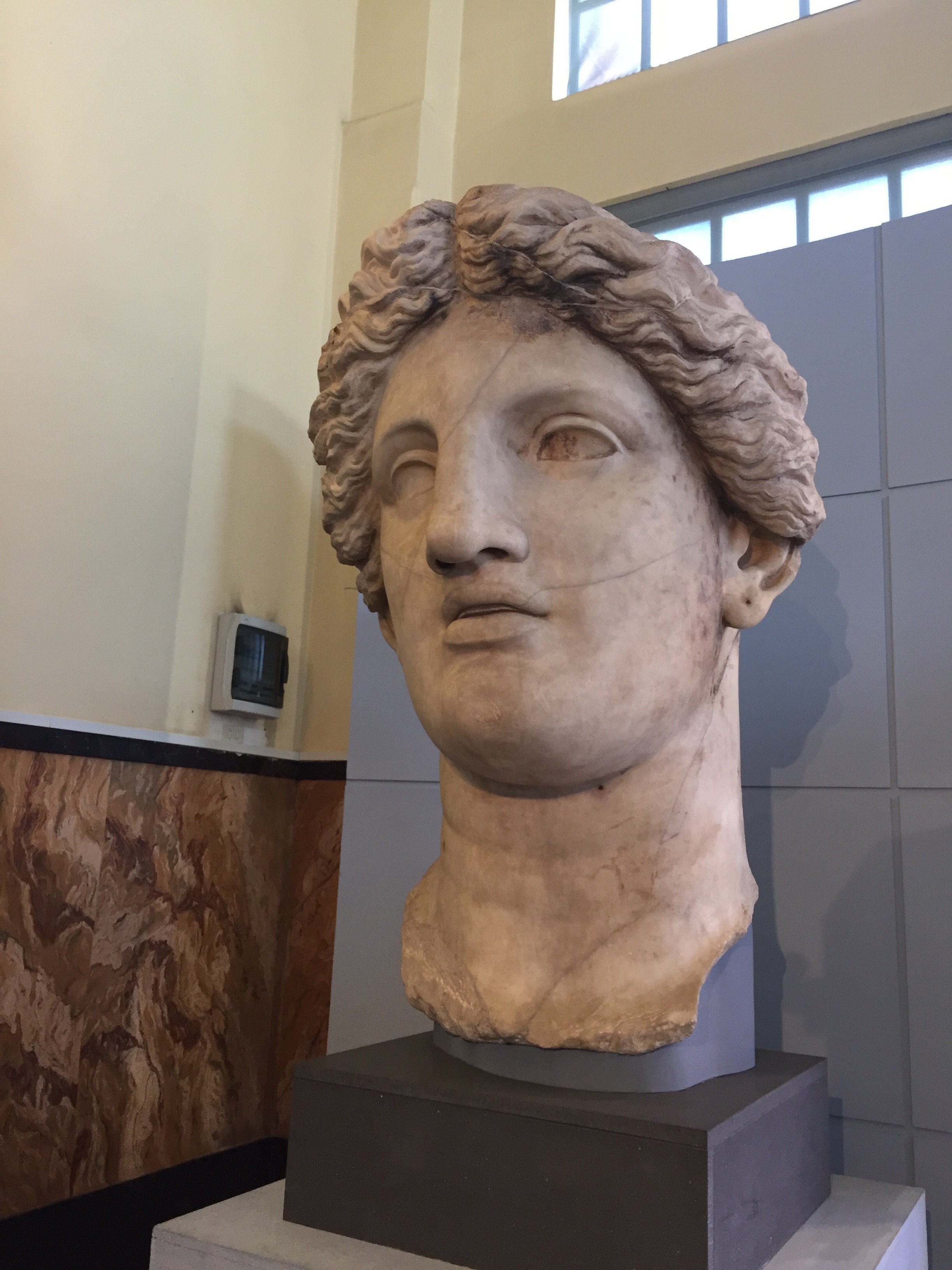
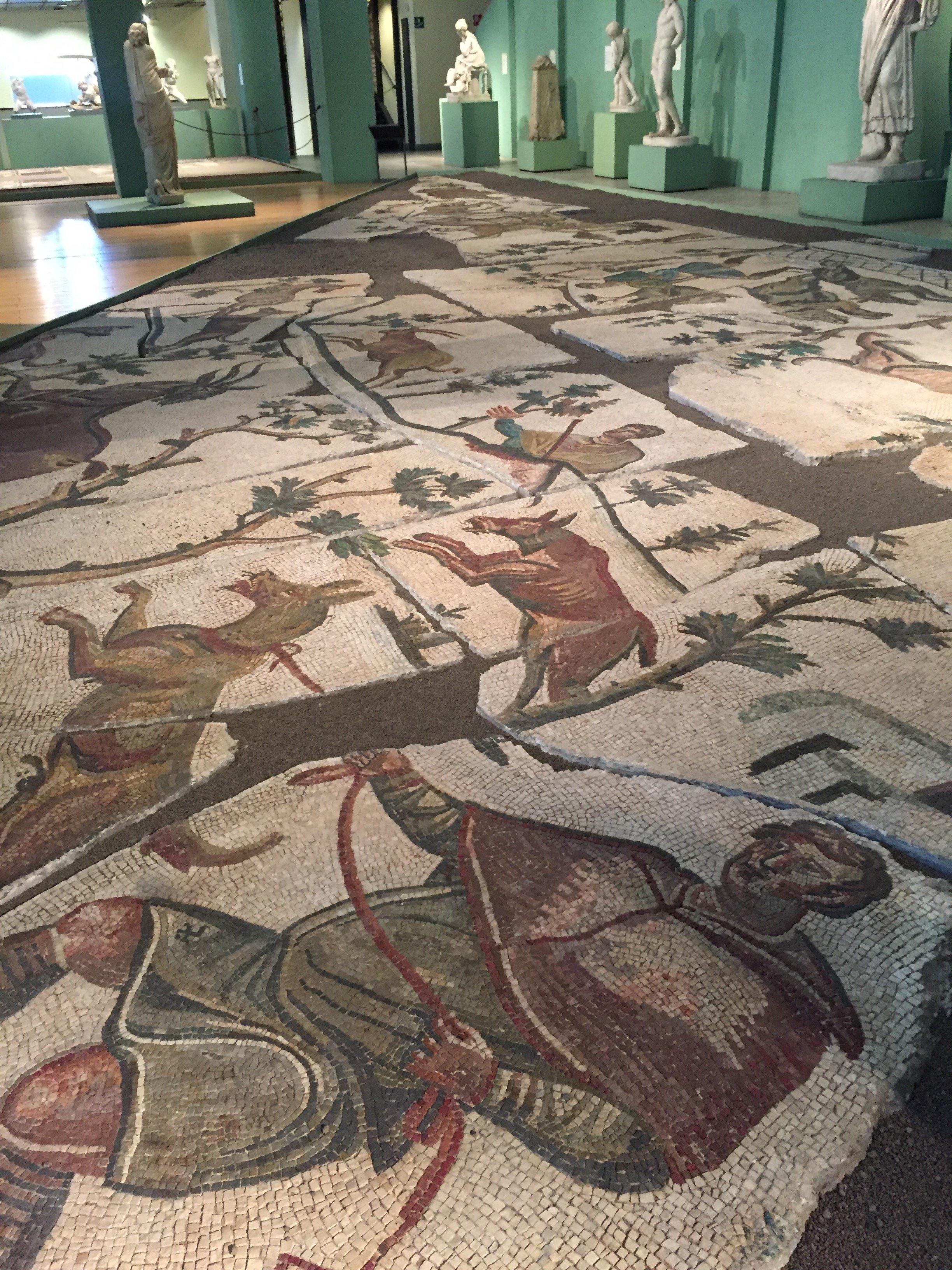

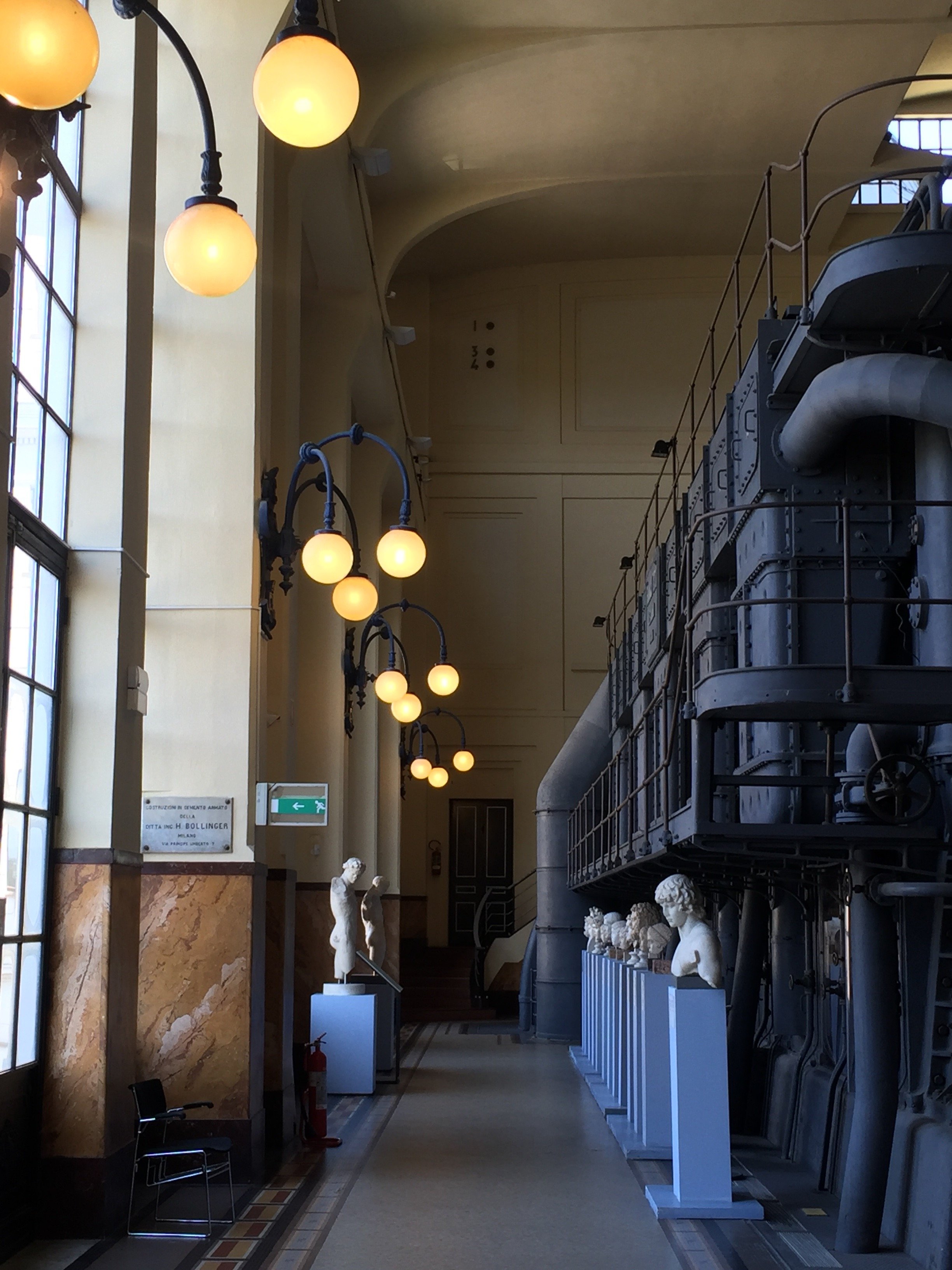
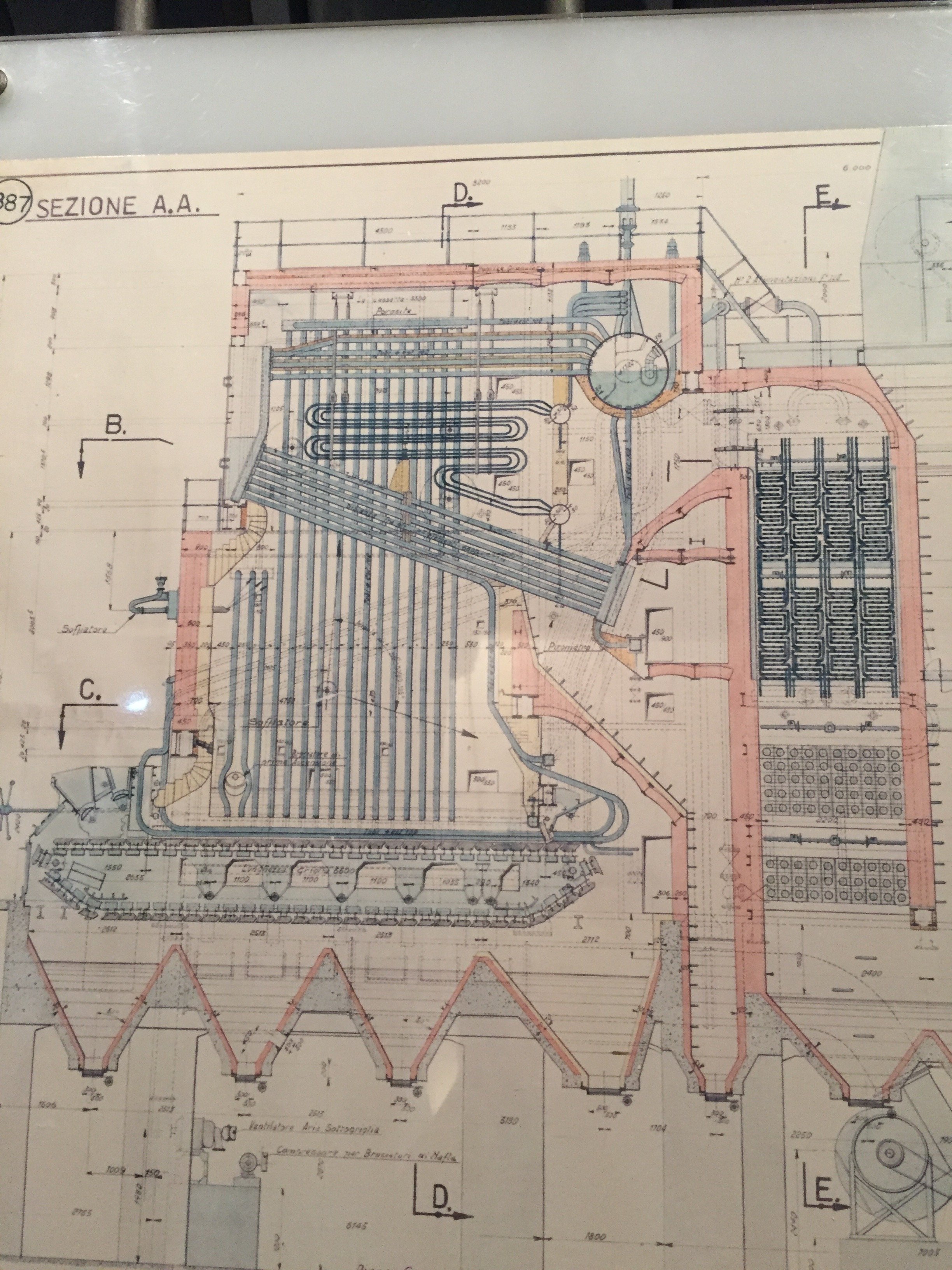 Via Ostiense 106Tel. +39 06 39967800Website www.centralemontemartini.orgOpen Tuesday to Sunday 9:00-19:00. Closed Mondays and some public holidays.Cash only.
Via Ostiense 106Tel. +39 06 39967800Website www.centralemontemartini.orgOpen Tuesday to Sunday 9:00-19:00. Closed Mondays and some public holidays.Cash only.
Life in Rome - The Artemisia Gentileschi Exhibit
Buon Anno!Man, am I happy to see 2017. I'm really looking forward to this year, despite all the craziness in the world. I have no control over these many complicated political and social issues but I can control how I react to them.There's a lot of ugliness and hatred in this world. I'm going to focus on the beauty and love. I know that sounds very Pollyanna. However, I strongly believe that those of us who work in creative fields and/or appreciate creative endeavors need to push back. Dostoyevsky wrote, "Beauty will save the world." I agree.If you're in Rome or plan to visit before May 7th, I highly recommend the “Artemisia Gentileschi and Her Time,” exhibit at the Museum of Rome in Palazzo Braschi. It's outstanding.Much has been written about the struggles of Gentileschi (1593-1653). This exhibit doesn't downplay them but focuses on her art and how the times influenced it. There are over one hundred paintings. Most are by Gentileschi with a few from her contemporaries.Gentileschi was the daughter of the painter Orazio and was heavily influenced by Caravaggio. She was the first woman to be admitted to the prestigious Accademia del Arte di Disegno in Florence.The population in Rome was two-thirds male when Gentileschi was growing up. It was very dangerous for a woman to be even be outside. Her mother died when she was twelve and she was raped by the painter her father hired to tutor her when she was seventeen. Her father had to hire a tutor because at the time women were denied access to the art academies. During the humiliating trial, Gentileschi was tortured and her family's reputation questioned. Her accuser (who had raped his wife, his sister-in-law, and tried to steal paintings from Orazio) was sentenced to a year in jail. His verdict was annulled.Gentileschi rejected the stereotypical female roles of the Early Baroque era and painted women who were powerful, mythical.The exhibit is categorized by city. You can see the influence living in Rome, Florence, Venice, London, and Naples (where she died, perhaps from the Plague) had on Gentileschi's work. After her death, Gentileschi's work was often attributed to her father or other artists.The exhibit is well organized (I know. Shocking). There are informative introductions (in Italian and English) to each period of her work.I saw her most famous work, Judith Slaying Holofernes, at the Ufizzi when I visited Florence a few years before I moved to Italy. She painted two versions and the other one is in Naples at Museo Nazionale di Capodimonte. 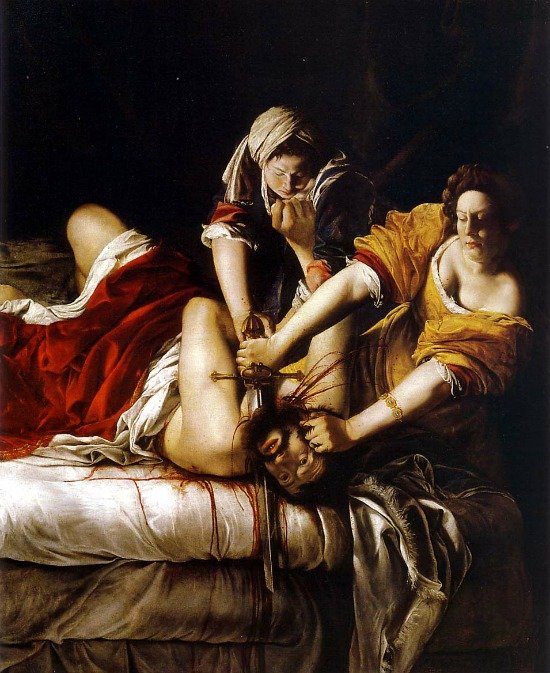 There many paintings of this biblical story (including one by Caravaggio himself). It's fascinating to compare her interpretation to that of her male peers.I don't know if it was the setting (a smaller room, less chaotic that the Ufizzi), post USA election stress, or what, but this time the painting unnerved me. I didn't want to look at it but I couldn't turn away. There was a woman next to me tearing up. It's truly a powerful, visceral, beautiful, work of art. My god the colors. The physicality. Gentileschi painted herself as Judith and her accuser as Holofernes. I didn't know the details of her trial then but even those who have no knowledge of Gentileschi's backstory, can see and feel the unadulterated rage.Moving on from that uplifting note, Palazzo Braschi is a striking venue located in Piazza Navona. During the weekends there was quite a line. It might be less crowded now that the exhibit has been running for a few weeks. Museum of Rome, Palazzo BraschiUntil May 7th, 2017Tuesday to Sunday from 10am to 7pm
There many paintings of this biblical story (including one by Caravaggio himself). It's fascinating to compare her interpretation to that of her male peers.I don't know if it was the setting (a smaller room, less chaotic that the Ufizzi), post USA election stress, or what, but this time the painting unnerved me. I didn't want to look at it but I couldn't turn away. There was a woman next to me tearing up. It's truly a powerful, visceral, beautiful, work of art. My god the colors. The physicality. Gentileschi painted herself as Judith and her accuser as Holofernes. I didn't know the details of her trial then but even those who have no knowledge of Gentileschi's backstory, can see and feel the unadulterated rage.Moving on from that uplifting note, Palazzo Braschi is a striking venue located in Piazza Navona. During the weekends there was quite a line. It might be less crowded now that the exhibit has been running for a few weeks. Museum of Rome, Palazzo BraschiUntil May 7th, 2017Tuesday to Sunday from 10am to 7pm
Before & After - Via Banchi Vecchi Project
Ciao Bloggisti,Earlier I wrote about the Via Monserrato project. One of the other apartments we worked on was located two blocks away on Via Banchi Vecchi. It was a new apartment for our client.The apartment was empty so we didn't have the same logistical issues but two bathrooms, and the kitchen had to be renovated. Any time you start opening walls you will have some surprises, especially in a building that's over three hundred years old.The brief from the client stated that the unique original flooring and the red tiles in the kitchen could not be replaced. The floors weren't in great shape but I like to think of them as adding character. The client wanted to improve the layout, add a closet in the bedroom, lighten up the very dark kitchen, and make the second bathroom more functional.The bulk of the budget went to the renovation. Some of the furniture came from the other apartments. We bought a mix of high-end hardware/fixtures along with budget friendly pieces.The minute the client stated that they had to change the layout, we called an architect. Fortunately, Domenico Minchilli and his studio took on the project. Square footage wise it was a lot smaller than their usual projects but it was complicated. We had worked together before which made the renovation process, never easy, smoother.BEFORE - The Kitchen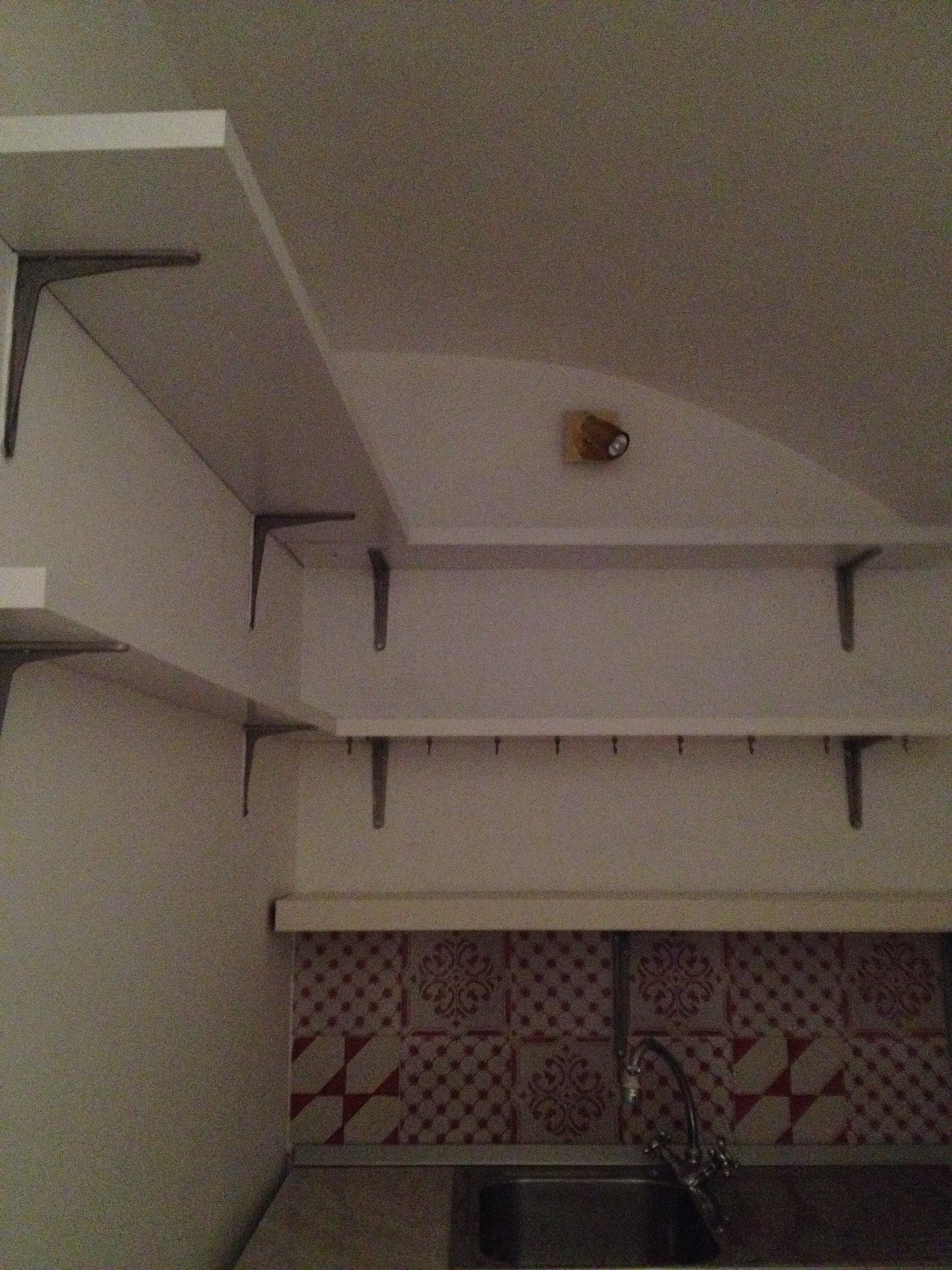 True, this is not a primary residence but I don't think any guest would want to spend a lot of time in here. It was impossible to get a decent shot of this dark, cramped space. The hallway before. The kitchen is behind the wall on the right.
True, this is not a primary residence but I don't think any guest would want to spend a lot of time in here. It was impossible to get a decent shot of this dark, cramped space. The hallway before. The kitchen is behind the wall on the right.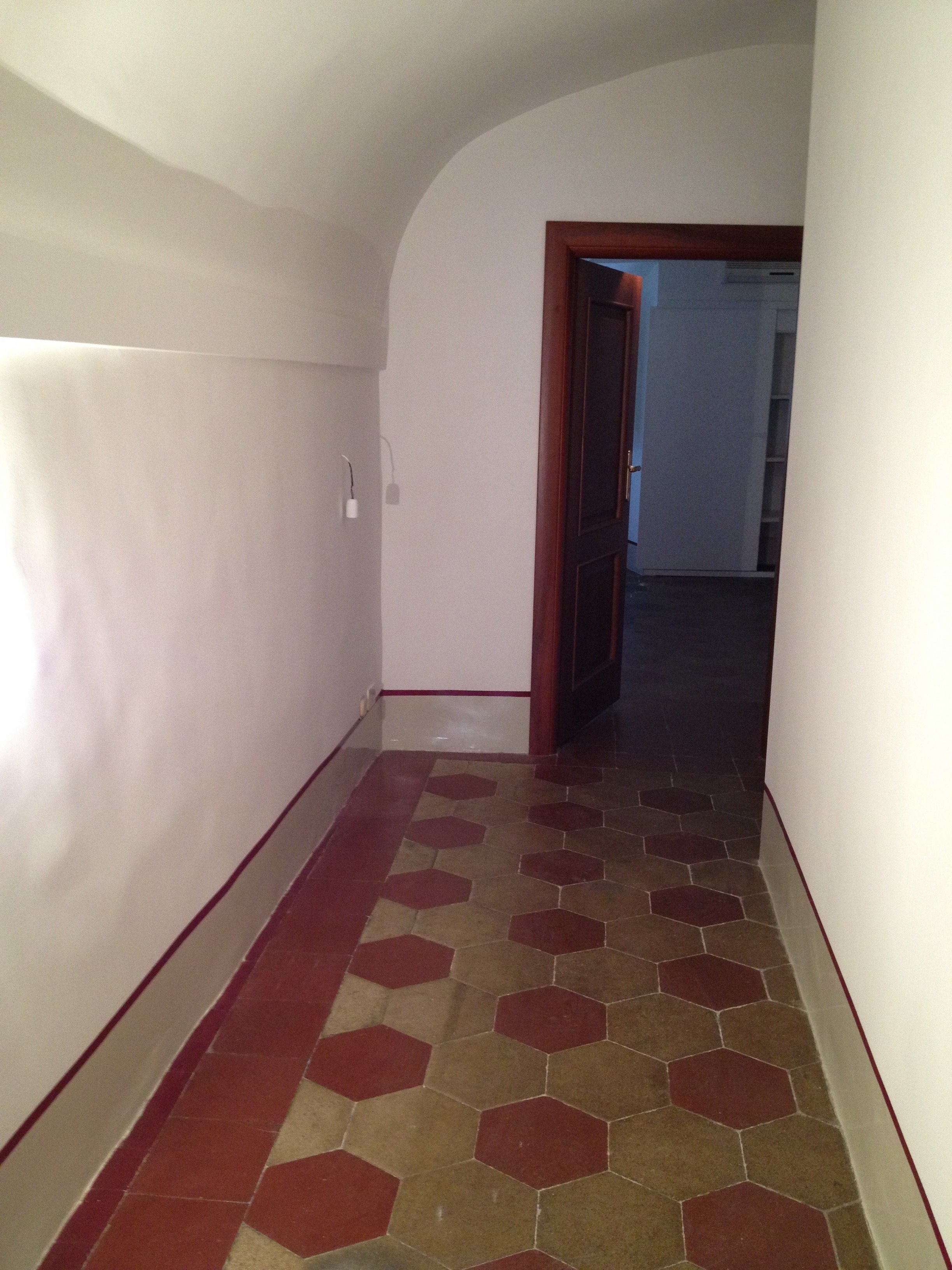 There were structural issues that had to be addressed (electrical, ventilation) so a upgrade/renovation had to happen.
There were structural issues that had to be addressed (electrical, ventilation) so a upgrade/renovation had to happen.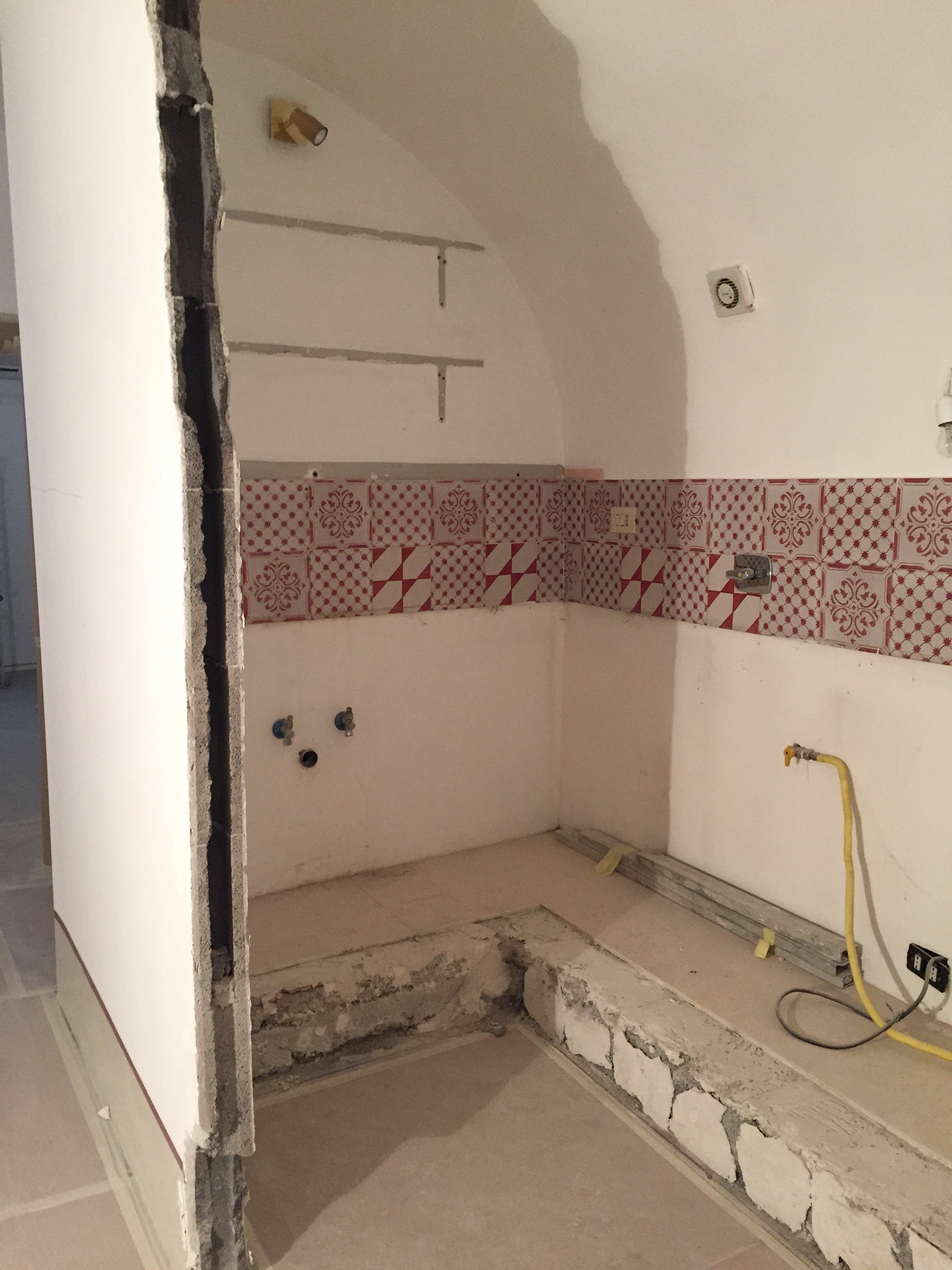 Originally, we discussed opening just one of the walls. Studio Minchilli suggested removing all them so you could see the entire arch as you walked into the apartment.AFTER
Originally, we discussed opening just one of the walls. Studio Minchilli suggested removing all them so you could see the entire arch as you walked into the apartment.AFTER What a difference. It's light and there's plenty of space to move around. The cabinets are from IKEA but the counter top is quartz from Stone Italiana. We decided to spend more for a higher quality counter top given the open plan design. It elevates the entire space, making the IKEA cabinets look more expensive.My anxiety level was not good the morning of this installation. A heavy slab, cut to order. Three men had to carry it.
What a difference. It's light and there's plenty of space to move around. The cabinets are from IKEA but the counter top is quartz from Stone Italiana. We decided to spend more for a higher quality counter top given the open plan design. It elevates the entire space, making the IKEA cabinets look more expensive.My anxiety level was not good the morning of this installation. A heavy slab, cut to order. Three men had to carry it.  The light fixture is custom. Il Paralume.
The light fixture is custom. Il Paralume.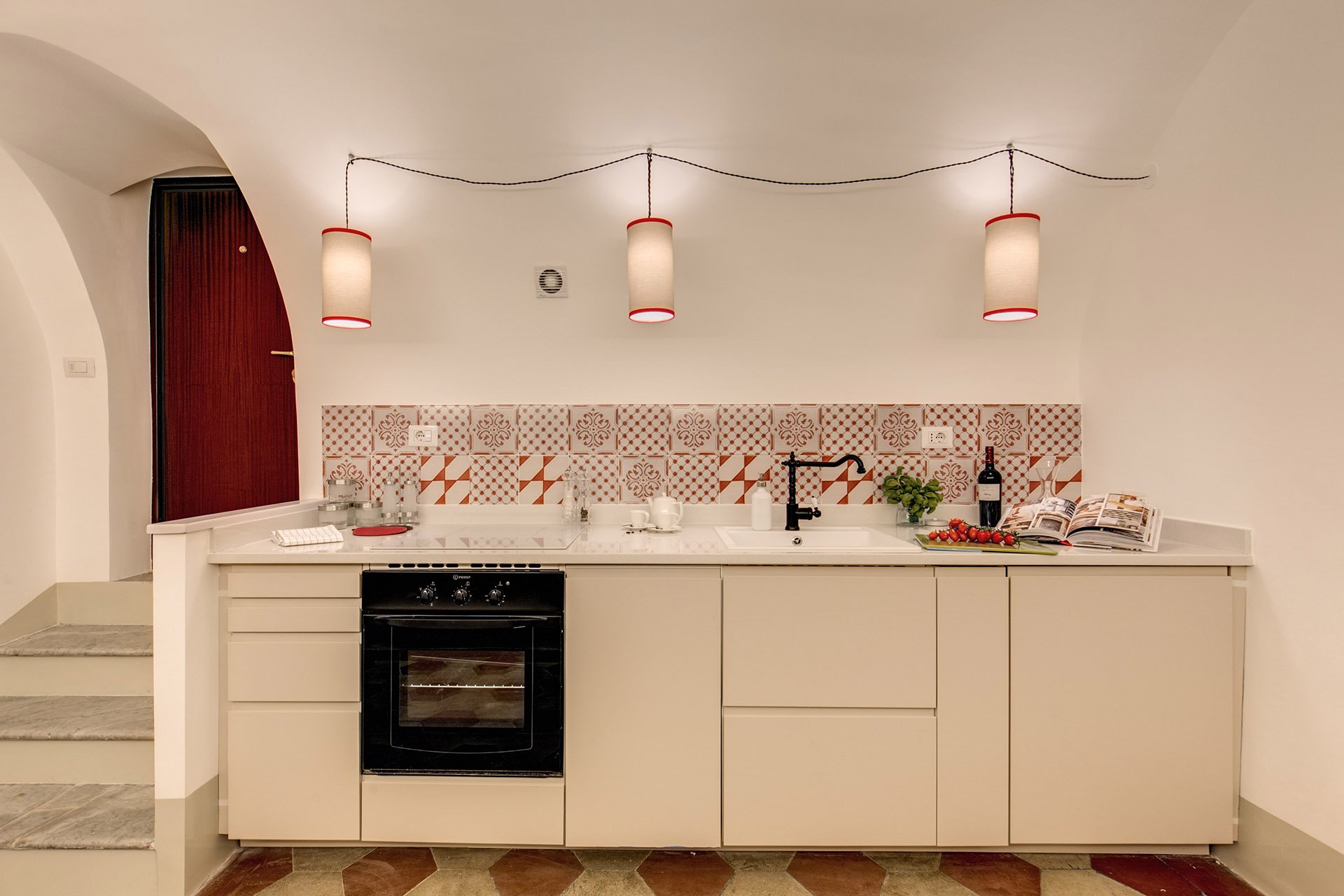 We also installed LED lights on the right.
We also installed LED lights on the right.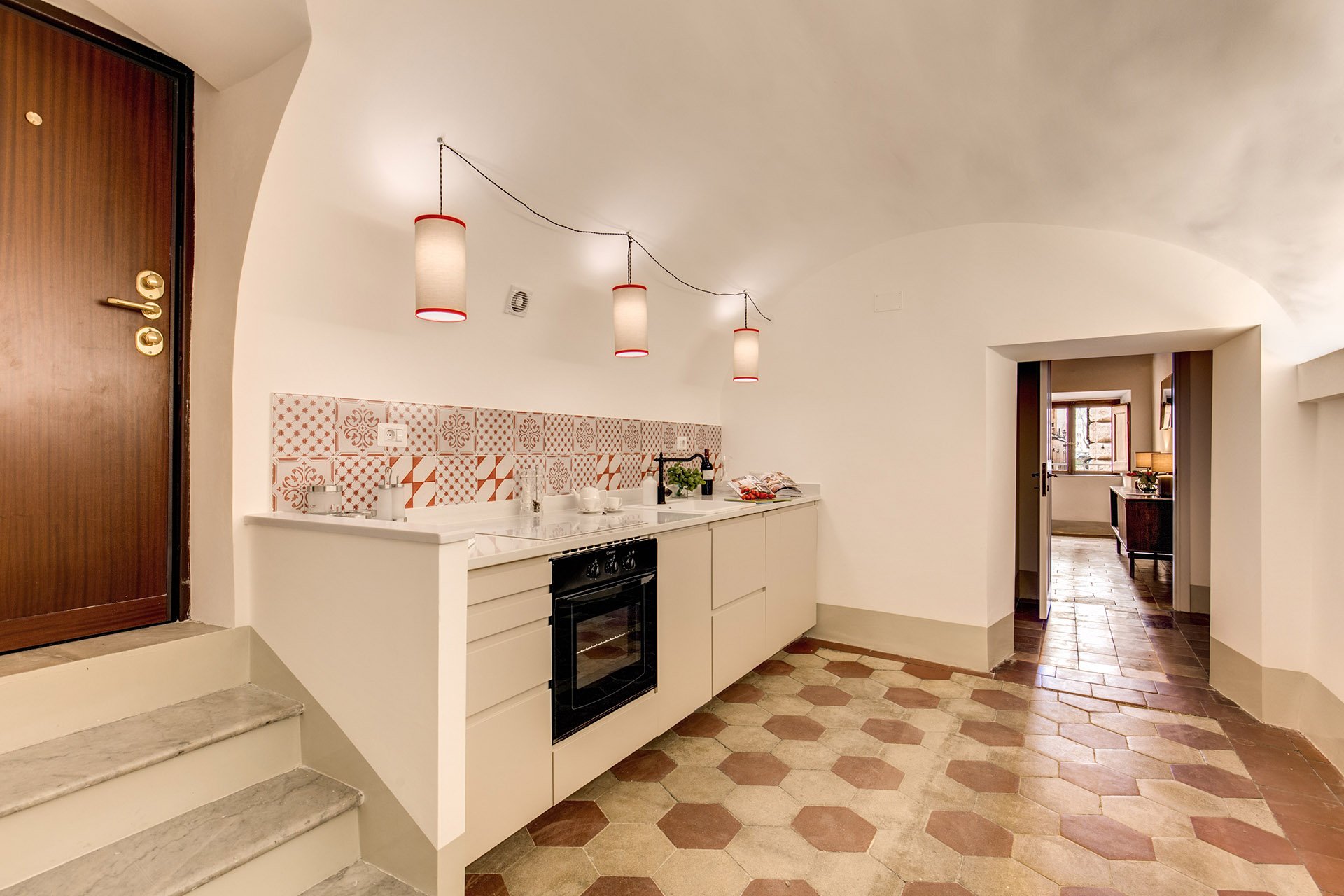 BEFORE - Master Bathroom
BEFORE - Master Bathroom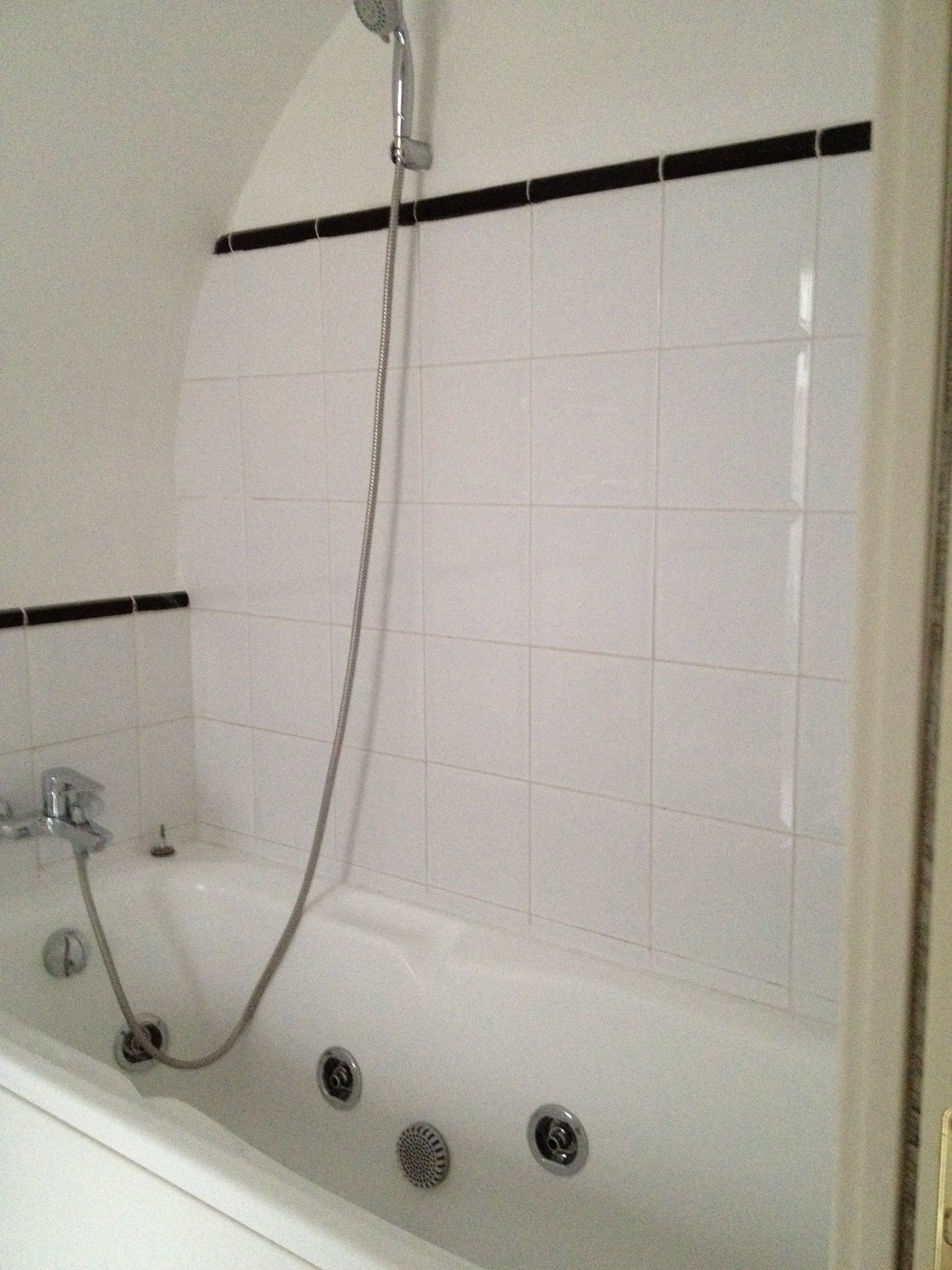 There were dated, inexpensive white tiles on the floor. AFTER
There were dated, inexpensive white tiles on the floor. AFTER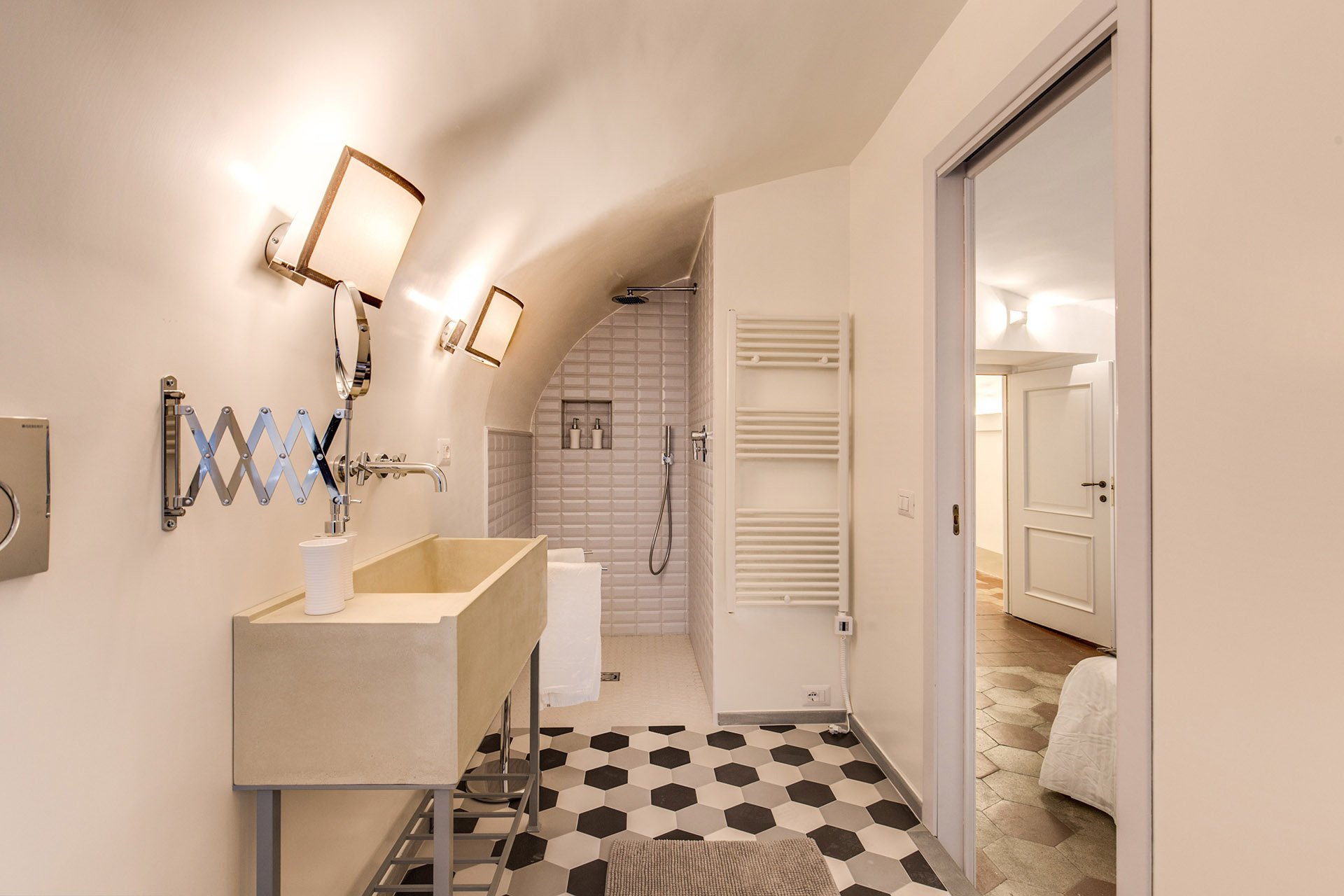 The tub was replaced with a shower.
The tub was replaced with a shower. 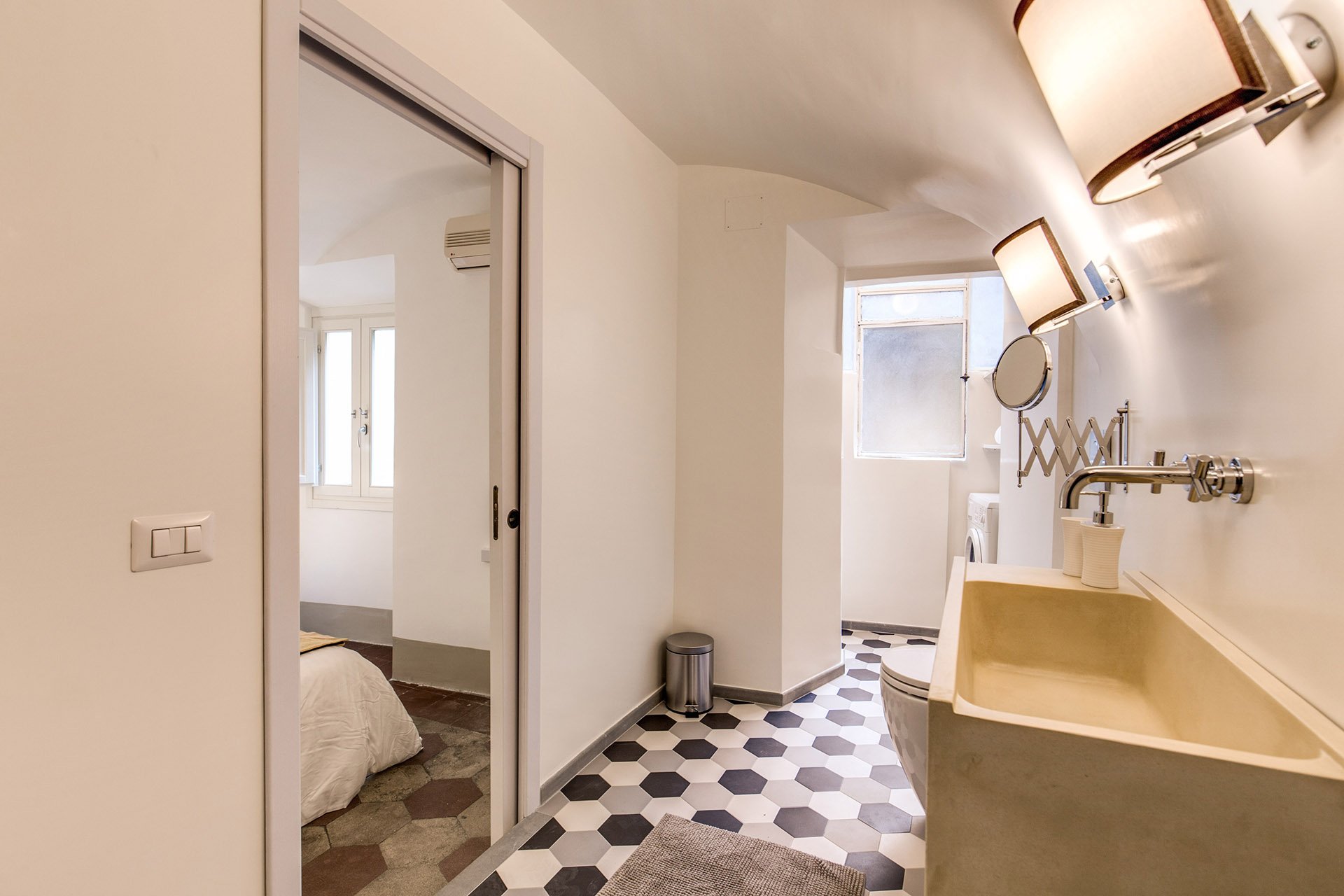 We decided to go with a combination bidet and toilet, which is great for small spaces. The client wanted a unique sink. We ordered these (which were quite heavy, our poor contractor) and asked our blacksmith to build the bases.Notice, we didn't put tiles on the walls. Similar to the Tuscany Project, we wanted the bathrooms to feel more like a room and less clinical. For a busy family bathroom this option could be impractical but I really like how these rooms feel without tiled walls.The design of the new tiles mimics the original tiled floors in the rest of the apartment. While these colors look great together, installing three colors is a different story. Complicated.
We decided to go with a combination bidet and toilet, which is great for small spaces. The client wanted a unique sink. We ordered these (which were quite heavy, our poor contractor) and asked our blacksmith to build the bases.Notice, we didn't put tiles on the walls. Similar to the Tuscany Project, we wanted the bathrooms to feel more like a room and less clinical. For a busy family bathroom this option could be impractical but I really like how these rooms feel without tiled walls.The design of the new tiles mimics the original tiled floors in the rest of the apartment. While these colors look great together, installing three colors is a different story. Complicated.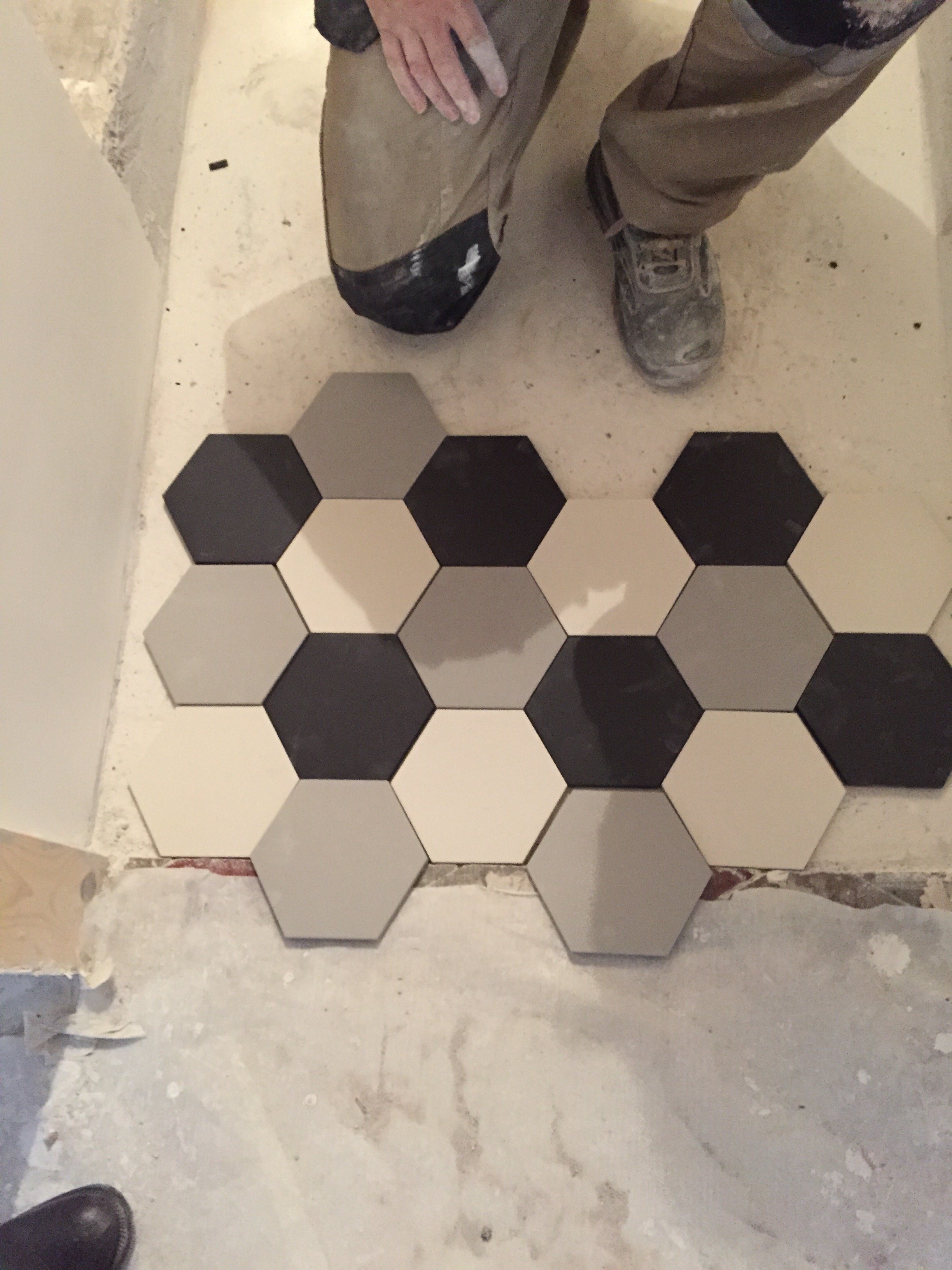 The tiles, sink, and all hardware were purchased at LOZZI.The sconces are custom. Il Paralume.Paint is a custom color from Crown.In the bedroom we added a pocket door, a built-in closet, and the lampshades are custom from Il Paralume.
The tiles, sink, and all hardware were purchased at LOZZI.The sconces are custom. Il Paralume.Paint is a custom color from Crown.In the bedroom we added a pocket door, a built-in closet, and the lampshades are custom from Il Paralume.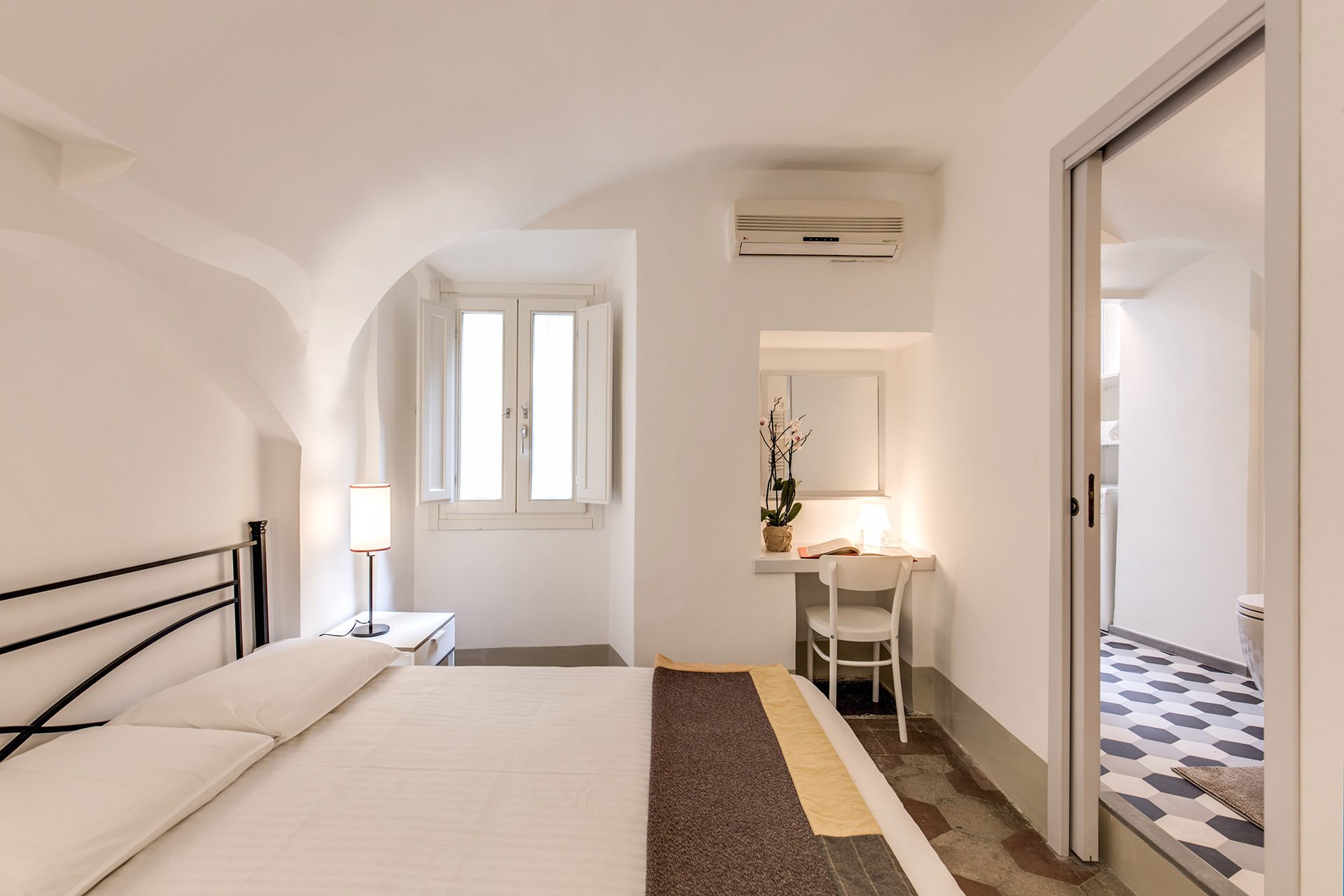 Our carpenter also created a desk in the corner.
Our carpenter also created a desk in the corner. BEFORE - Second bathroom.Extremely tight space, dated tiles. The layout was terrible and the room very dark.
BEFORE - Second bathroom.Extremely tight space, dated tiles. The layout was terrible and the room very dark.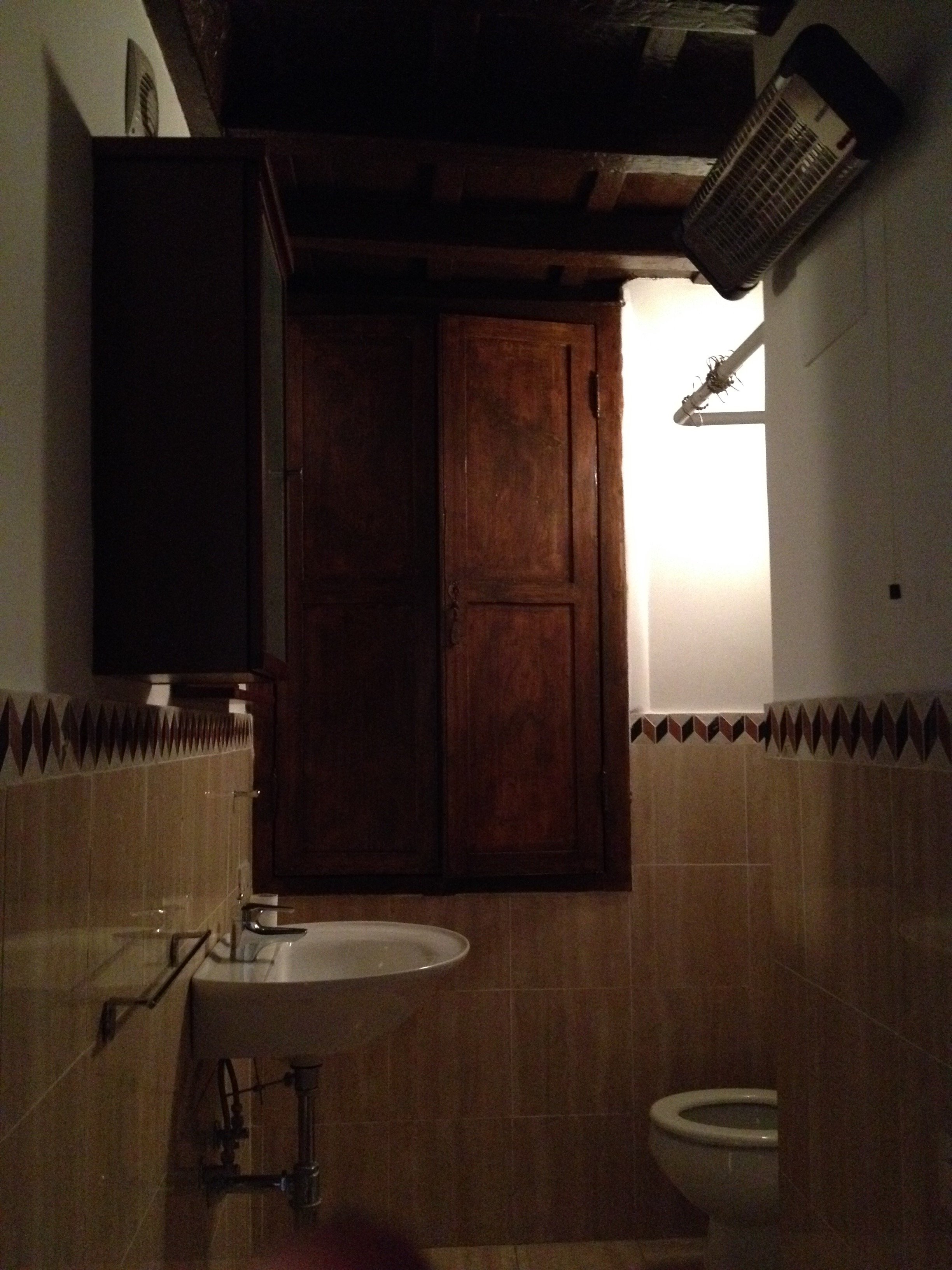 AFTERWe completely changed the layout. We moved the entrance which enabled us to add space for a proper shower.The door is custom made by our carpenter. Door fixtures are from Handles.
AFTERWe completely changed the layout. We moved the entrance which enabled us to add space for a proper shower.The door is custom made by our carpenter. Door fixtures are from Handles. Here's a better shot of the sink with the custom iron base. As with the other bathroom, we bought a combination bidet and toilet.
Here's a better shot of the sink with the custom iron base. As with the other bathroom, we bought a combination bidet and toilet. BEFORE - Living Room
BEFORE - Living Room AFTER - Living Room
AFTER - Living Room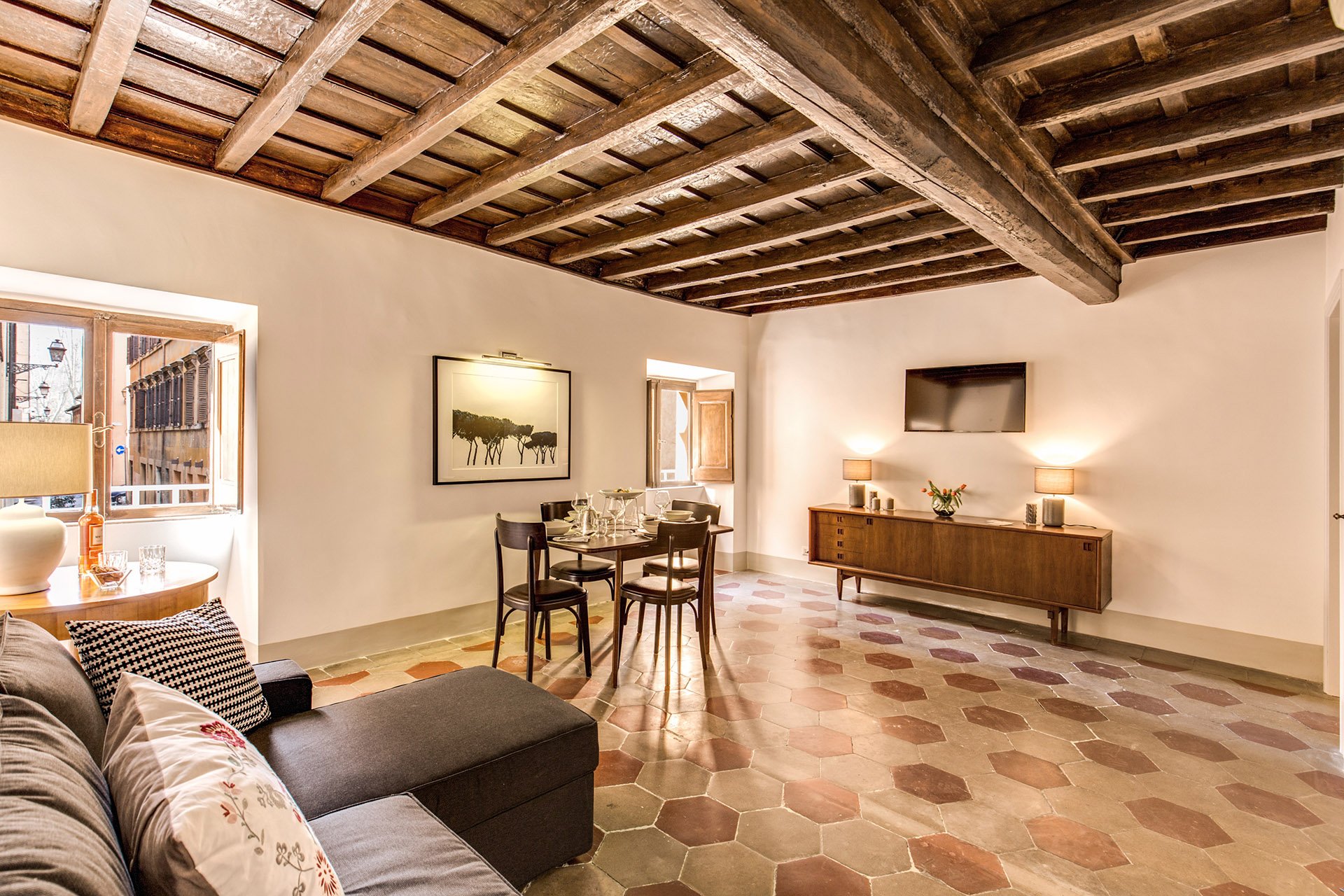 The fantastic artwork is from Due Alberi. They're based in Rome but ship internationally.Our carpenter added new closets.The dining table is from MADE and the chairs belong to the client.
The fantastic artwork is from Due Alberi. They're based in Rome but ship internationally.Our carpenter added new closets.The dining table is from MADE and the chairs belong to the client. The side table came from the Via Monserrato apartment. We found the lamp at Leroy Merlin (the French version of Home Depot).
The side table came from the Via Monserrato apartment. We found the lamp at Leroy Merlin (the French version of Home Depot).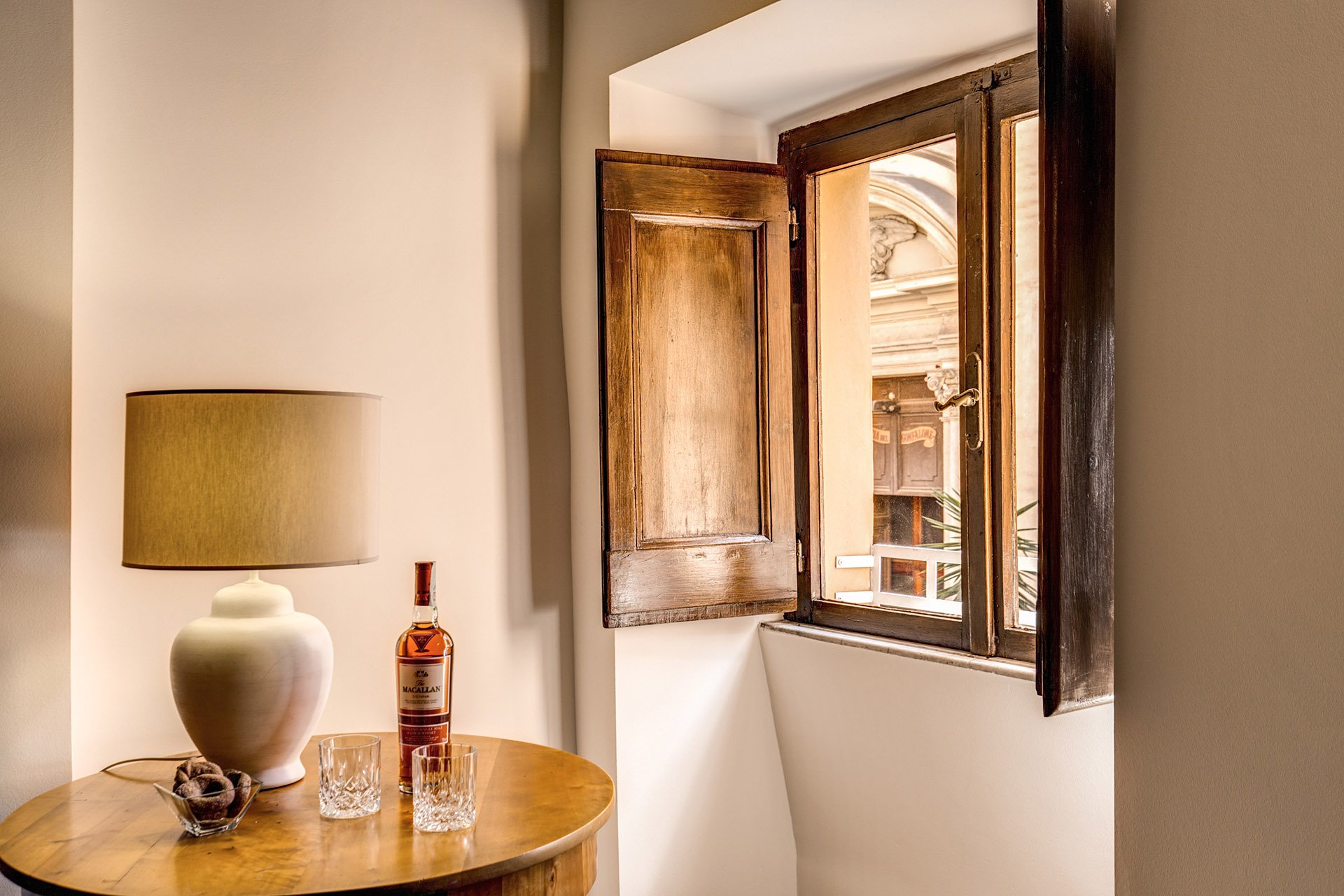 The client found the credenza online. The lamps were a great find at Leroy Merlin. We were so tired and hungry. My client was worried about my mental health as we had just spent hours at the IKEA next door. I perked up when I saw the lamps on a bottom shelf. I was so excited. It was like meeting Idris Elba.
The client found the credenza online. The lamps were a great find at Leroy Merlin. We were so tired and hungry. My client was worried about my mental health as we had just spent hours at the IKEA next door. I perked up when I saw the lamps on a bottom shelf. I was so excited. It was like meeting Idris Elba. Overall, the apartment feels lighter despite the lack of light (the windows are tiny). The renovated kitchen and bathrooms compliment the style and architecture of the apartment. We updated them but without losing the charm.We kept the palette very simple, creamy whites, grey, black, with a touch of red. The ceiling seems higher and apartment looks/feels bigger.For more information about this vacation rental, please check out Your Suite Rome on Booking.com.Architect: Domenico MinchilliAfter Photos: Vincenzo Tambasco
Overall, the apartment feels lighter despite the lack of light (the windows are tiny). The renovated kitchen and bathrooms compliment the style and architecture of the apartment. We updated them but without losing the charm.We kept the palette very simple, creamy whites, grey, black, with a touch of red. The ceiling seems higher and apartment looks/feels bigger.For more information about this vacation rental, please check out Your Suite Rome on Booking.com.Architect: Domenico MinchilliAfter Photos: Vincenzo Tambasco
Art and Architecture with Ariella - Contemporary Art in Rome
Ciao Bloggisti,Here is the latest post from Ariella:Over the past few months I have explored art in Rome from a historical point of view, as well as its current and future purpose. While Rome is known for masterpieces by some of the world's greatest artists such as Michaelangelo, Caravaggio, and many others; the city has a vibrant contemporary art culture as well.Art and architecture in Rome is always present. We travel though it everyday, sit in its' spaces, it creates views and vistas and reminds us of the past while providing the setting for the future.Rome functions like a gallery. We circulated much in the same way we travel through a space designed for art. The city has made a concerted effort to integrate contemporary art and modern life with the construction of new museums. These spaces house newer collections and also facilitate the experience of promoting the collaboration between art, architecture, and everyday life.The challenge of the newer buildings and space is not to interfere or interrupt "historic" Rome but rather to blend in. These new spaces have attracted many visitors and artists to the city. Artists come to Rome from all over the world seeking inspiration while many born and raised in Rome have also flourished as artists.Every week for the past few months, I have visited a new contemporary art museum, gallery, studio, or installation and I've been able to learn from the historical cultural wealth of the Rome as well as from the current vibrant scene.My past impressions of contemporary art were of paintings and pieces that were difficult to relate to, very conceptual. Contemporary art is always evolving and now quite a few artists have returned to figurative painting/works.The collaboration reflected in exhibits, events, and installations have shaped the contemporary art world in Rome.I asked Ariella for a list of some of her favorite contemporary art museums and galleries.Museums:MACROMAXXI  Galleries:Anna Marra ContemporaneaT293Galleria VarsiGalleria Valentina BonomoI'm adding one of my favorites to her list, Galleria Lorcan O'Neill. Ariella mentioned two other spaces. They're not galleries or museums but display contemporary art.MOMA Hostel - a hostel run by artists.MAAM - this space has living quarters for homeless families. The families live with the art. When Ariella went to visit, one of the pieces had a dent in it because the children used it as a soccer/football goal post. I went to a street art exhibit there and thought it was one of the most interesting venues for art in Rome.
Galleries:Anna Marra ContemporaneaT293Galleria VarsiGalleria Valentina BonomoI'm adding one of my favorites to her list, Galleria Lorcan O'Neill. Ariella mentioned two other spaces. They're not galleries or museums but display contemporary art.MOMA Hostel - a hostel run by artists.MAAM - this space has living quarters for homeless families. The families live with the art. When Ariella went to visit, one of the pieces had a dent in it because the children used it as a soccer/football goal post. I went to a street art exhibit there and thought it was one of the most interesting venues for art in Rome.
Life in Rome - Day Trip to Spoleto
Ciao Bloggisti,Friends of mine recently bought a weekend place in Spoleto and invited me up for a day. It's about forty miles south east of Perugia.It was my first trip to Spoleto and I highly recommend a visit. The Historic Center is very charming with incredible views. I took a lot of photos. Below are a few.Ponte delle Torri - a 13th century aqueduct.One of the highlights for me. Next time I will bring a pair of sneakers or hiking shoes so I could walk further up the trail.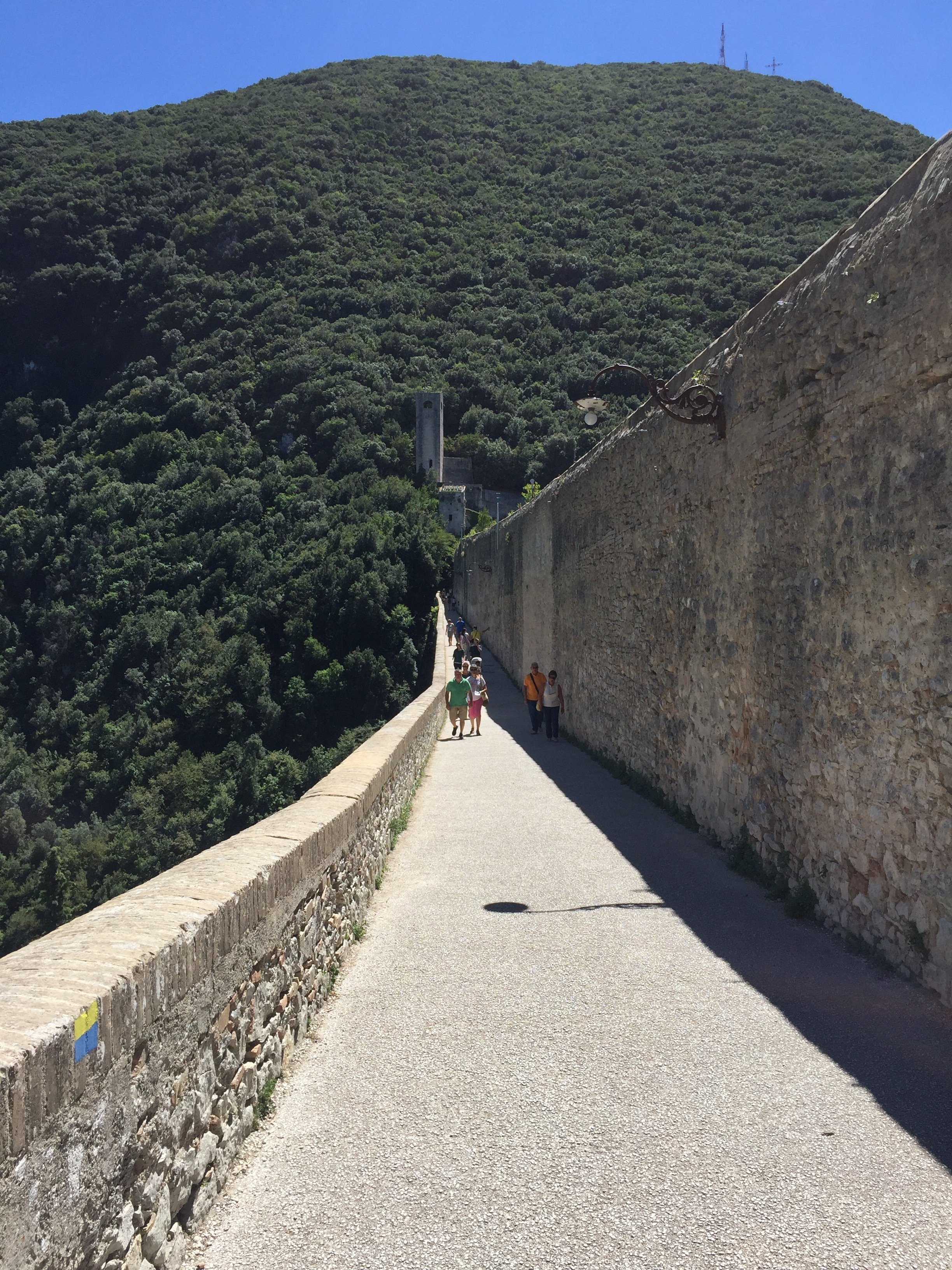
 The Duomo - Santa Maria Assunta
The Duomo - Santa Maria Assunta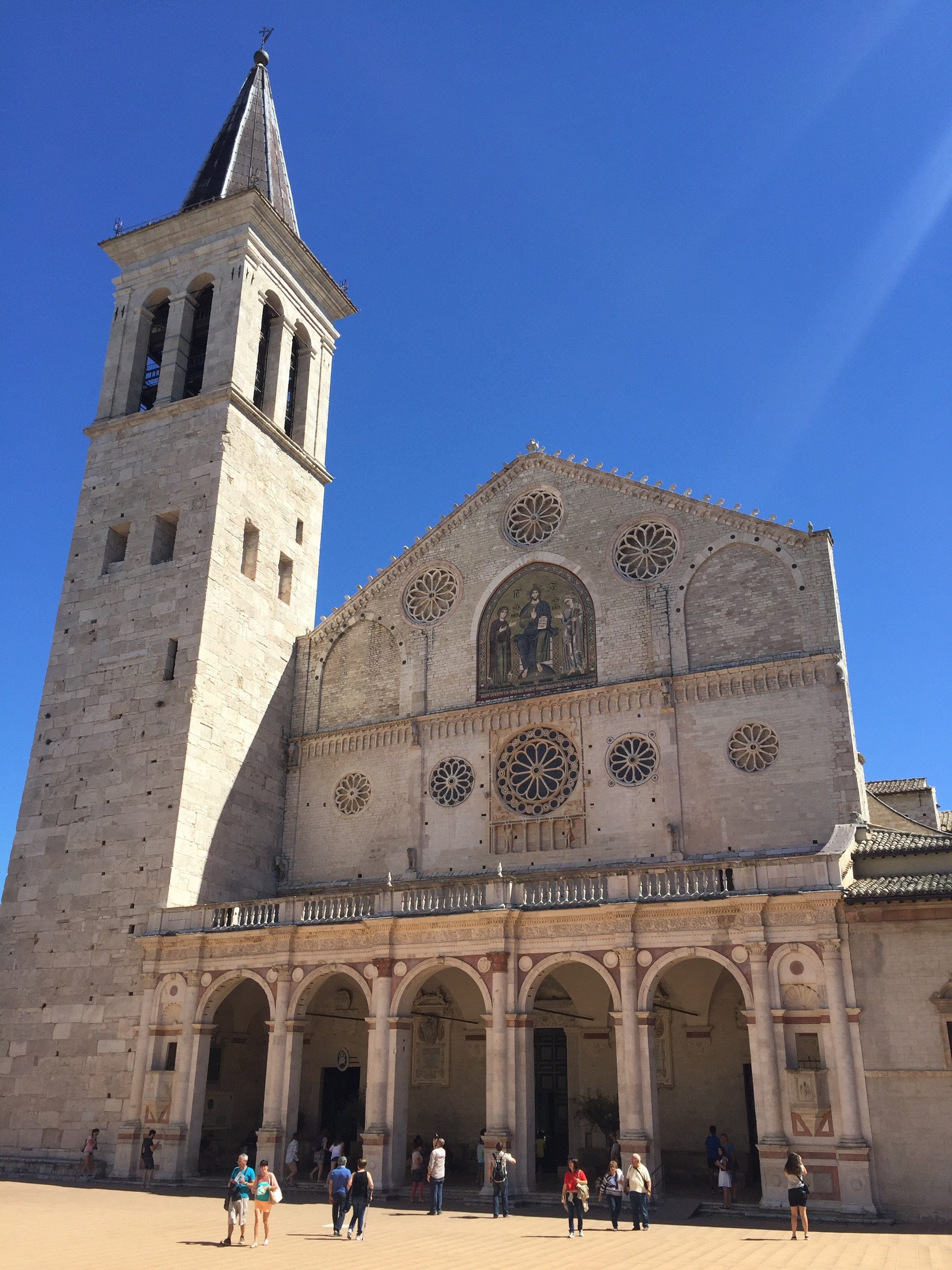

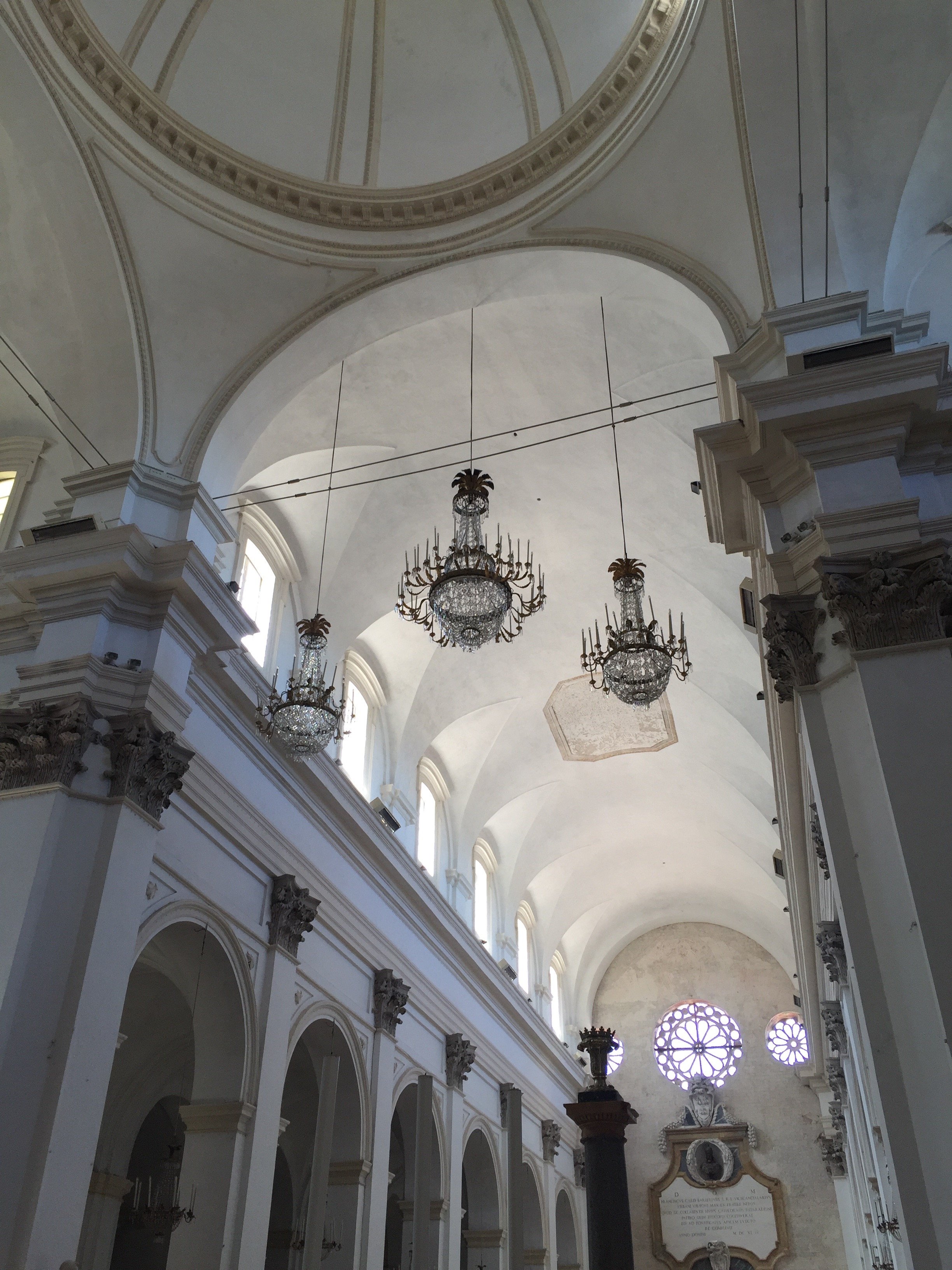
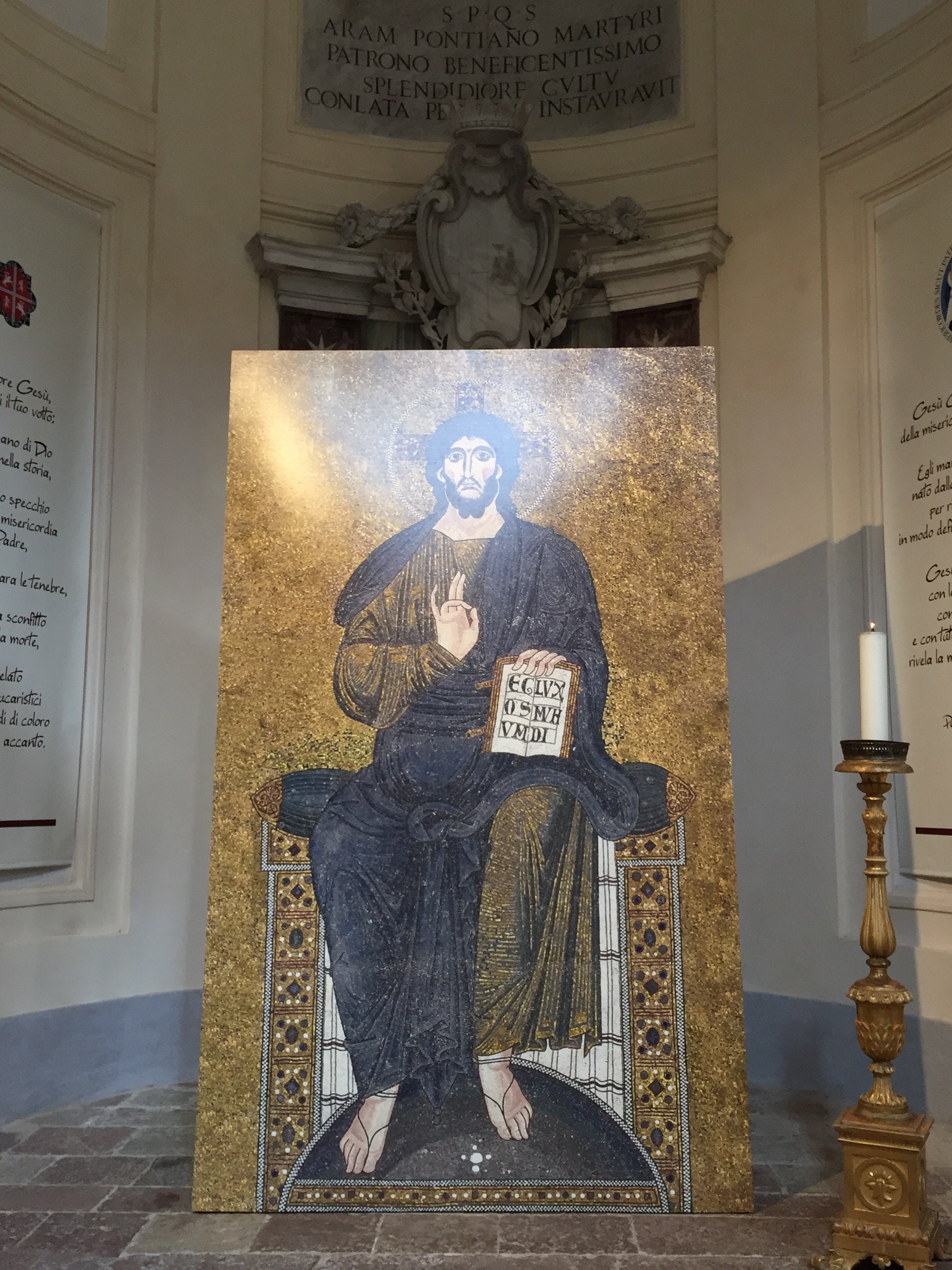
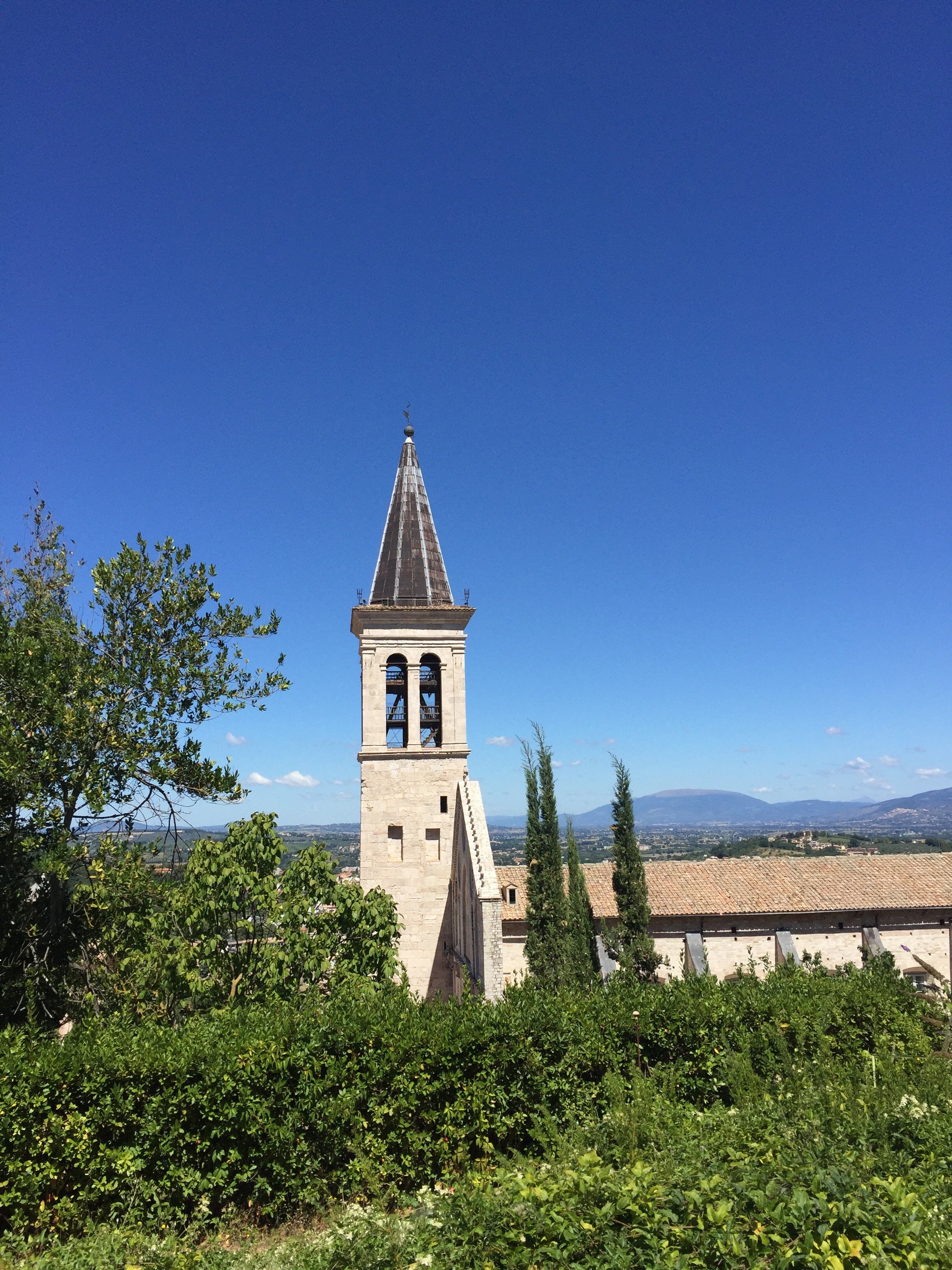 More pictures of the Historic Center.
More pictures of the Historic Center.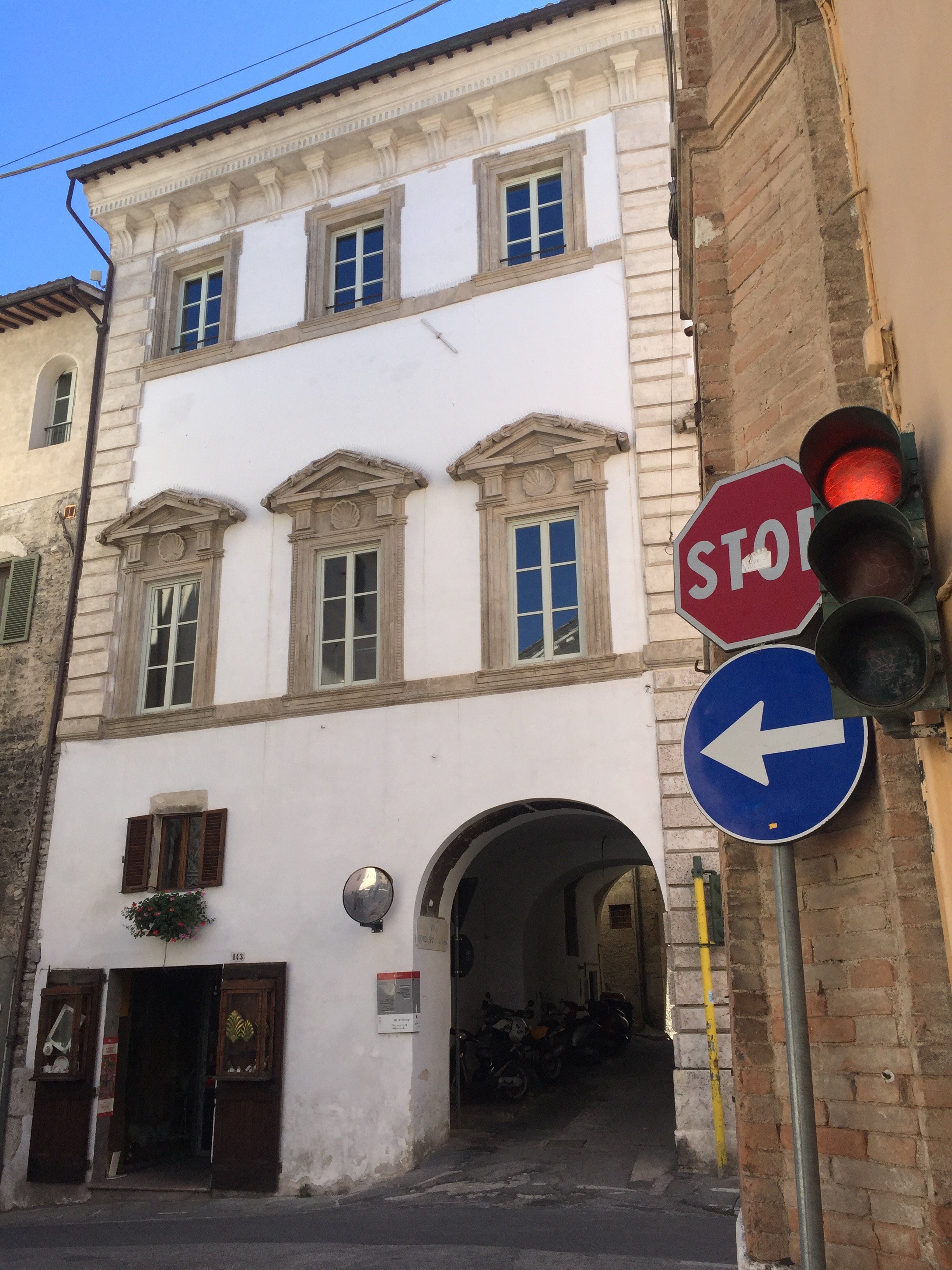
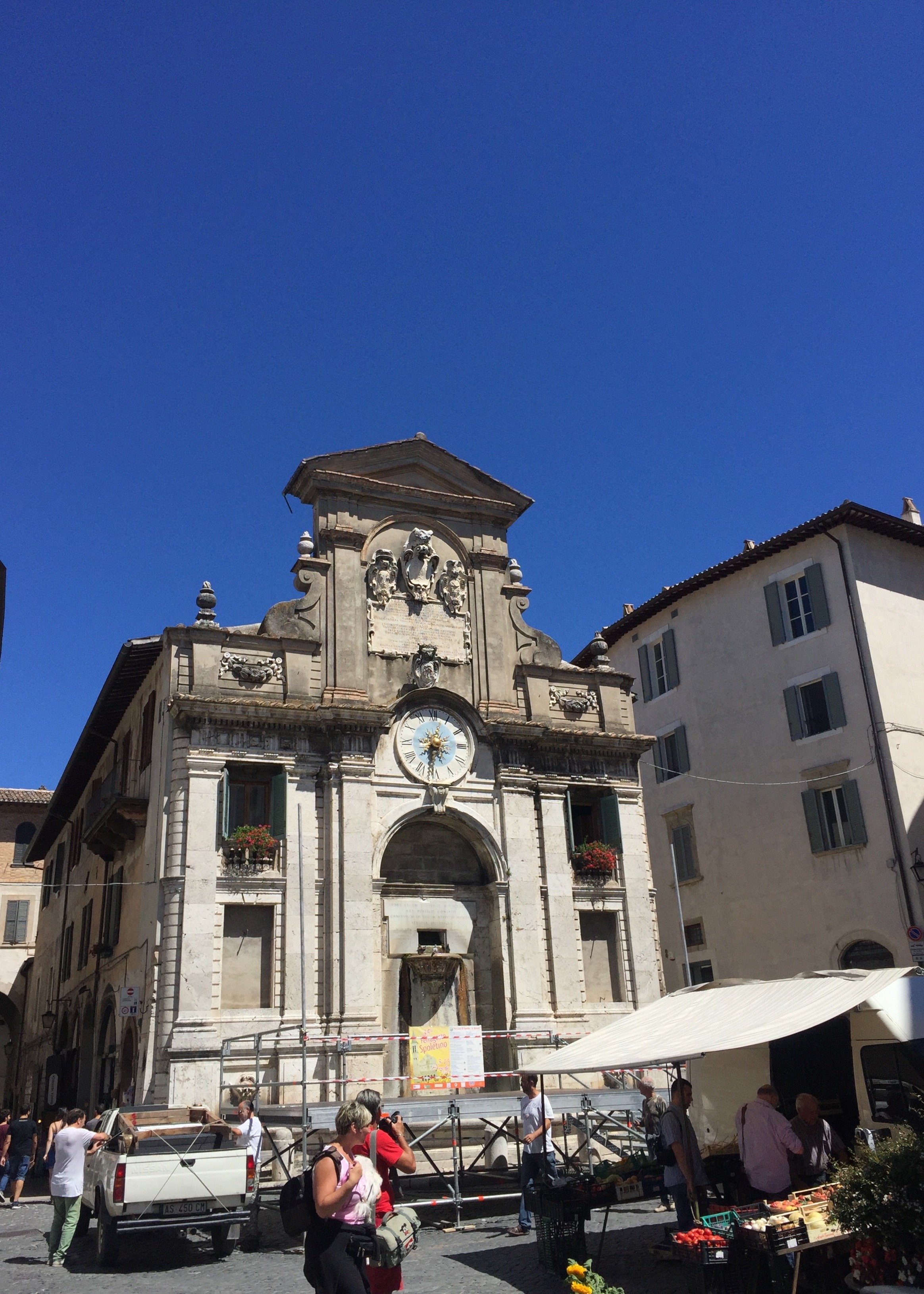
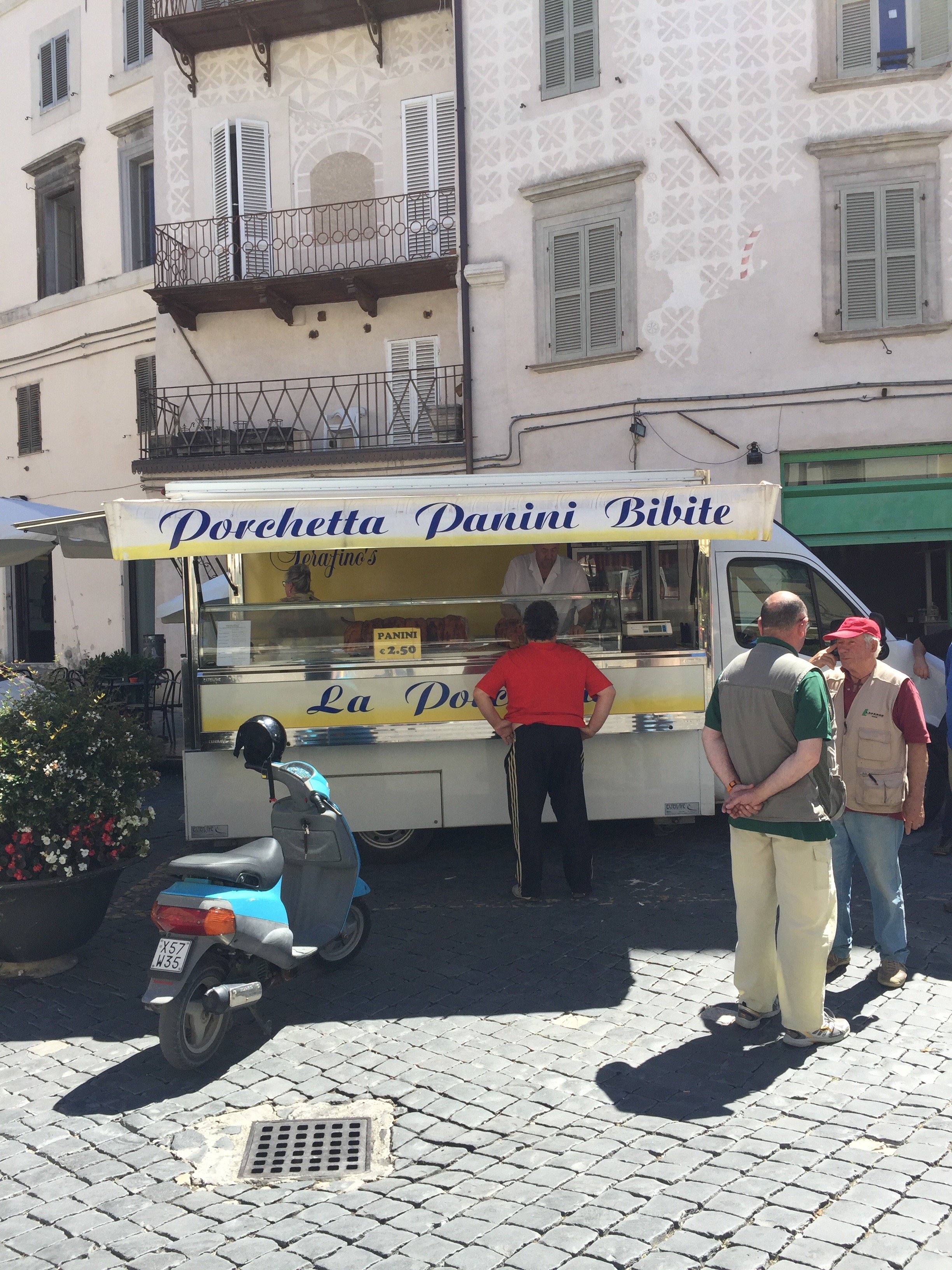 Basilica di Santa Gregorio Maggiore - consecrated in 1146.
Basilica di Santa Gregorio Maggiore - consecrated in 1146.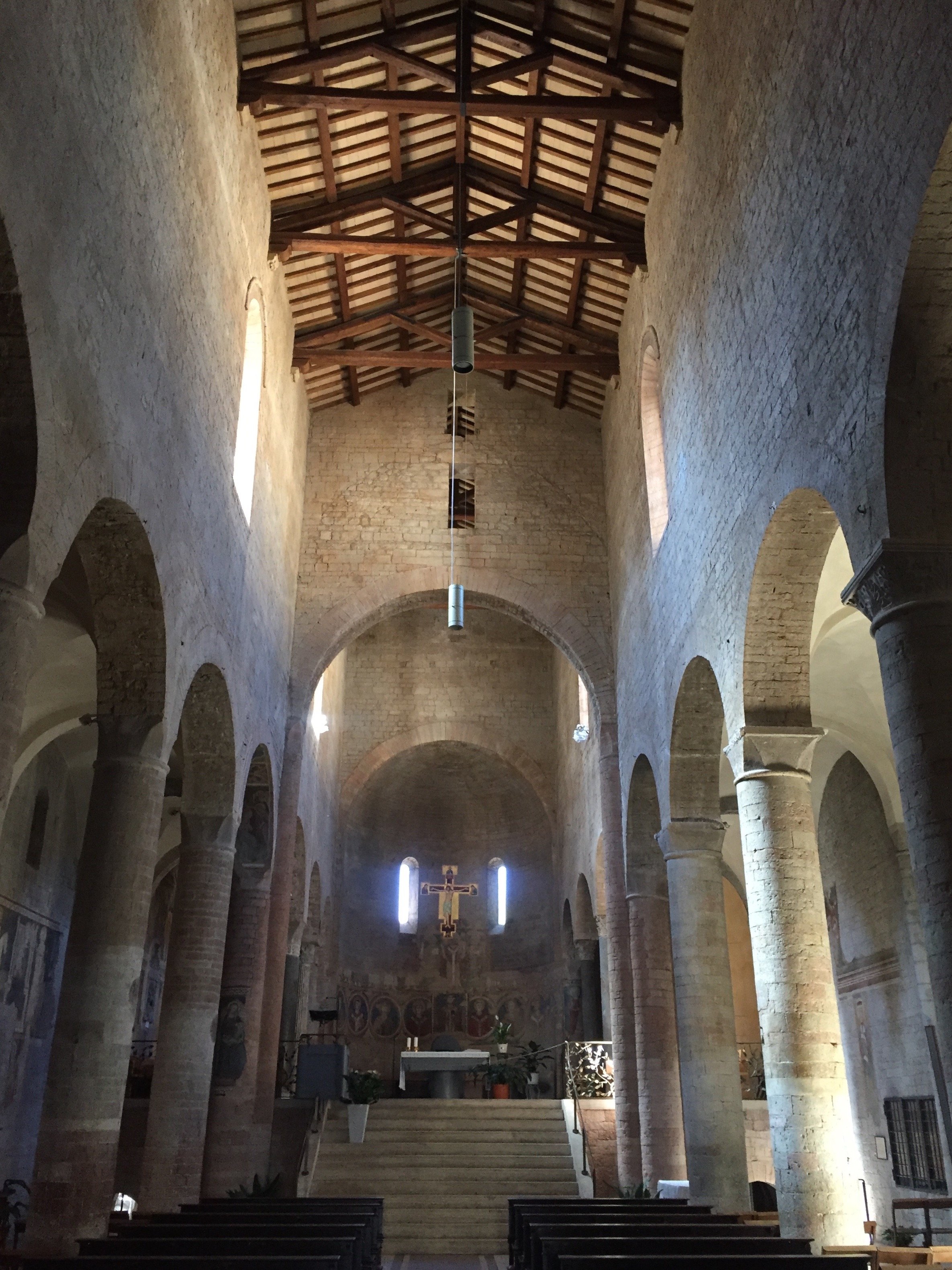
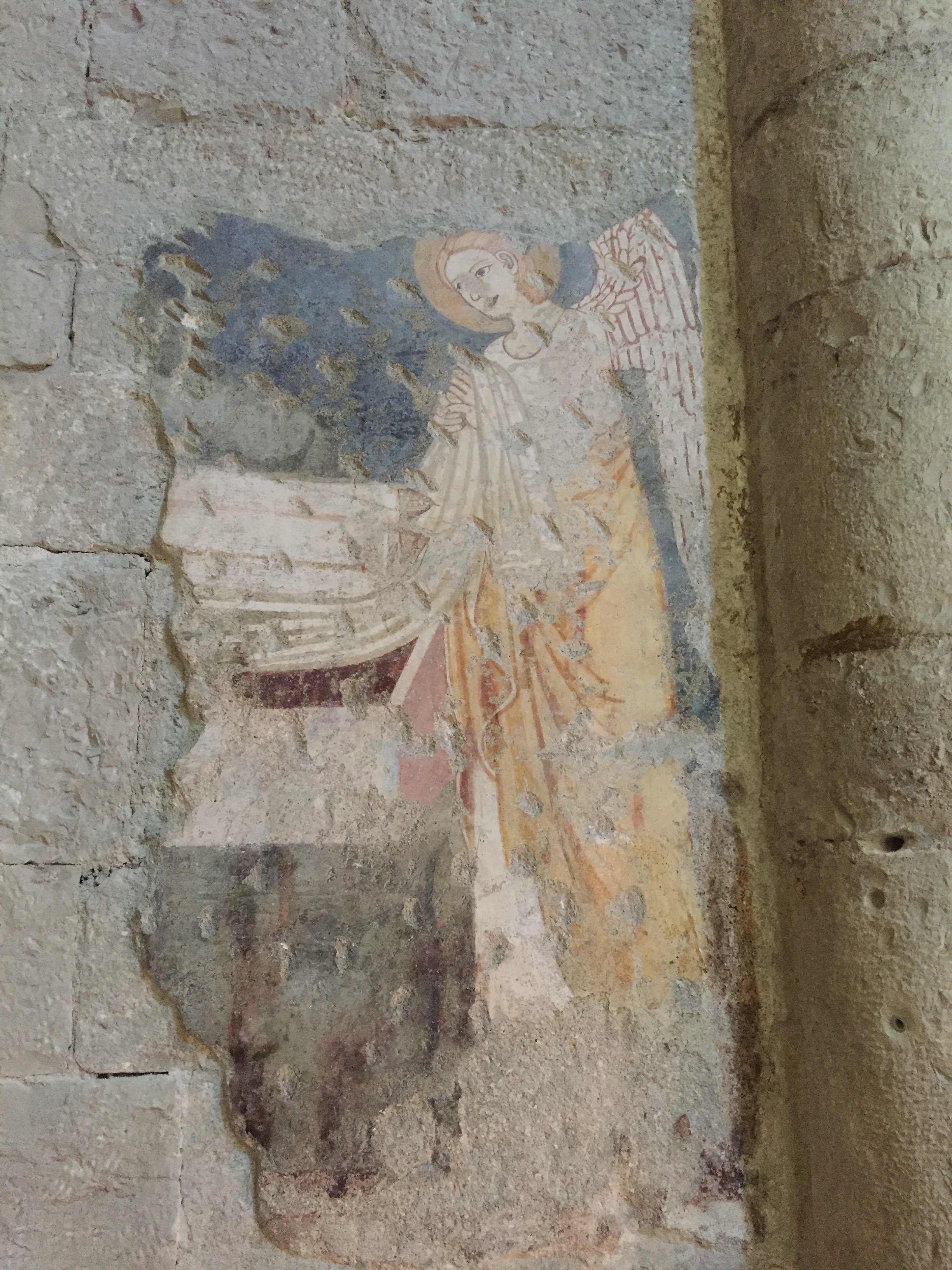
 Note: This is not a politics blog but the US election last week was not normal.The President Elect would like to commute to the White House, staying mostly in Trump Tower. I was not aware that being President of the most powerful country on the planet was a part-time gig. This would create a major logistical nightmare for the Secret Service and the NYPD. It would also be a headache for residents of the building and the surrounding area as blocks of a major street (5th Avenue) would have to be shut down.There's a silver lining. Trump may not have time or the desire to redecorate the White House. I was thinking of writing a separate post about this space:
Note: This is not a politics blog but the US election last week was not normal.The President Elect would like to commute to the White House, staying mostly in Trump Tower. I was not aware that being President of the most powerful country on the planet was a part-time gig. This would create a major logistical nightmare for the Secret Service and the NYPD. It would also be a headache for residents of the building and the surrounding area as blocks of a major street (5th Avenue) would have to be shut down.There's a silver lining. Trump may not have time or the desire to redecorate the White House. I was thinking of writing a separate post about this space: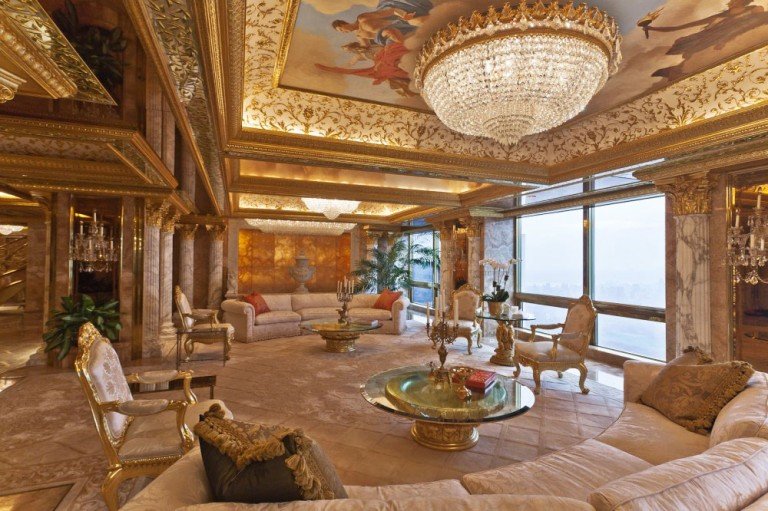 SpoletoPhotos: Me and my iPhone Trump Living Room: iDesignArch
SpoletoPhotos: Me and my iPhone Trump Living Room: iDesignArch
Art and Architecture with Ariella - Amsterdam
Ciao Bloggisti,Here is the latest post from our intern, Ariella:Last week my classmates and I went to Amsterdam. My impression of the city upon arriving was very different to my expectations. The architecture reflects its history and age, serving as a unique backdrop for modern, urban life.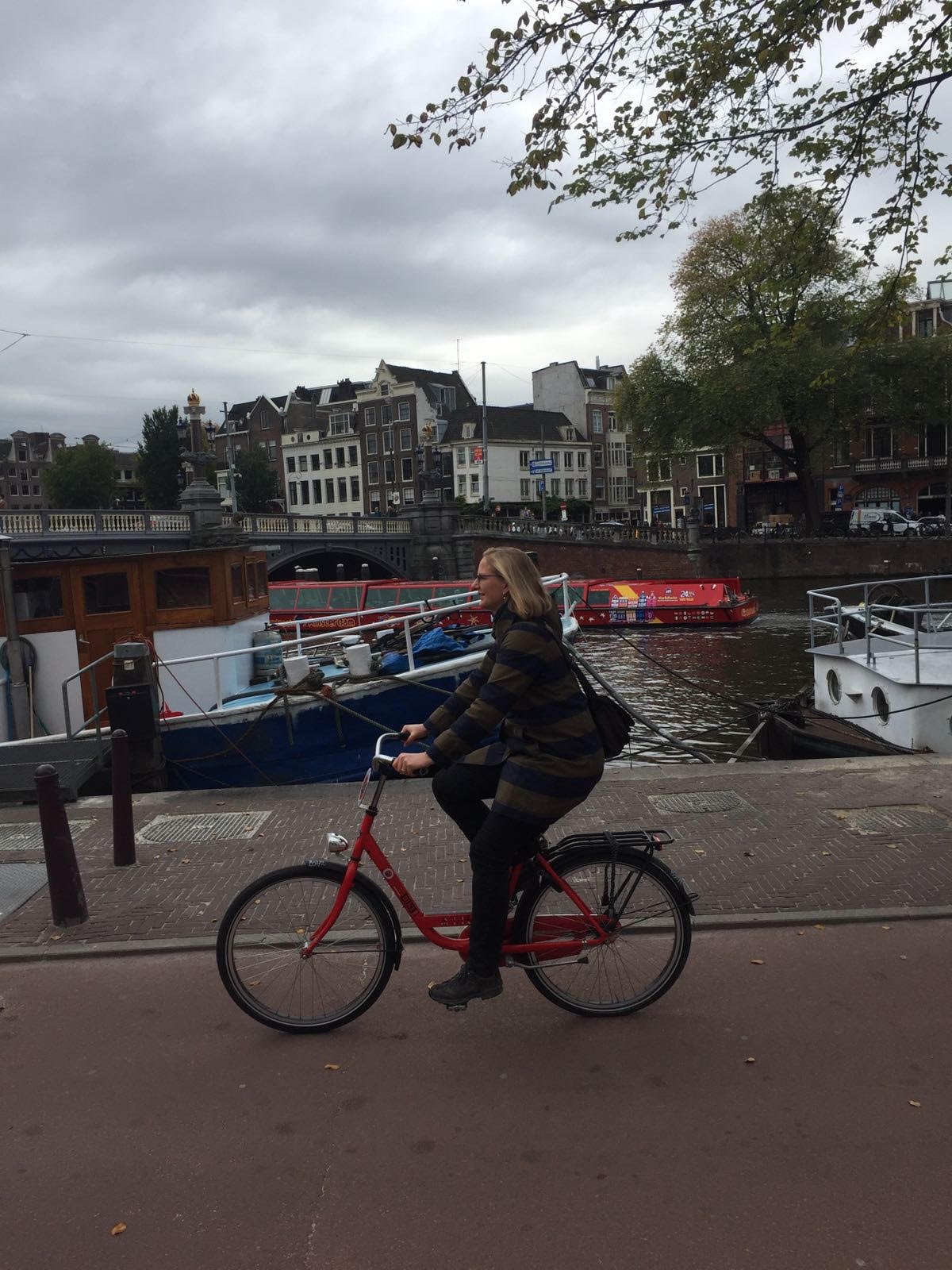 I had preconceived notions of what the relatively “young” culture/community of Amsterdam was like. While Amsterdam really is a young and vibrant city, we soon found out how the existing architectural exteriors are not allowed to change. There’s a strict limit on the height of buildings in order to preserve the density and aesthetic “look” of Amsterdam. This also gives the city the character of feeling small, manageable, and almost village like, easy to get around. We saw many bikers traveling through its beautiful streets, even during peak rush hour time. Amsterdam is very livable and feels “alive” with its diverse multicultural population whose art and ideas you see splashed all about town; on the walls, in the alleyways, in fairs and in performances.
I had preconceived notions of what the relatively “young” culture/community of Amsterdam was like. While Amsterdam really is a young and vibrant city, we soon found out how the existing architectural exteriors are not allowed to change. There’s a strict limit on the height of buildings in order to preserve the density and aesthetic “look” of Amsterdam. This also gives the city the character of feeling small, manageable, and almost village like, easy to get around. We saw many bikers traveling through its beautiful streets, even during peak rush hour time. Amsterdam is very livable and feels “alive” with its diverse multicultural population whose art and ideas you see splashed all about town; on the walls, in the alleyways, in fairs and in performances. 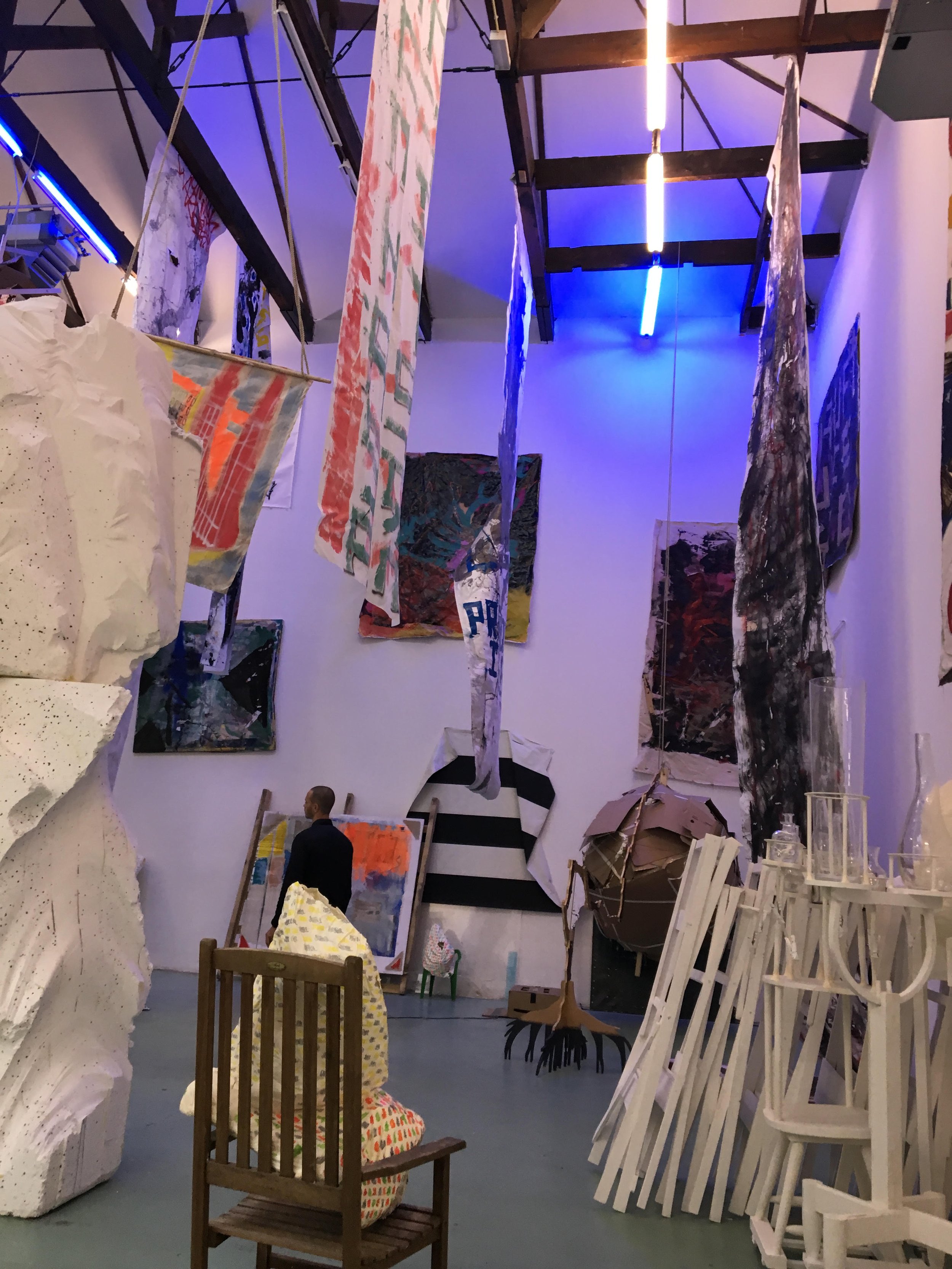 Amsterdam has become a city where all the people and their original works have connected the old character of the city to the new young ideas.
Amsterdam has become a city where all the people and their original works have connected the old character of the city to the new young ideas.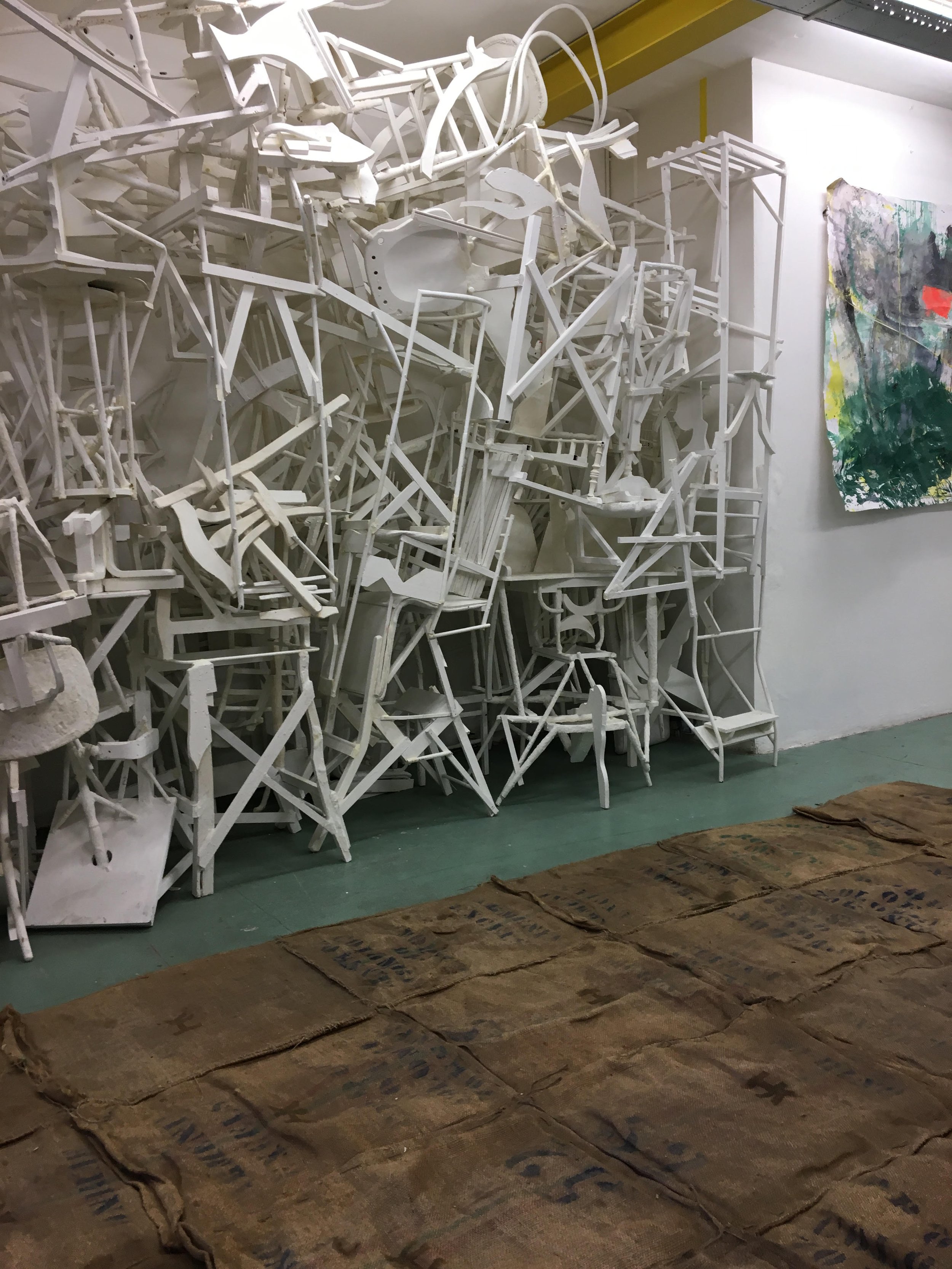
Life in Rome - Villa Farnesina
Ciao Bloggisti,Villa Farnesina has been on my "need to visit" list for quite some time. One rainy afternoon, I decided to schlep across town. It was worth the trip.This villa is one of the finest examples of Renaissance architecture. In 1509, the wealthy banker Sienese Agostino Chigi commissioned architect Baldassarre Peruzzi (who was known mostly for his paintings) to build a villa for him in the country. The villa is located just across the river in Trastevere. Back in the day, Trastevere was considered the country as it was outside the city walls. Chigi was well connected and ran in some very rarefied circles. The location was perfect for him. He was close enough to the city for business and far enough away to build a grand space to entertain his friends, which included the Pope, with lavish banquets. Chigi, while a great host, was also a huge patron of the arts.Rumor has it that Villa Farnesina was built over the ruins of the villa where Cleopatra met her lover Mark Antony for sexy times. When construction began, Chigi was in love with the infamous courtesan Imperia (supposedly she was the first woman to be called as such) but his second mistress, and later wife, Andreosia lived in the home. It's not a surprise that the theme running through the villa is love.Imperia was close to, and perhaps the lover of, the great artist Raphael. She was the model for several of the frescoes in the villa. Other painters along with Raphael and Peruzzi were, Sebastiano del Piombo, Giovanni da Udine, Giovanni Bazzi, Giulio Romano, and Giovan Francesco Penni.In 1577 the Farnese family bought Villa Farnesina. It was given this name to set it apart from the villa they owned across the river in Piazza Farnese.I hope return to Villa Farnesina during a sunny day and soak it all in. It's beautiful.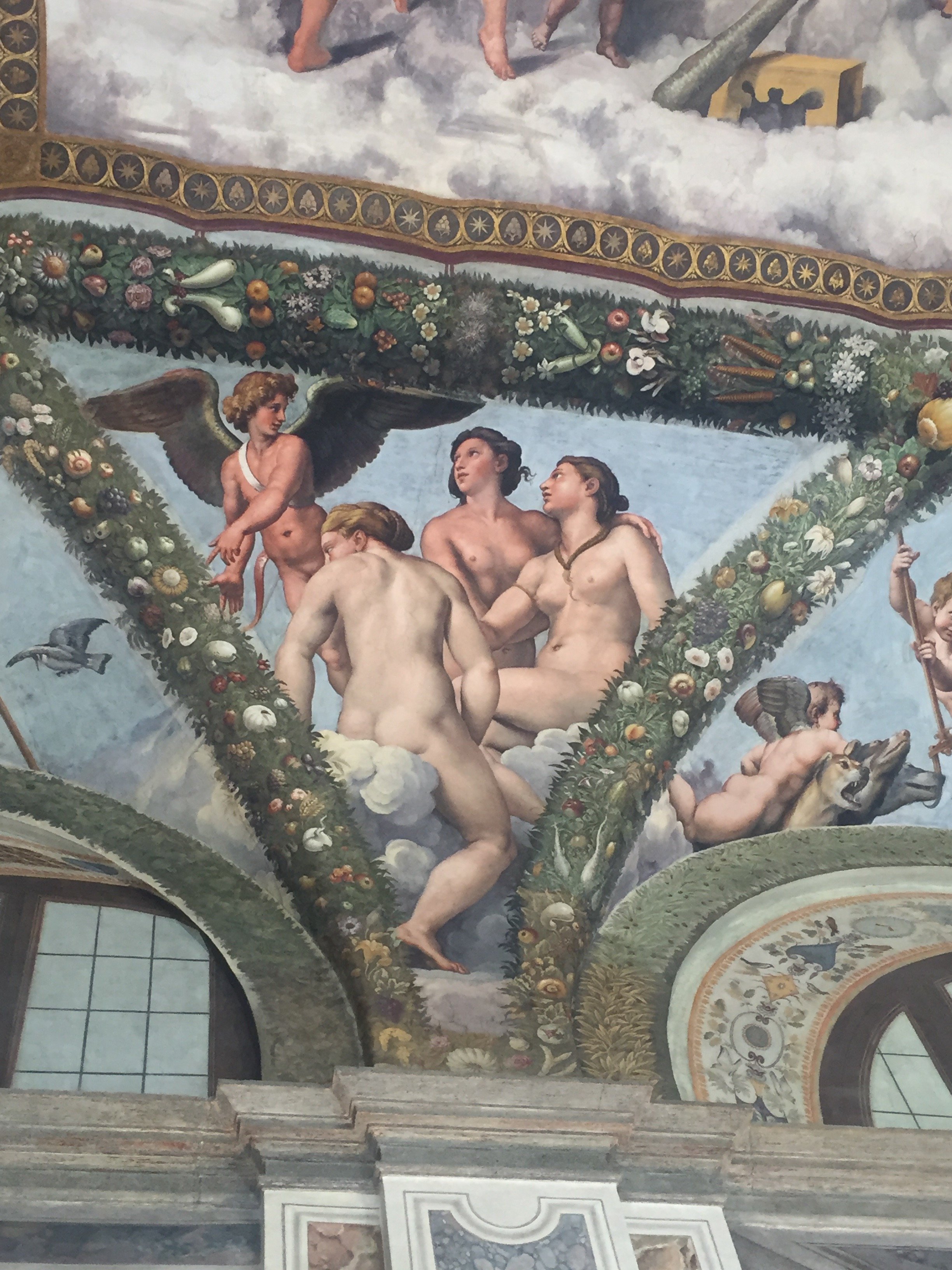
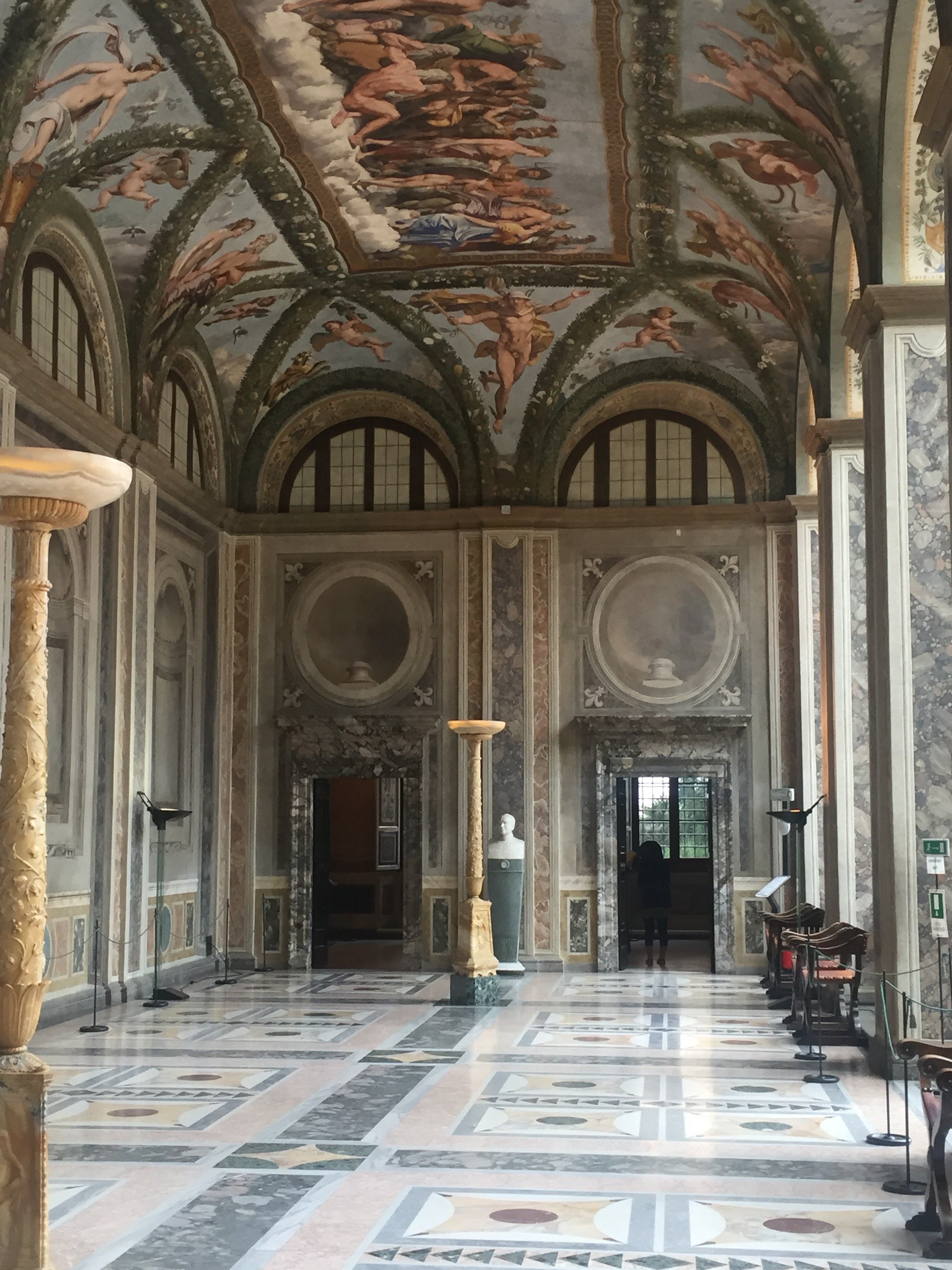
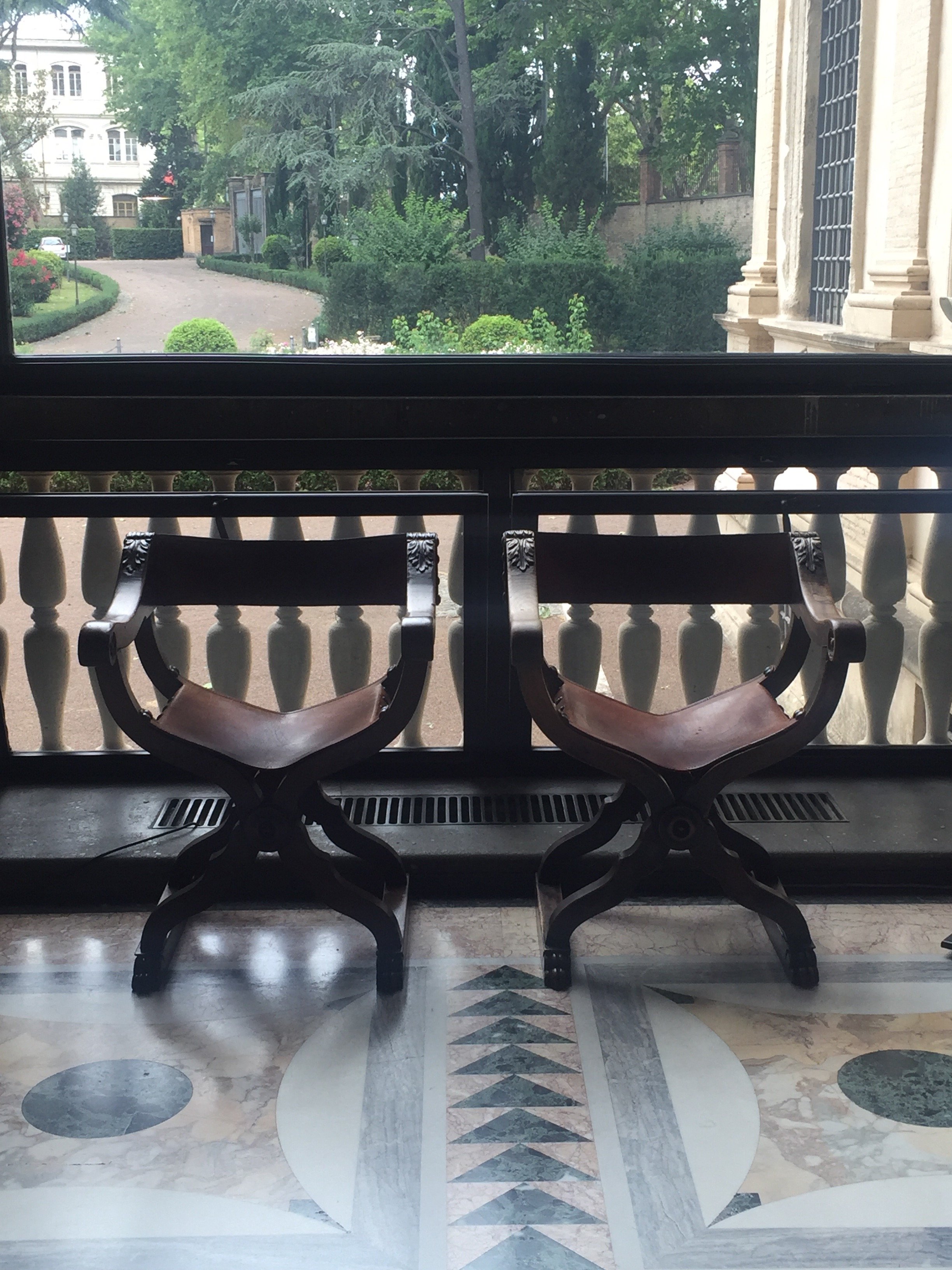
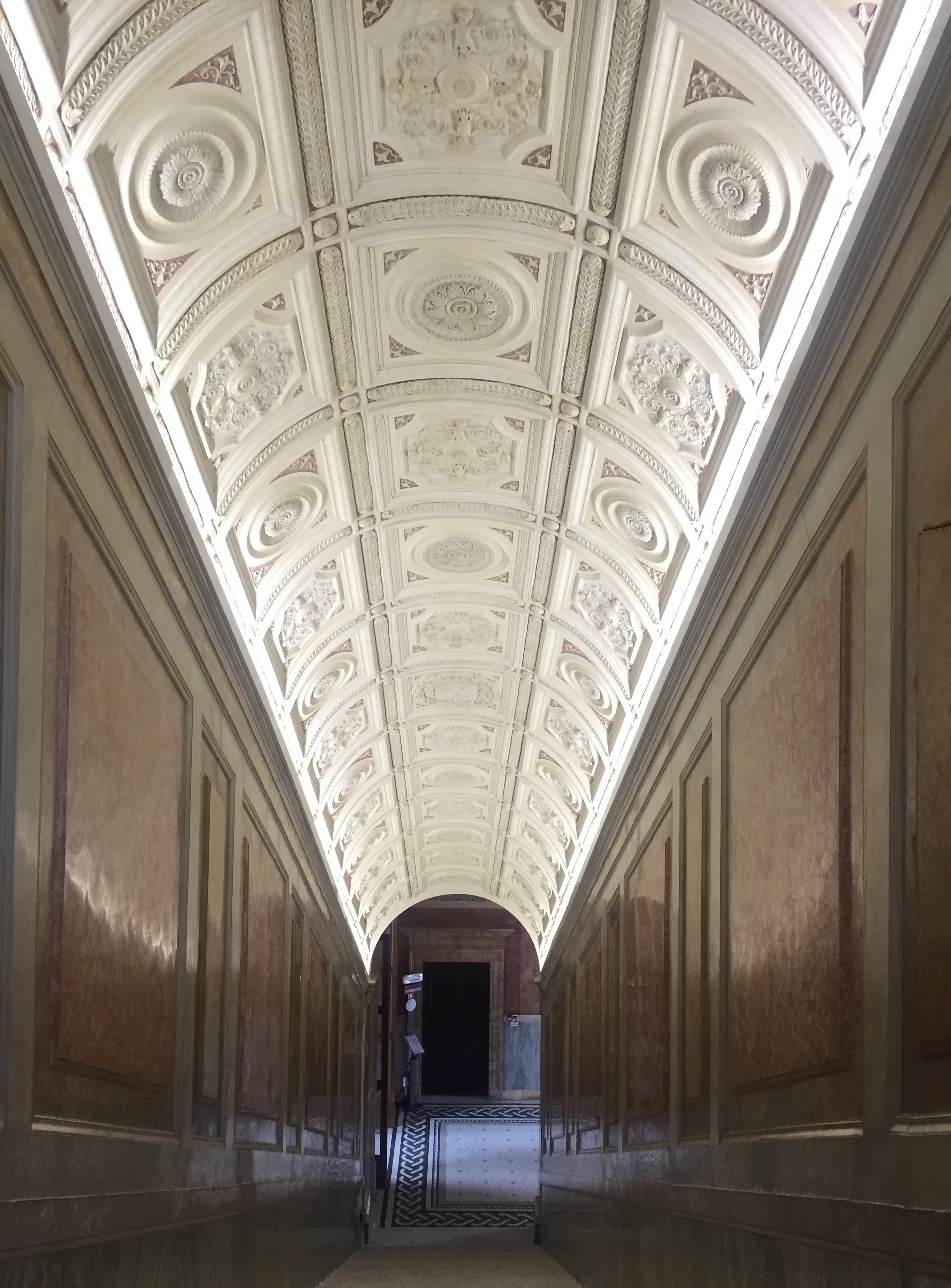
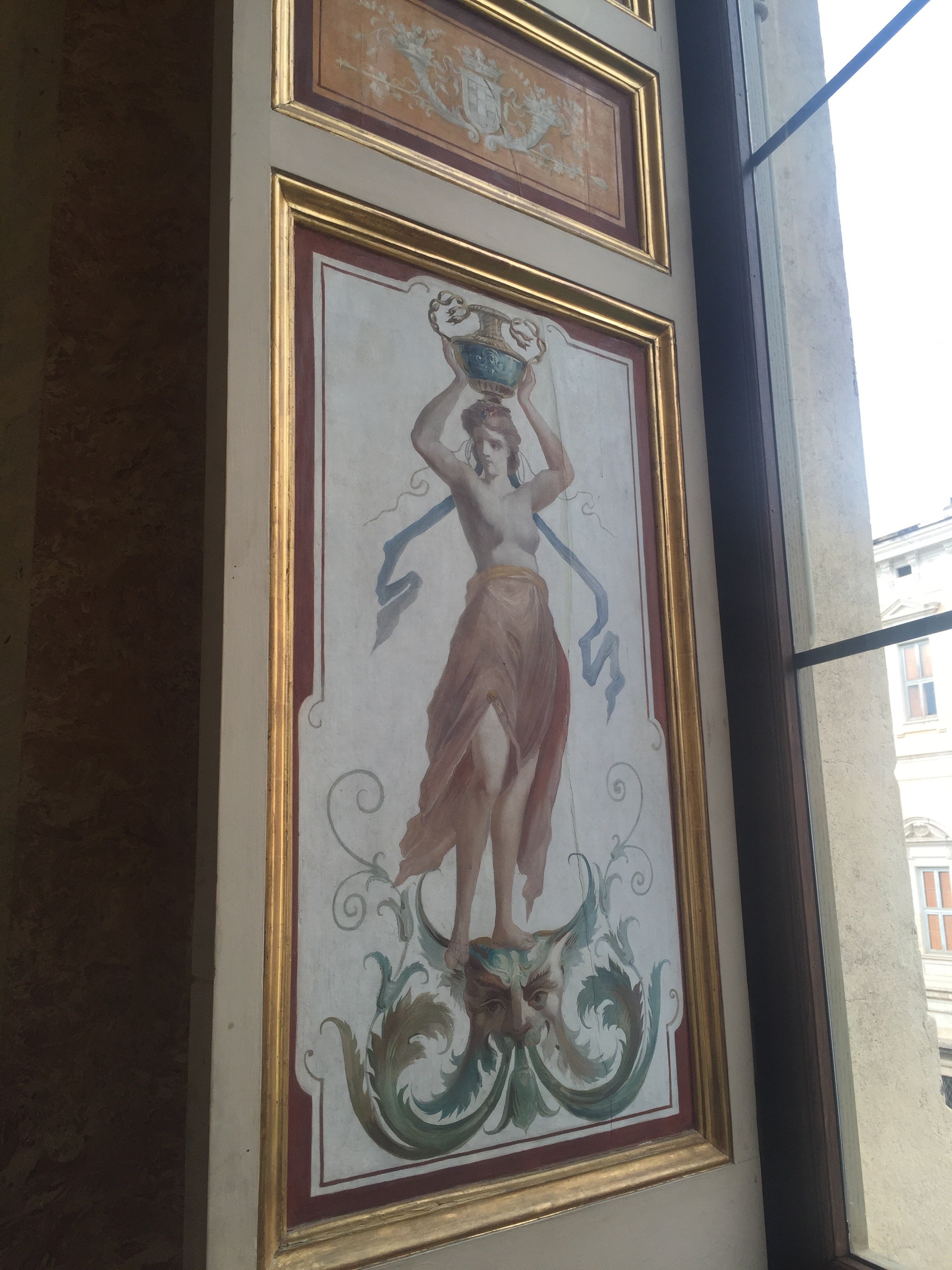
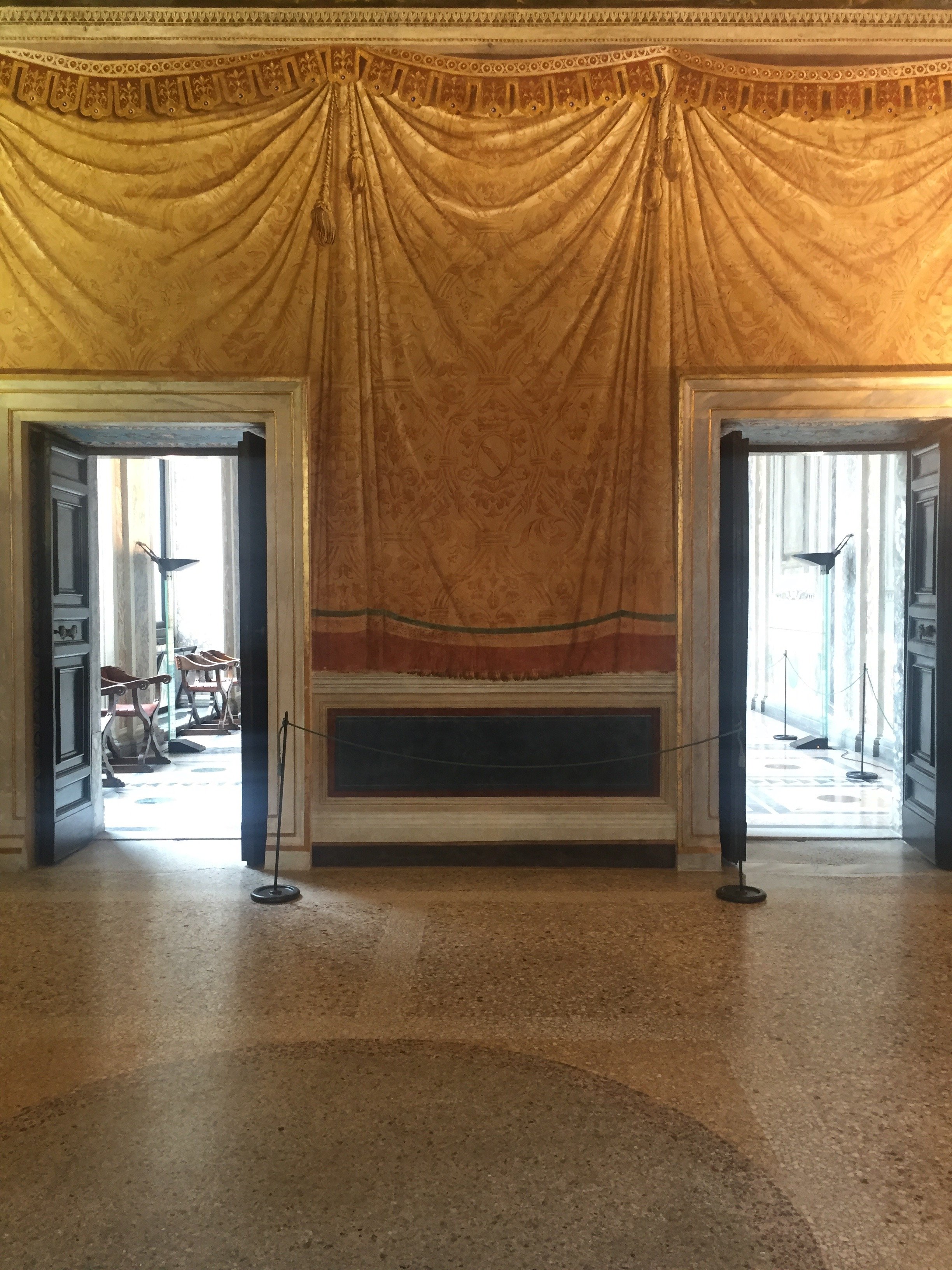
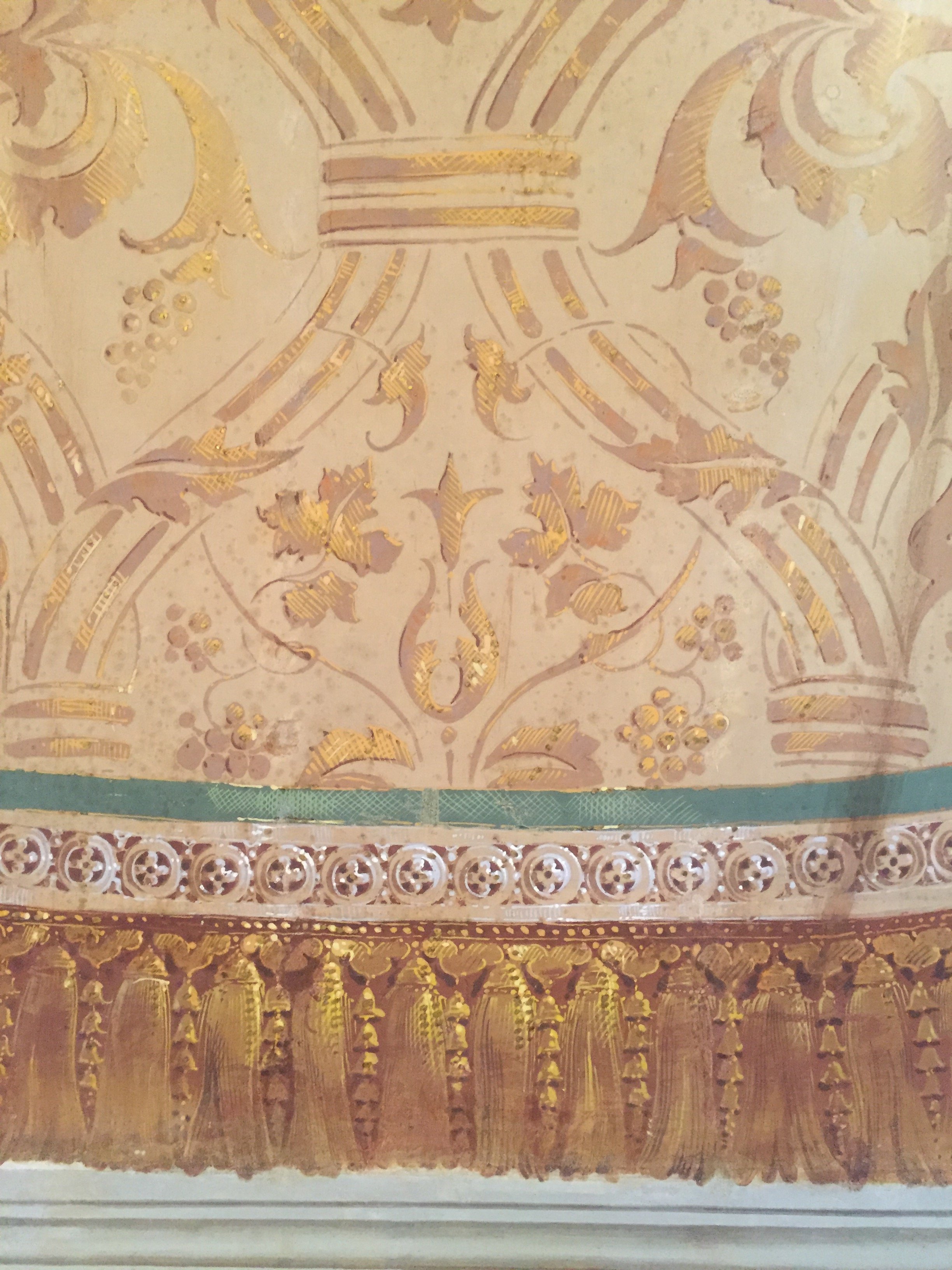
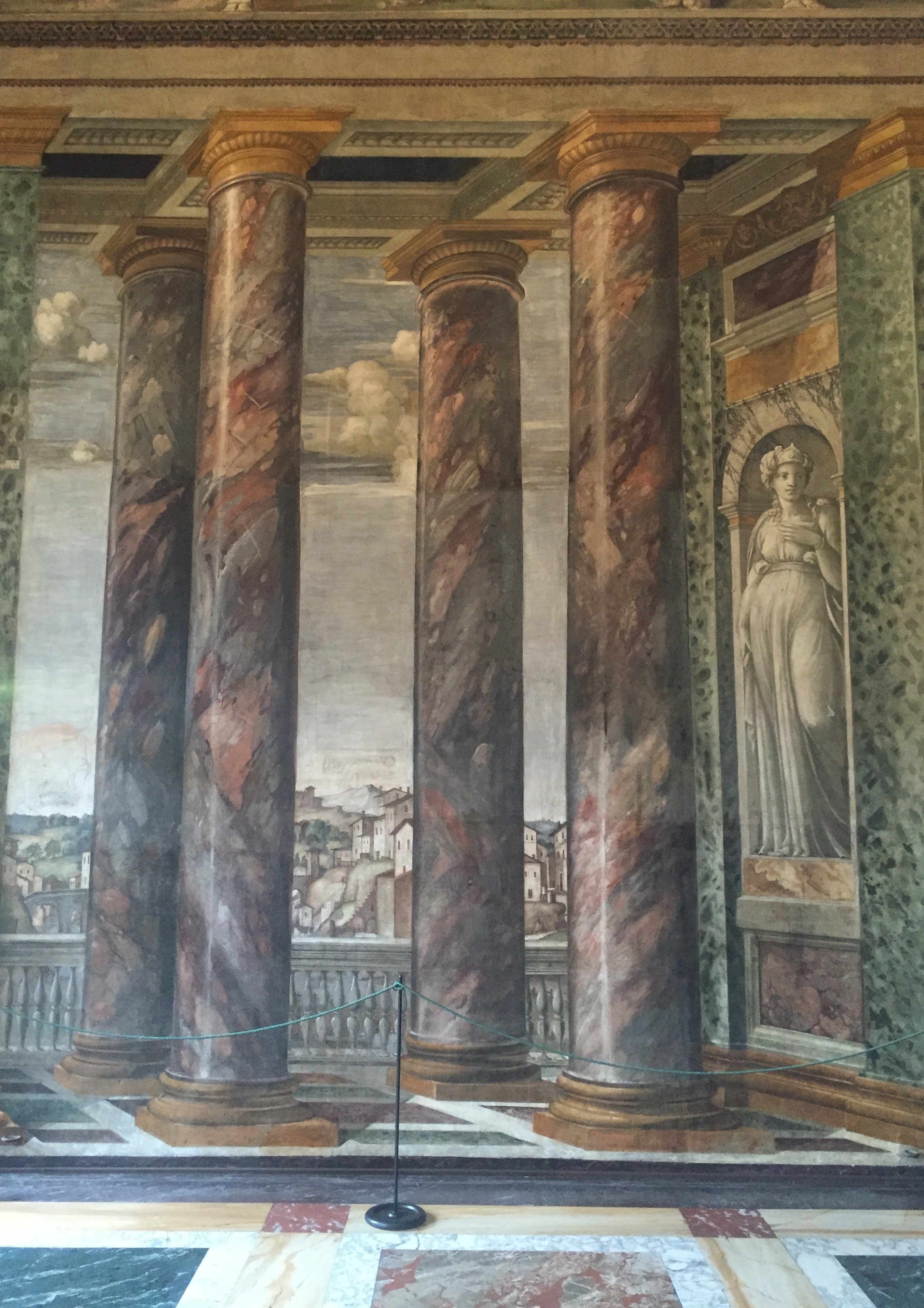
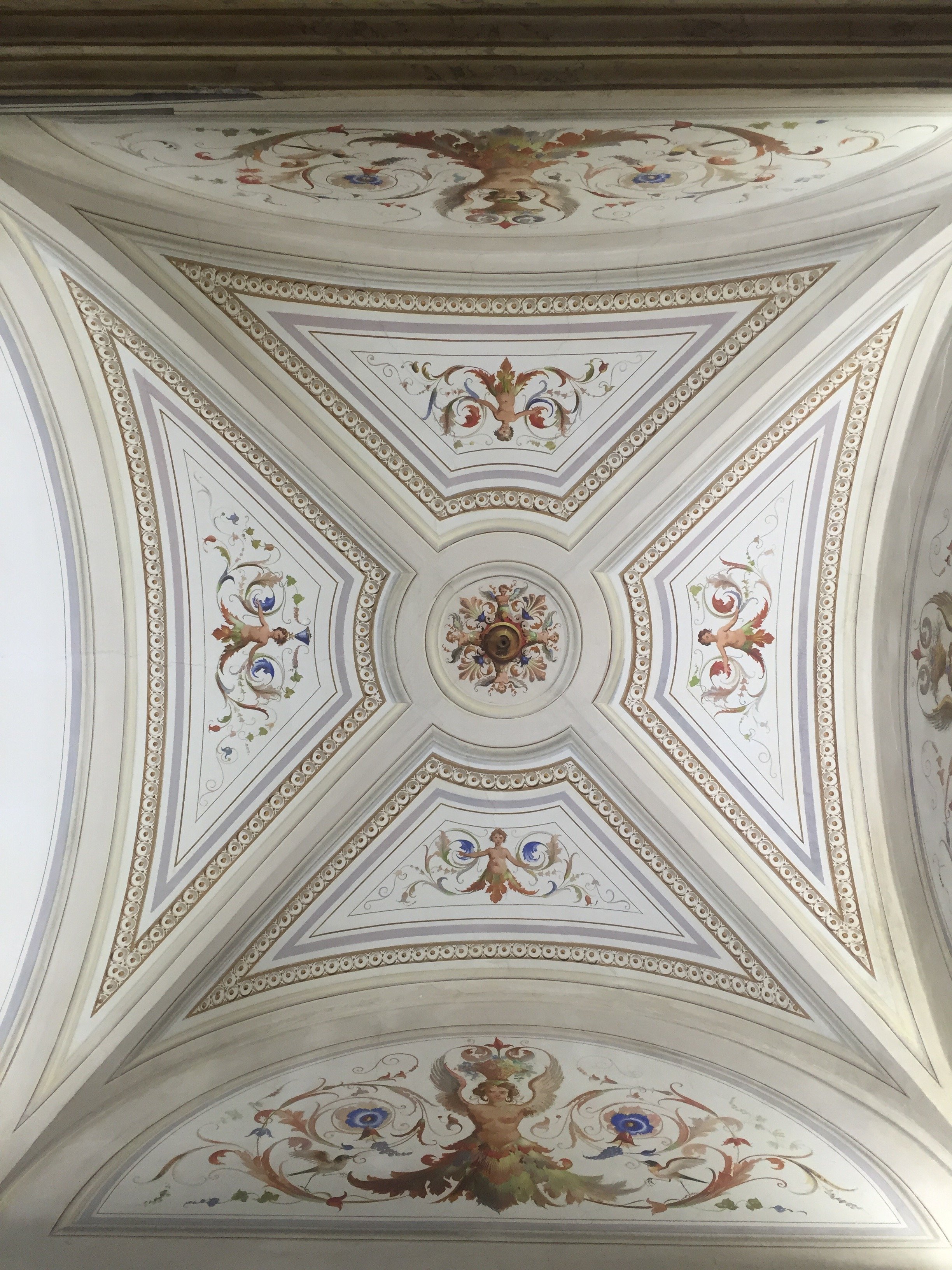
 Photos: Me and my iPhone.
Photos: Me and my iPhone.
Art and Architecture with Ariella - Torino

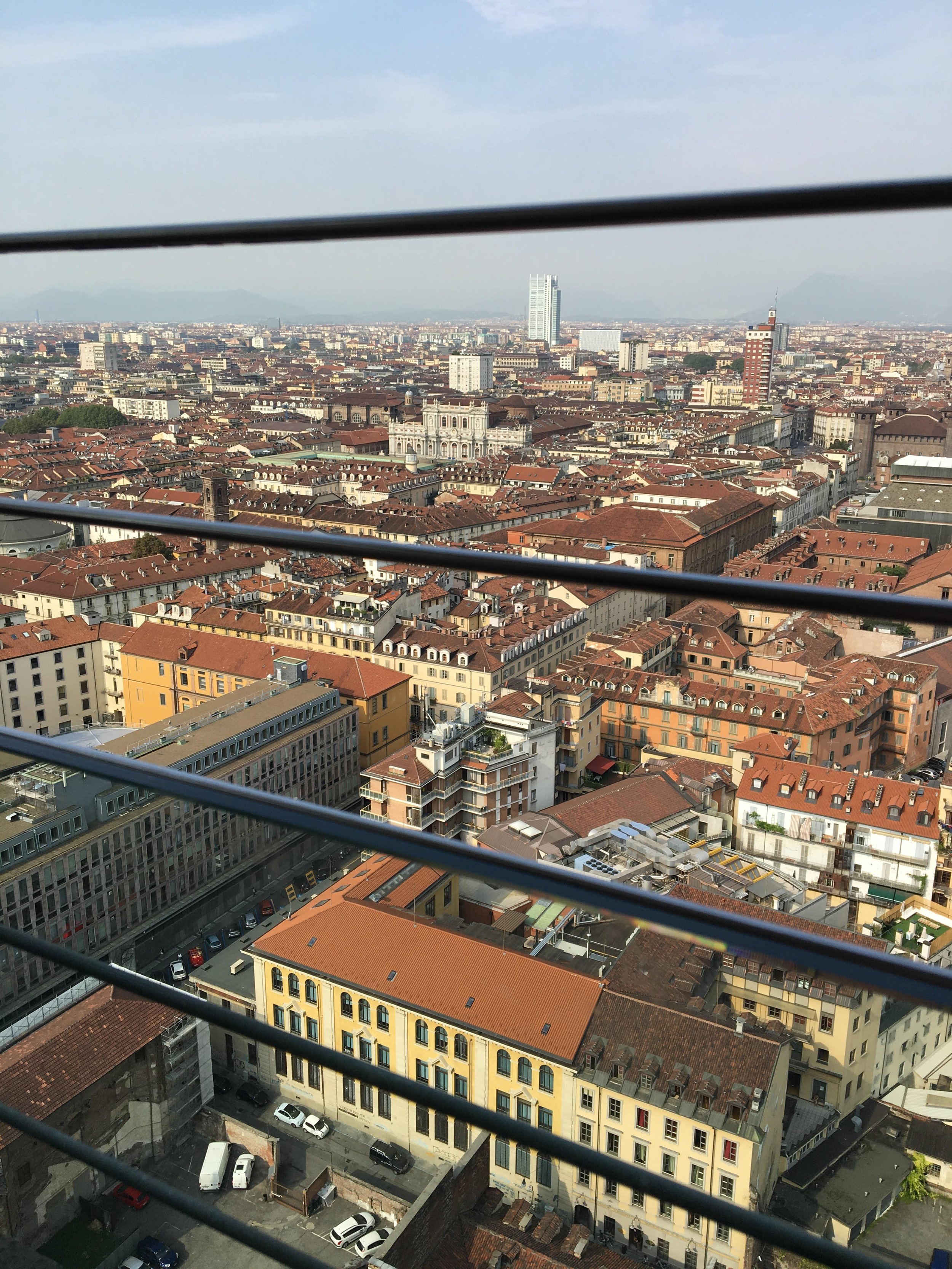 The floor of the elevator was made of glass and had striking views of the entire building. However, the ride up was not the best experience for those of us with a fear of heights.Looking back, I feel I did not spend enough time in the museum as it's something that could possibly take an entire day. The next day we walked around the city admiring the architecture, walking in and out of churches and buildings. At one point we realized there was a kind of 'exhibition' in the city. Contemporary artists had pieces displayed throughout the city and there was a map of all of the pieces. We grabbed a map and started the trail. This trail took us to some beautiful piazzas and courtyards. One of the pieces was a large cube with a triangular pyramid on top which matched the design of the window almost exactly except it was enlarged. The cafes in Torino were also incredibly beautiful. It was obvious that they were built and designed long ago. The way the aesthetics have been maintained make them unique to Torino, similar to much of the architecture we saw.
The floor of the elevator was made of glass and had striking views of the entire building. However, the ride up was not the best experience for those of us with a fear of heights.Looking back, I feel I did not spend enough time in the museum as it's something that could possibly take an entire day. The next day we walked around the city admiring the architecture, walking in and out of churches and buildings. At one point we realized there was a kind of 'exhibition' in the city. Contemporary artists had pieces displayed throughout the city and there was a map of all of the pieces. We grabbed a map and started the trail. This trail took us to some beautiful piazzas and courtyards. One of the pieces was a large cube with a triangular pyramid on top which matched the design of the window almost exactly except it was enlarged. The cafes in Torino were also incredibly beautiful. It was obvious that they were built and designed long ago. The way the aesthetics have been maintained make them unique to Torino, similar to much of the architecture we saw.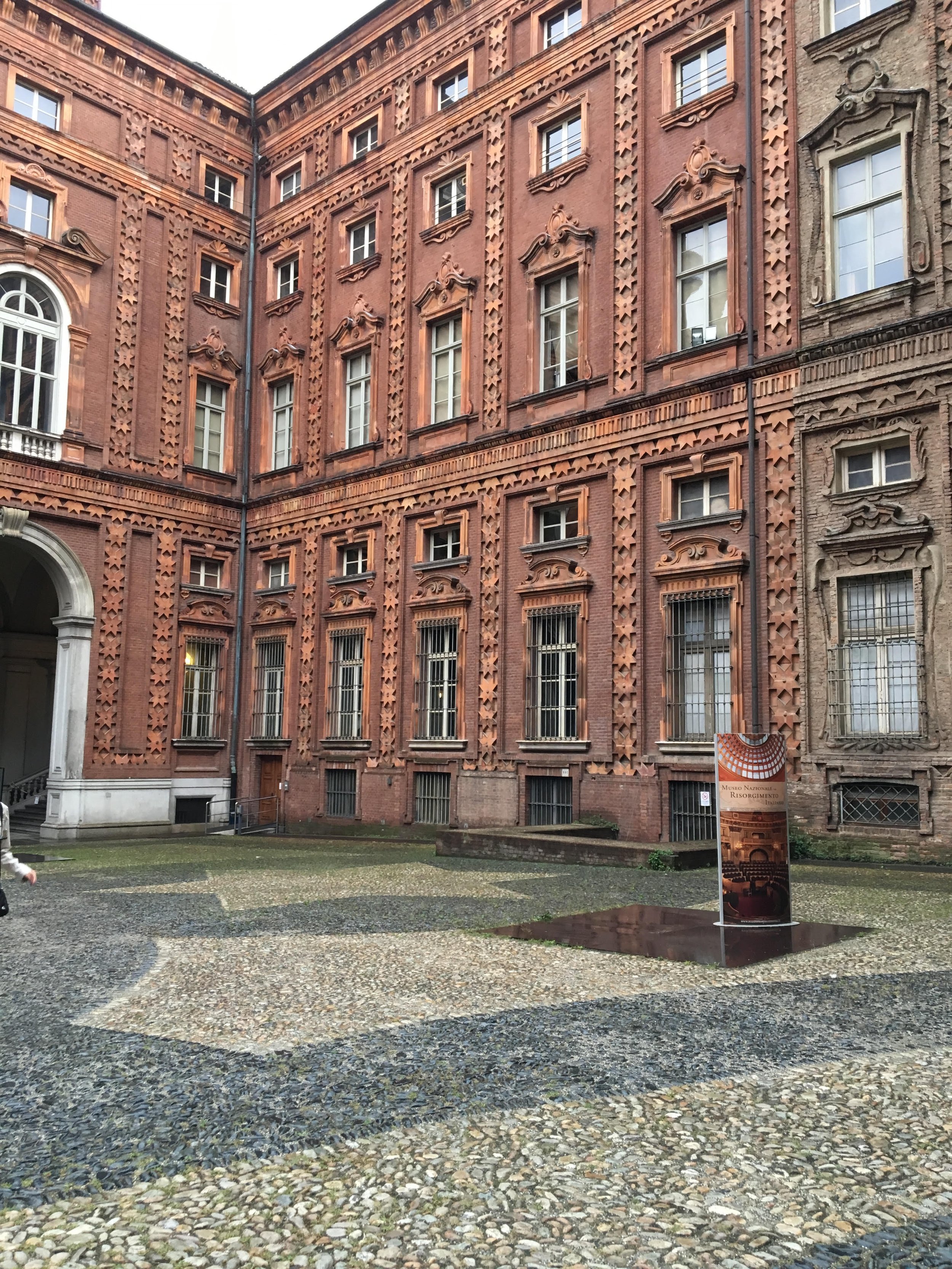
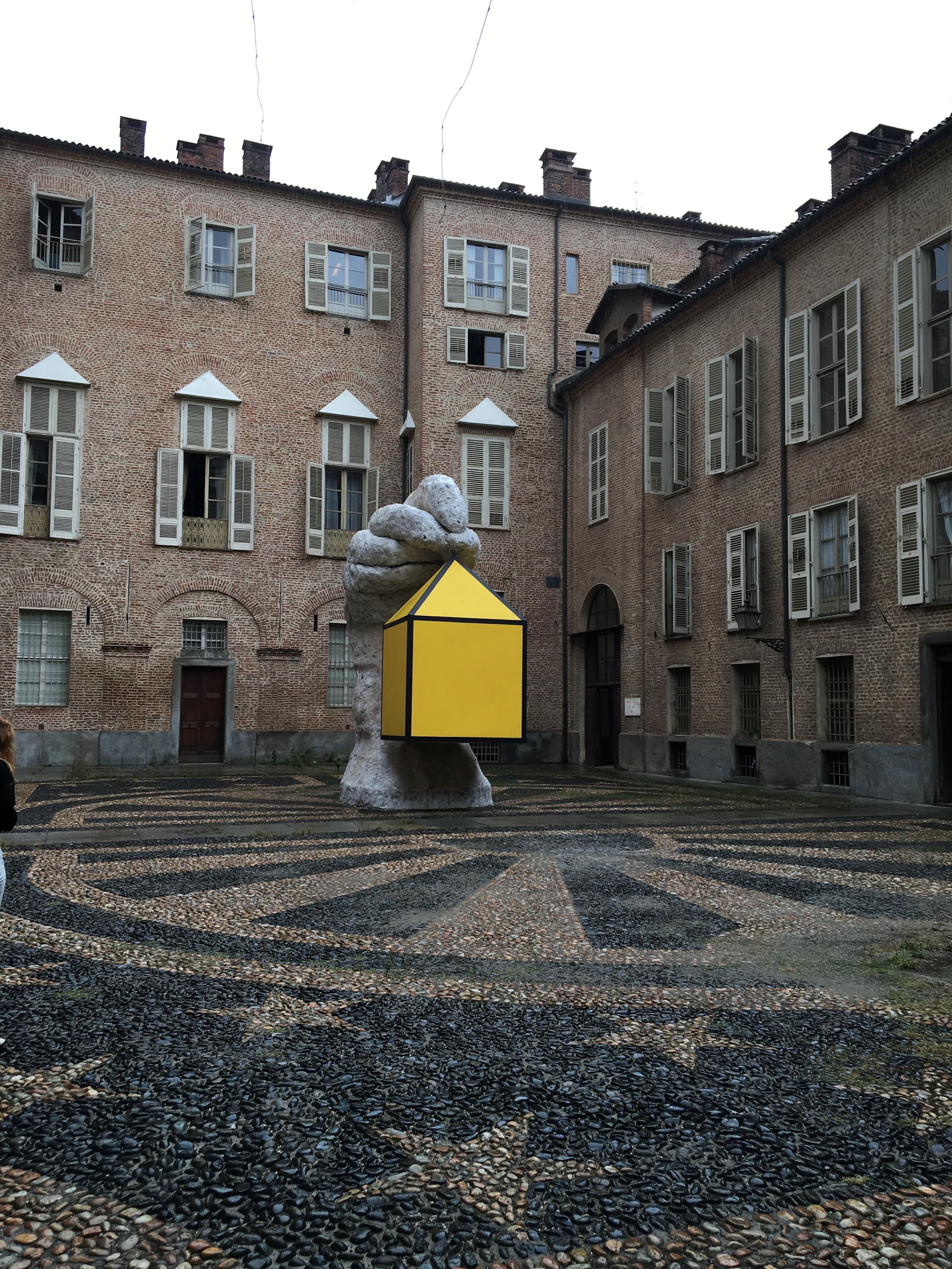
 Photos by Ariella.
Photos by Ariella.
Project Via Monserrato - Reveal
During the past year I've been working on a decorating and renovation project in the Historic Center for a client who wanted to update a few of their B&Bs.It was a great experience. At times it was also challenging, as the apartments were fully booked months in advance. The logistics were difficult.Located inside a palazzo that dates from the 1600s The Via Monserrato apartment (aka Grand Suite), is on one of the prettiest streets in Rome.The brief was to create a contemporary décor, while at the same time retaining (and respecting) the charm and history of the architecture.Vacation rentals are tricky. You don't want a design that is bland or cookie-cutter but it cannot have so much personality that it turns off most customers.Here's a photo from the living room, before.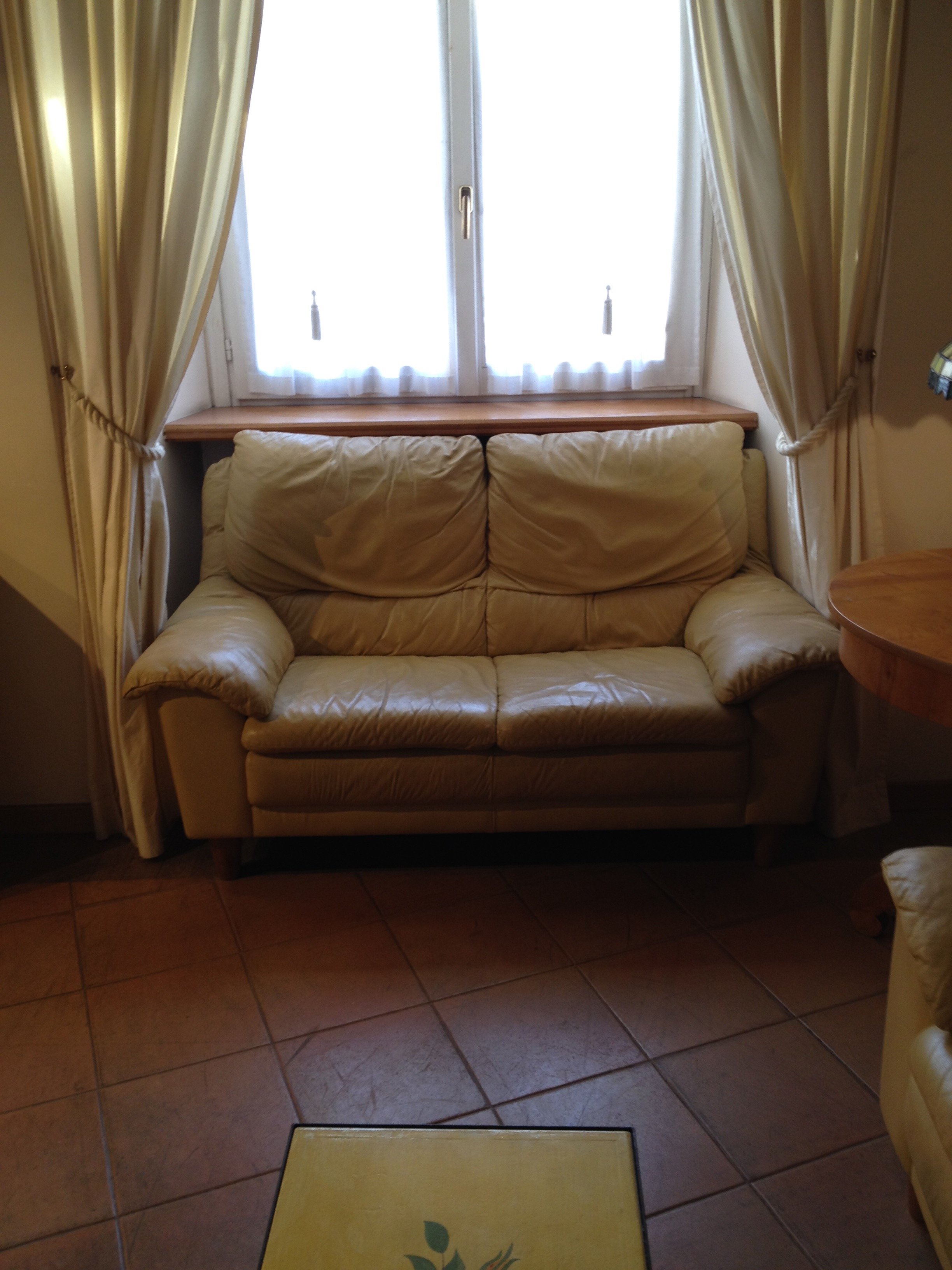 After
After 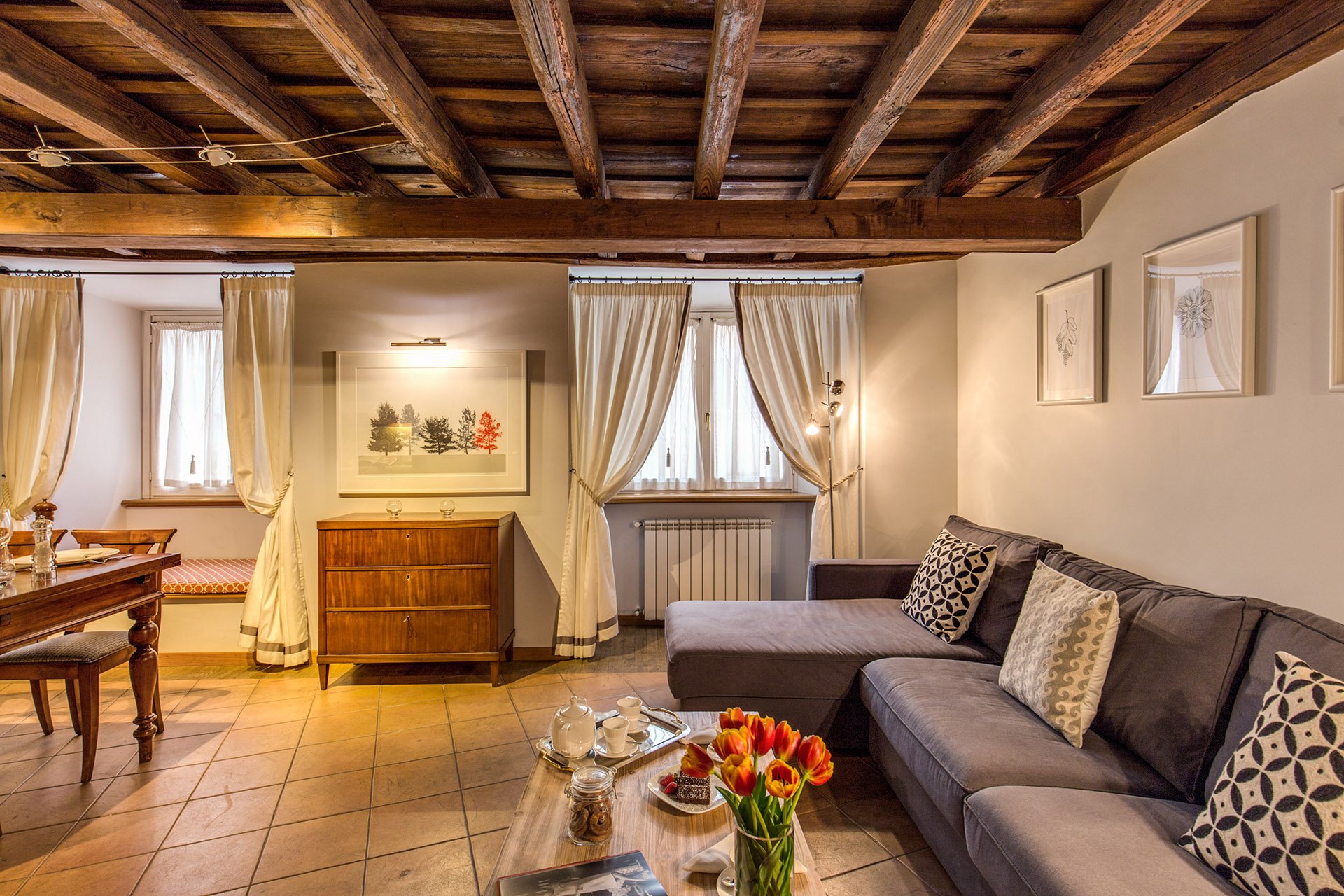 This room is a mix of high and low vendors, antiques (that belong to the client), and custom pieces.The room is light, stylish, yet comfortable. We had to use fabrics and colors that could handle a lot of wear and tear.The walls were changed to Farrow & Ball's "Blackened", a cool white that reads light grey. I know I talk a lot about this brand but there's a reason I have used it in every single project I've worked on. The quality of this paint is no joke and depth of color is incredible. This was the first time the painters had worked with Farrow & Ball and they were very impressed. When people who paint for a living rave about a brand, you know it's good. Stateside, I like Benjamin Moore as well but that brand is not sold here. Le Decorazioni is the authorized Fallow & Ball vendor in Rome.We decided to go with a one L shaped sofa instead two. This model is a sleeper sofa and we bought it from Berto Salotto.The coffee table is from Maisons du Monde, a French brand with stores all over Europe.The curtains were custom made. The trim is Dedar. All the fabric for the apartment was selected and purchased at the store Lelli.The floor lamps are from MADE.The art work over the antique buffet is by Due Alberi. Funny that I read about these two artists in Rome on Elements of Style, which is written by Boston-based American interior designer Erin Gates. We used their work in another apartment (pics soon) as well.We commissioned artist Marta Alexandra Abbott to create pieces that referenced Rome in a subtle way. Marta is American and moved to Rome several years ago. You can see more of this series, inspired by the Ara Pacis, HERE.Dining area.
This room is a mix of high and low vendors, antiques (that belong to the client), and custom pieces.The room is light, stylish, yet comfortable. We had to use fabrics and colors that could handle a lot of wear and tear.The walls were changed to Farrow & Ball's "Blackened", a cool white that reads light grey. I know I talk a lot about this brand but there's a reason I have used it in every single project I've worked on. The quality of this paint is no joke and depth of color is incredible. This was the first time the painters had worked with Farrow & Ball and they were very impressed. When people who paint for a living rave about a brand, you know it's good. Stateside, I like Benjamin Moore as well but that brand is not sold here. Le Decorazioni is the authorized Fallow & Ball vendor in Rome.We decided to go with a one L shaped sofa instead two. This model is a sleeper sofa and we bought it from Berto Salotto.The coffee table is from Maisons du Monde, a French brand with stores all over Europe.The curtains were custom made. The trim is Dedar. All the fabric for the apartment was selected and purchased at the store Lelli.The floor lamps are from MADE.The art work over the antique buffet is by Due Alberi. Funny that I read about these two artists in Rome on Elements of Style, which is written by Boston-based American interior designer Erin Gates. We used their work in another apartment (pics soon) as well.We commissioned artist Marta Alexandra Abbott to create pieces that referenced Rome in a subtle way. Marta is American and moved to Rome several years ago. You can see more of this series, inspired by the Ara Pacis, HERE.Dining area.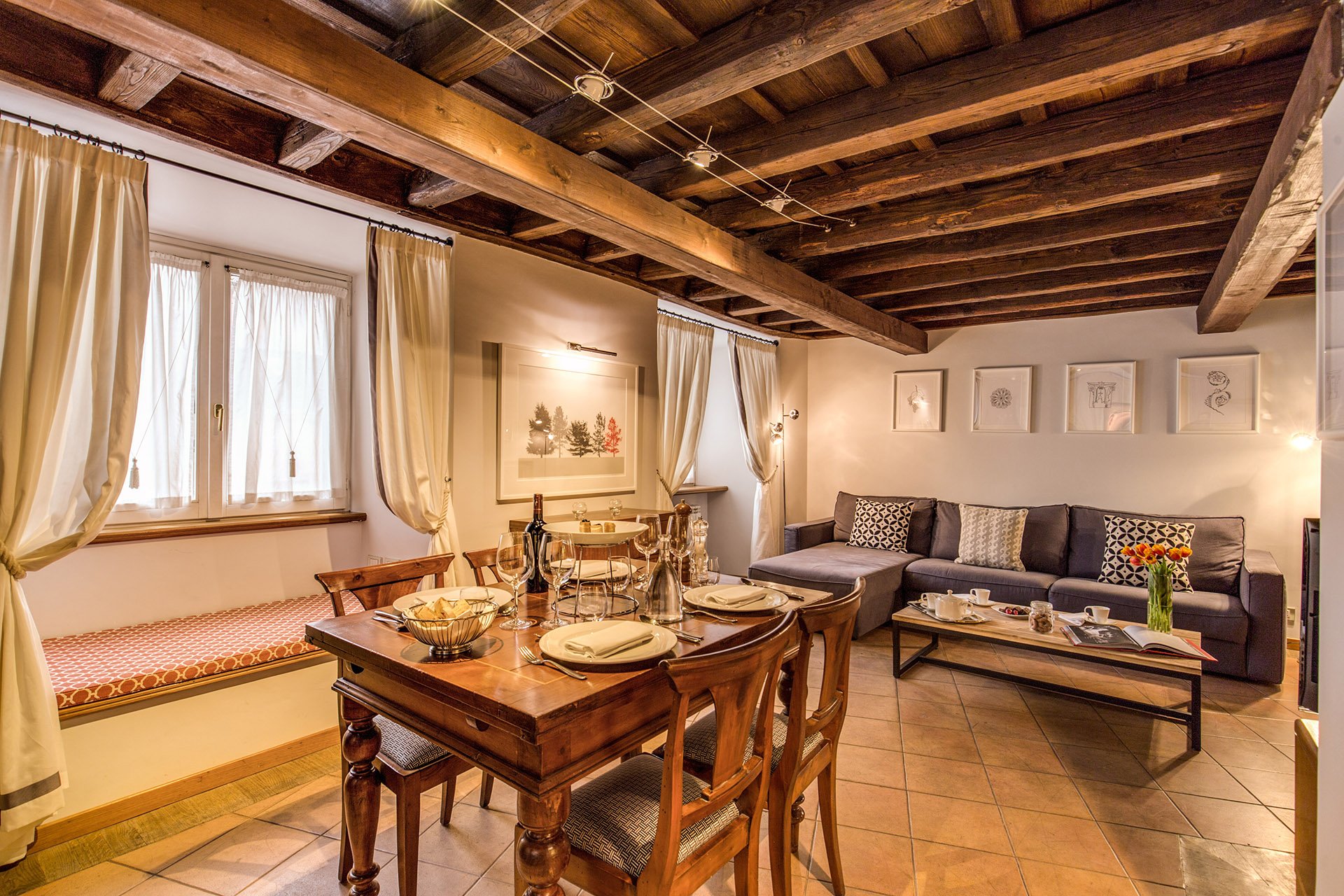 We kept the dining table and reupholstered the dining chairs.Before
We kept the dining table and reupholstered the dining chairs.Before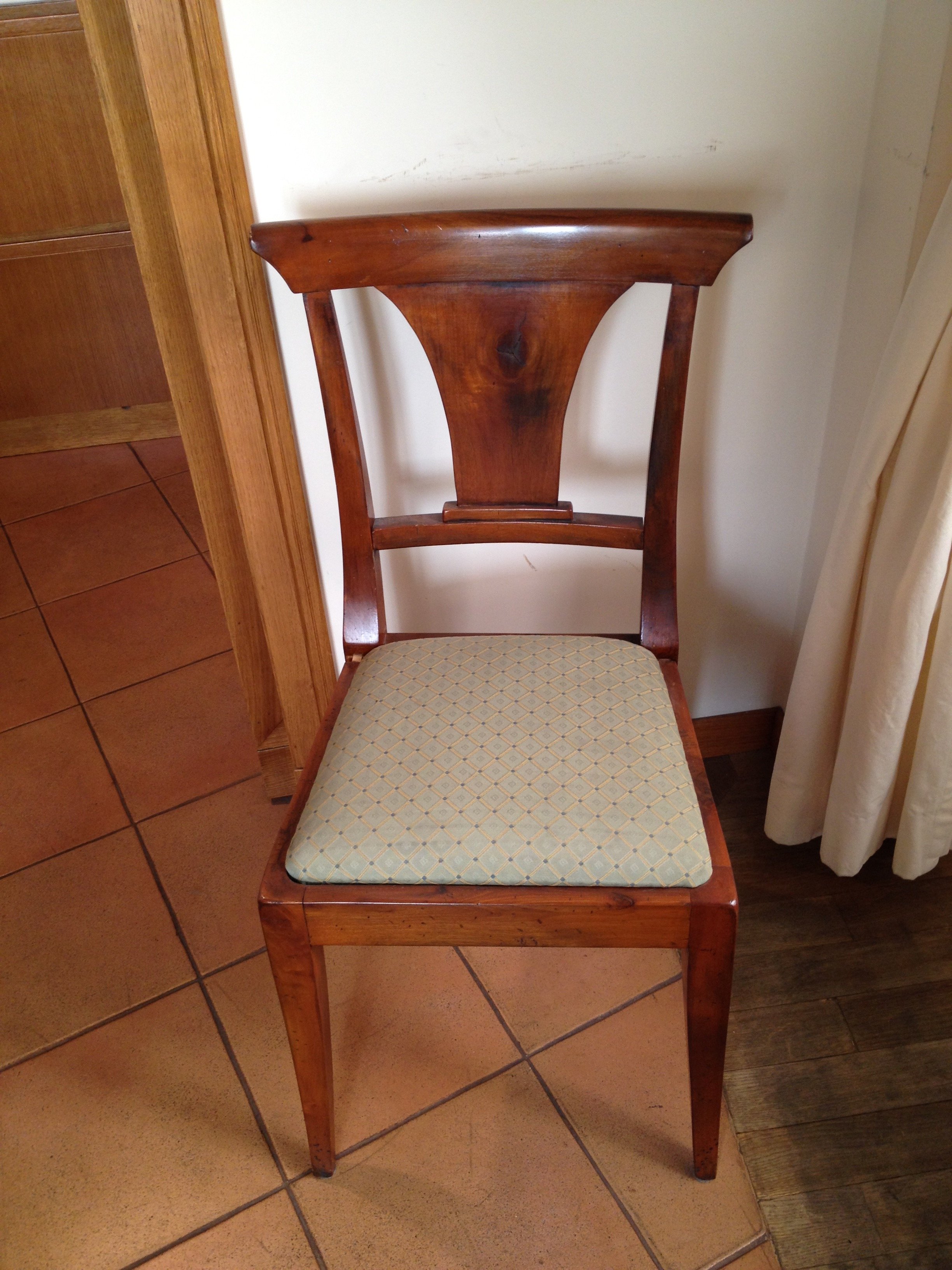 After
After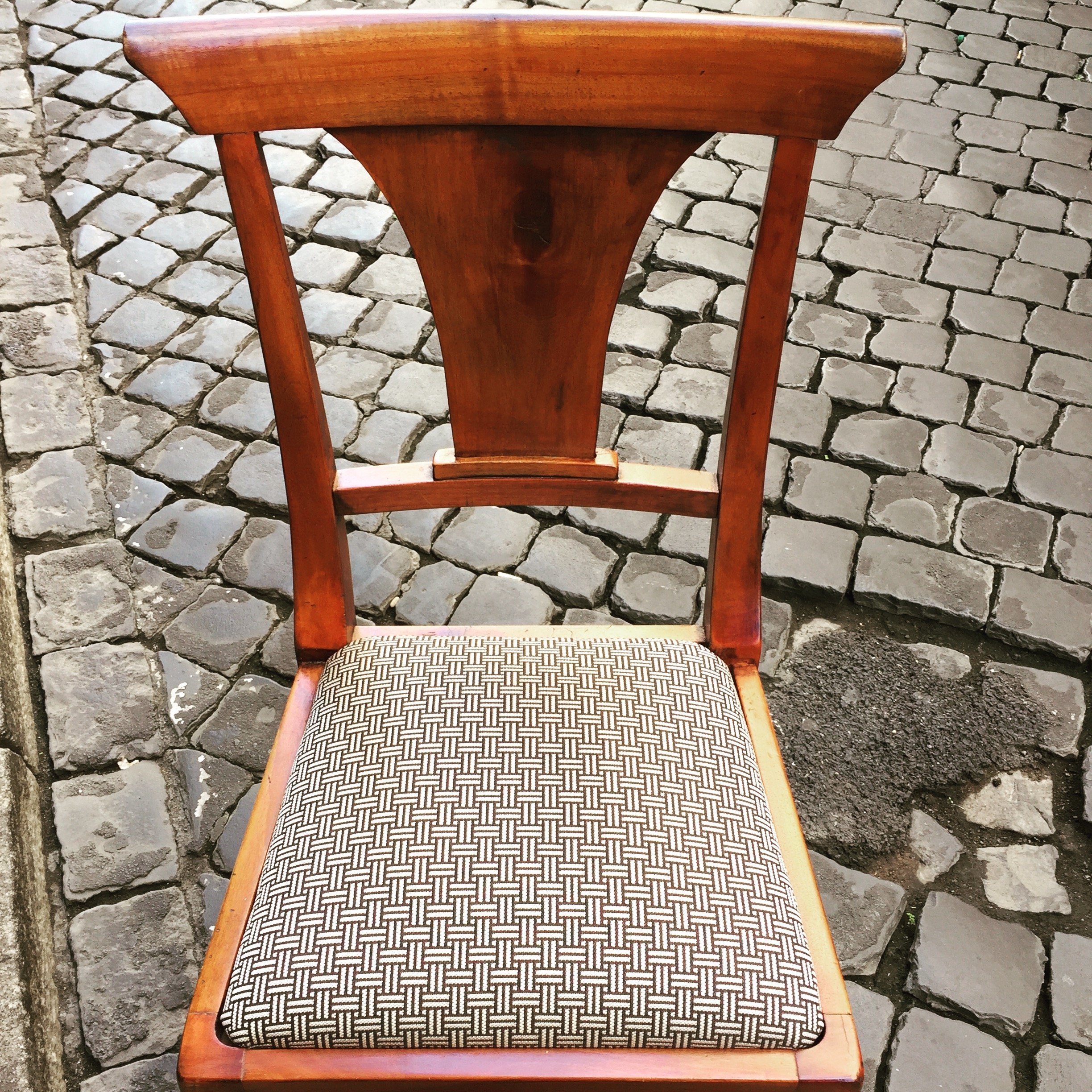 This graphic Dedar fabric is durable and makes the 1930 lines of the chair stand out. The chairs were in great shape. I thought it would be better for the budget and the design to keep them. I'm not a fan of spaces where every single item is brand new. I like to mix things up. You see that a lot in interiors in France and Italy. If you don't have any older pieces of your own, you can find them at flea markets, estates sales, in your family's attics/basements, etc.We created a window seat. I wasn't sure my client would go for the pattern or the color. The fabric is Thibaut. I think it gives this room of neutrals a nice punch of color.The pillow are from a local shop, Fabindia.The former artwork in the living room.
This graphic Dedar fabric is durable and makes the 1930 lines of the chair stand out. The chairs were in great shape. I thought it would be better for the budget and the design to keep them. I'm not a fan of spaces where every single item is brand new. I like to mix things up. You see that a lot in interiors in France and Italy. If you don't have any older pieces of your own, you can find them at flea markets, estates sales, in your family's attics/basements, etc.We created a window seat. I wasn't sure my client would go for the pattern or the color. The fabric is Thibaut. I think it gives this room of neutrals a nice punch of color.The pillow are from a local shop, Fabindia.The former artwork in the living room.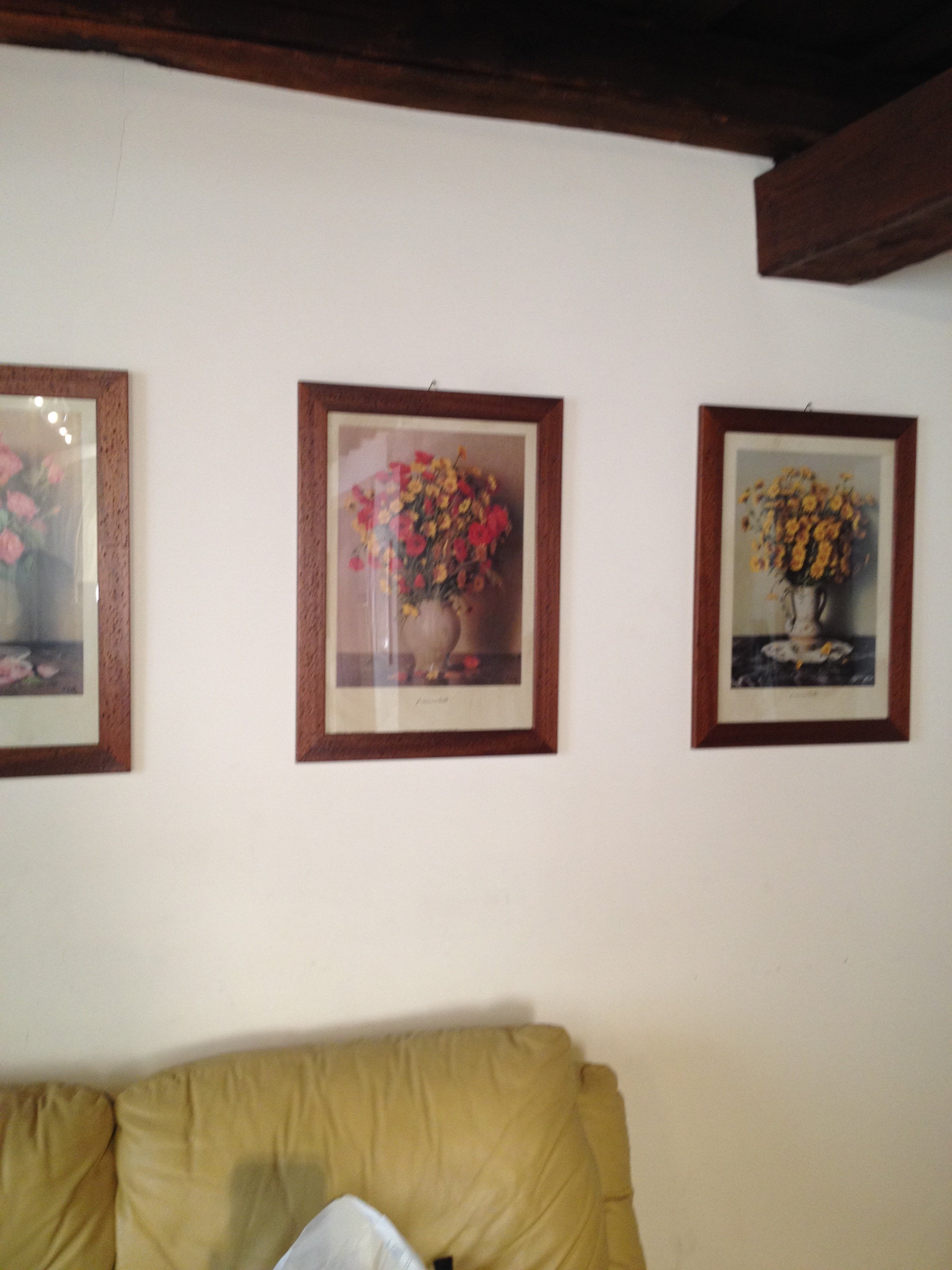 Art work, after.
Art work, after.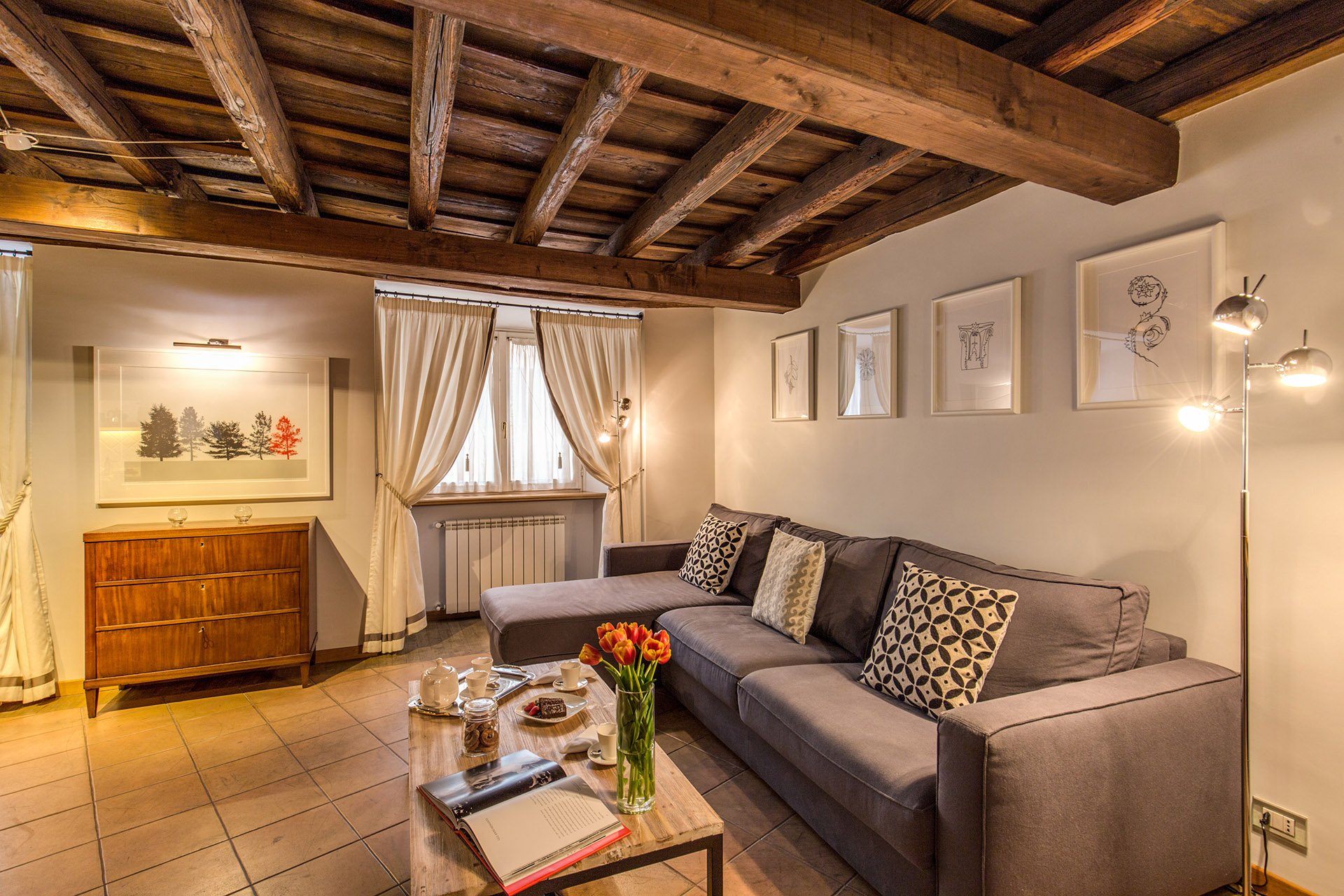 The hallway was painted white and the huge 1980s sconces were replaced with simple, modern ones. This art is by Marta as well.
The hallway was painted white and the huge 1980s sconces were replaced with simple, modern ones. This art is by Marta as well. Bedroom - before
Bedroom - before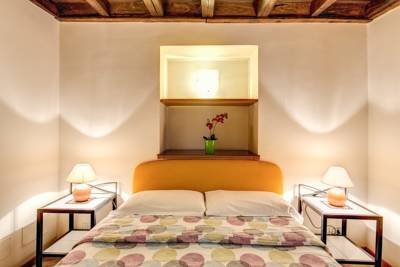 After
After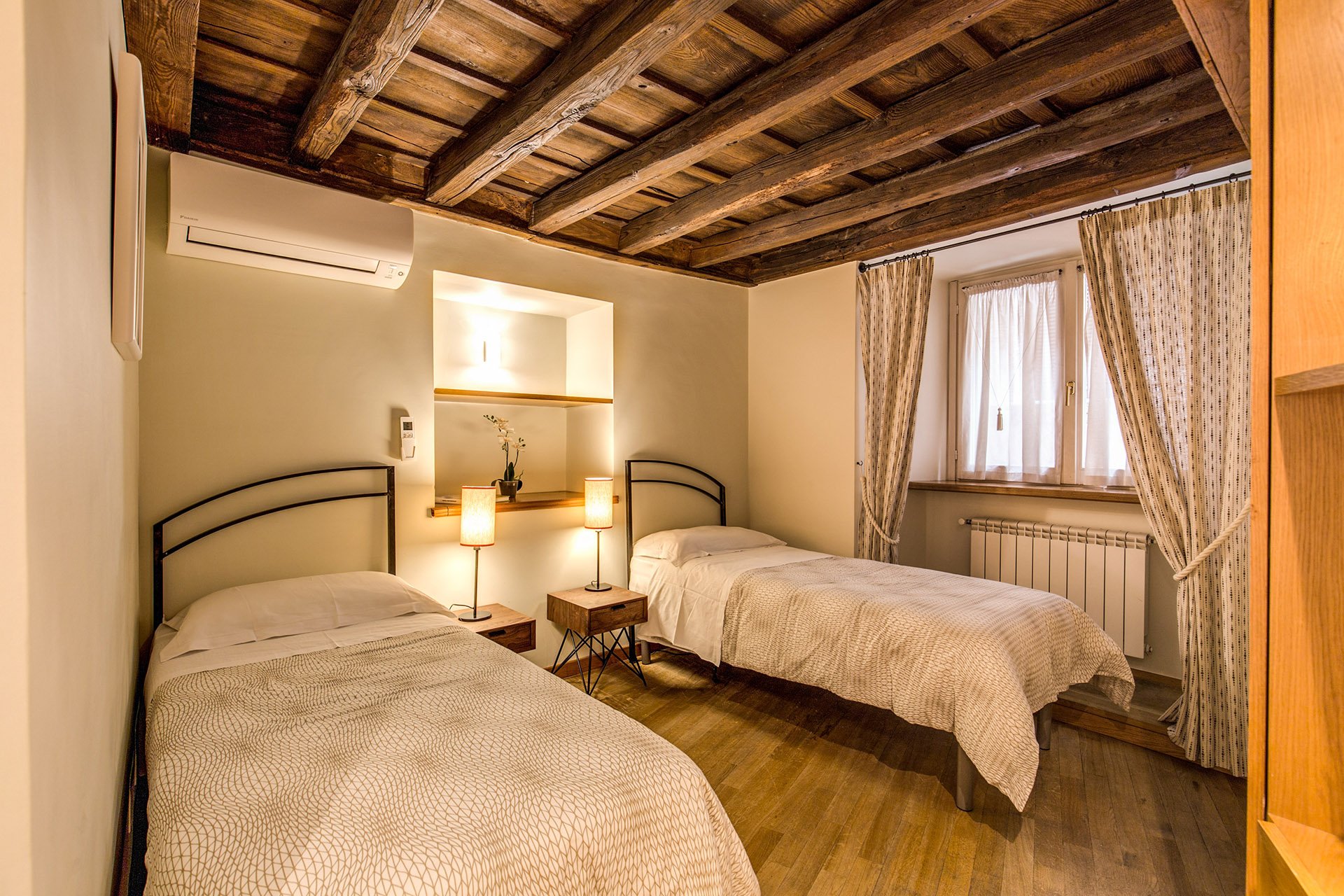 Originally, there was a queen-sized bed in this room but my client's company has had many requests for twin beds.The walls are Farrow & Ball, "James White". The curtains are custom. The fabric is Thom Filicia for Kravet.I asked my blacksmith to make the head boards. I wanted something that would look great when together and when separate. We came up with a few designs and this is the one the client picked.The night stands are from Maisons du Monde. The lamp bases are from IKEA. The shades were custom made at the store Paralume, which is right up the street.I'm not sure how a store that makes/sells lampshades manages to stay in business in this global economy we live in but I hope they stick around for a long time.The beds together.
Originally, there was a queen-sized bed in this room but my client's company has had many requests for twin beds.The walls are Farrow & Ball, "James White". The curtains are custom. The fabric is Thom Filicia for Kravet.I asked my blacksmith to make the head boards. I wanted something that would look great when together and when separate. We came up with a few designs and this is the one the client picked.The night stands are from Maisons du Monde. The lamp bases are from IKEA. The shades were custom made at the store Paralume, which is right up the street.I'm not sure how a store that makes/sells lampshades manages to stay in business in this global economy we live in but I hope they stick around for a long time.The beds together. The master bedroom - before
The master bedroom - before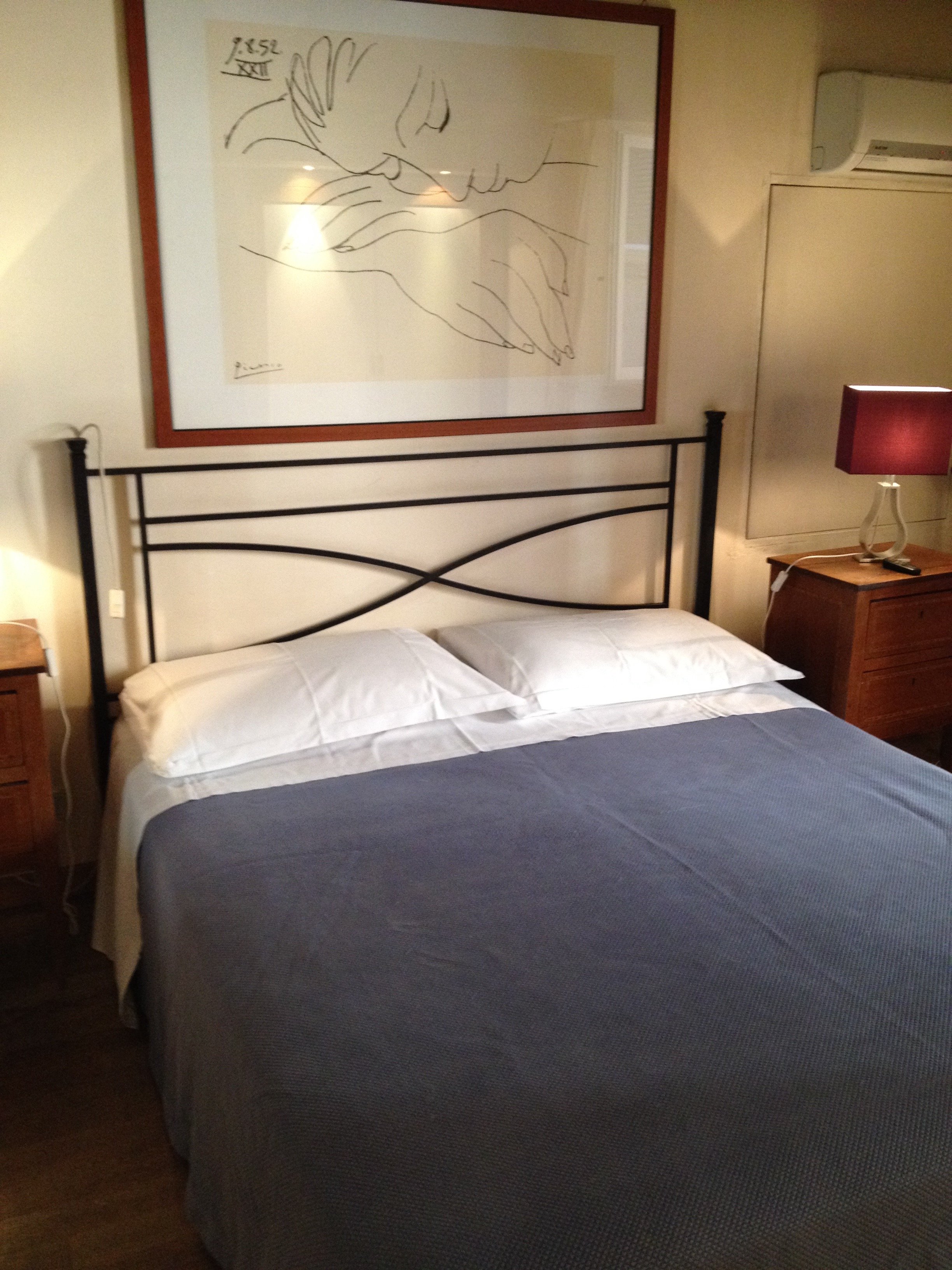 After
After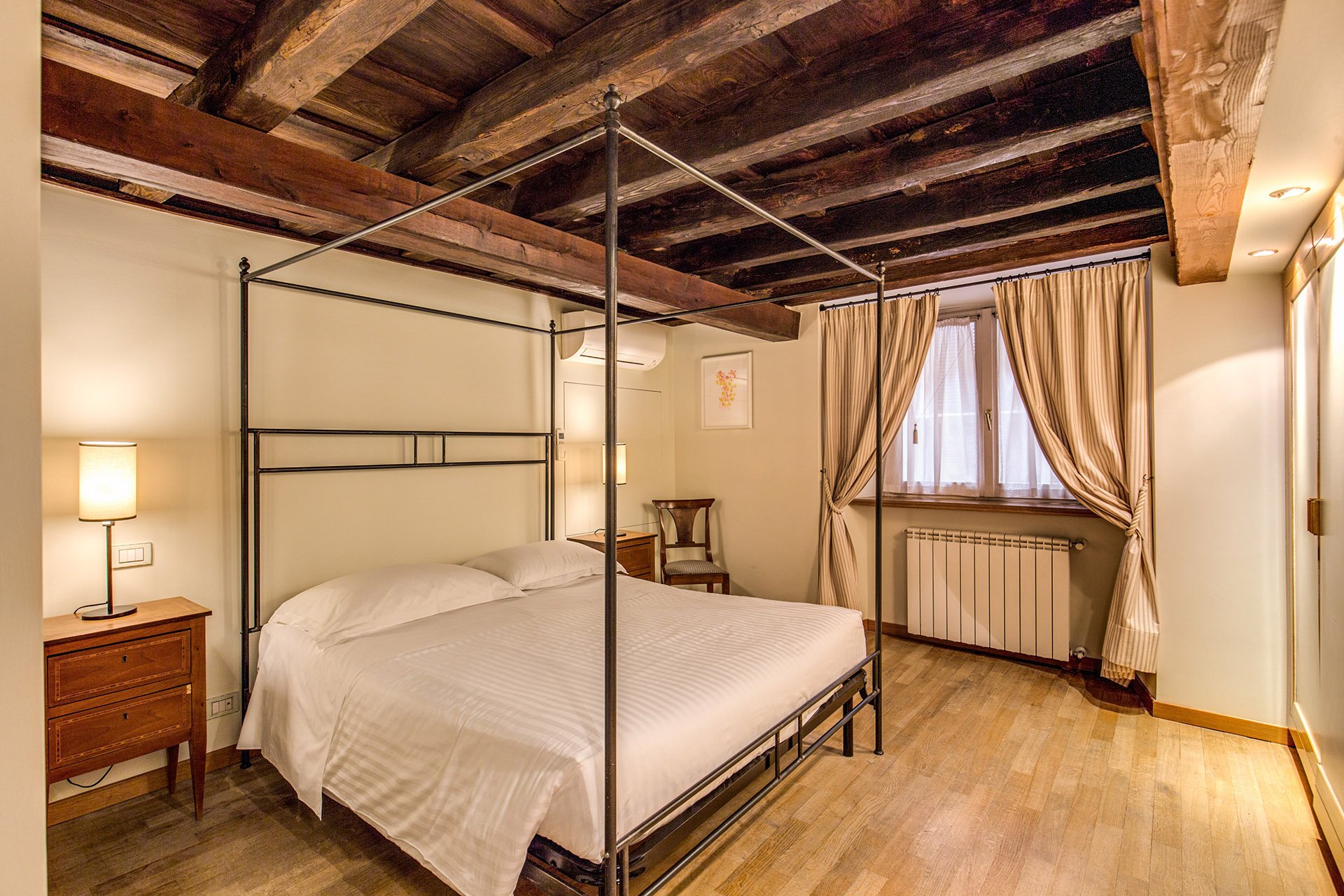 We kept the bedside tables. The walls are F&B James White. The curtain fabric is Malabar.The lamp bases are IKEA, shades custom from Paralume. It's hard to tell from the photo but these shades/trim are a different color from the other bedroom.I have a thing about four poster/canopy beds. Our blacksmith designed this simple yet, elegant frame. With these ceilings, we thought a more decorative frame would be too much. It interesting how the room actually looks bigger even though this bed is the same width as the old one.Two photos from inside the Palazzo.
We kept the bedside tables. The walls are F&B James White. The curtain fabric is Malabar.The lamp bases are IKEA, shades custom from Paralume. It's hard to tell from the photo but these shades/trim are a different color from the other bedroom.I have a thing about four poster/canopy beds. Our blacksmith designed this simple yet, elegant frame. With these ceilings, we thought a more decorative frame would be too much. It interesting how the room actually looks bigger even though this bed is the same width as the old one.Two photos from inside the Palazzo.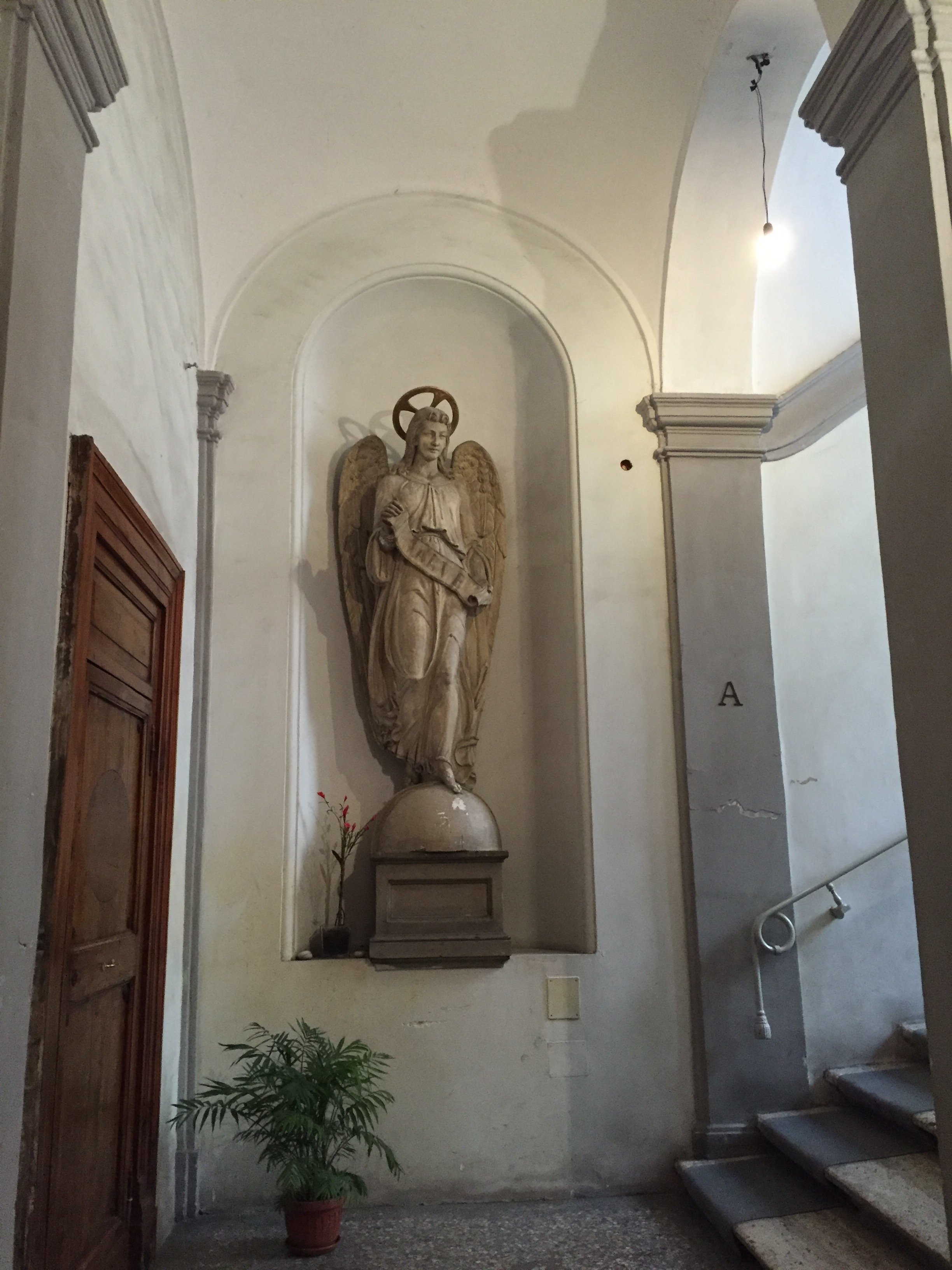
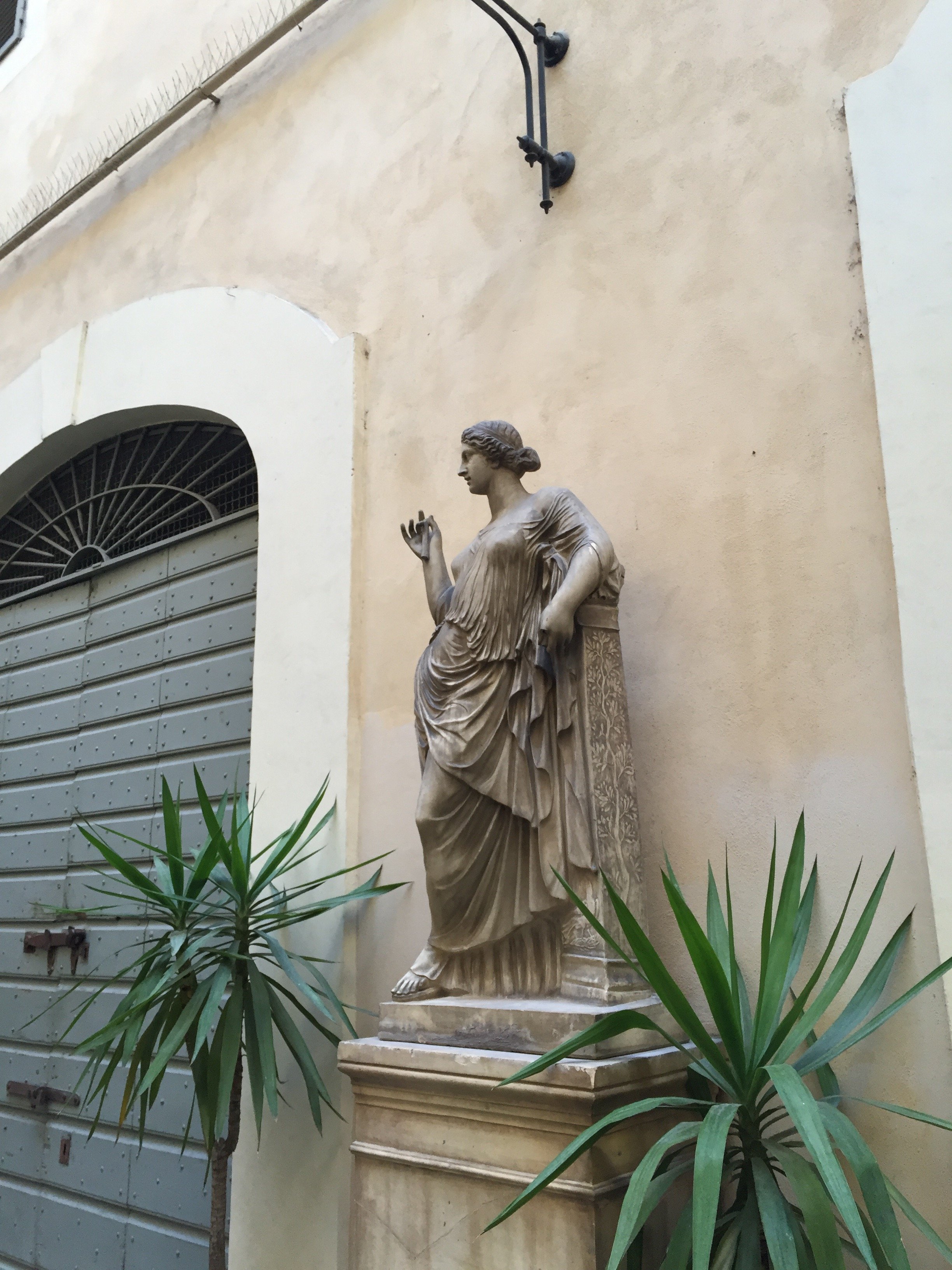 Overall, I'm very happy with how the apartment turned out. A huge, "Grazie" to my client and their team. I cannot tell you the amount of WhatsApps, SMS, emails, phone calls, job site visits, that were made. I truly appreciate their patience with my bizarre smash up of Italian and English. My client introduced me to my new Italian teacher. I got the hint. Heh.For more information about renting the Grand Suite, or other apartments from Your Suite Rome, click here.After photos and before of bedroom 1: Vincenzo TambascoOther photos: Me and my iPhone
Overall, I'm very happy with how the apartment turned out. A huge, "Grazie" to my client and their team. I cannot tell you the amount of WhatsApps, SMS, emails, phone calls, job site visits, that were made. I truly appreciate their patience with my bizarre smash up of Italian and English. My client introduced me to my new Italian teacher. I got the hint. Heh.For more information about renting the Grand Suite, or other apartments from Your Suite Rome, click here.After photos and before of bedroom 1: Vincenzo TambascoOther photos: Me and my iPhone
Life in Rome - Museo Nazionale Romano, Palazzo Altemps
For almost eight years I walked past Palazzo Altemps at least five times a week. I'm not sure why I waited so long to finally check it out.One Friday, during lunch time, I basically had the place to myself. True, it was the dead of winter but I was surprised.The Palazzo is very close to Piazza Navona and was built during the 1500s. Archaeologists have uncovered ancient Roman structures and artifacts from the 1st century AD, which are displayed on the first floor.Cardinal Marcus Sitticus Altemps acquired the palazzo from the Riario family in 1568. He greatly extended the palazzo to showcase the family's impressive art and and book collections. There are also many standout pieces from the Boncompagni Ludovisi, Mattei, del Drago Albani, and Brancaccio collectionsThis museum is part of the Museo Nazionale Romano which also includes the Crypta Balbi, Palazzo Massimo, and Terme di Diocleziano.There is free admission to the museums on the first Sunday of the month.Below are a few pictures I snapped during my tour: 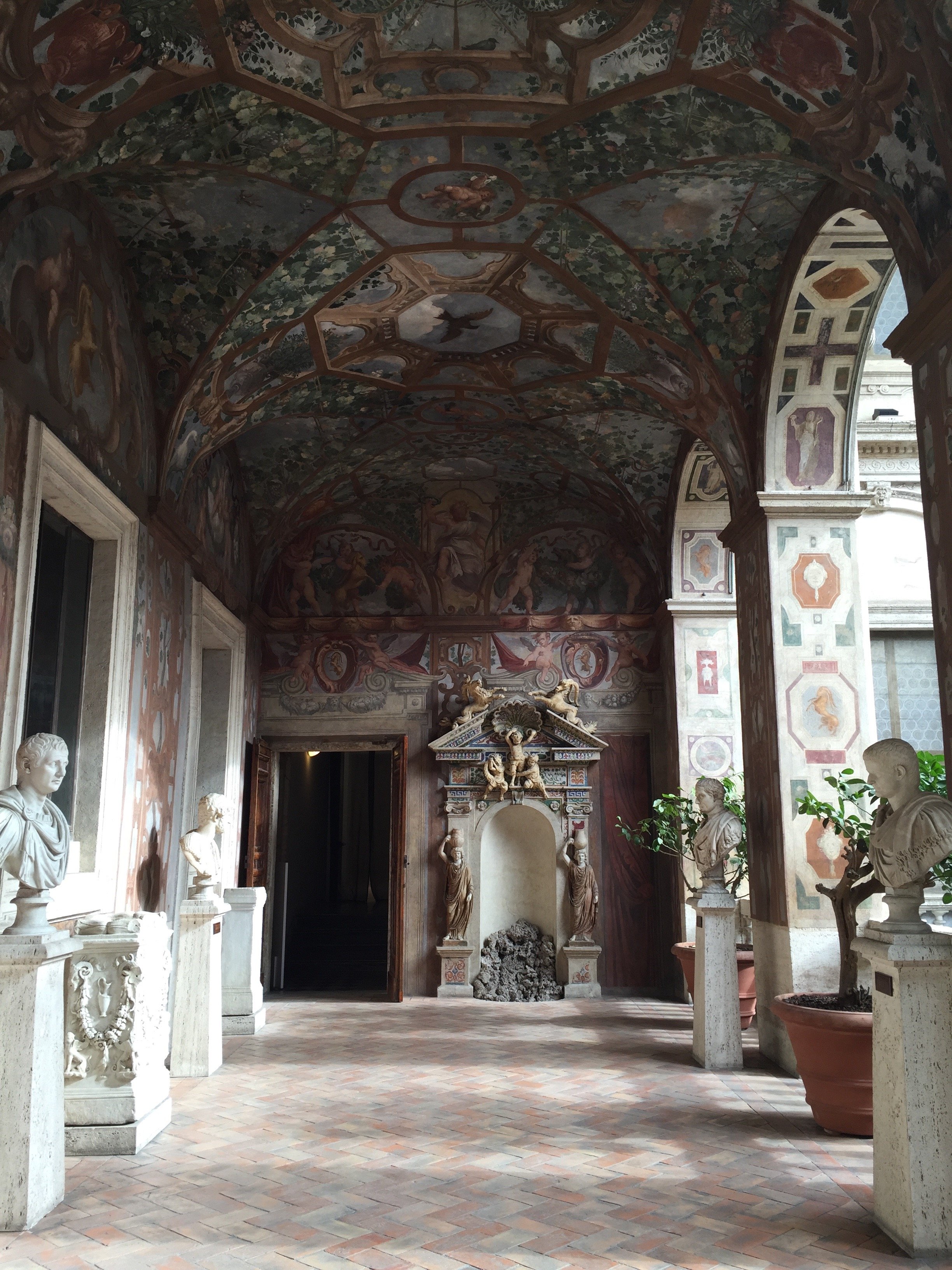
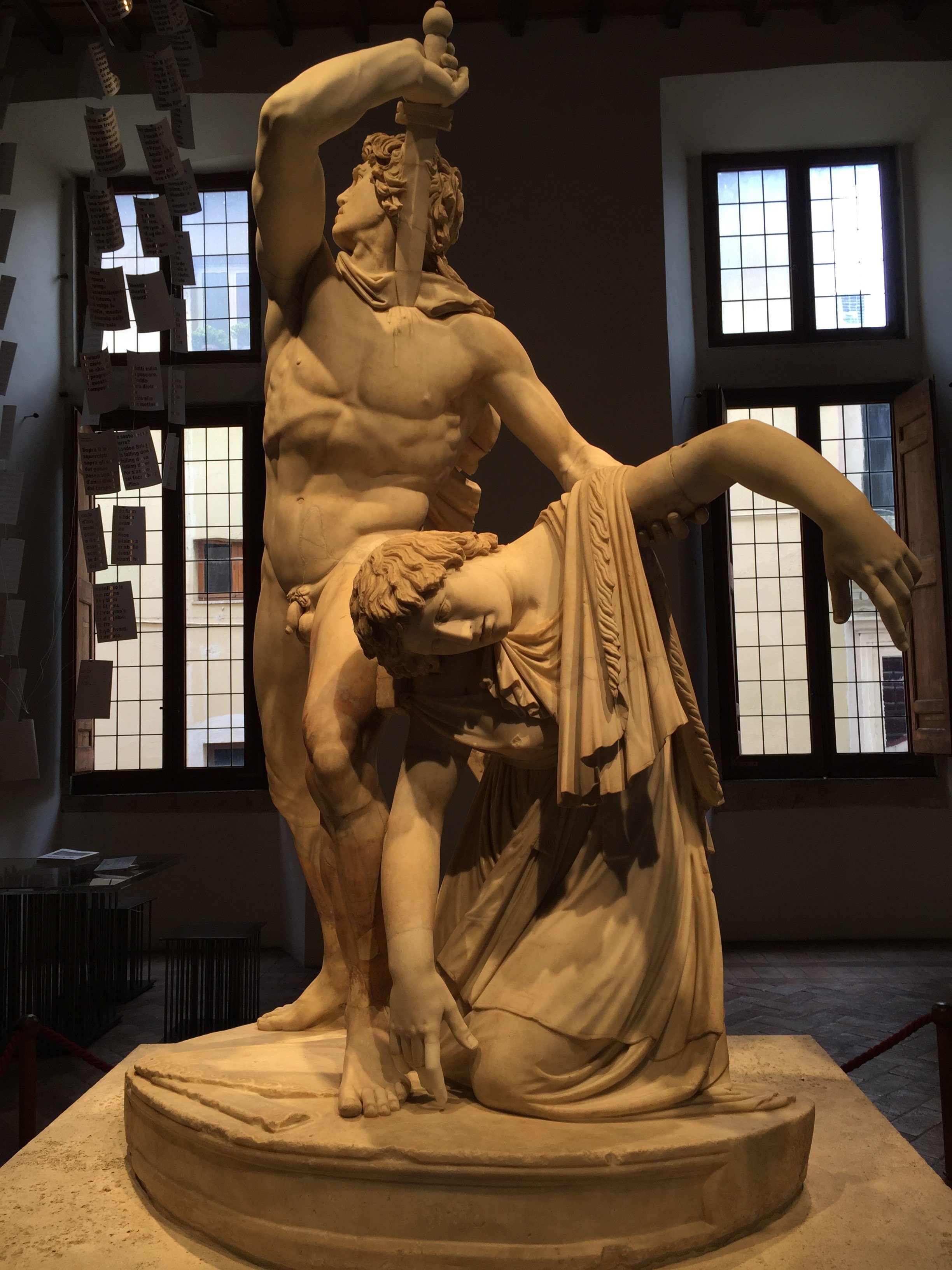
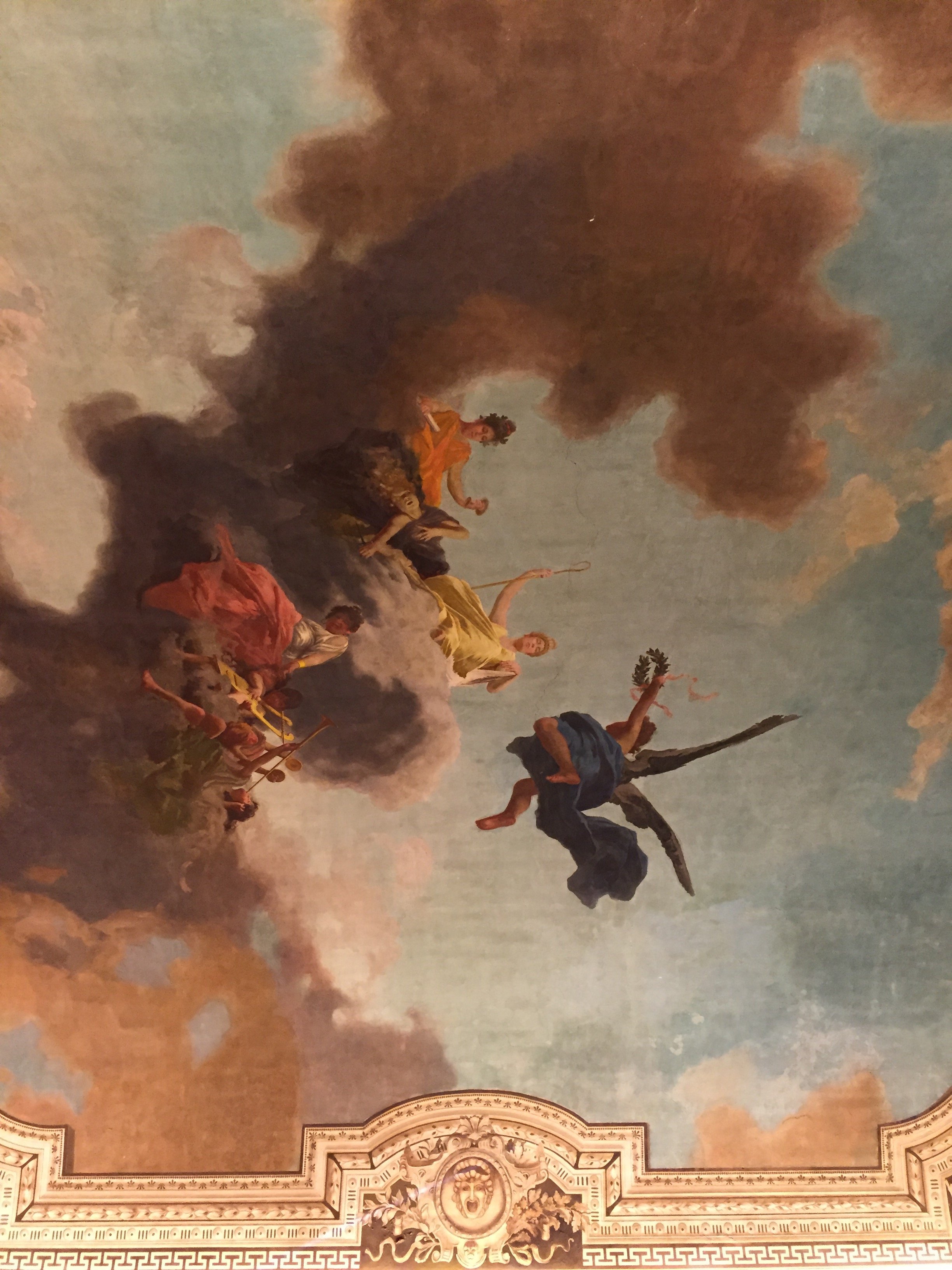







 Palazzo Altemps is opened Tuesday - Sunday from 9.00 to 19.45.Closed Mondays (except Easter Monday and during the "Culture Week"), 1 January, 25 December.The Ticket Office closes one hour before closing time.Photos: Me and my iPhone
Palazzo Altemps is opened Tuesday - Sunday from 9.00 to 19.45.Closed Mondays (except Easter Monday and during the "Culture Week"), 1 January, 25 December.The Ticket Office closes one hour before closing time.Photos: Me and my iPhone
Design Inspiration - Bar Luce - Prada Fondazione, Milan
Hold up, how is it October already? One of my friends in the States was complaining about seeing Thanksgiving decorations already. I guess we should be grateful they weren't for Valentine's Day 2016.I have started my apartment search. It's, well, a trip. I don't know what some of these landlords are thinking. The bathroom situation is not good.I'm having a hard time finding smaller apartments that are unfurnished. Most of the apartments in the neighborhoods I'm focusing on were built for families. I don't need a huge apartment and as a small business owner, it wouldn't be financially smart to take on that kind of monthly expense.I hope to find something this month. We'll see.I took a quick business trip to Milan last month. I got completely lost searching for a to-the-trade vintage furniture store. Once i realized I was very close to the new Prada Fondazione, I had to check out Bar Luce.Bar Luce was designed by film director Wes Anderson. Anderson has directed several short films for the fashion house.It's 1950/1960's Milanese style with a touch of Anderson's quirkiness. Opened everyday from 9:00 a.m. - 10:00 p.m., Bar Luce is the prefect spot to have coffee or aperitivi.There are so many wonderful design details in this space. I really need to return and spend a afternoon there, reading and writing.ADORE these lights. If I find an apartment with an ingresso/foyer that has overhead lighting, I'd love a fixture like this.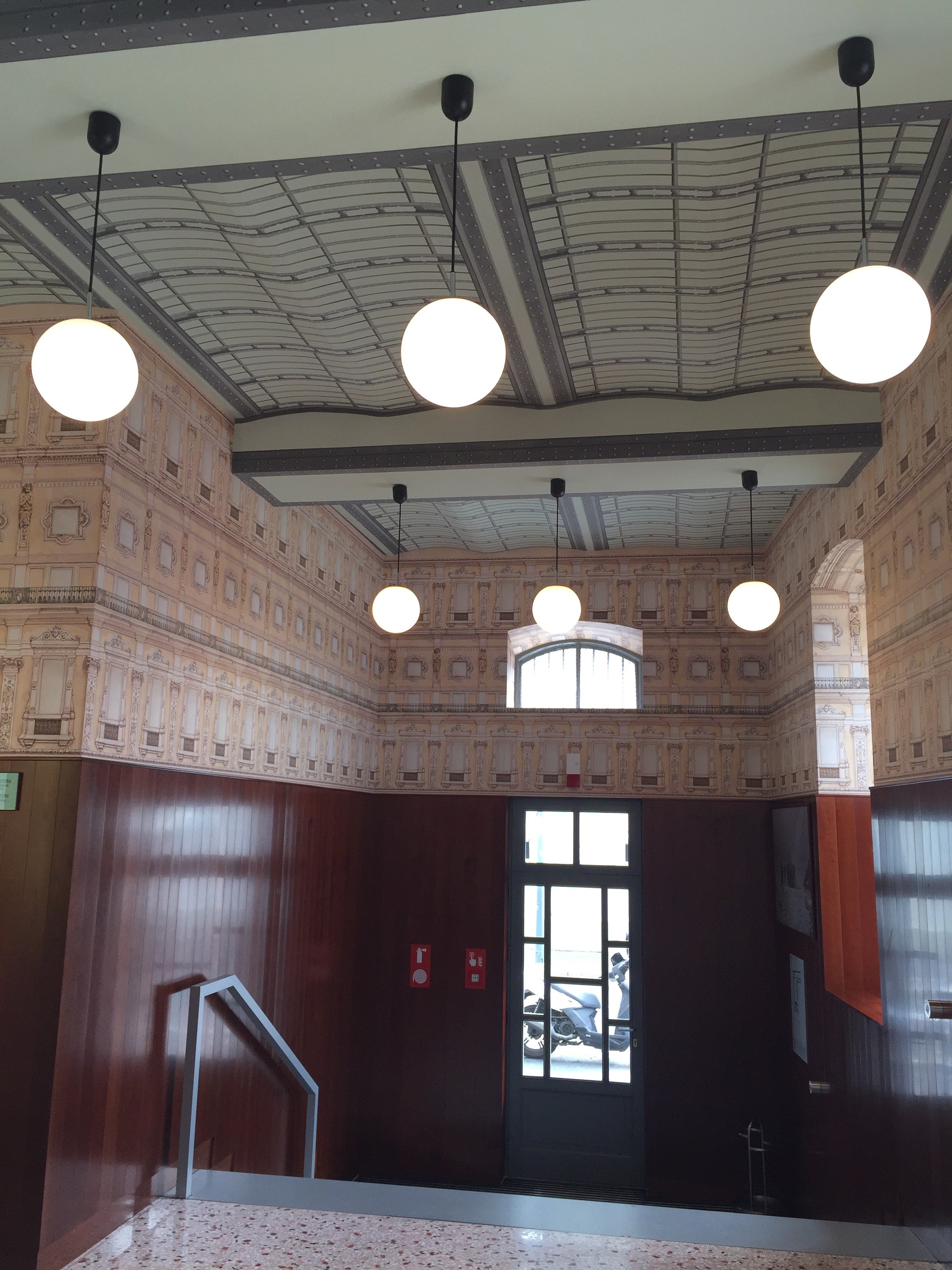 The dark wood helps anchor all the pastels. Without it, perhaps the décor would be too twee. Pink and green are fabulous together. Back in college I used to have a rugby shirt with those colors. One day while walking across the quad, an upperclassman asked me if I were an AKA. She said, "you do wear a lot of pink and green."I did. Not because I belonged to that sorority but because I wore a lot of preppy clothes in the 80s.
The dark wood helps anchor all the pastels. Without it, perhaps the décor would be too twee. Pink and green are fabulous together. Back in college I used to have a rugby shirt with those colors. One day while walking across the quad, an upperclassman asked me if I were an AKA. She said, "you do wear a lot of pink and green."I did. Not because I belonged to that sorority but because I wore a lot of preppy clothes in the 80s.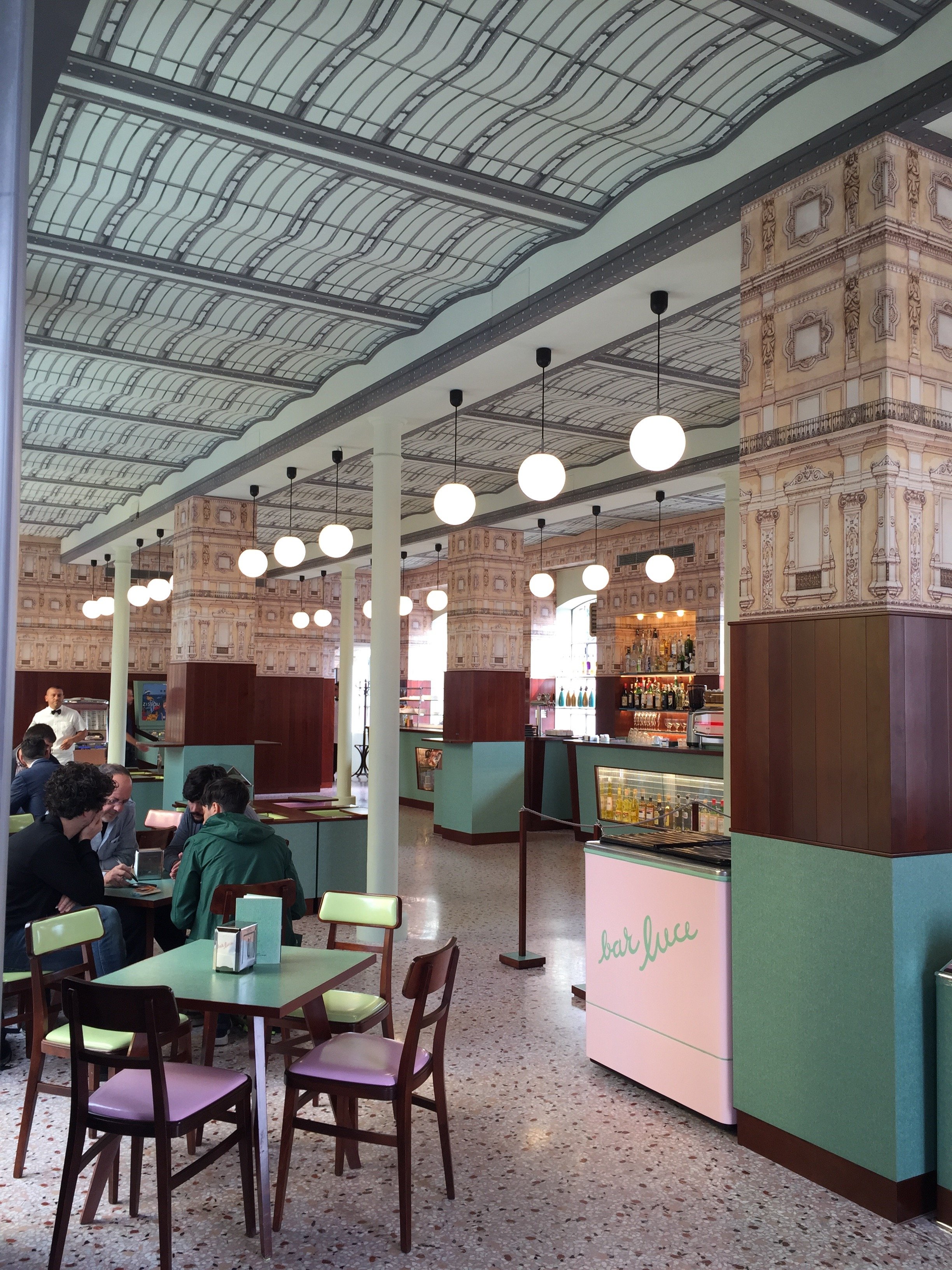
 I didn't have a chance to see what tunes were on the jukebox.
I didn't have a chance to see what tunes were on the jukebox.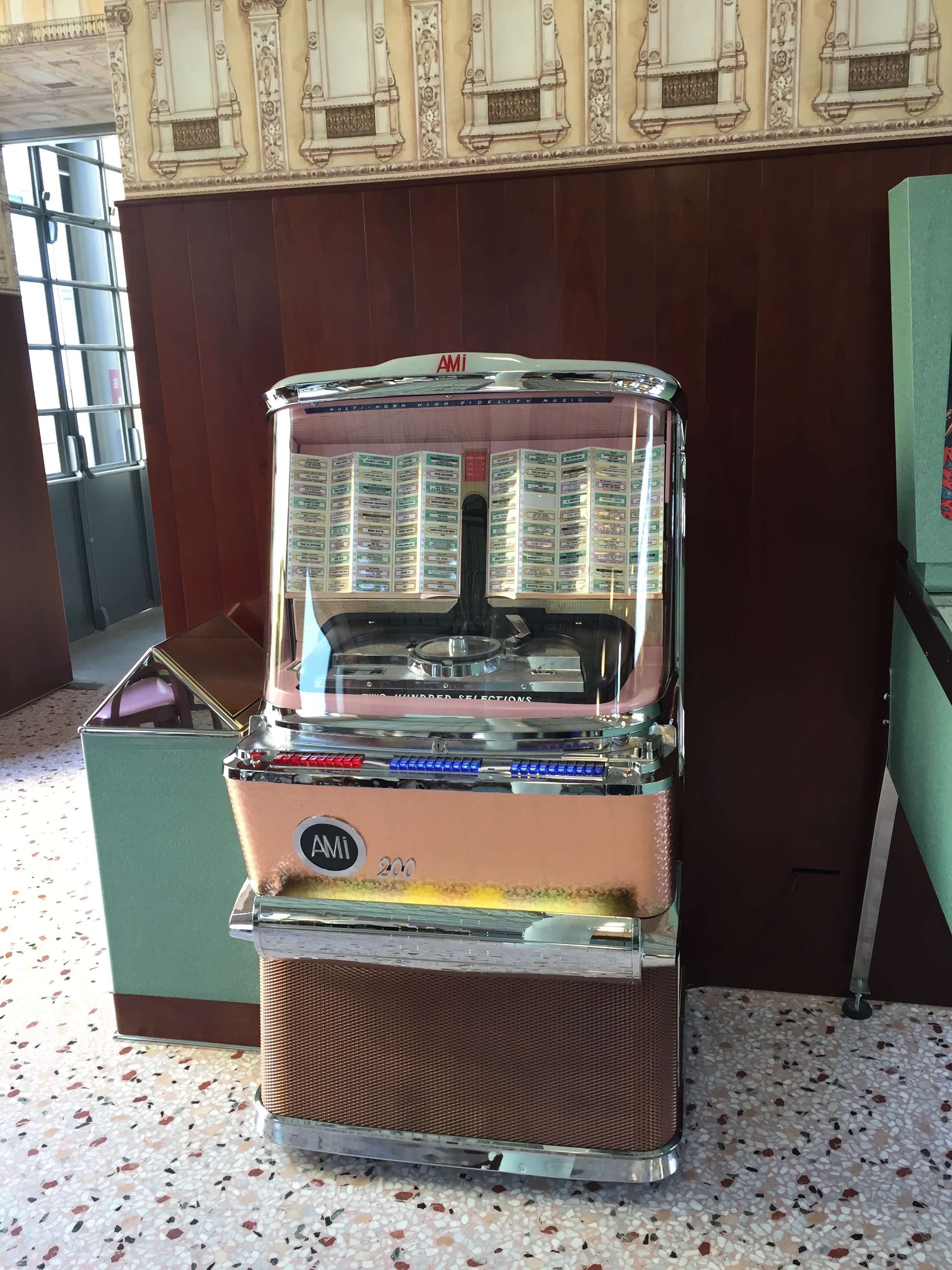 One of my favorite Wes Anderson films. I must buy the soundtrack.
One of my favorite Wes Anderson films. I must buy the soundtrack.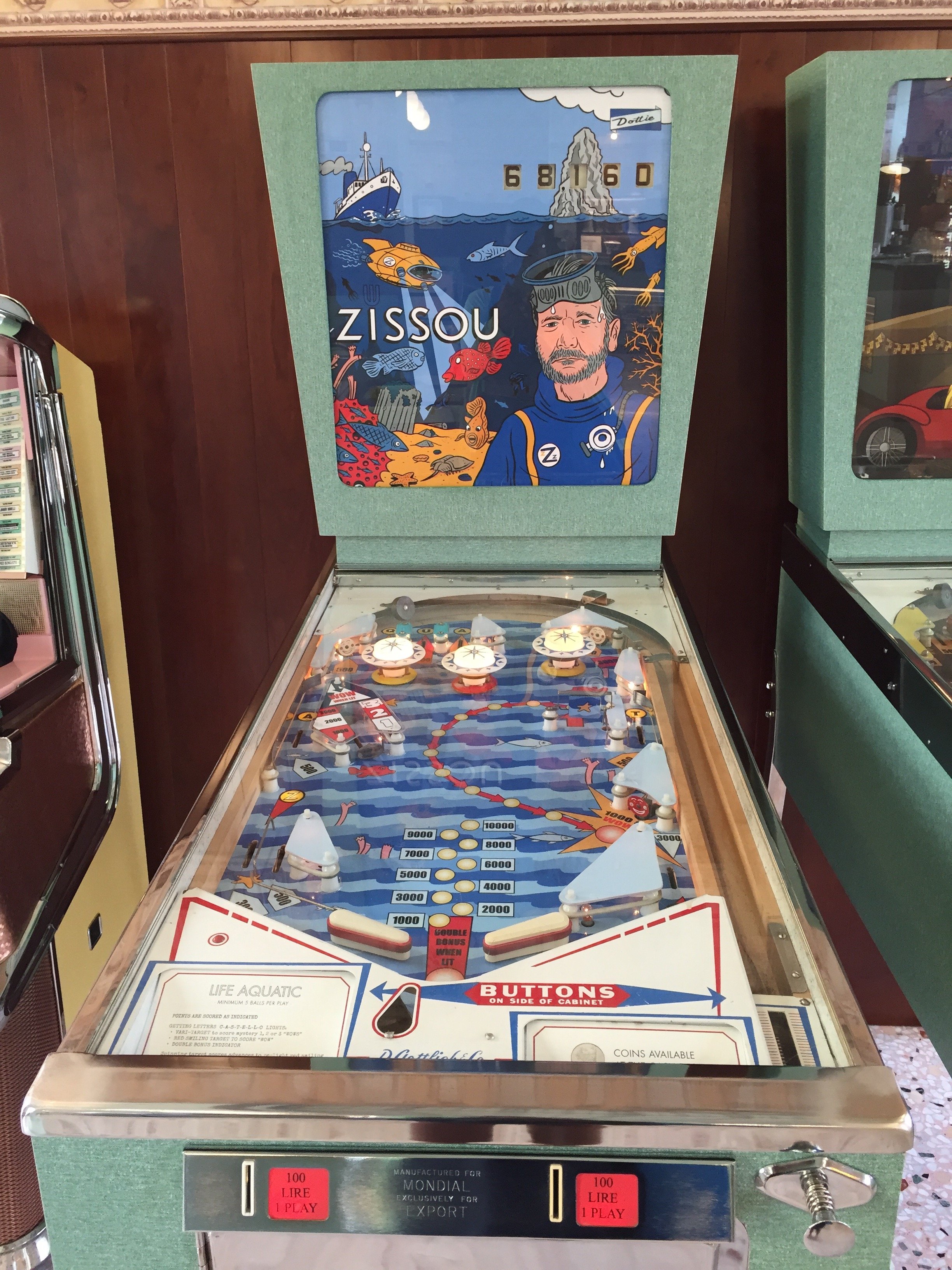 I wonder what flavor the pink cake is. So pretty.
I wonder what flavor the pink cake is. So pretty.
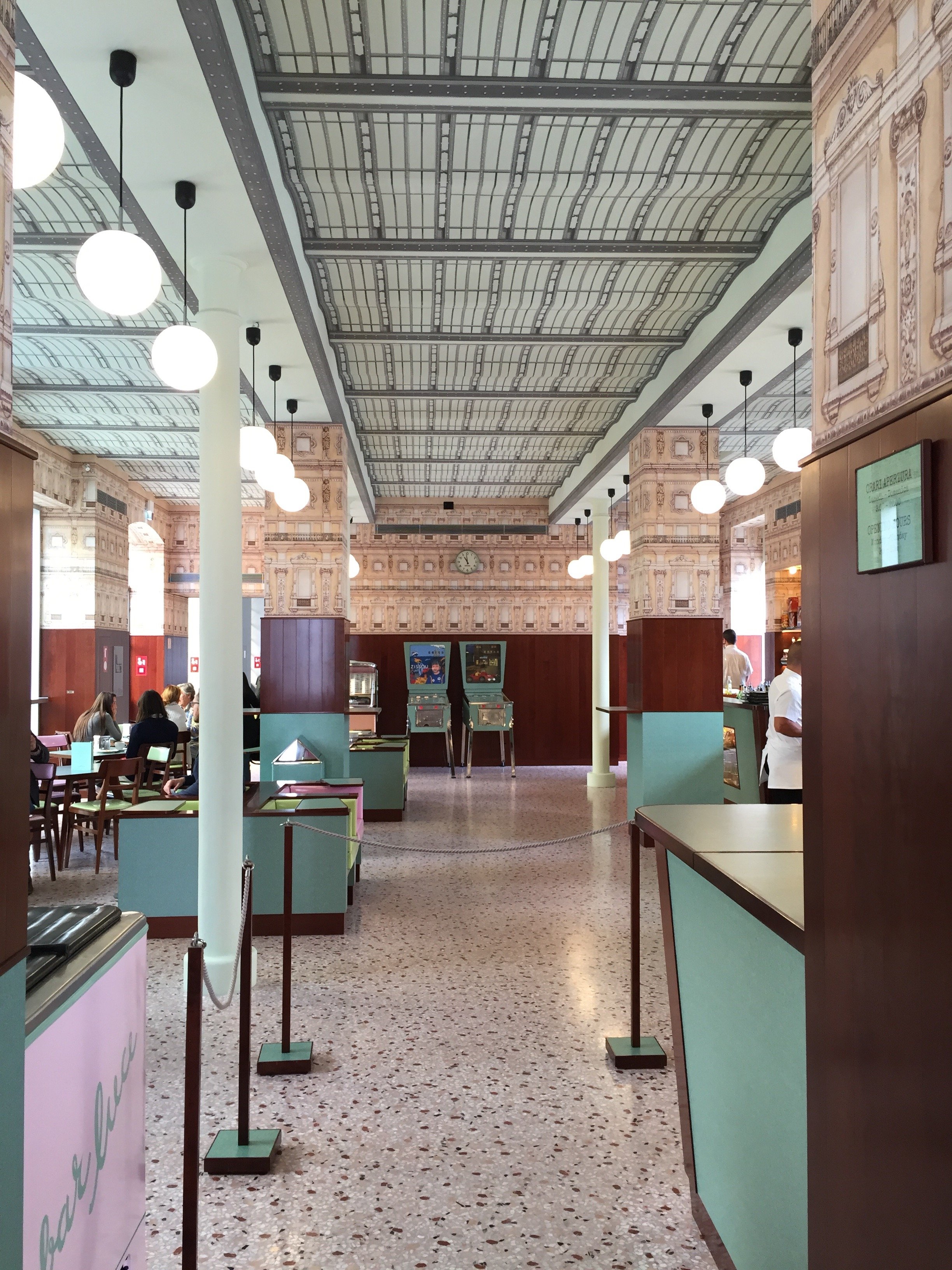
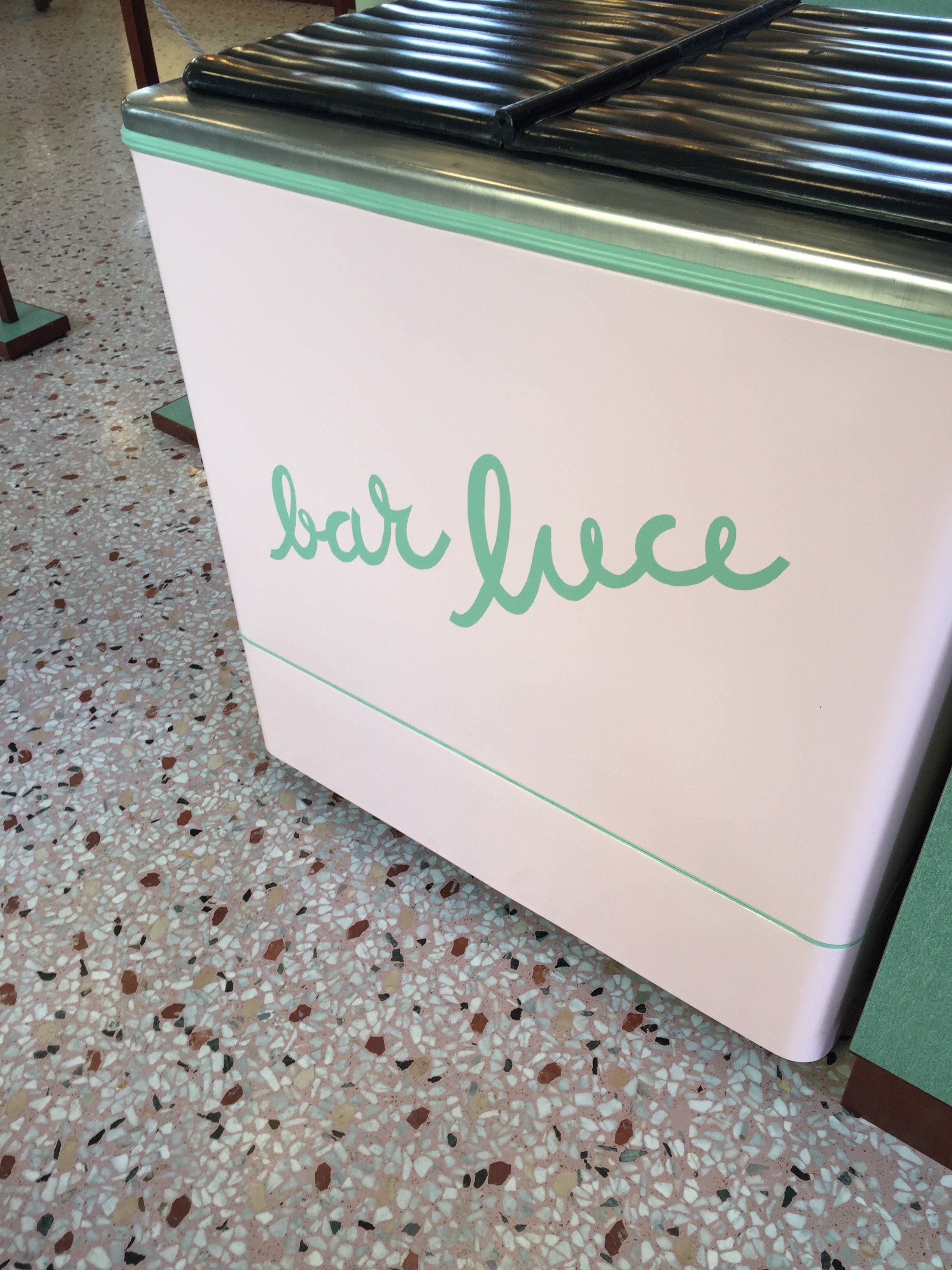

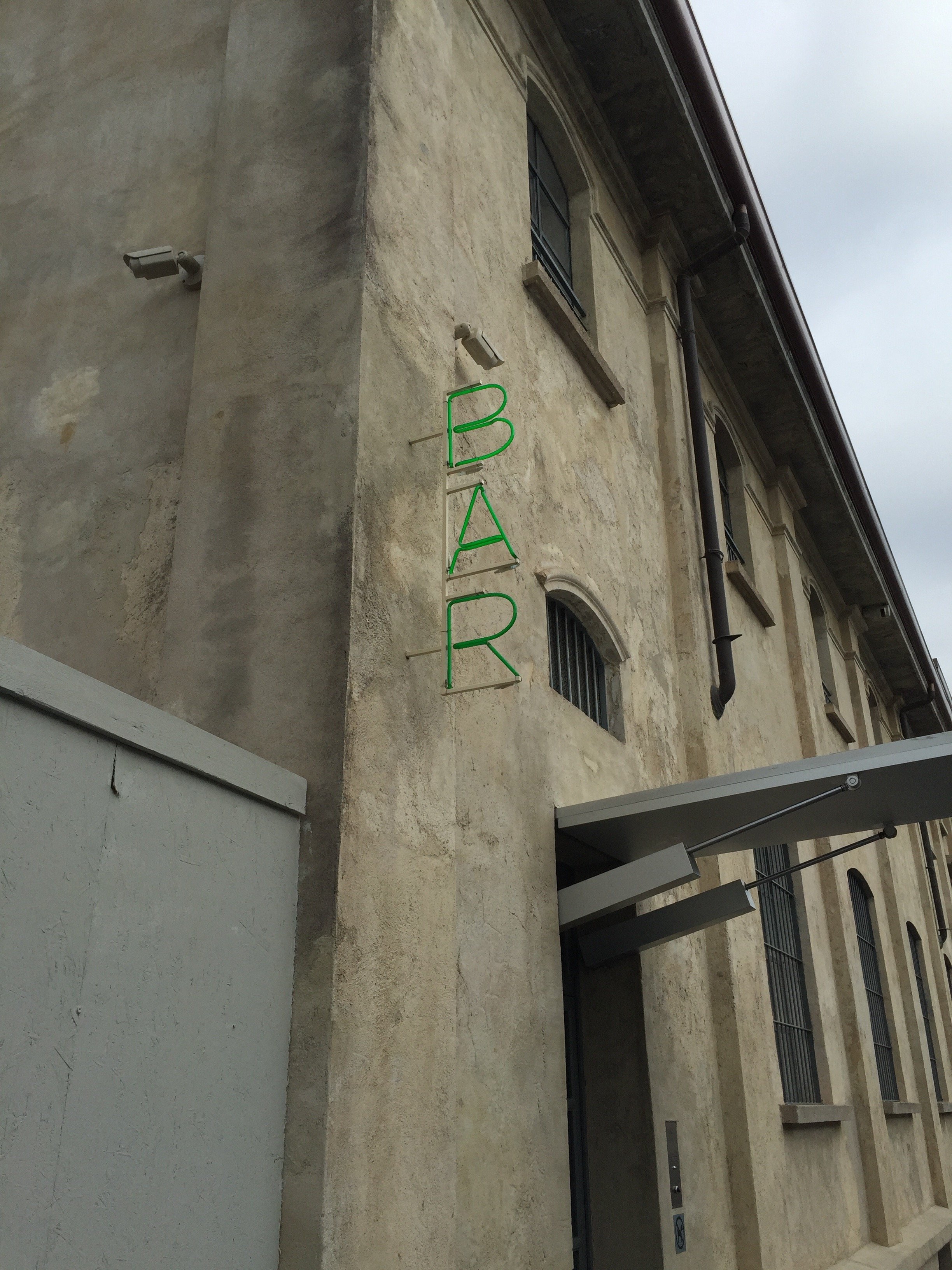
Weekend Inspiration - Garance Doré Studio at the NYC Ballet
I've always loved ballet but have never taken a class. I thought I was too short. The only dance class I've taken was modern dance in college.Lately, I've been thinking about signing up for classes. So what if I'm only 5.2"? I have several friends who are taking adult ballet classes and they rave about them.I play tennis and have played sports all my life. I need to mix things up a bit, especially as I get older. I've tried yoga and ripped a tendon in my wrist probably because I was incapable of focusing on the task at hand. It was a very painful injury. During yoga classes my mind was always racing, thinking about all the things I had to to do. I could never relax. I had the same issues when I tried Pilates.Perhaps ballet is the way to go. It combines athleticism with art, balance, agility, endurance, and mental focus. We'll see what happens.When I woke up this morning and saw Garance's latest post, I had to send it to my ballet-loving friends immediately. The Studio was invited to visit the New York City Ballet as they prepared for the opening night of their winter season.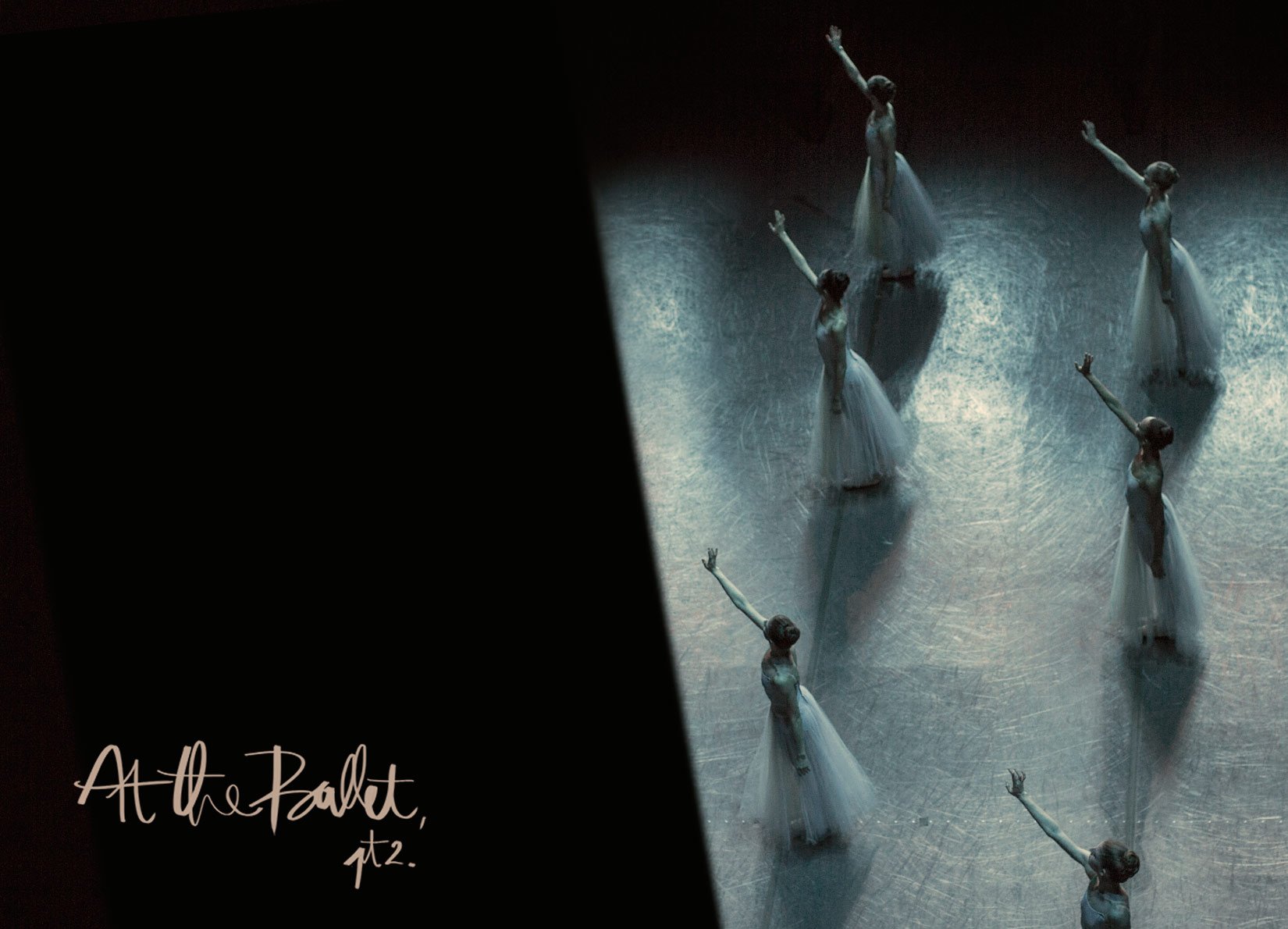
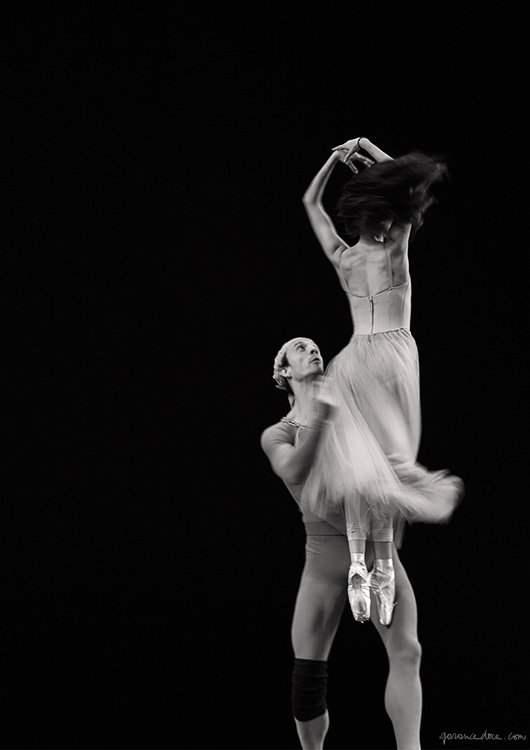
 These intimate photos are so beautiful and inspiring. To see more, click on to Garance's blog HERE.Buon weekend!
These intimate photos are so beautiful and inspiring. To see more, click on to Garance's blog HERE.Buon weekend!



























